Allison Collection Photos
October, 1944
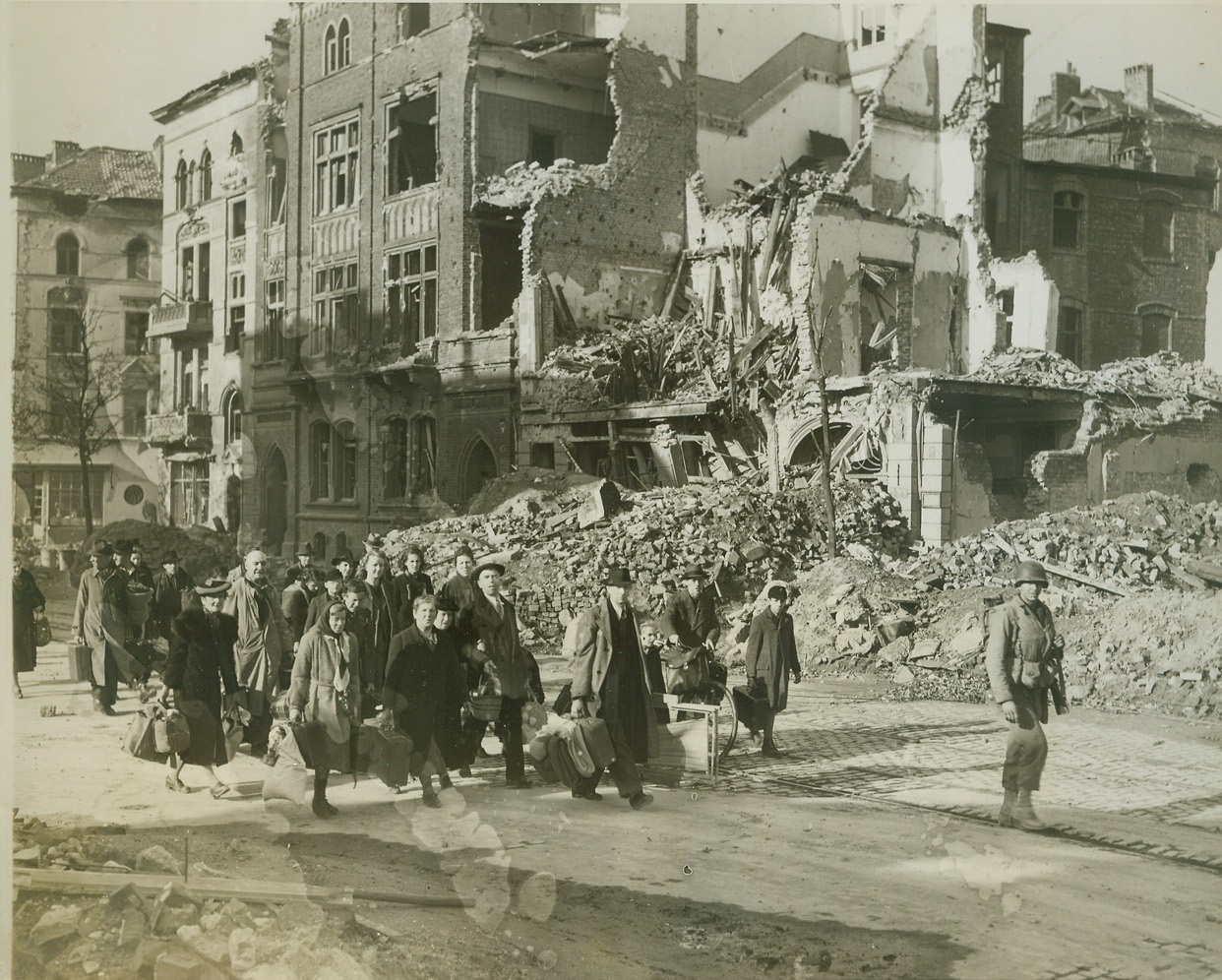
Leaving a Sinking Ship, 10/20/1944. Aachen, Germany – Carrying a minimum of baggage, German civilians leave their cellar hideouts in Aachen and head for safer areas, led by an American soldier. Supreme Allied Headquarters announced today that the last enemy resistance had been mopped-up, and the city is in the hands of the American First Army – the first great German city to fall to the Allies. Credit (ACME photo by Bert Brandt, War Pool Correspondent);
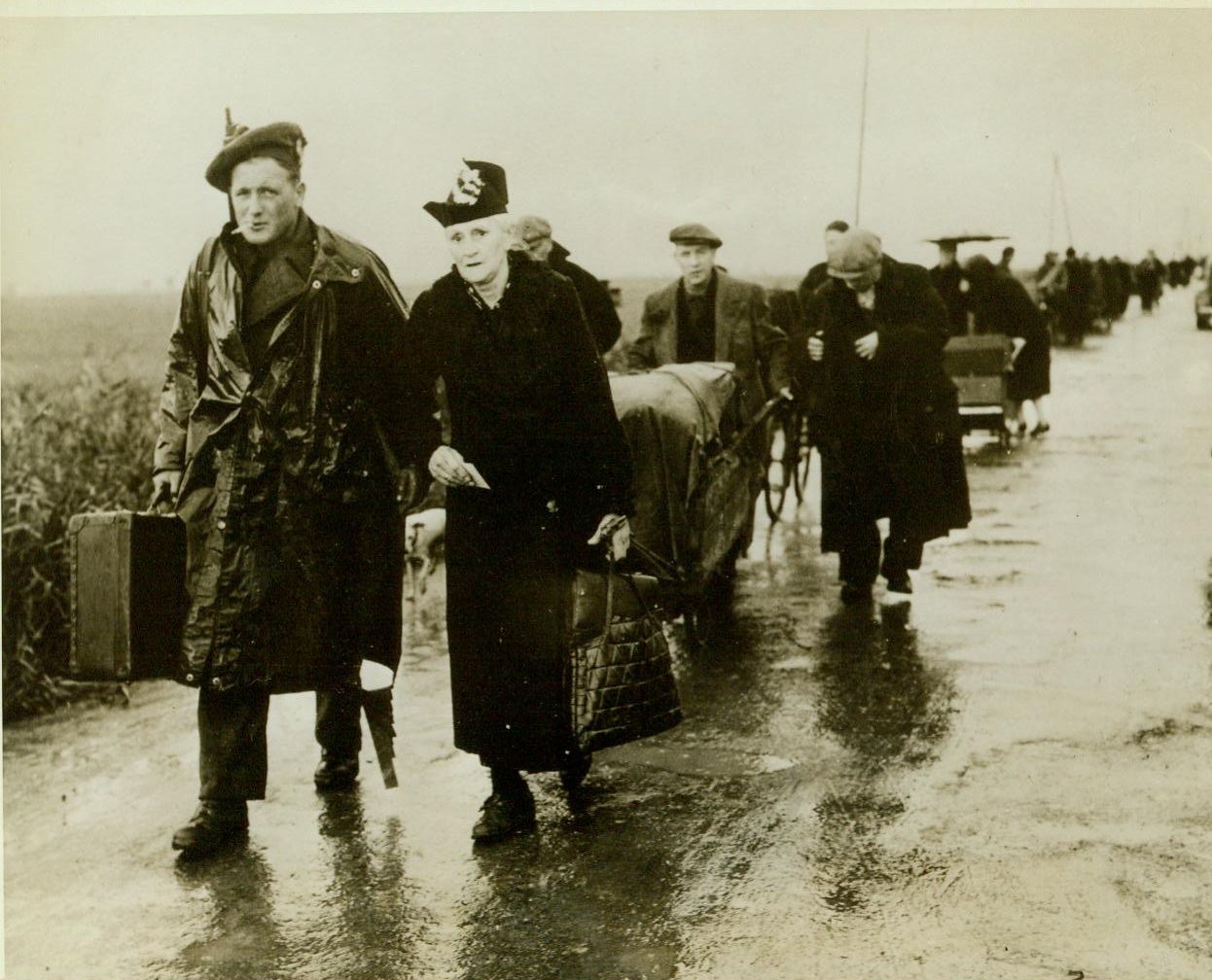
Exit from Dunkirk, 10/9/1944. Dunkirk, France – Walking beside a British Soldier who carries her bag, a white-haired woman of Dunkirk leaves the besieged city during the 60-hour truce. Behind her, a long column of civilian refugees trudges the rain-soaked road away from Dunkirk. Credit: –WP-(ACME);
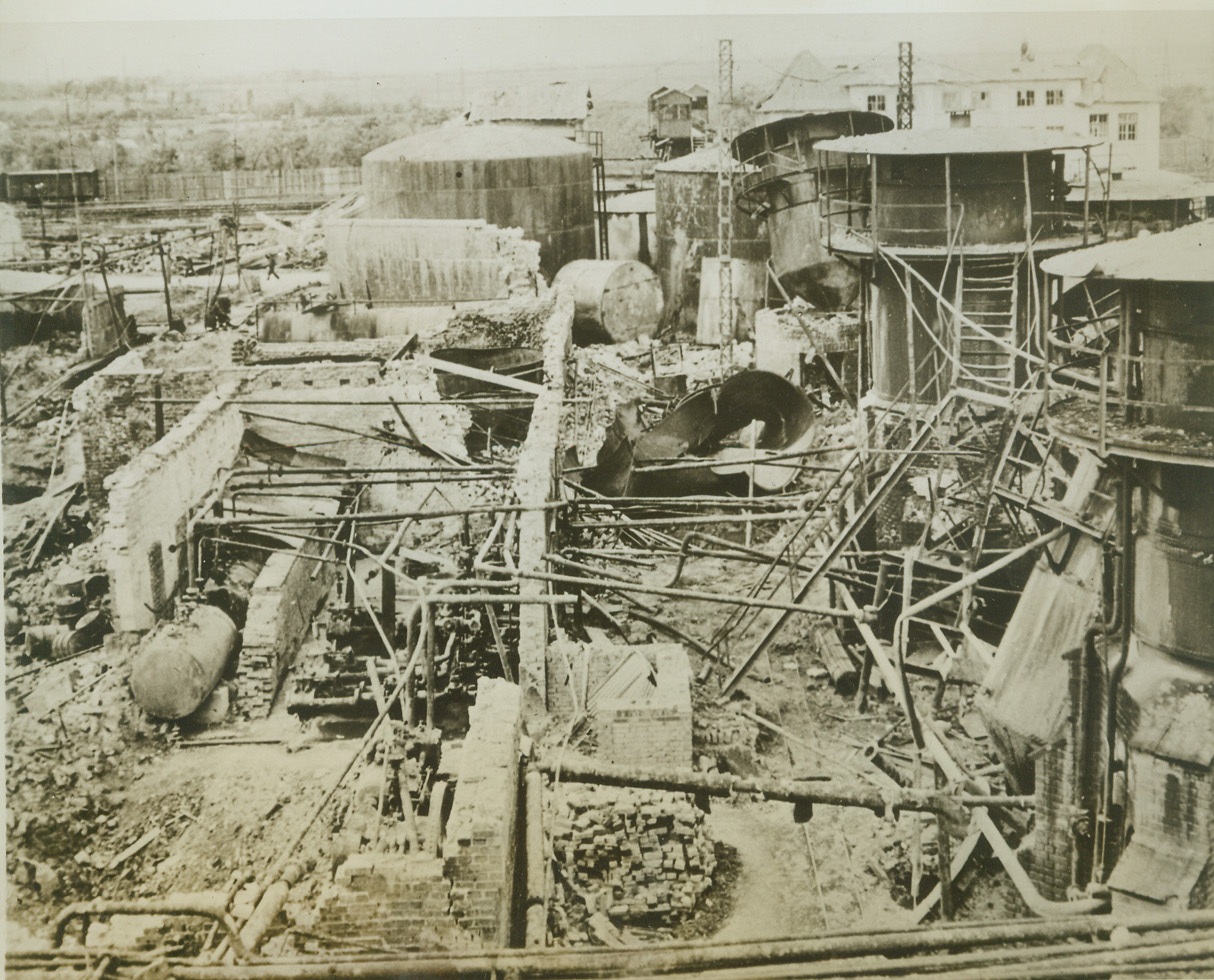
The Big “Leak” in Nazis Gas Tank, 10/4/1944. Rumania – This photo, just received, shows the devastation dropped on the Concordia Vega refinery at Ploesti, one of the installations smashed by some 13,000 tons of Allied bombs in 23 large-scale attacks. Above, little more than scrap metal remains of this plant which one helped to keep Hitler’s war machine going. The area is now in Russian hands. Credit: (USAAF Photo from ACME);
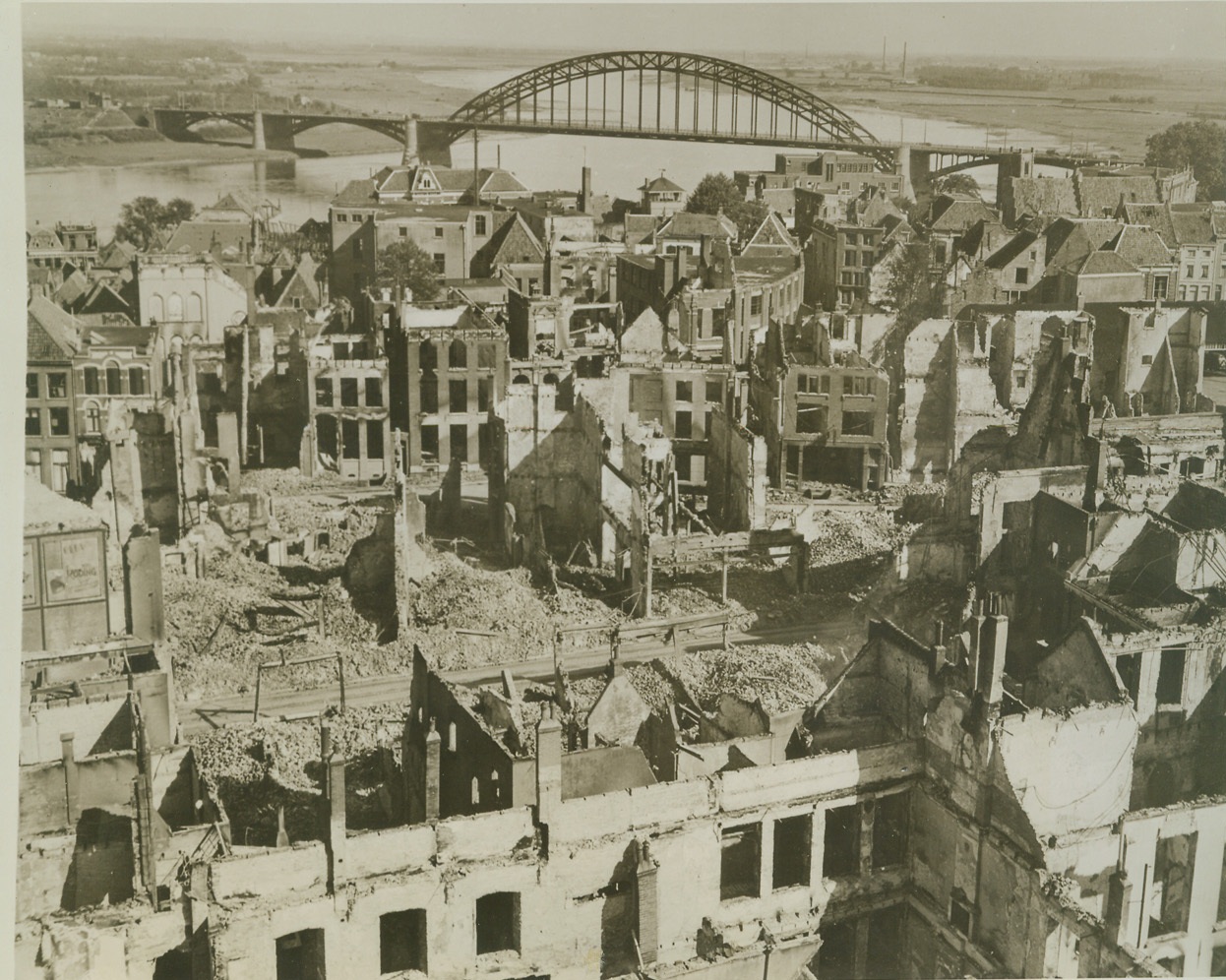
Devastated NiJMegen, 10/5/1944. Holland – Burned out shells of buildings and piles of rubble mark this view of the war-blasted town of NiJMegen after its capture by the Allies. In the distance, is the key bridge over the Waal (River) captured intact in the rapid advance. Credit: (Army Official Photo from ACME);
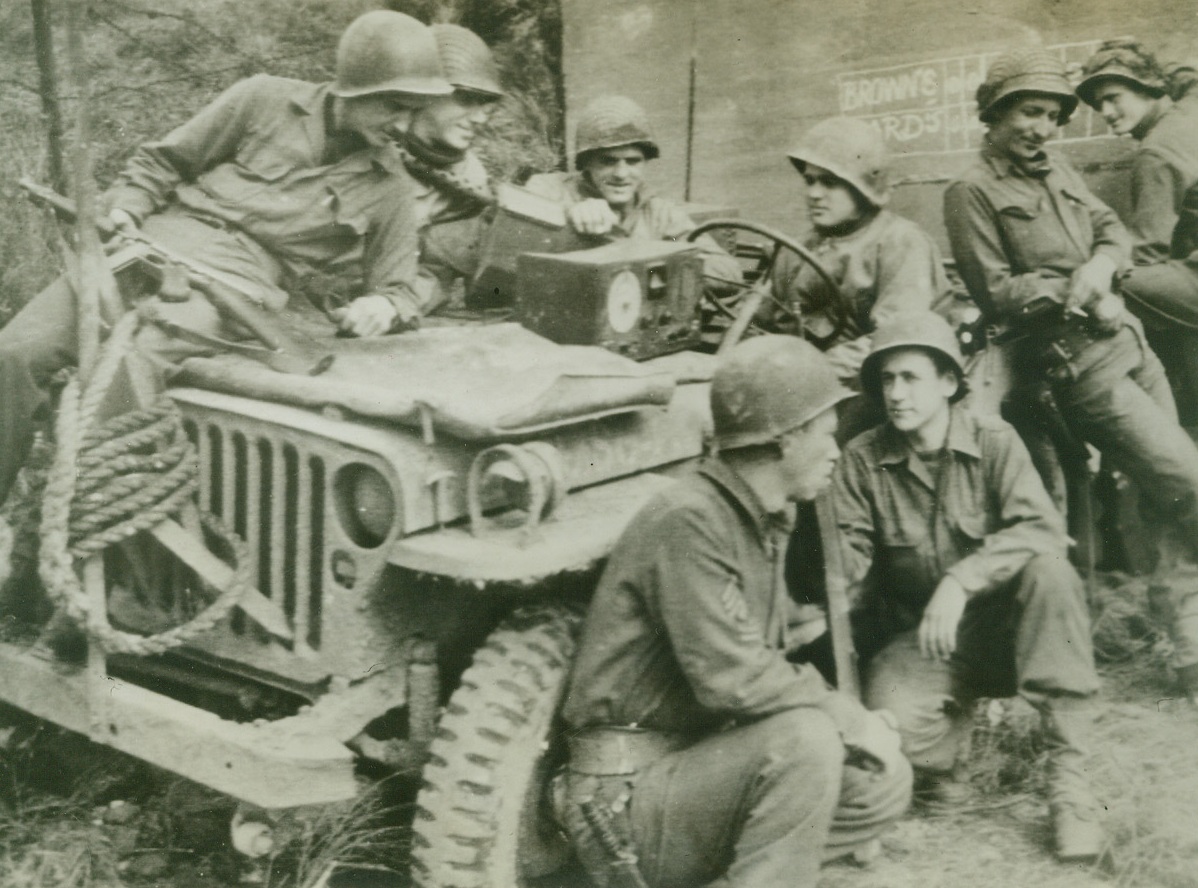
Blow-By-Blow Description of Another Battle, 10/9/1944. GERMANY – chalking up the score on the wall of a captured German Pillbox on the Sigfried Line, These Yanks bend their ears to their radio as they listen to a broadcast of the world Series Game in St. Louis. In the absence of easy chairs, a jeep serves them well.Credit: Signal Corp Radiotelephoto from ACME;
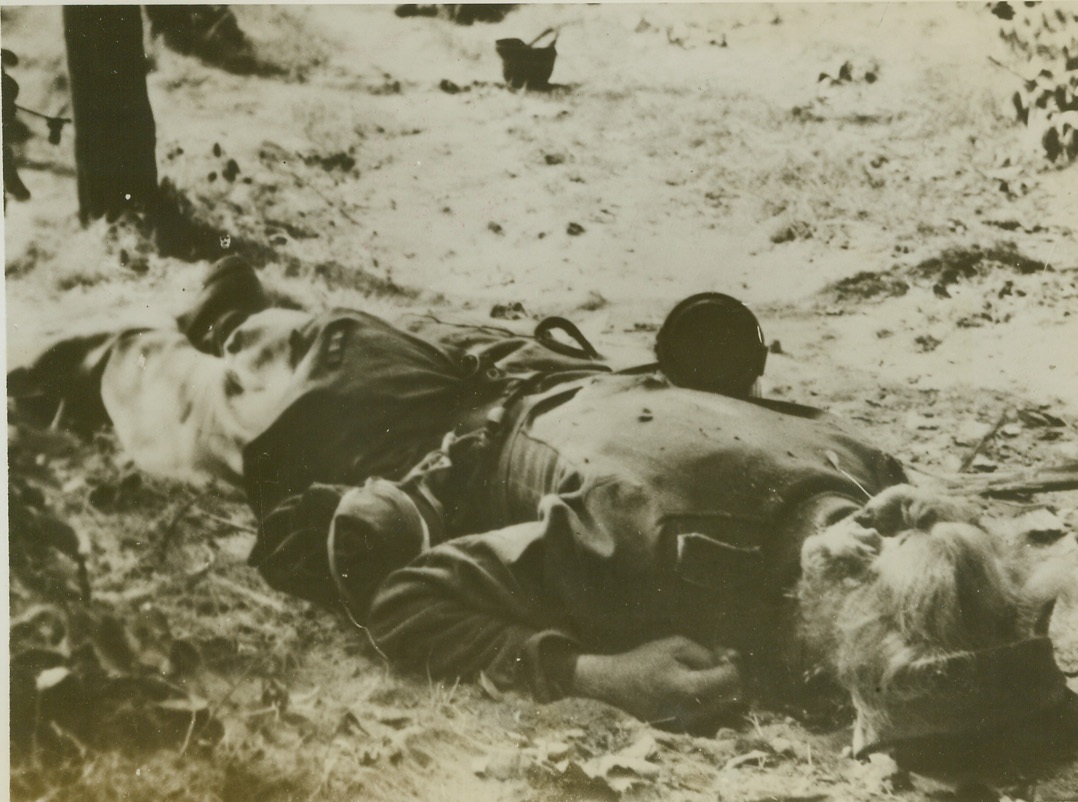
Woman Killed FIghting With Nazis In Holland, 10/6/1944. Holland – Attired in full German uniform, including gas mask container, this woman was killed fighting with the German ranks in Holland. As far as is known, this is the first authenticated case of a woman fighting with German forces. The picture was taken by an Army Airborne photographer who landed with the first forces in Holland. 10/6/44 Credit (British Official Photo From ACME);
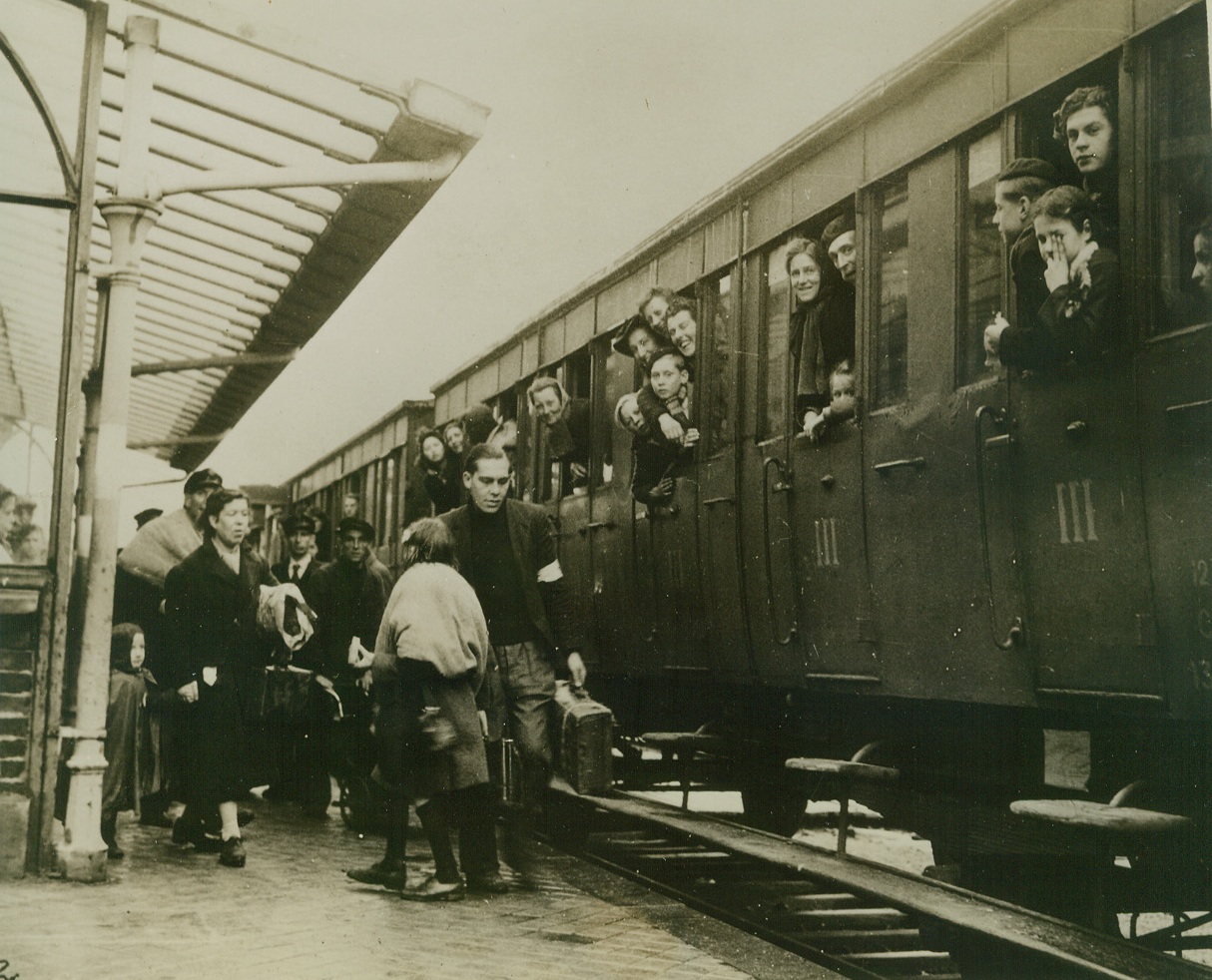
Siege Brings Luxury, 10/9/1944. DUNKIRK, FRANCE – Smiling civilians of Dunkirk crowd the windows of an evacuation train as they wait to leave the city during the 60 hour truce. The need for hurrying non-combatants out of the battle area put the wartime luxury of train travel within their grasp.Credit:-- WP—ACME 10/9/44;
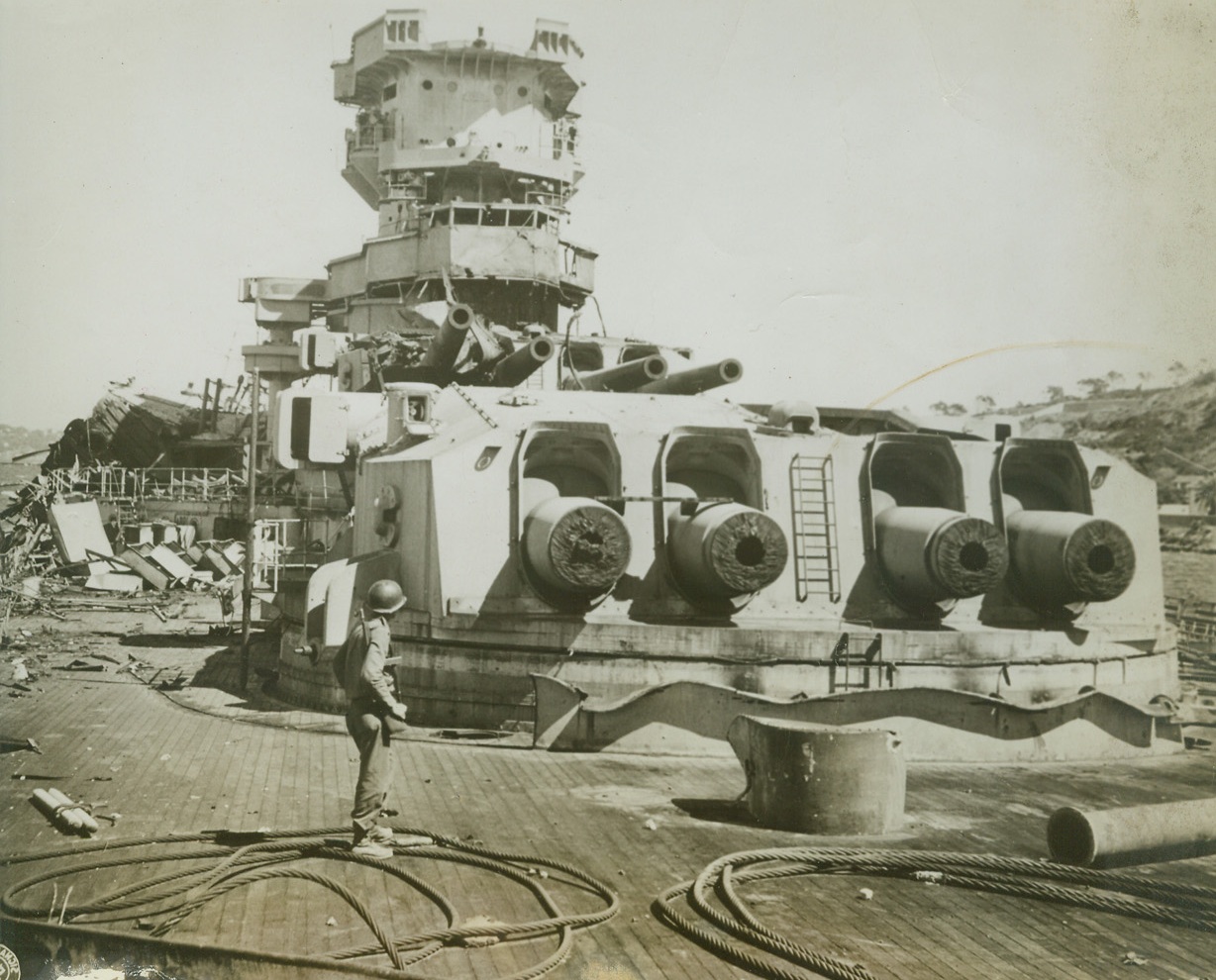
Scuttled “Strasbourg”, 10/7/1944. Toulon, France – A Yank surveys the remains of the scuttled French battleship “Strasbourg”, which lies beside oil docks in Toulon Harbor. The long Snouts of four lower turret guns in the foreground have been cut off. Credit: Signal Corp Photo From ACME;
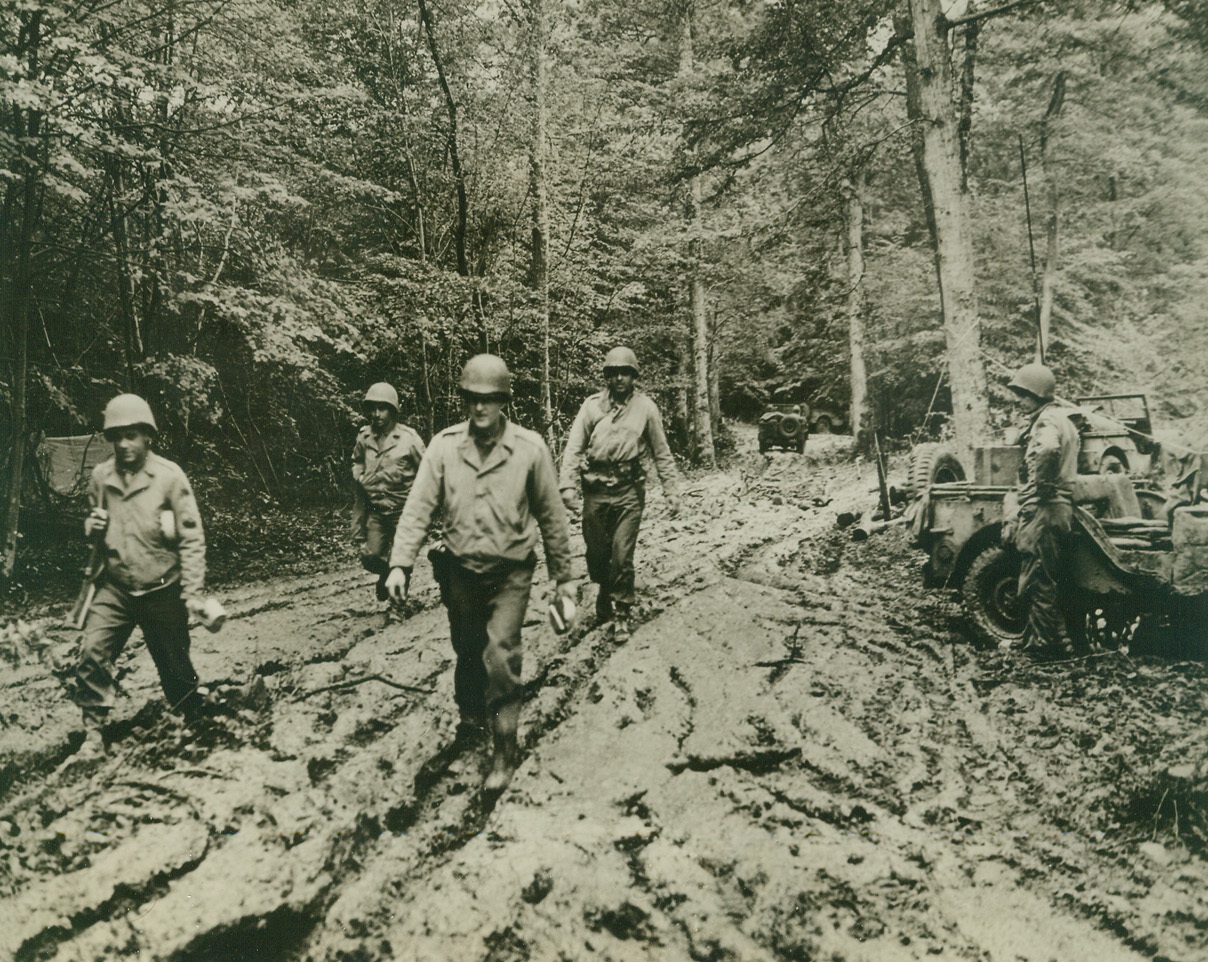
THE SAME OLD COMPLAINT—MUD!, 10/3/1944. FRANCE—As these Yanks plow through the sticky mud in their bivouac area, some of them are reminded of the stories their dads told of the last war. But, when chow is in the offing, it takes more than mud to keep the men away.Credit: U.S. Signal Corps photo from Acme;
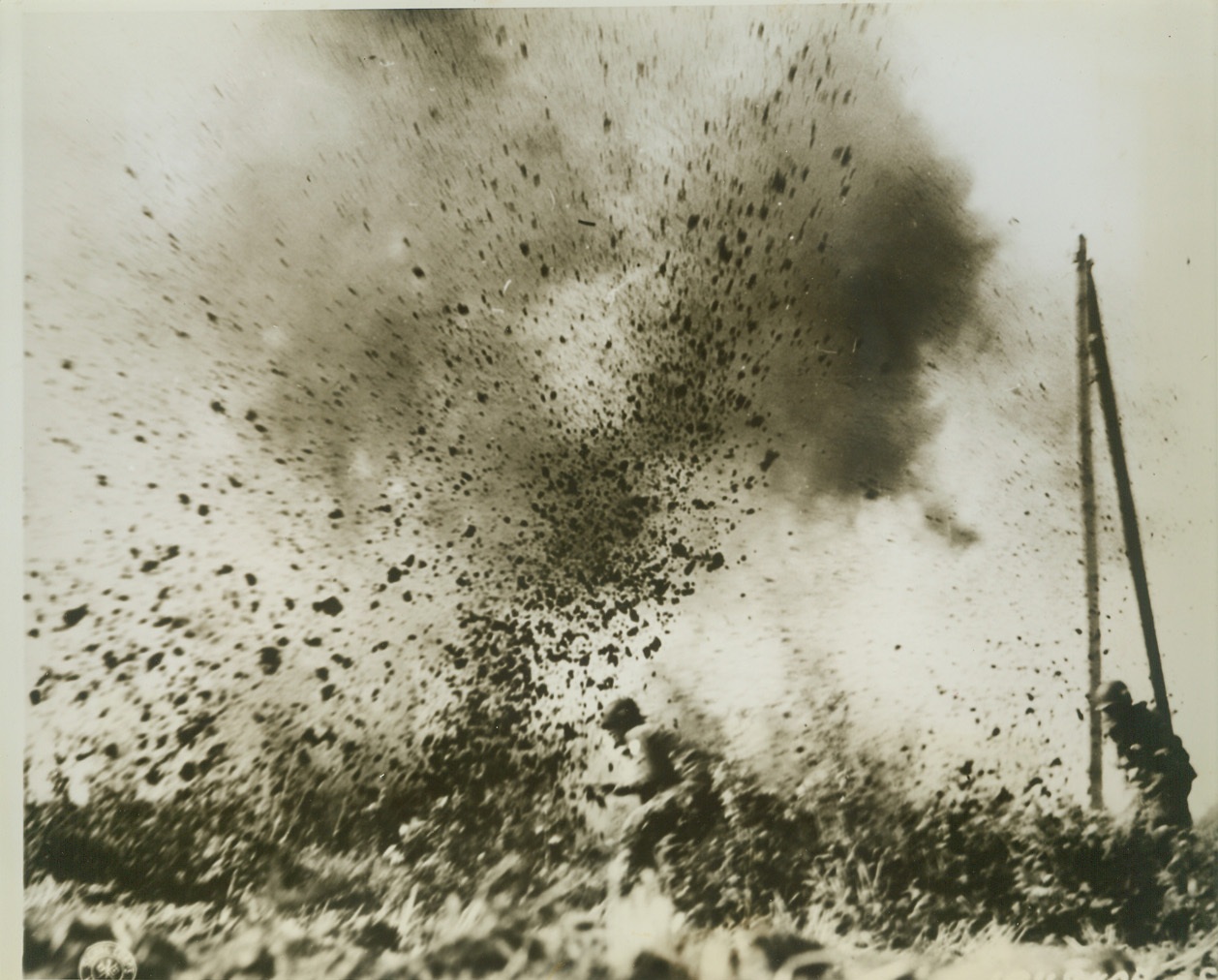
Yanks Barge Through Shell Burst, 10/13/1944. Holland – American paratroopers bend low but continue their advance on Arnhem as a bursting German 88 kicks up a section of field. Credit (Signal Corps Photo from ACME);
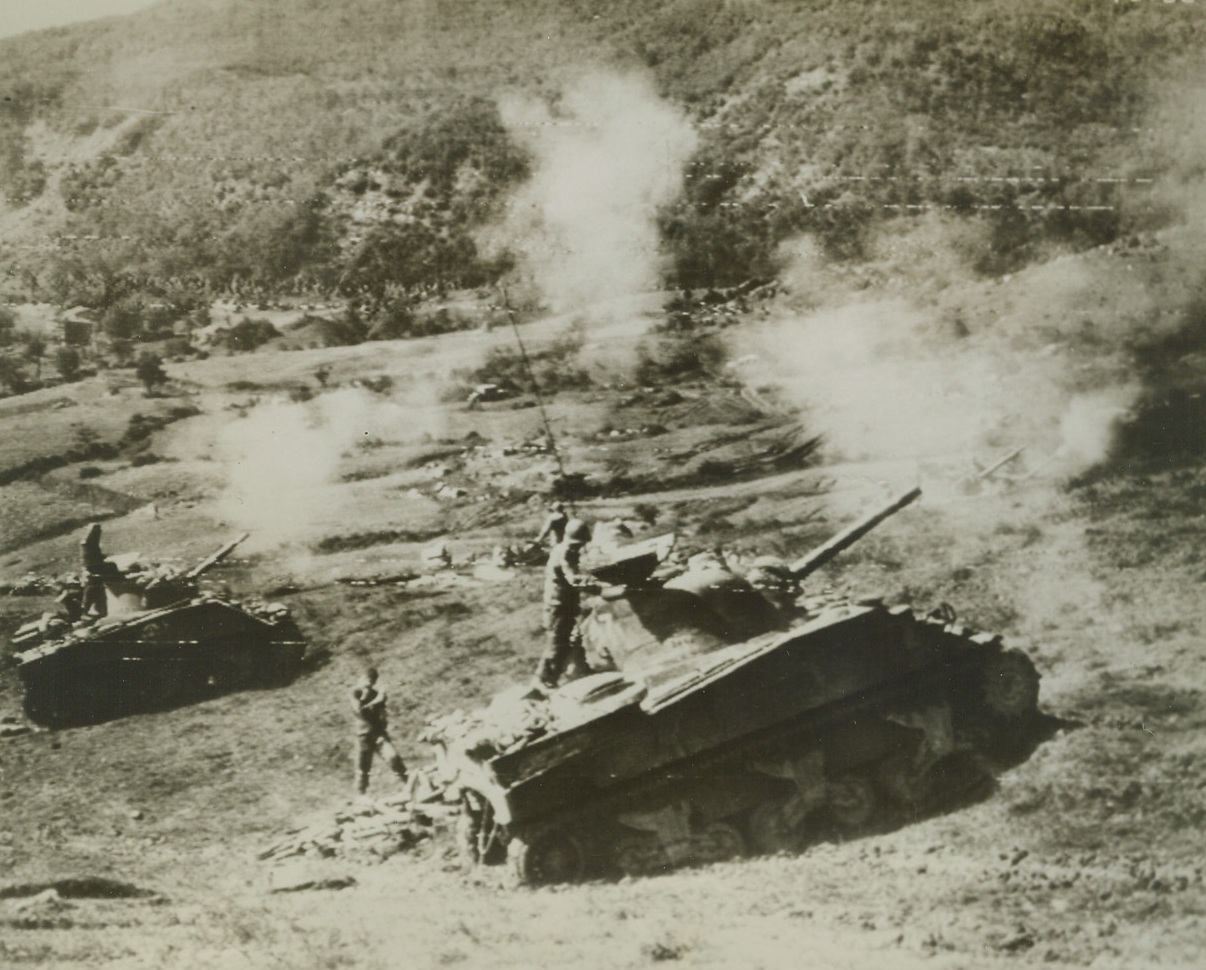
POUNDING NAZIS IN APENNINES, 10/5/1944. ITALY—American tanks pound German positions along the mountainous Gothic Line, as hard-driving Allied troops meet stiff enemy resistance. Credit: Army radiotelephoto from Acme;
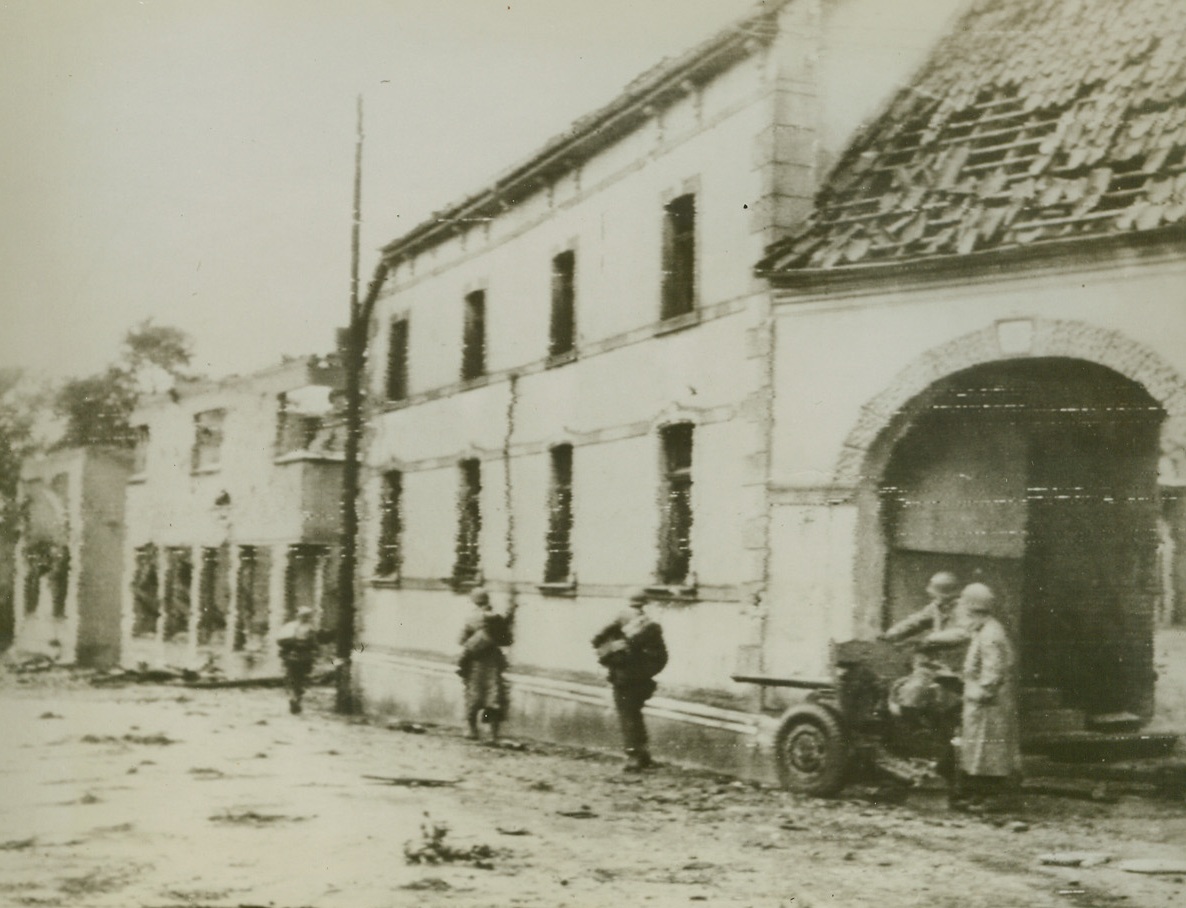
Nazi Hunt, 10/5/1944. While a crew of their buddies stands ready with an anti-tank gun, an American patrol advances slowly down the street in this German town, looking for Nazi sniper nests and traps. Credit: Army radiotelephoto from ACME.;
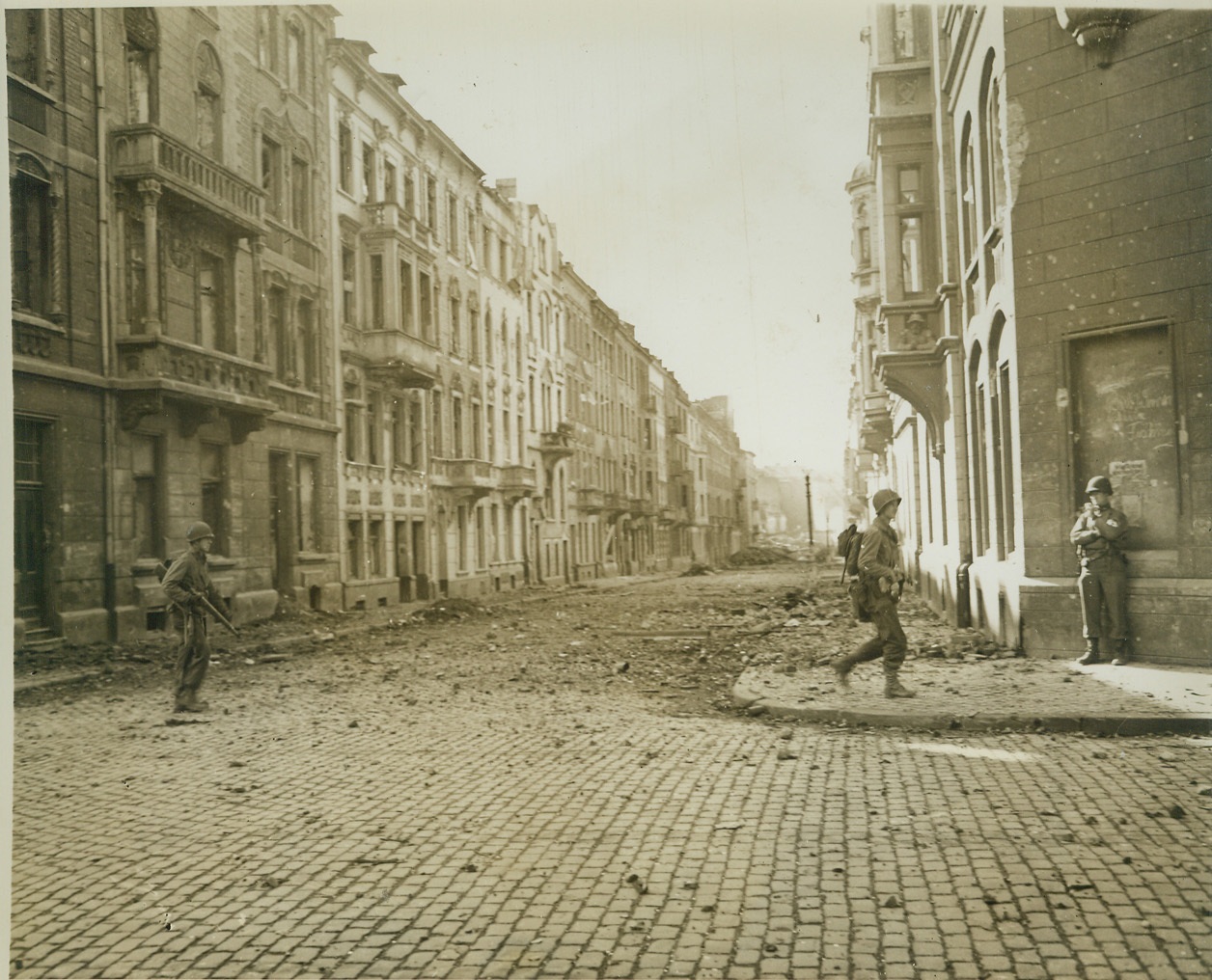
Yanks Fight in Aachen Streets, 10/19/1944. Germany – American soldiers stand in the rubble-littered streets of Aachen as fighting for this Nazi stronghold was brought into the city proper. Photo by ACME photographer, Andrew Lopez, for the War Picture Pool. Credit – WP – (ACME);
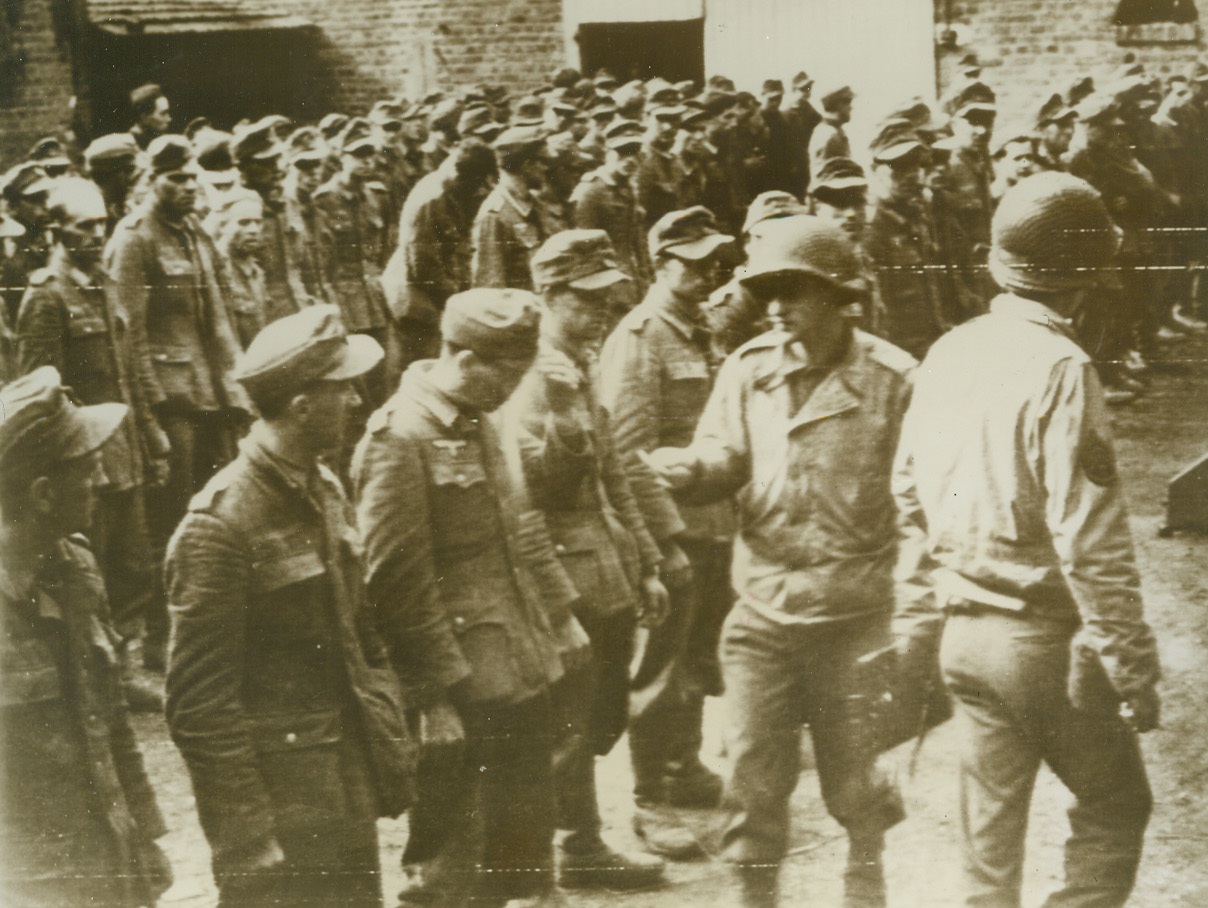
Captured in Siegfried Breakthrough, 10/5/1944. An American officer checks the first large group of Nazi prisoners captured by the Yanks, after their breakthrough of the Siegeried line at Uebach, Oct. 4. Credit: ARMY RADIOTELEPHOTO from ACME.;
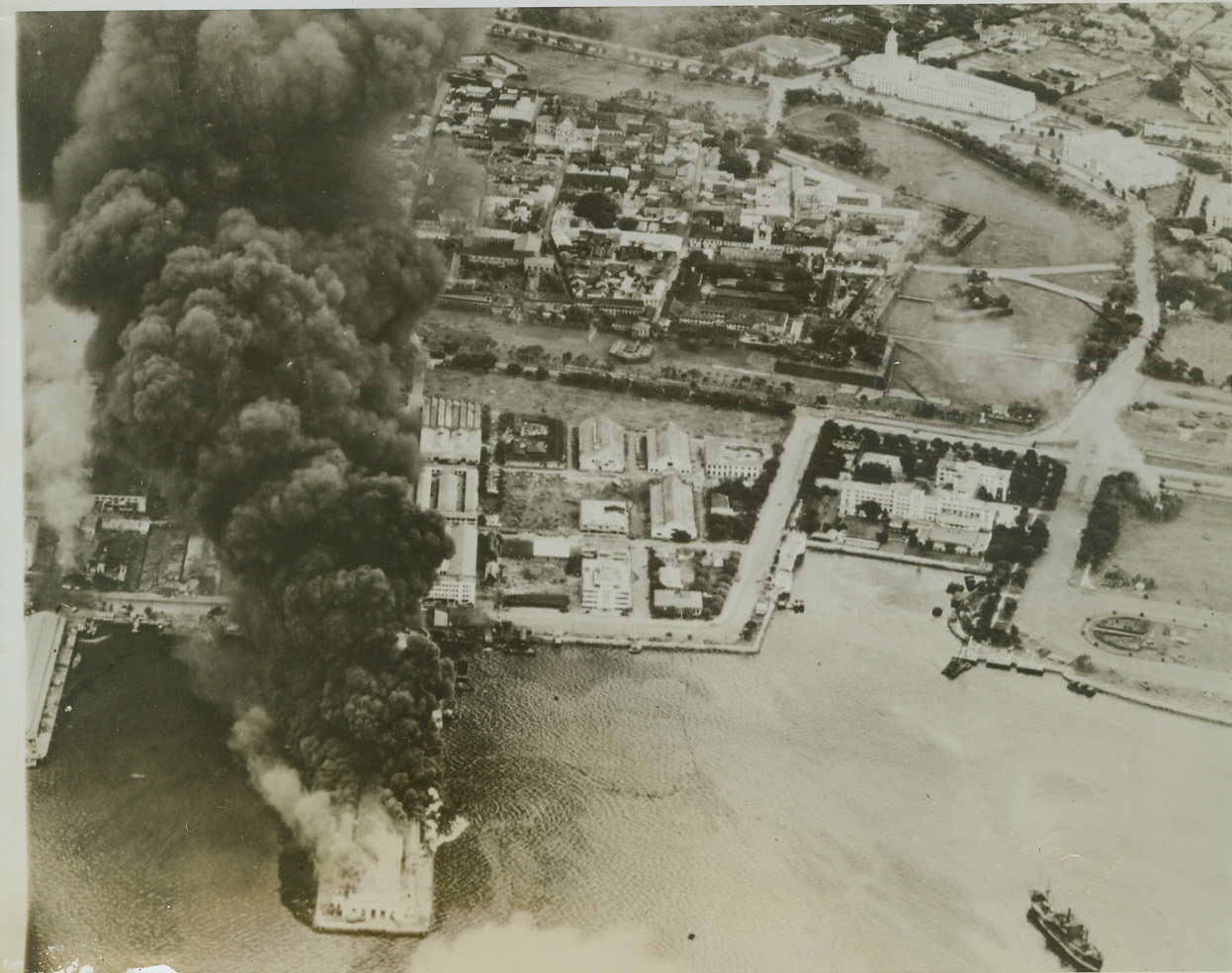
Yanks Uninvited Guests at Manila, 10/8/1944. MANILA -- Planes from V/Adm. Marc A. Mitscher's carrier task force paid a surprise visit to Manila and left calling cards in the form of these blazing docks. In the right foreground can be seen the swank Manila Hotel, with its gardens and yacht harbor. Municipal buildings, built by Filipinos before the Japs invaded the island, can be seen untouched in the background. Credit (Official US Navy Photo From ACME);

Civilian Prisoners, 10/9/1944. UBACH, GERMANY—German civilians, among them women armed with pistols, are now being taken prisoner along with members of the Wehrmacht. A long line of these captives marches through Adolf Hitler Plaza in Ubach, passing wrecked houses on the road to a prisoner of war cage. Credit: ARMY RADIOTELEPHOTO FROM ACME.;
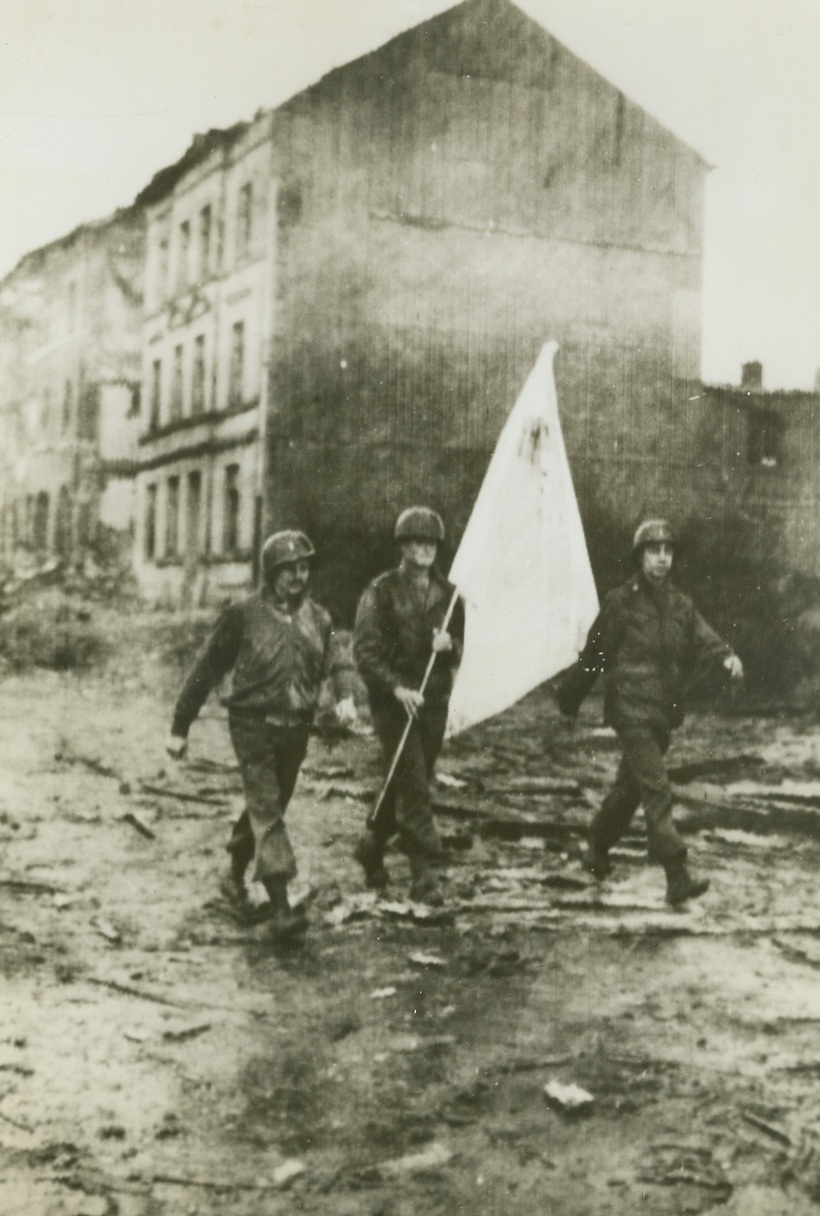
NGING ULTIMATUM TO AACHEN, 10/12/1944. Carrying terms demanding the unconditional surrender of the German forces in Aachen, are (left to right): Lt. William Boehme, of 66th Street, New York City; who served as interpreter; Pvt. Kenneth Kading, LaGrange, Ill., who bears the flag of truce made from a bedsheet; and Lt. Cedric Lafley, of Enosburg Falls, Vt., who commanded the party. Alternative to surrender was the “obliteration” of the city. Nazis refused to give up and the Allies are pounding Aachen to bits.Credit: Acme photo by Andrew Lopez for War Picture Pool;
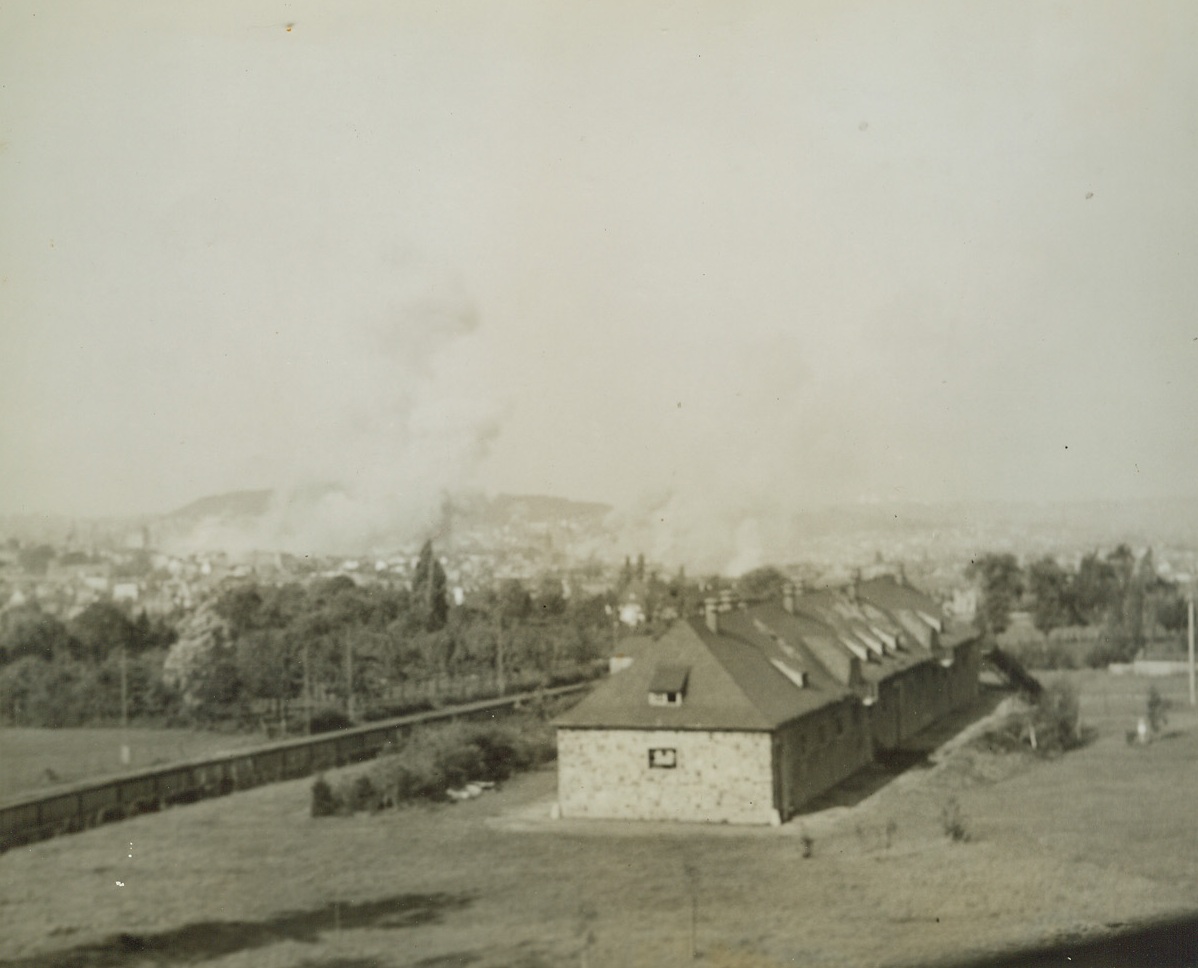
AACHEN UNDER PALL OF SMOKE, 10/19/1944. GERMANY—Clouds of smoke rise above the ancient German city of Aachen after a concentrated Allied bombing attack.Credit: Photo by Acme photographer, Andrew Lopez, for the War Picture Pool;
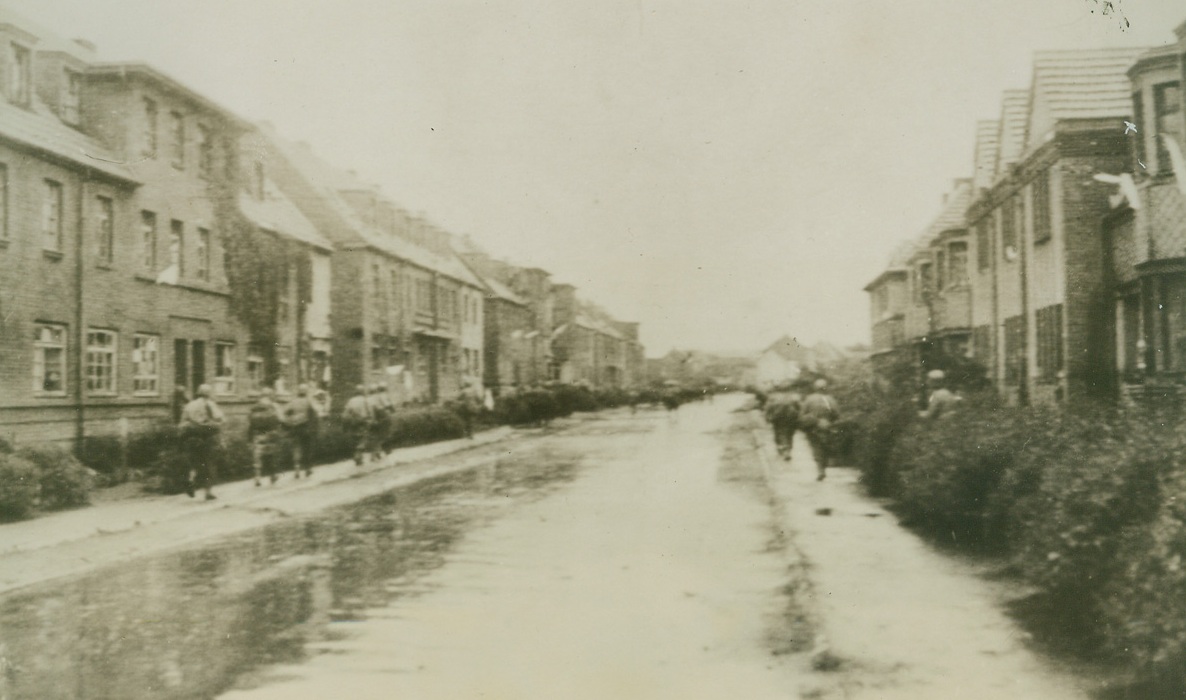
“LAUNDRY SALUTE”, 10/19/1944. GERMANY—Bits of sheets and other white cloth hang from houses on both sides of the street in this town beyond Kohlscheid, in token of surrender as U.S. Infantrymen advance through the rain in search of the enemy.Credit: Army Radiotelephoto from Acme;
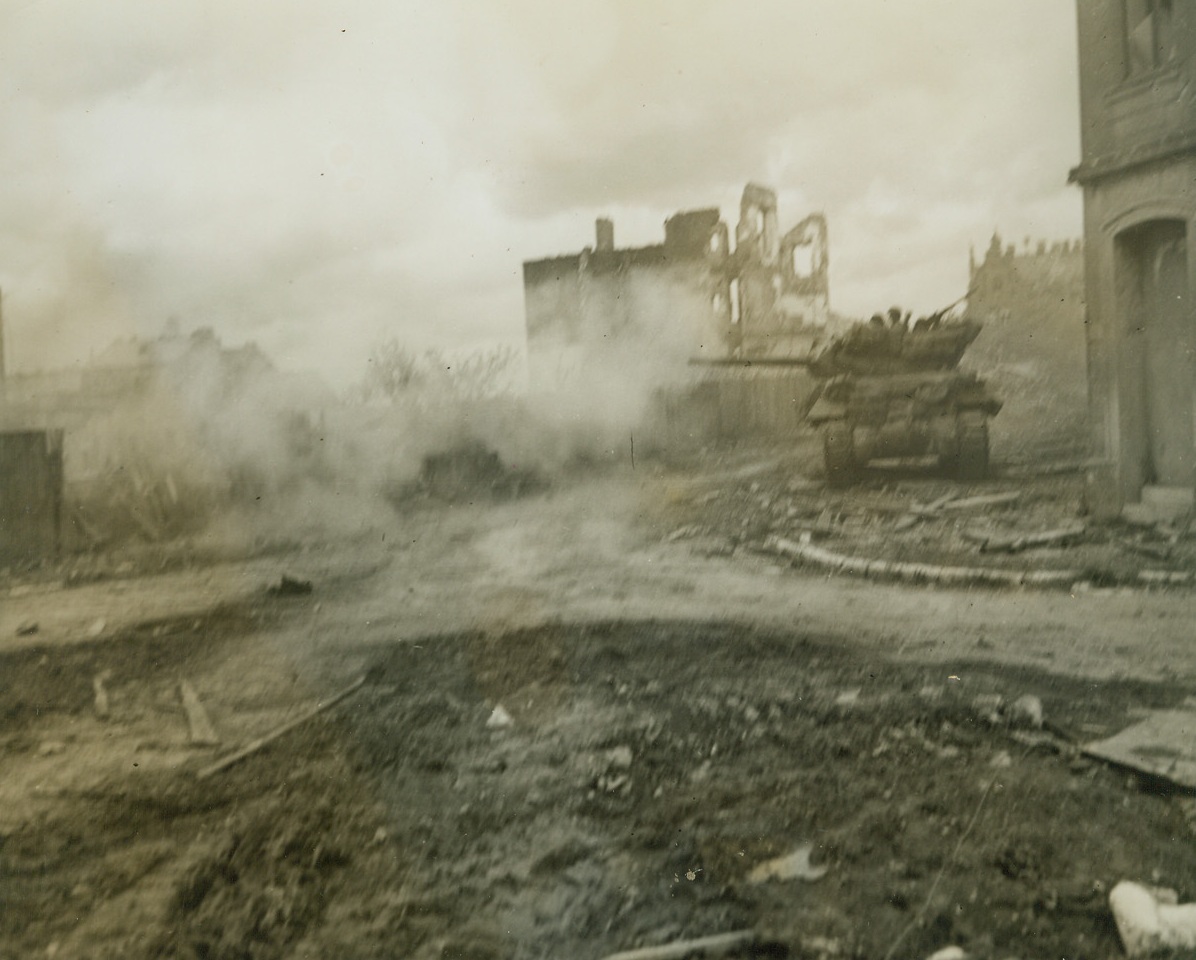
ACTION IN AACHEN, 10/19/1944. GERMANY--Gun blazing away at enemy positions off to the left, an American tank rolls through a battered street in Aachen.Credit: Photo by Acme photographer, Andrew Lopez, for the War Picture Pool;
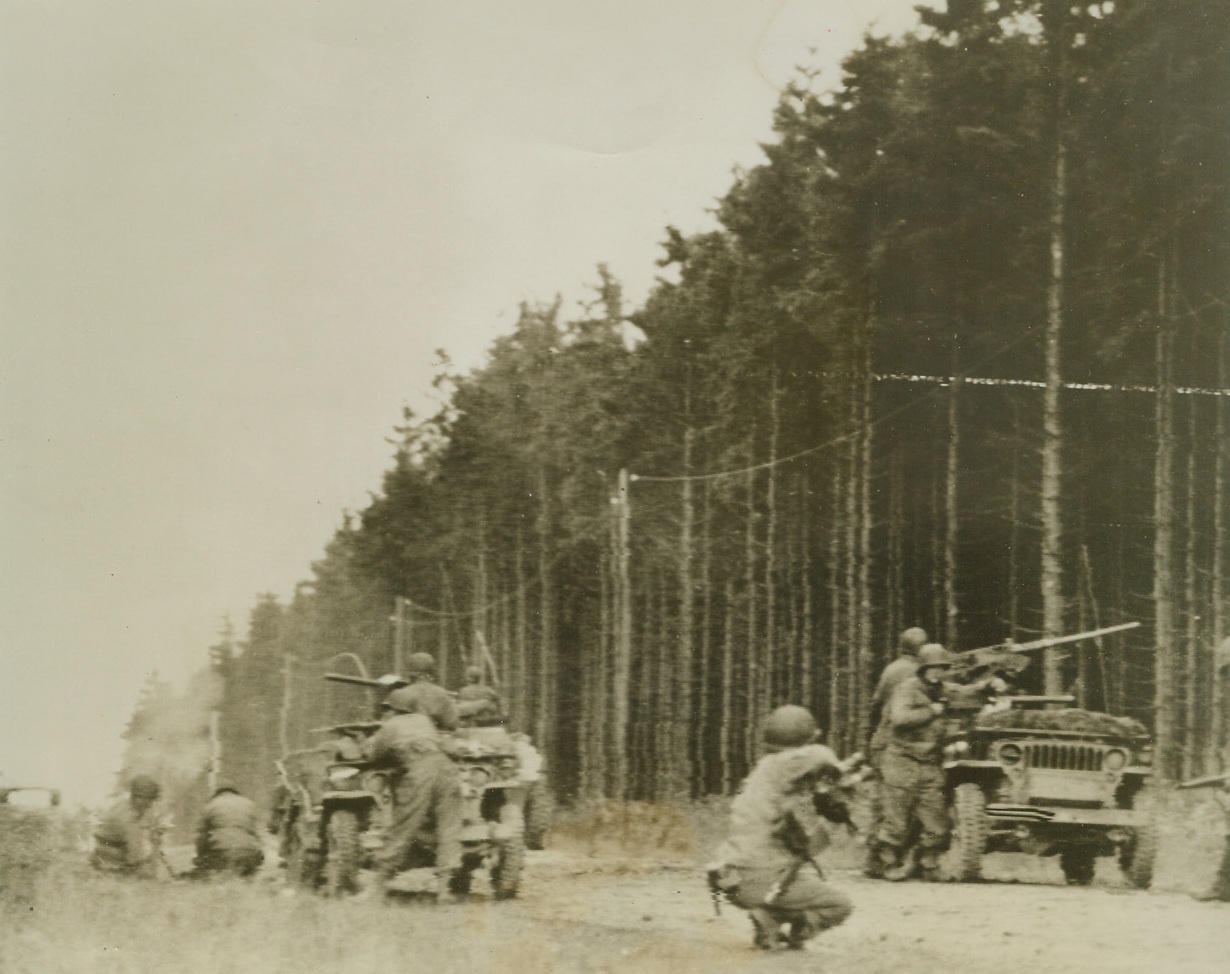
DISHING IT OUT, 10/2/1944. GERMANY—Making things hot for an enemy machine gun nest hidden in the German woods, Yanks send mortar fire screaming into the Nazi position.Credit: Signal Corps Radiotelephoto from Acme;
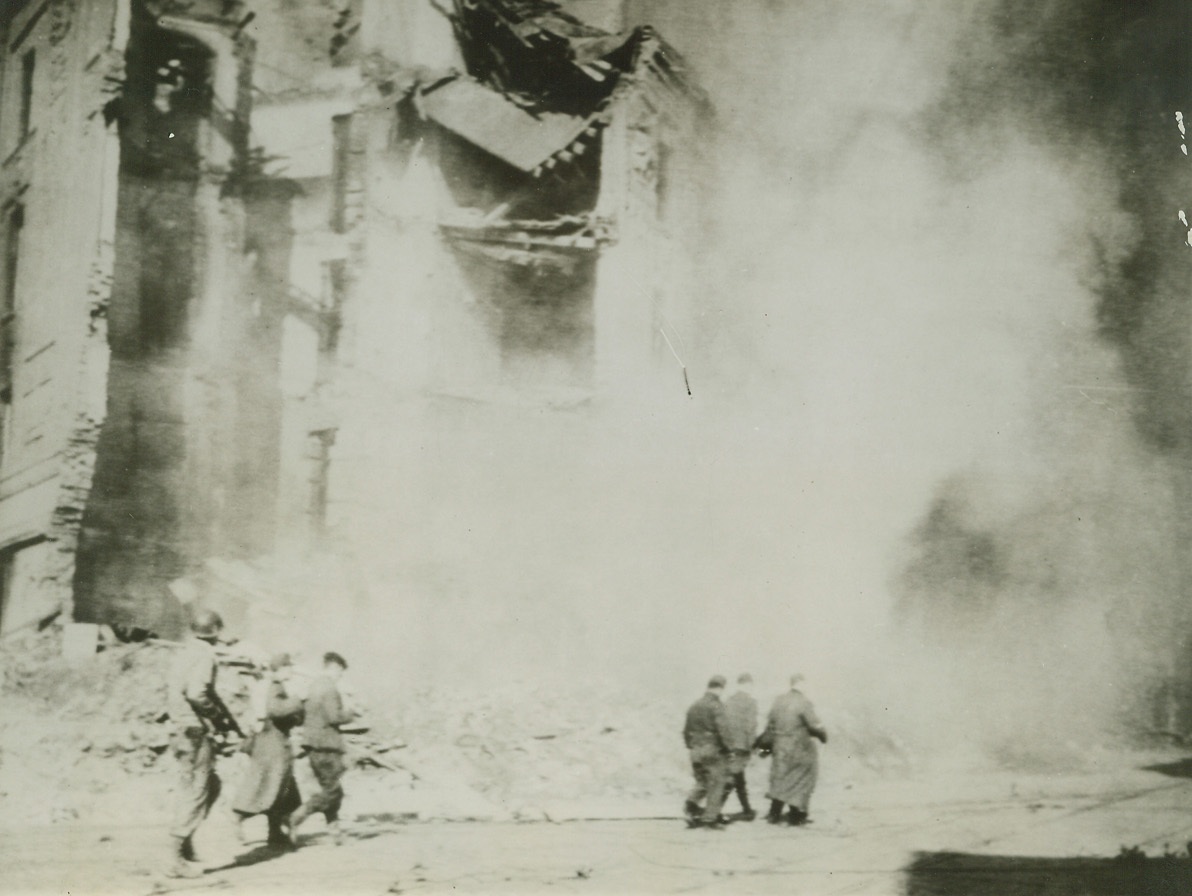
AACHEN BATTLE SCENE, 10/17/1944. GERMANY—Smoke from blazing buildings, wrecked masonry and smashed concrete form a Mars-like background for an American soldier as he escorts five Germans at gunpoint through the city of Aachen to prison compounds.Credit: Photo by Acme Newspictures photographer, Bert Brandt, for the War Picture Pool;
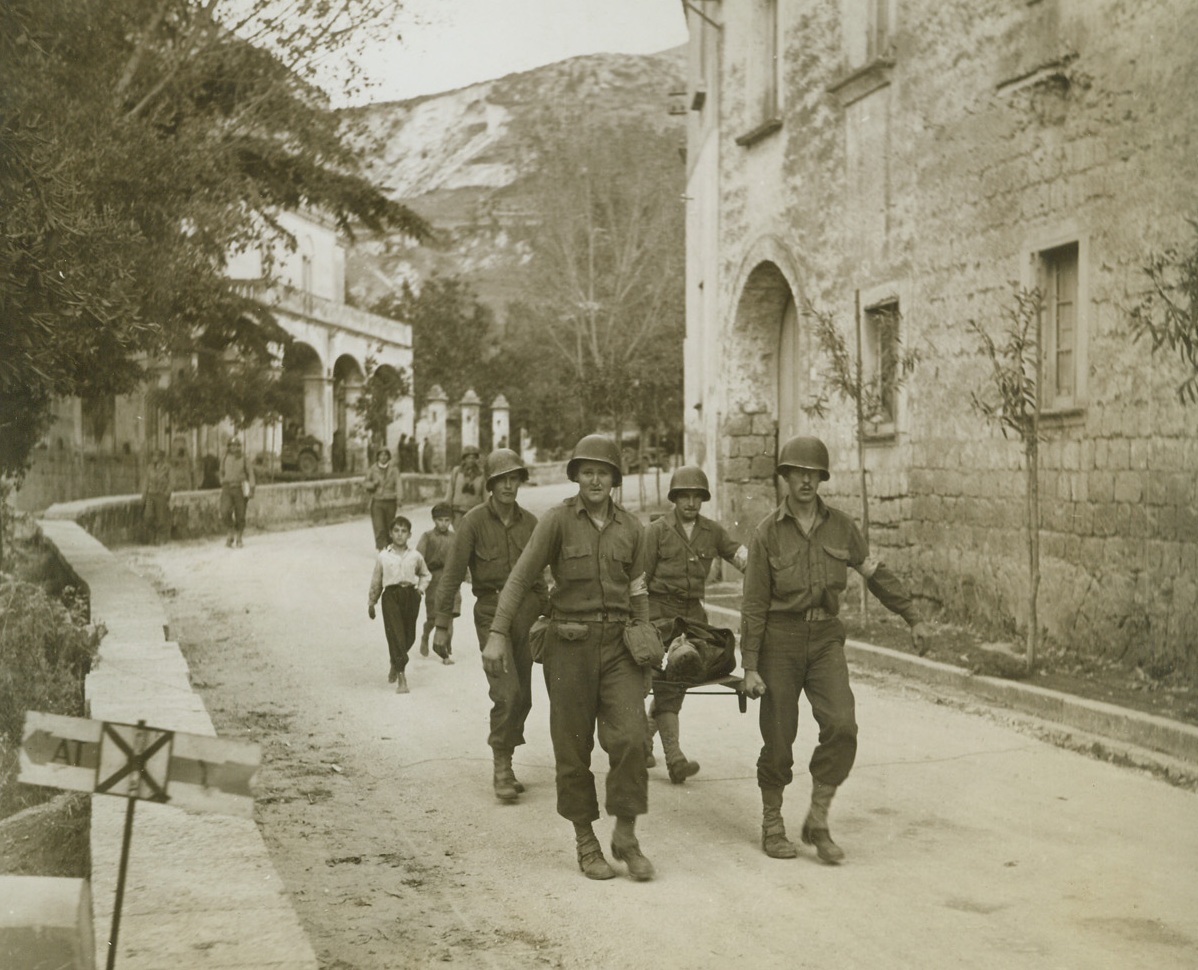
VOLTURNO CASUALTY, 10/24/1944. ITALY—American stretcher-bearers rush a casualty through the streets of a tiny Italian village, during the fight to cross the Volturno, and are followed by a pair of the town’s younger citizens. First aid has already been given to the wounded Allied fighter, and he is on his way to an ambulance.Credit: Acme photo by Bert Brandt, War Pool Photographer;
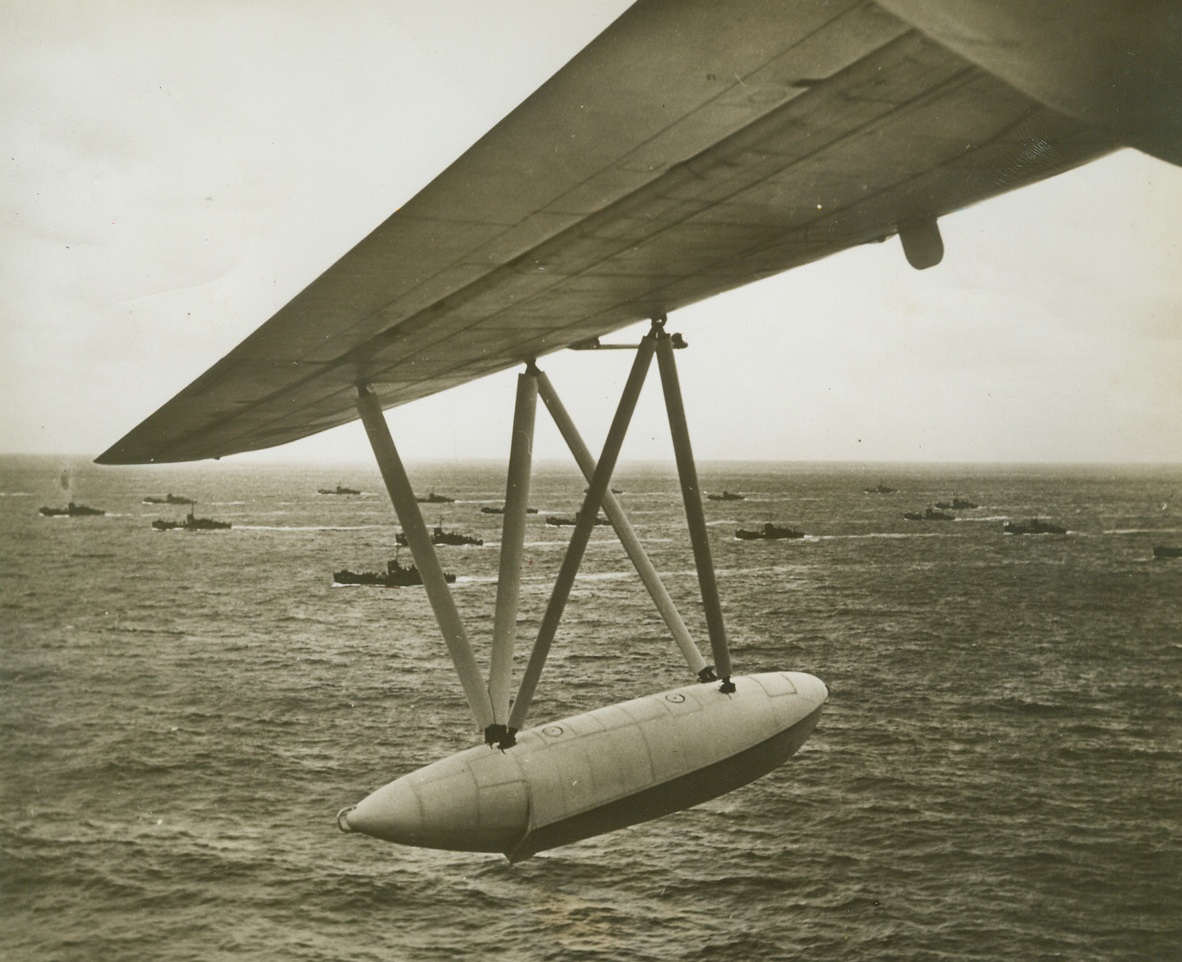
HOMEWARD BOUND, 10/27/1944. Sicily, Salerno and Normandy are on the log of this LCI flotilla making its triumphant homecoming at an East coast port. Invasion craft sailed for European coast nearly two years ago. Twenty of original 24 craft return—four were knocked out during Normandy invasion. Vessels are manned by Coast Guard crews. Credit: Coast Guard photo from Acme;
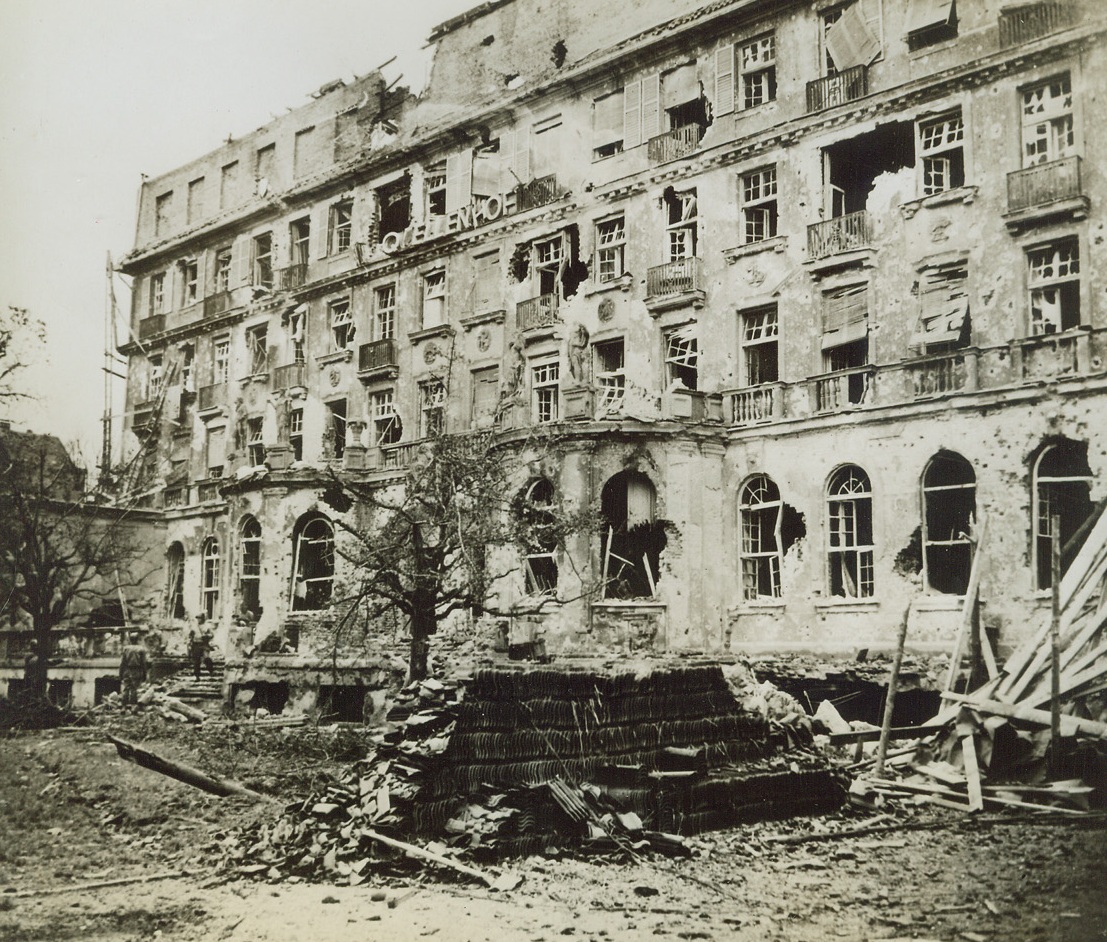
NAZI HEADQUARTERS IN AACHEN, 10/28/1944. GERMANY—This is a view of the Palace Hotel in the Quellenhof which was used as headquarters by the Nazi defenders of Aachen. A group of American GI’s enter the battered building. Credit: Acme;
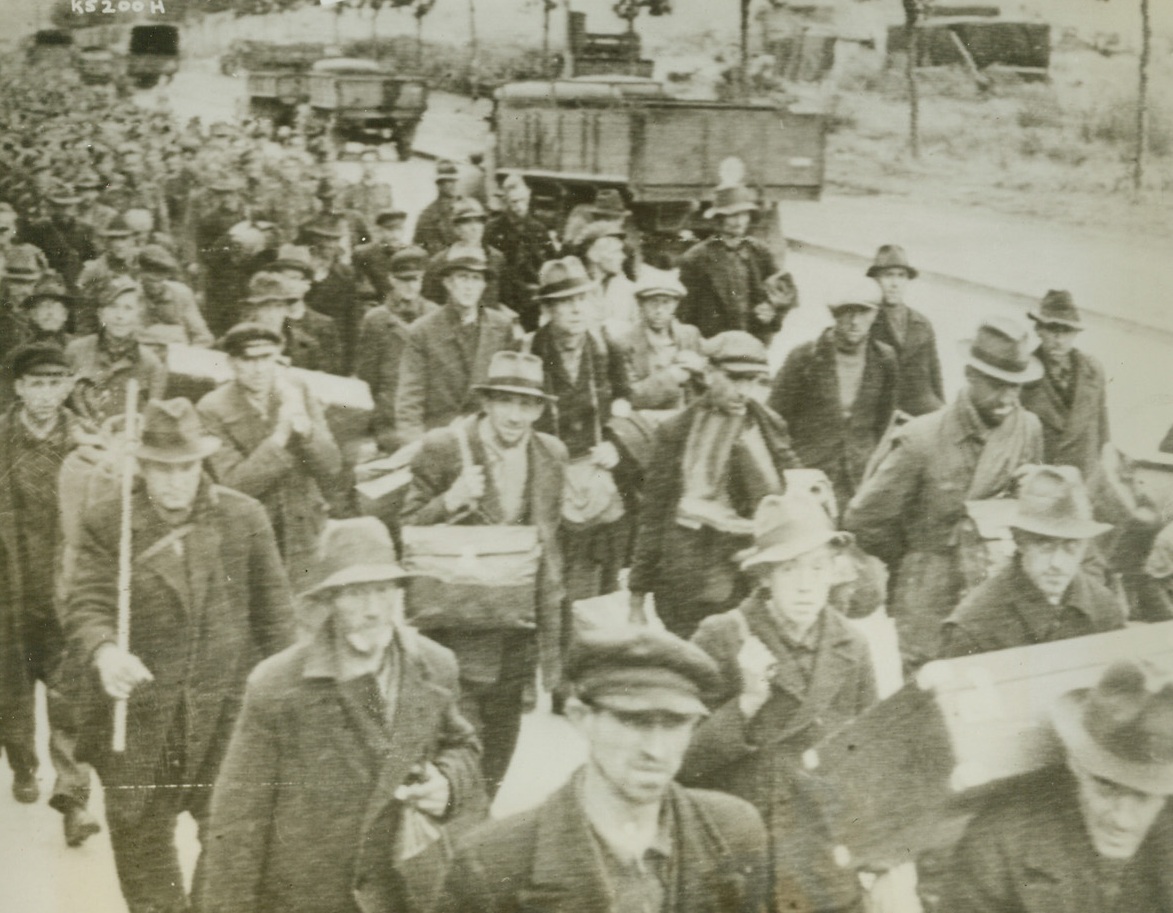
GERMAN PRISONERS LEAVE FRANCE, 10/4/1944. Rounded up on the Western Front, these Germans are shown on their way to prisoner of war camps in England. They were members of civilian groups working on fortifications and in other types of labor battalions. Credit: Army Radiotelephoto from Acme;
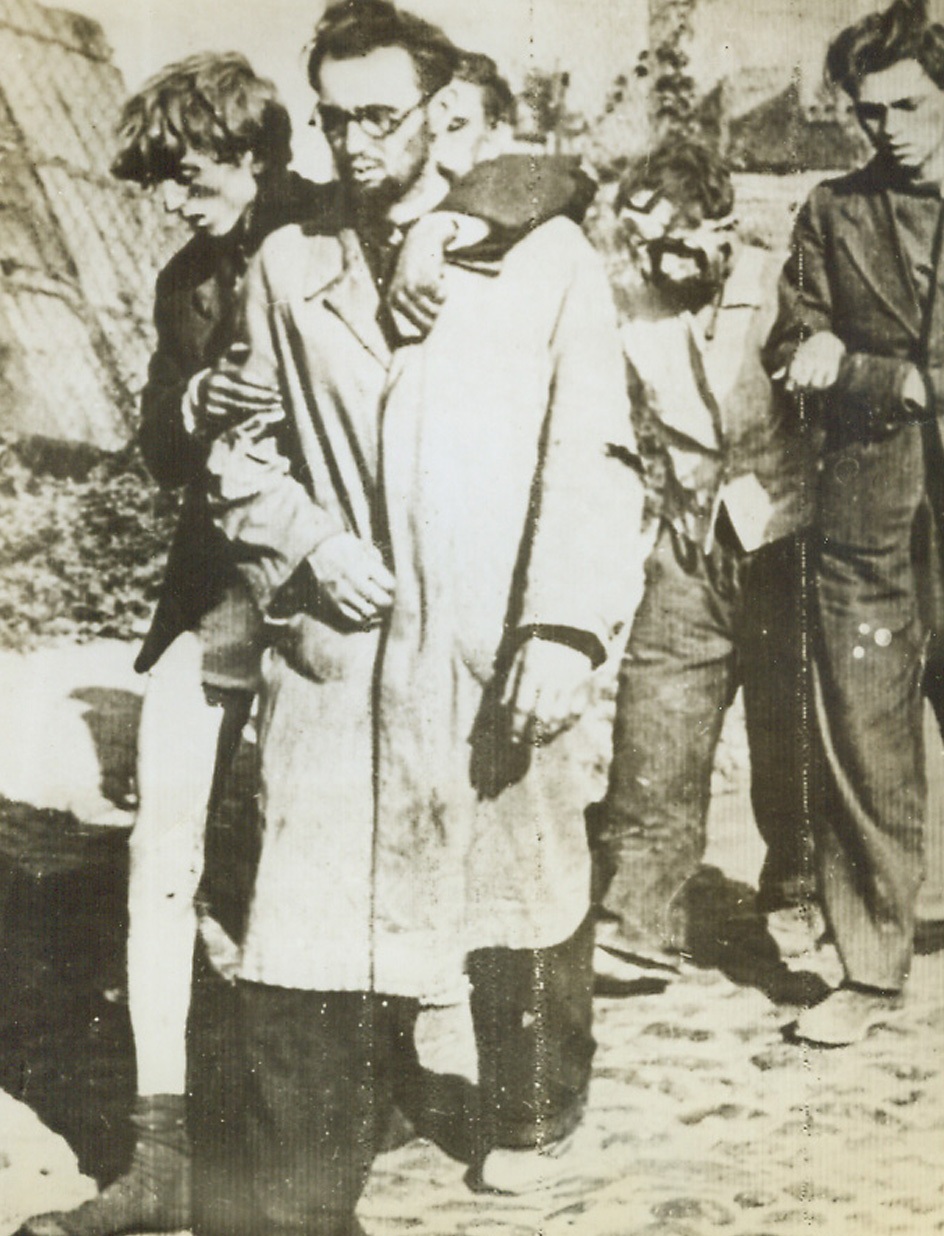
WARSAW POLES SURRENDER, 10/25/1944. Radioed to London from a neutral source and just received in New York this photo shows wounded and half naked men of the Warsaw resistance army marching dejectedly through the ruined streets of the Polish capital after their surrender to Nazi occupation forces. Premature uprising in Warsaw was quelled when the Russian armies bogged down on the outskirts of the city. Credit: Acme;
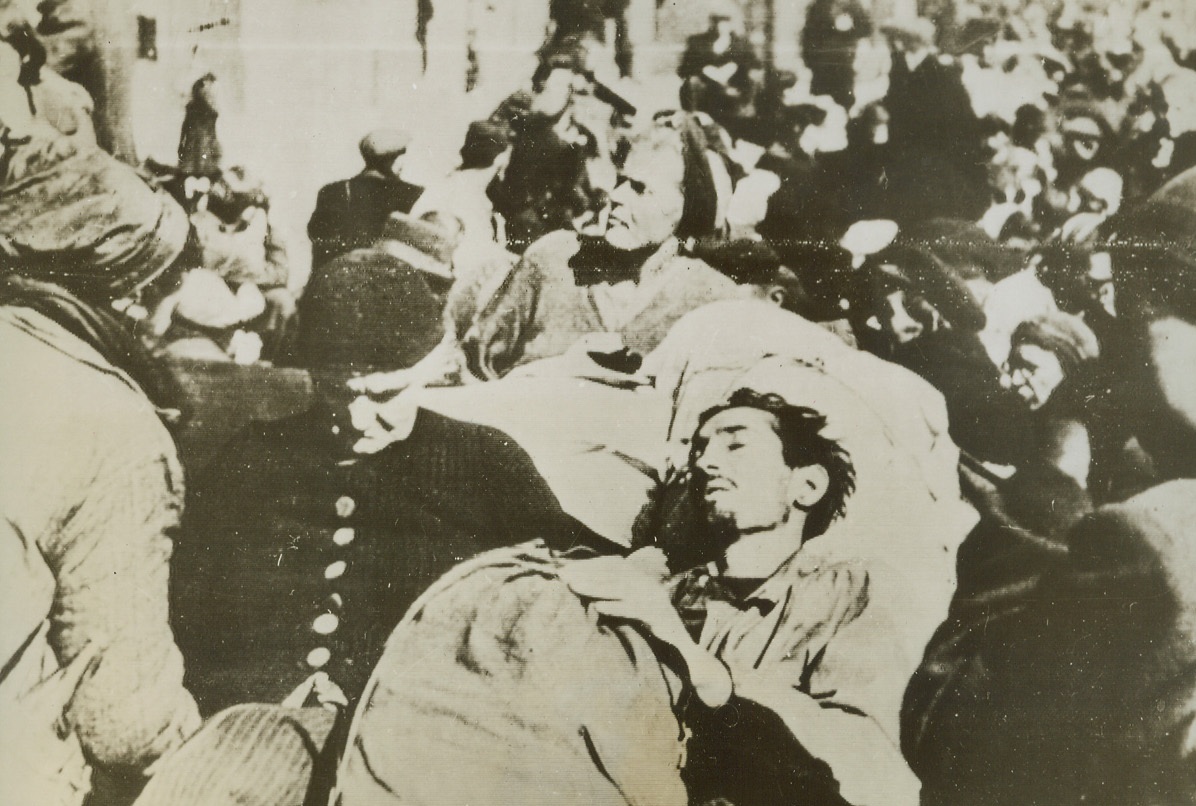
WARSAW POLES SURRENDER, 10/25/1944. Radioed to London from a neutral source and just received in New York this photo graphically depicts the tragedy and suffering of the people of Warsaw when the premature uprising by the resistance group was quelled by the Nazi hordes. Starved and war-weary Polish people are herded together before removal by the Nazis after final surrender. Credit: Acme;
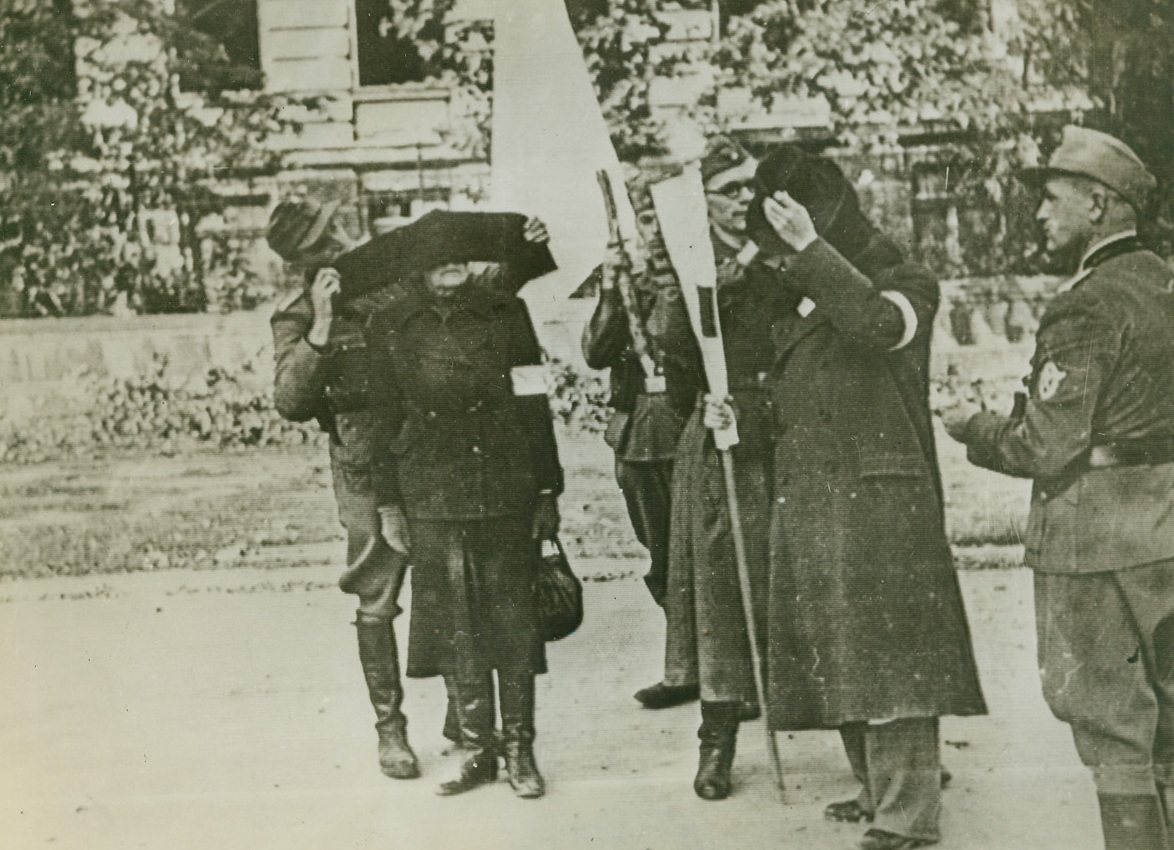
WARSAW POLES SURRENDER, 10/25/1944. Two Polish delegates of the Warsaw resistance group, a man at right and a woman, are blindfolded by Nazi soldiers before being passed through German lines after the premature uprising in the Polish capital was quelled by Hitler’s occupation forces. This photo, radioed to London from a neutral source, has just been received in New York. Credit: Acme;
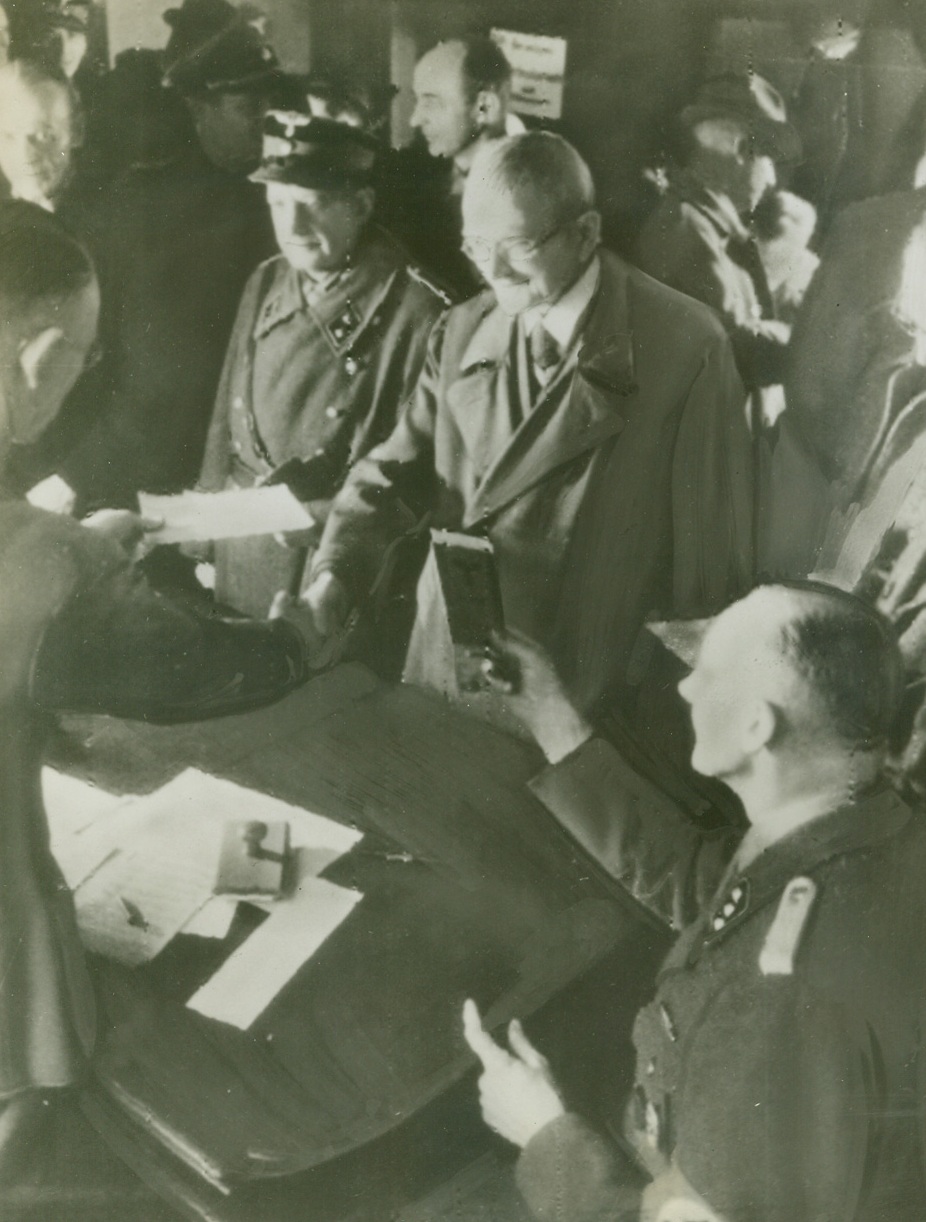
67-YEAR-OLD REGISTERS FOR NAZI ARMY, 10/25/1944. According to the German caption which accompanied this photo, radioed to New York from Stockholm, two elderly German veterans of the first World War are shown registering for service in the new Deutsche Volks-Sturm. Man at center right is sixty-seven years old. Credit: Acme Radiophoto;
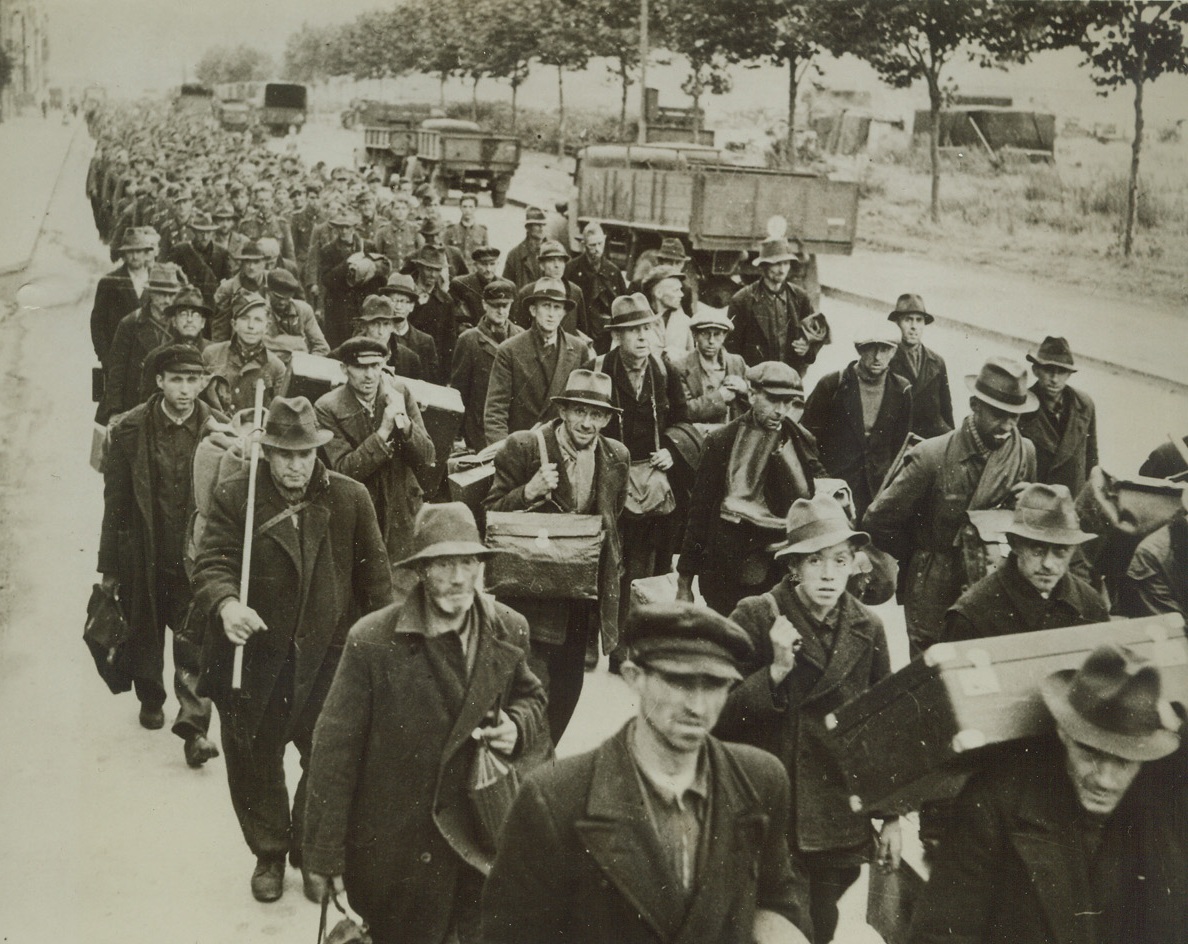
TAKE GERMAN PRISONERS—SOME IN CIVVIES, 10/19/1944. A crowd of German prisoners march to boats which will carry them to England. Those in civilian clothes have been rounded up after removing their battle outfits in an effort to avoid capture. Credit: British official photo from Acme;
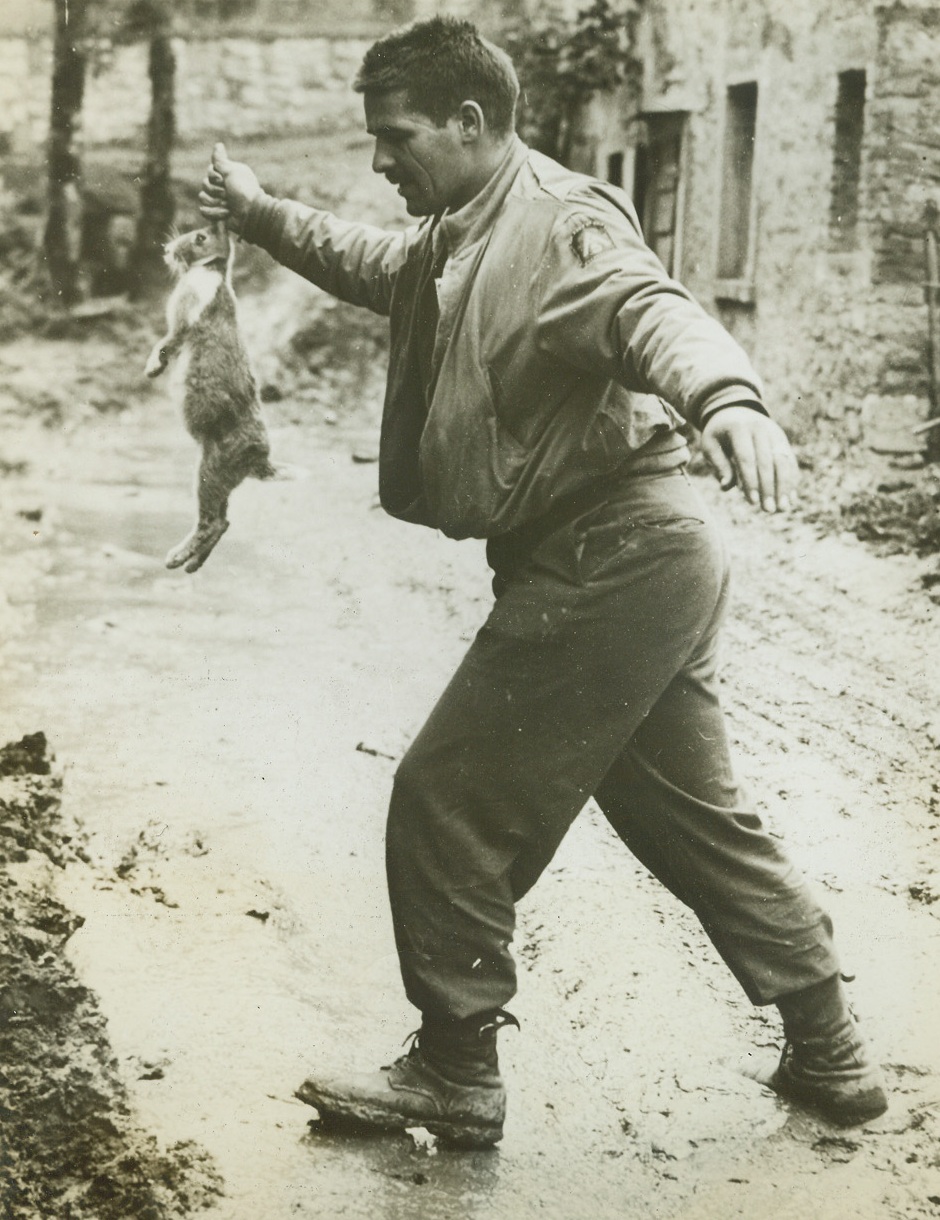
BUNNY DUCKS THE MUD, 10/19/1944. ITALY—Pfc. Lloyd F. Tegge, of Waukesha, Wis., carries his pet rabbit, “Rexine Gothic” across the ooze of a road in the Pietramala area. The prize bunny has been through the entire Gothic Line sector with its master, who is attached to the 5th Army. Credit: Army photo from Acme;
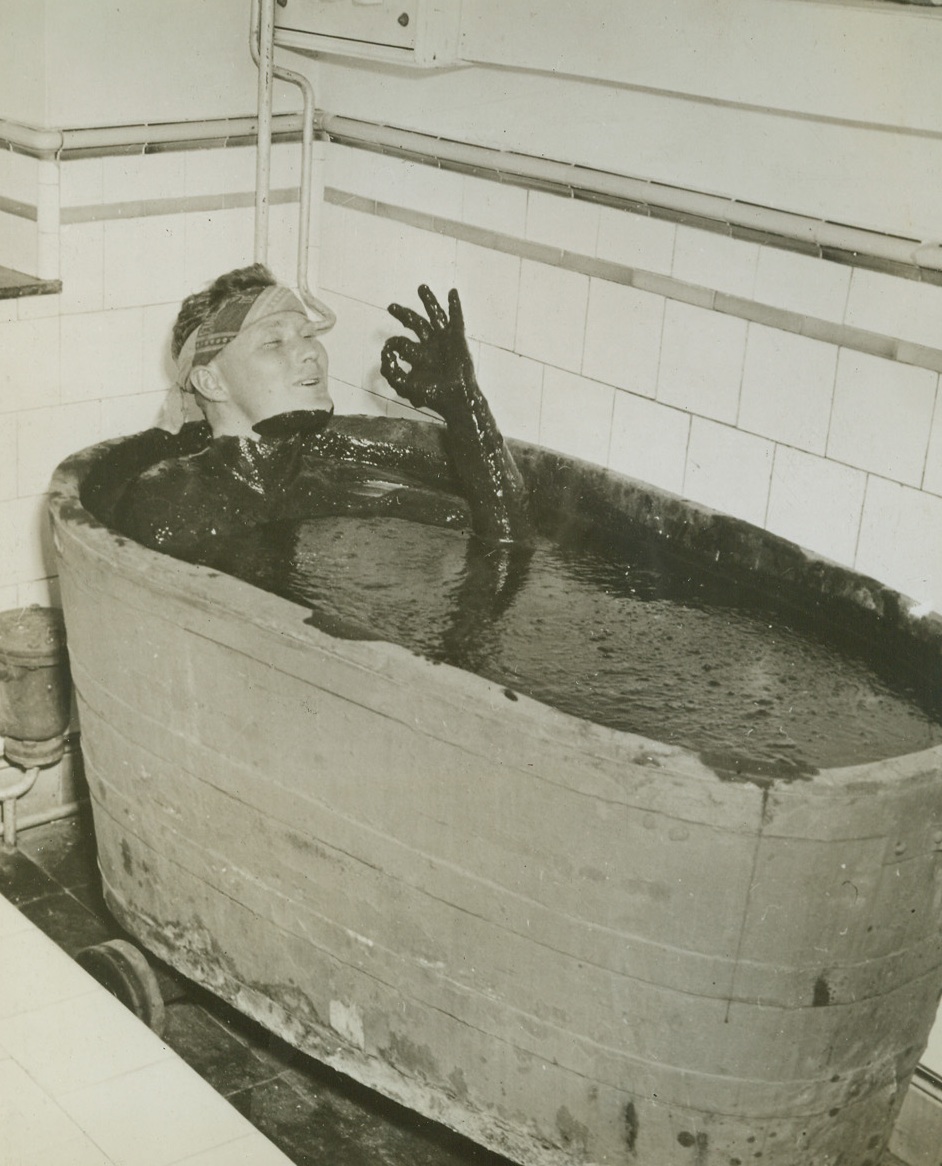
HERE’S MUD IN YER TUB, 10/10/1944. SPA, BELGIUM—Any similarity between this slimy batter and the variety of mud found in a GI’s front line trench is purely coincidental. For one thing, Sgt Edward E. Shelton of San Antonio, Texas, chose to immerse himself in the oozing stuff. For another, it’s supposed to be healthful. It might look the same to this Yank, but after aiding in the liberation of the town of Spa, he decided that it would be shameful not to take advantage of the famous mineral and mud baths. Credit: Signal Corps photo from Acme;
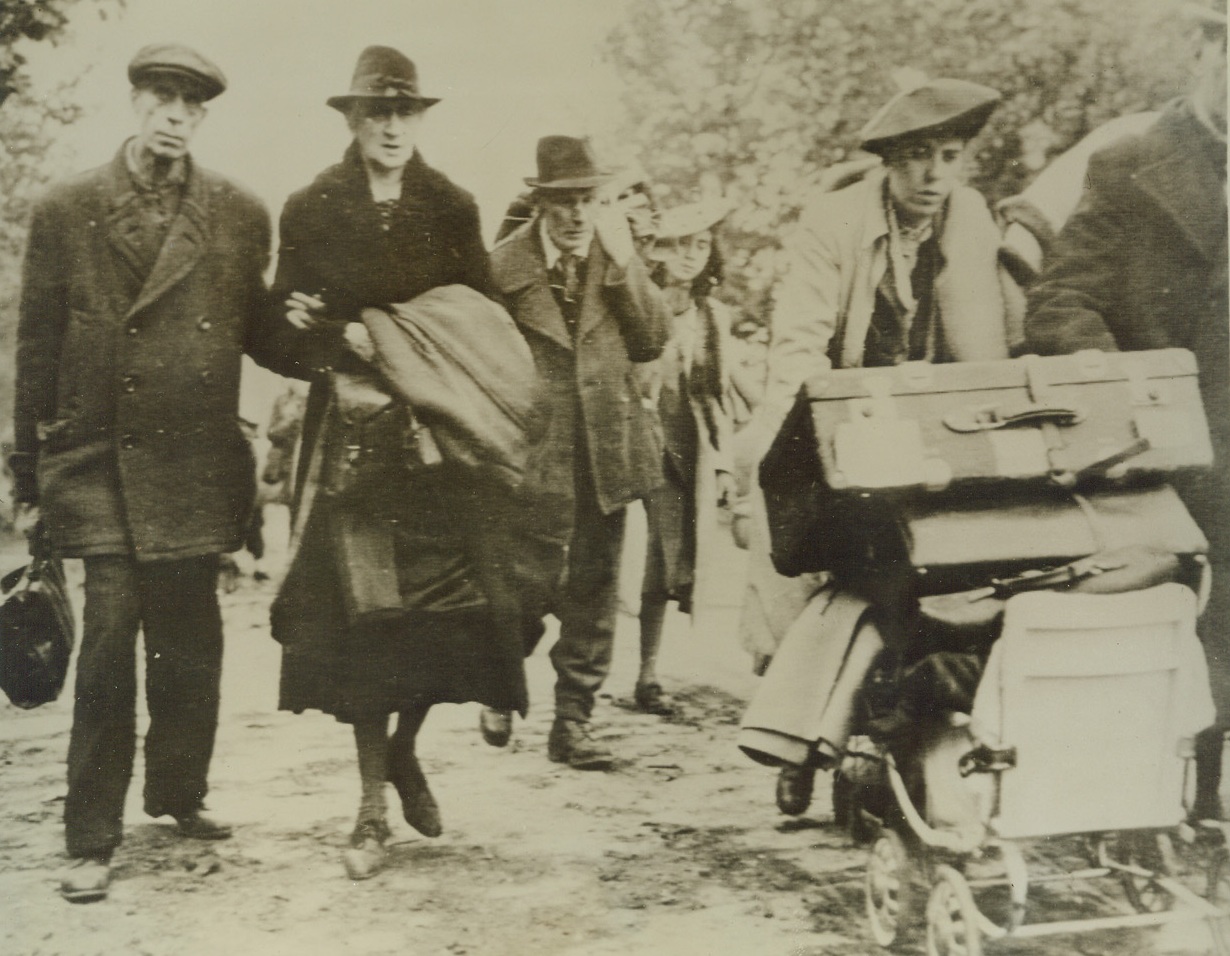
WAR WEARY GERMANS FLEE AACHEN, 10/17/1944. GERMANY—Civilian residents of Aachen leave the flaming city after their surrender to American forces. The refugees carry or cart their meager belongings as they march to safety. The dazed and worn expression on all tells the story of endless days of concentrated bombings. Credit: Army radiotelephoto from Acme;
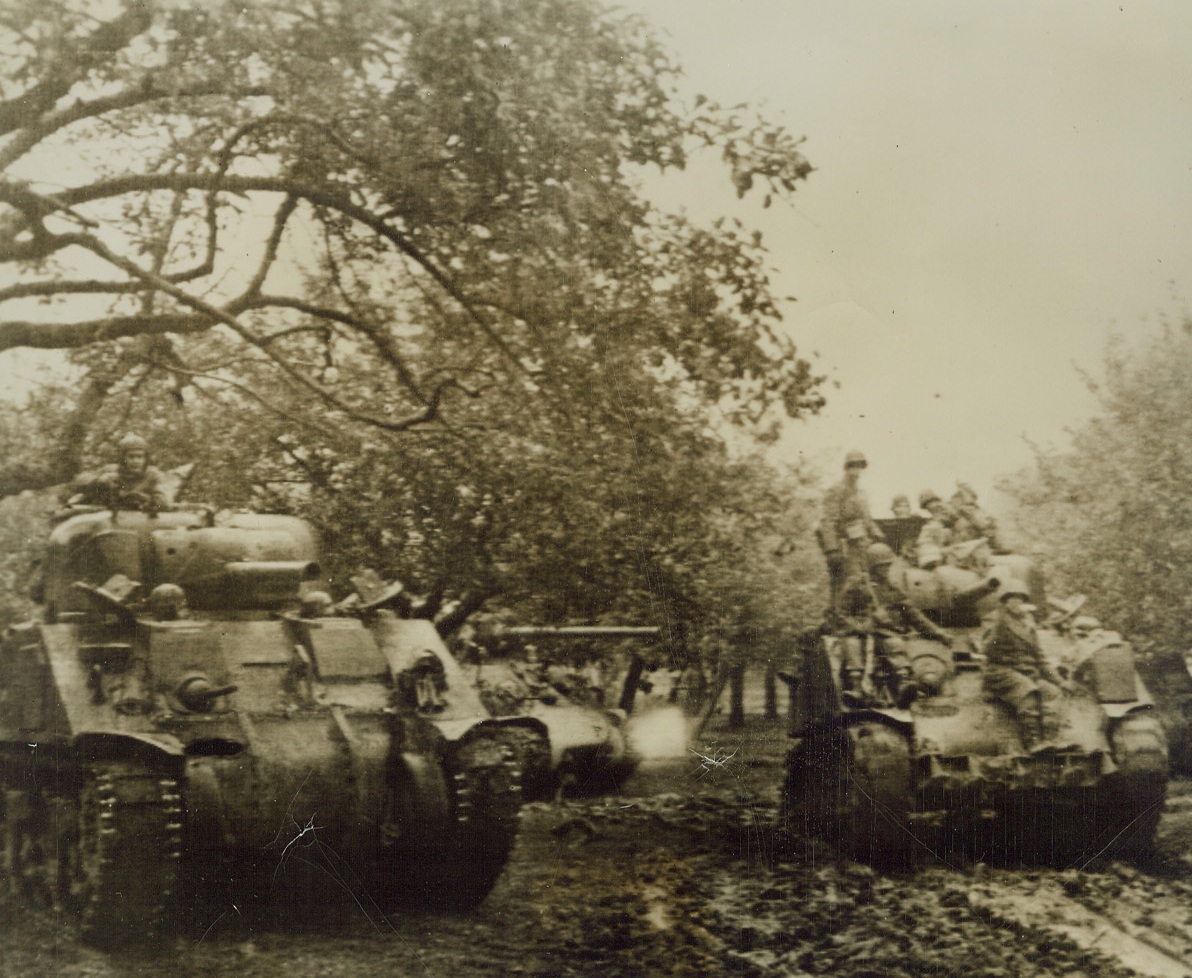
G. I. HITCH-HIKERS, 10/8/1944. UBACH, GERMANY—Moving up to the front near Ubach, these troops hitch a ride on board a medium tank. Credit: Army radiotelephoto from Acme;
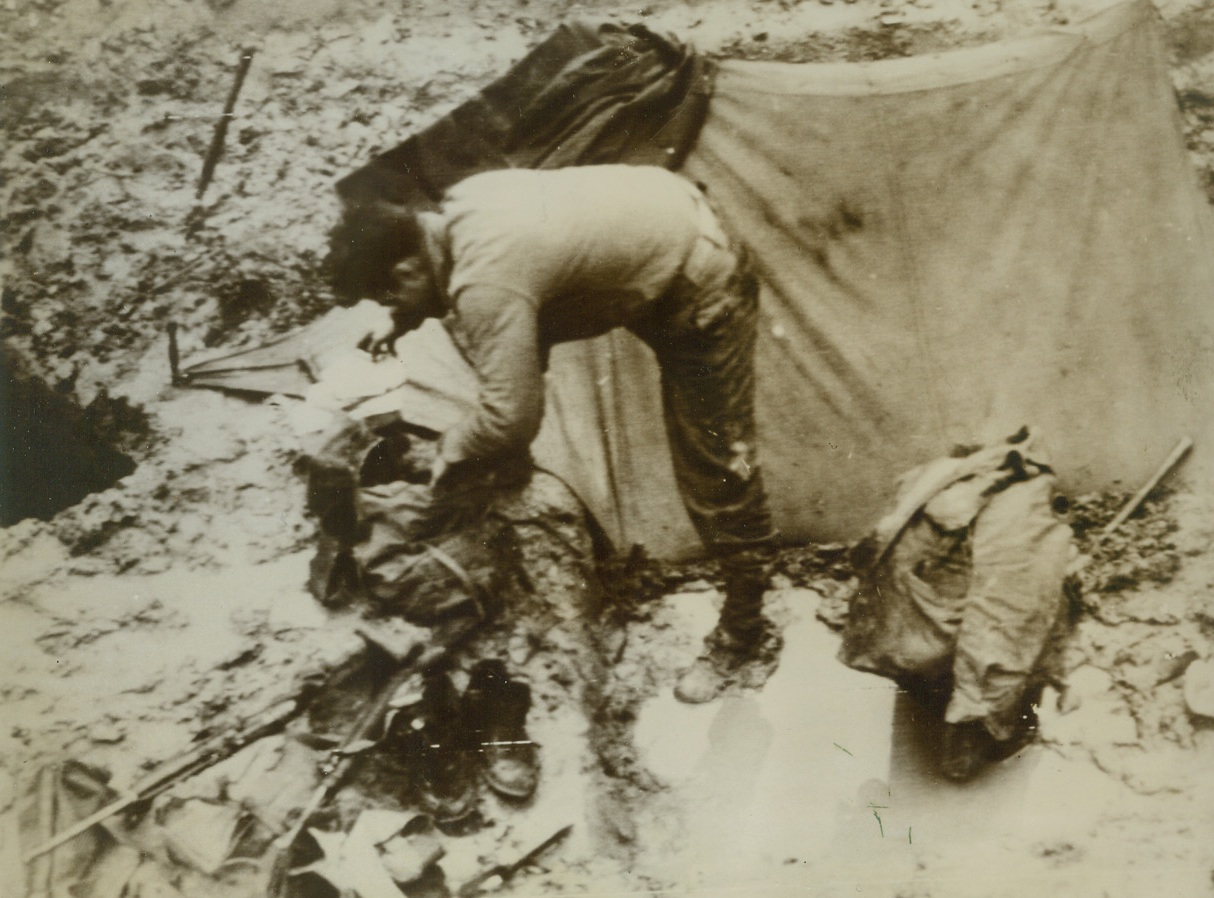
YANKS HIT RAINY SEASON, 10/12/1944. GERMANY—An American soldier tries to find some dry clothing, after being rained out of his bivouac camp in a German tank trap. Rain and mud have been hampering Allied advance, particularly in the Luxembourg Sector. Credit: Army radiotelephoto from Acme;
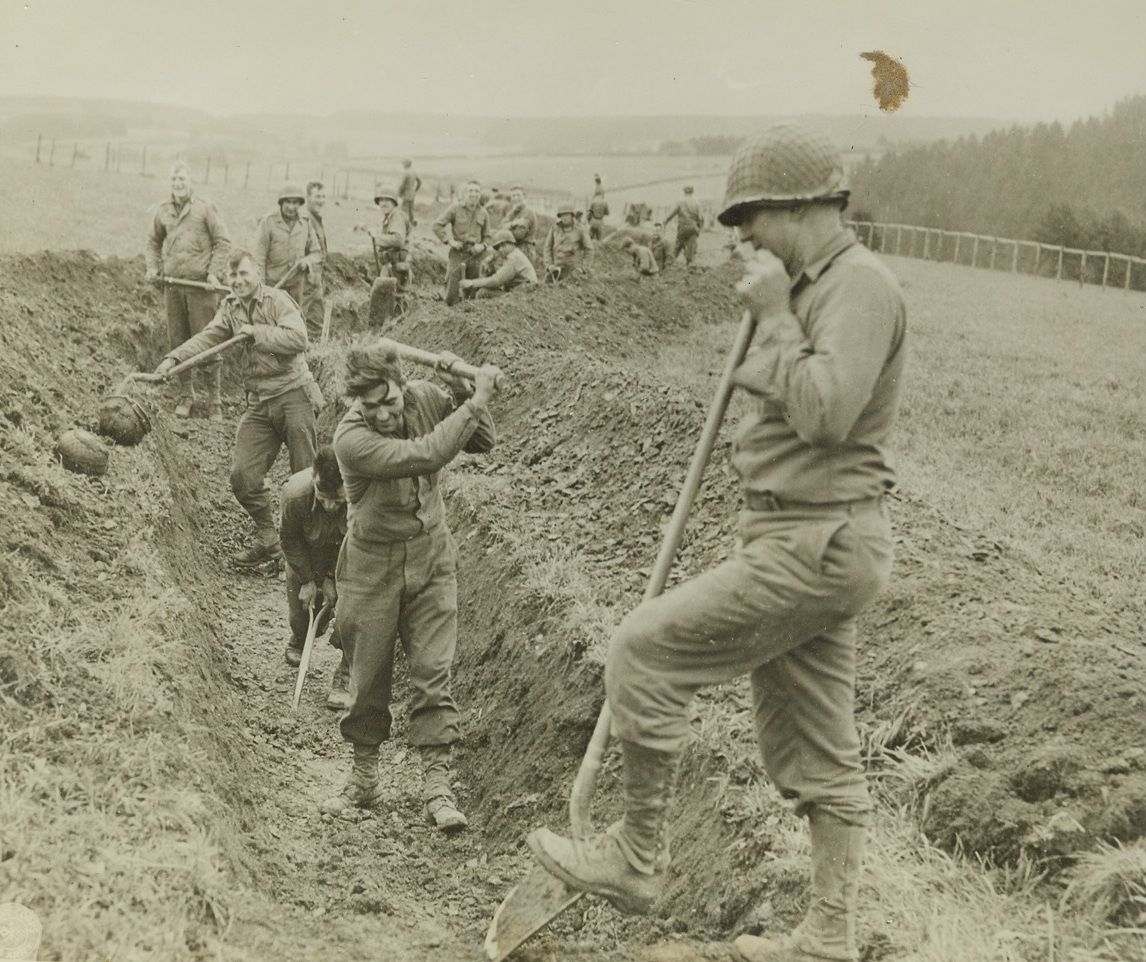
YANKS DIG IN—AGAIN, 10/19/1944. BELGIUM—Swinging shovels and picks with…will, U.S. Infantrymen dig in along the…line of trenches used during Word War…to protect themselves from enemy action. Credit: U.S. Signal Corps photo…;
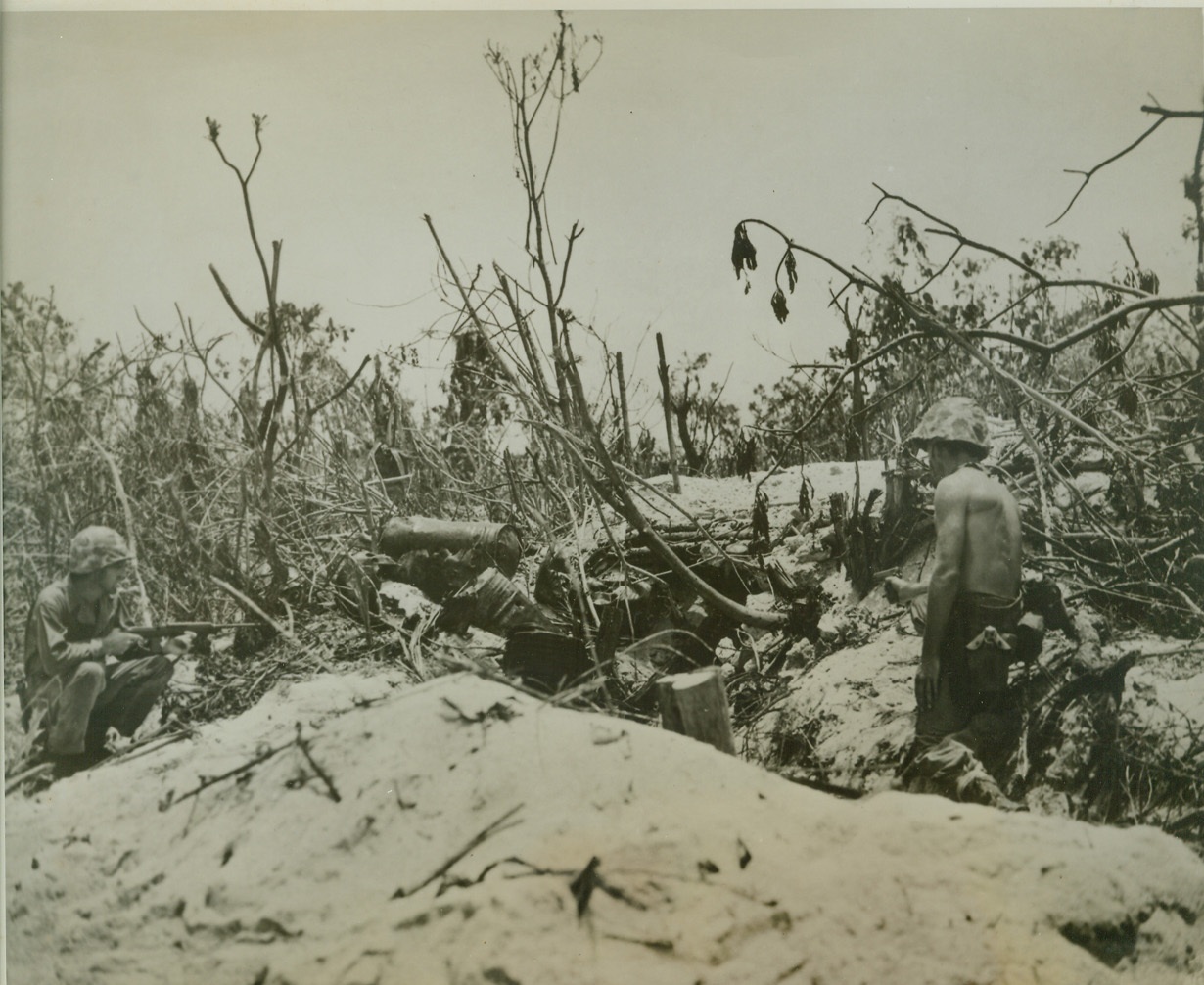
When Japs Get Stubborn, 10/2/1944. PELELIU ISLAND, PALAU -- Cautiously advancing on a Jap pillbox on Peleliu, two Marines order the enemy soldiers inside to surrender. When the Japs refused, the Leathernecks were left with but one alternative -- to blow them out. Credit: (Marine Corps Photo from ACME);
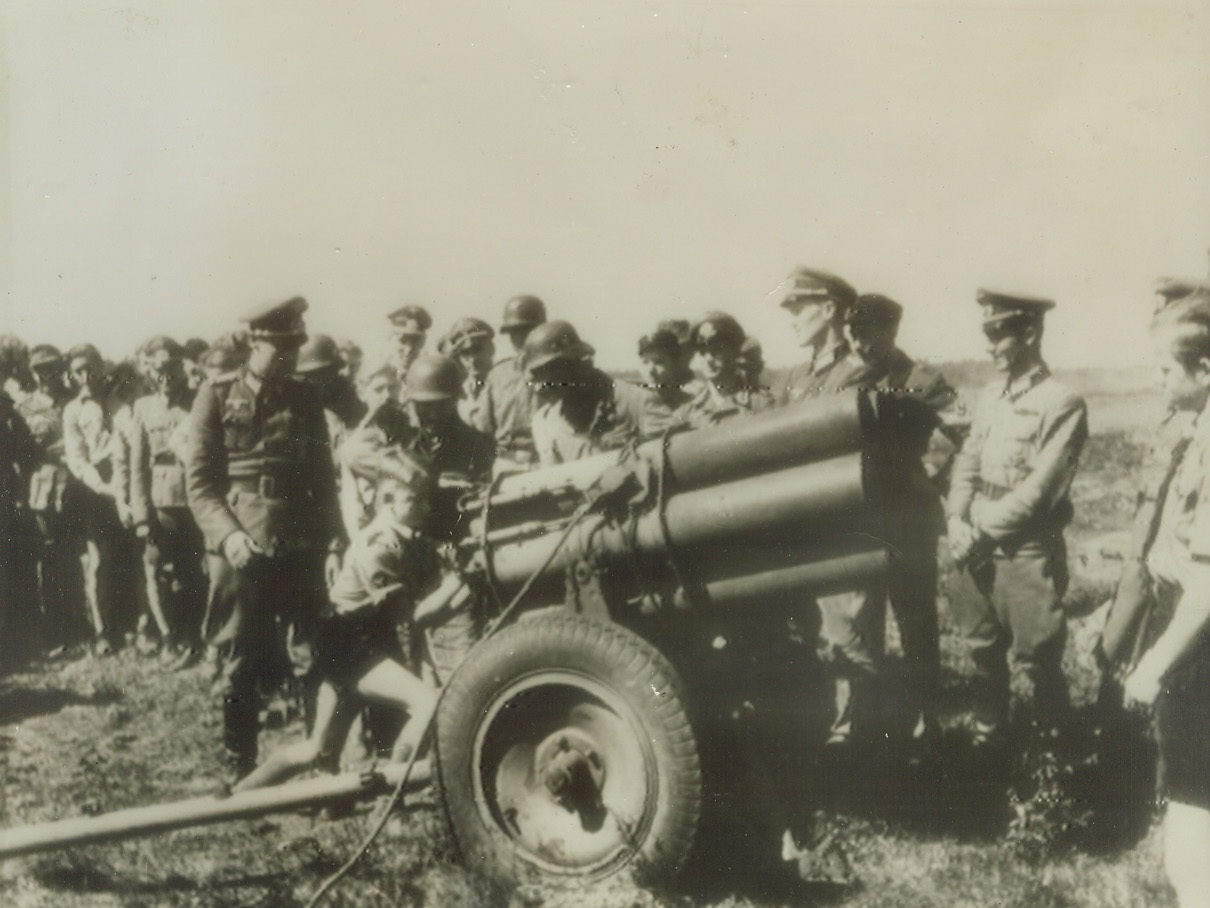
Nazi Youth Bred for Cannon, 10/5/1944. GERMANY – This photo radioed to New York from Stockholm shows a group of German children, ages 9 to 15, being trained by Nazi officers in the proper handling of a multiple rocket gun. Military training for these children in Nazi-ruled Germany is now compulsory. Credit (ACME Radiophoto);
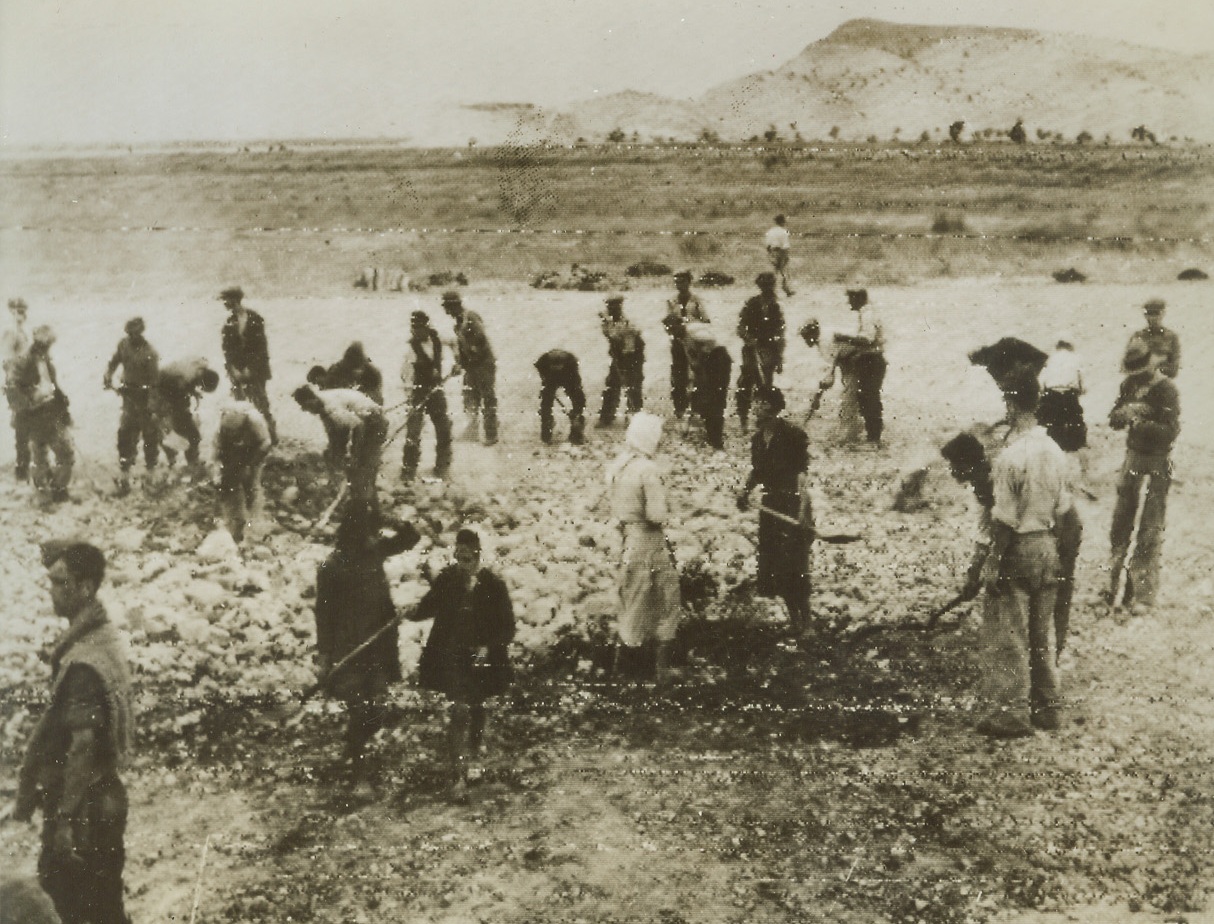
First Photo of Greek Invasion, 10/6/1944. GREECE – Men, women, and children of Greece lend willing and helpful hands at filling in the craters on an airfield in Greece after the arrival of RAF forces. Early today, swarms of Allied invasion forces were reported pouring into the country and threatening the German garrison at Athens. Credit (British Official Radiophoto via OWI from ACME);
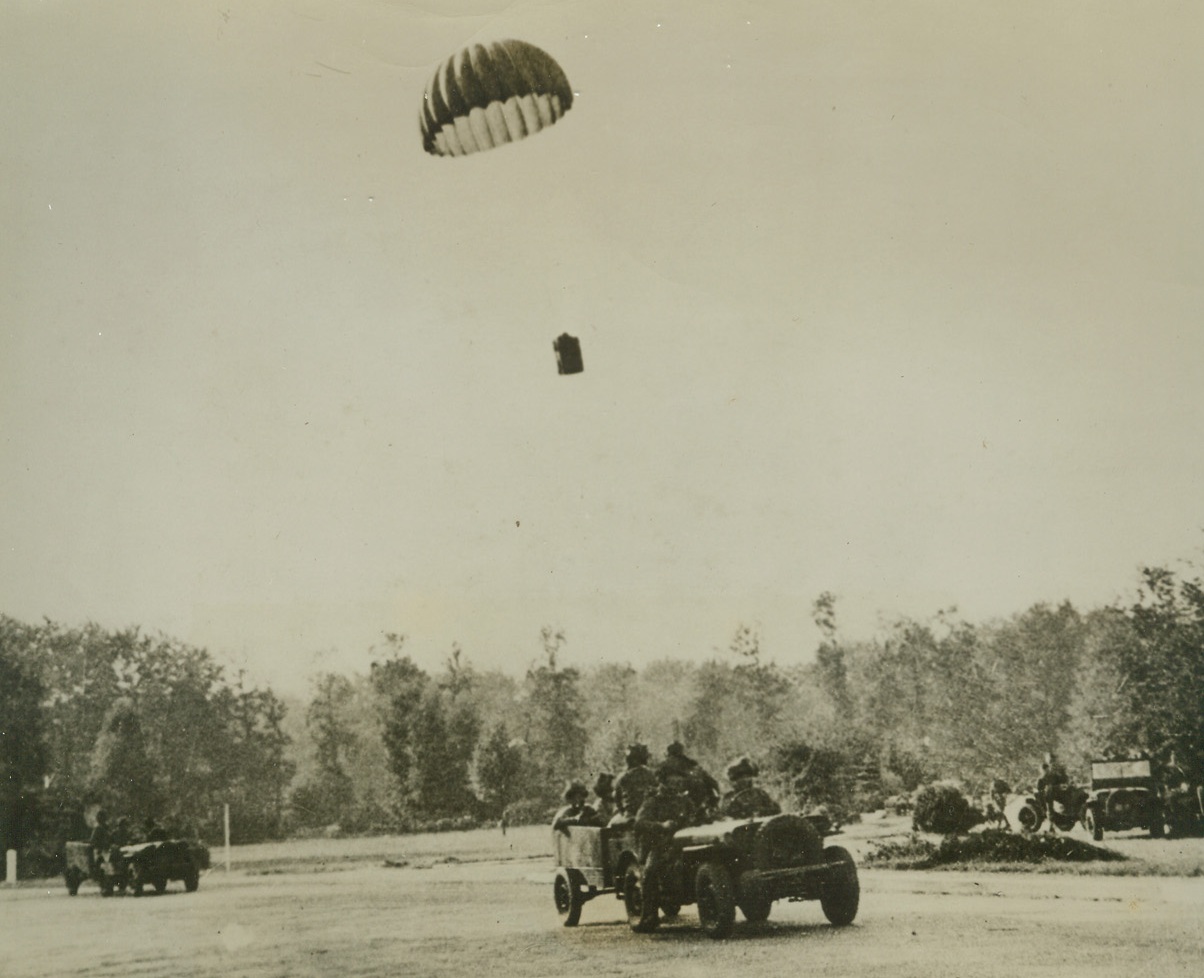
Supplies for Trapped Warriors, 10/2/1944. HOLLAND – Settling slowly to earth, a supply basket ‘chutes to waiting men of the First Allied Airborne Army in Holland. Of the 8,000 who dropped in the air invasion and were later forced to abandon their positions, only 2,000 warriors managed to get out safely. Credit (British Official Photo from ACME);
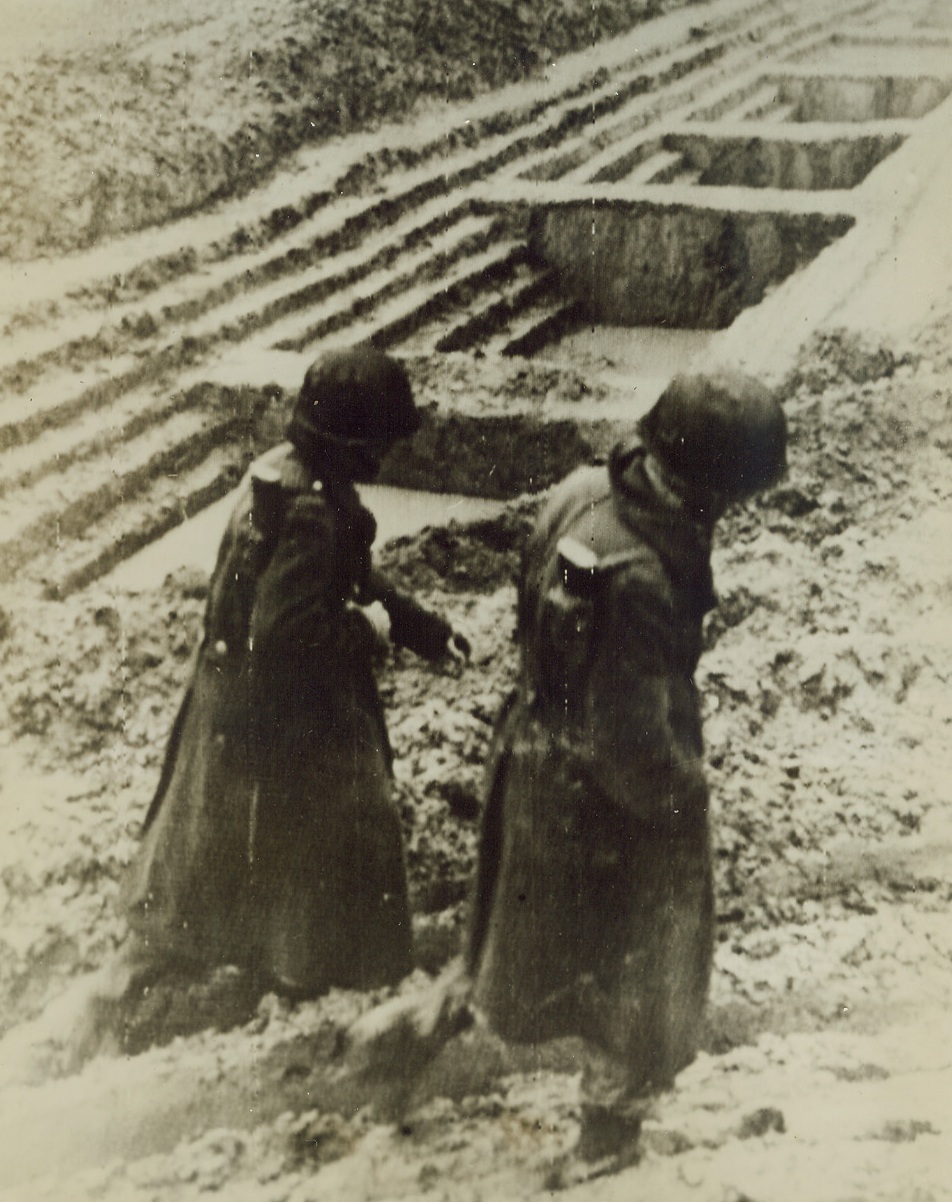
Tough Going in Germany, 10/13/1944. GERMANY – Wearing boots and their winter overcoats, these Yanks trudge slowly through the deep mud past a captured Nazi tank trap, which is a series of cleverly constructed steps, ending in a hollow with a wall in front. Heavy rains continue to bog down operations on the German frontier. Credit (Signal Corps Radiotelephoto from ACME);
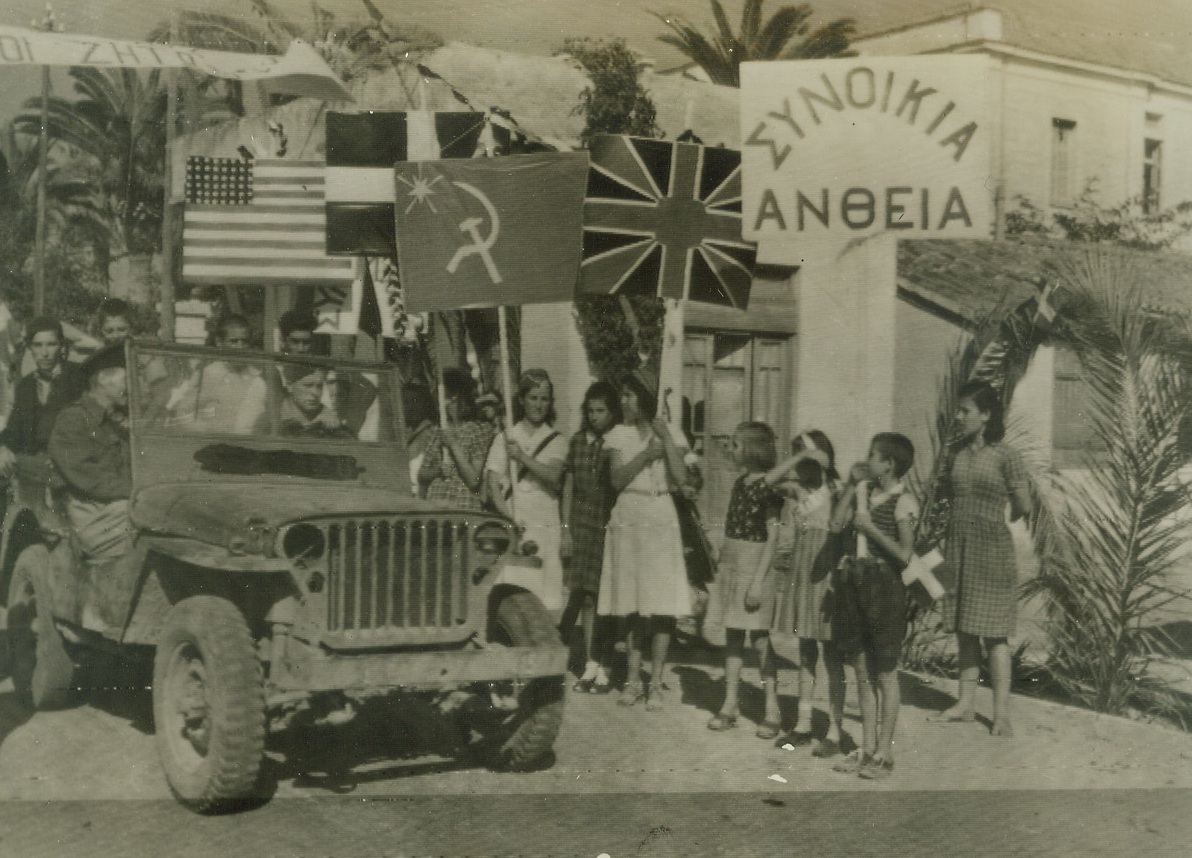
Greek Children Welcome RAF, 10/9/1944. PATRAS, GREECE -- As members of the RAF ride into liberated Patras in armored cars, Greek children into the streets, carrying banners of welcome and flags of the Allied nations. The sign is a welcome in Greek. Credit (ACME Radiophoto);
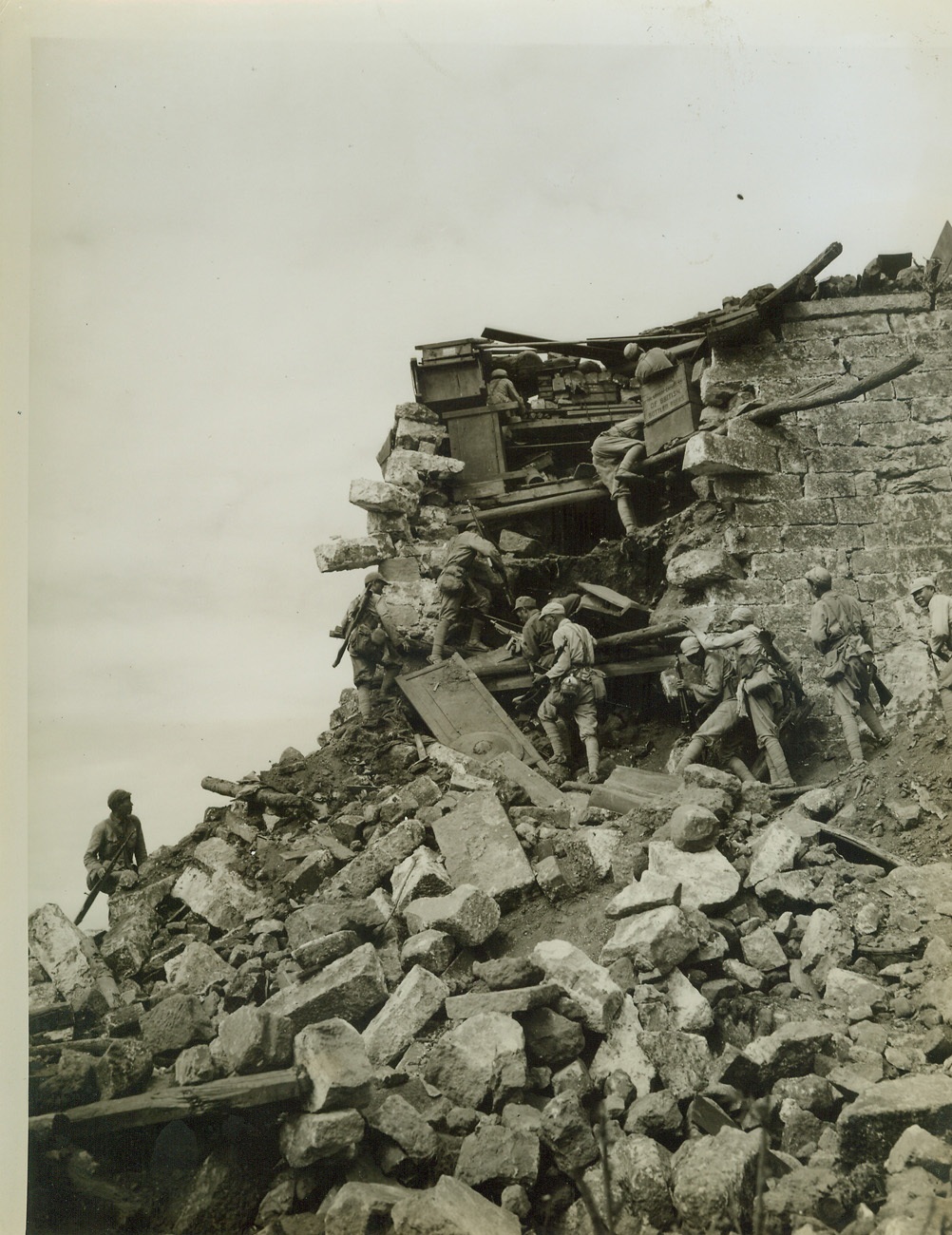
Tengchung Captured From Japs, 10/4/1944. CHINA -- The first city east of Burma to be liberated by the Allies, the ancient jade center of Tengchung has been captured from the Japs after five bloody weeks of fighting. Here, Chinese soldiers scale the blasted wall of the city. Smoke in the background is from Allied grenades that had been tossed over the wall.;
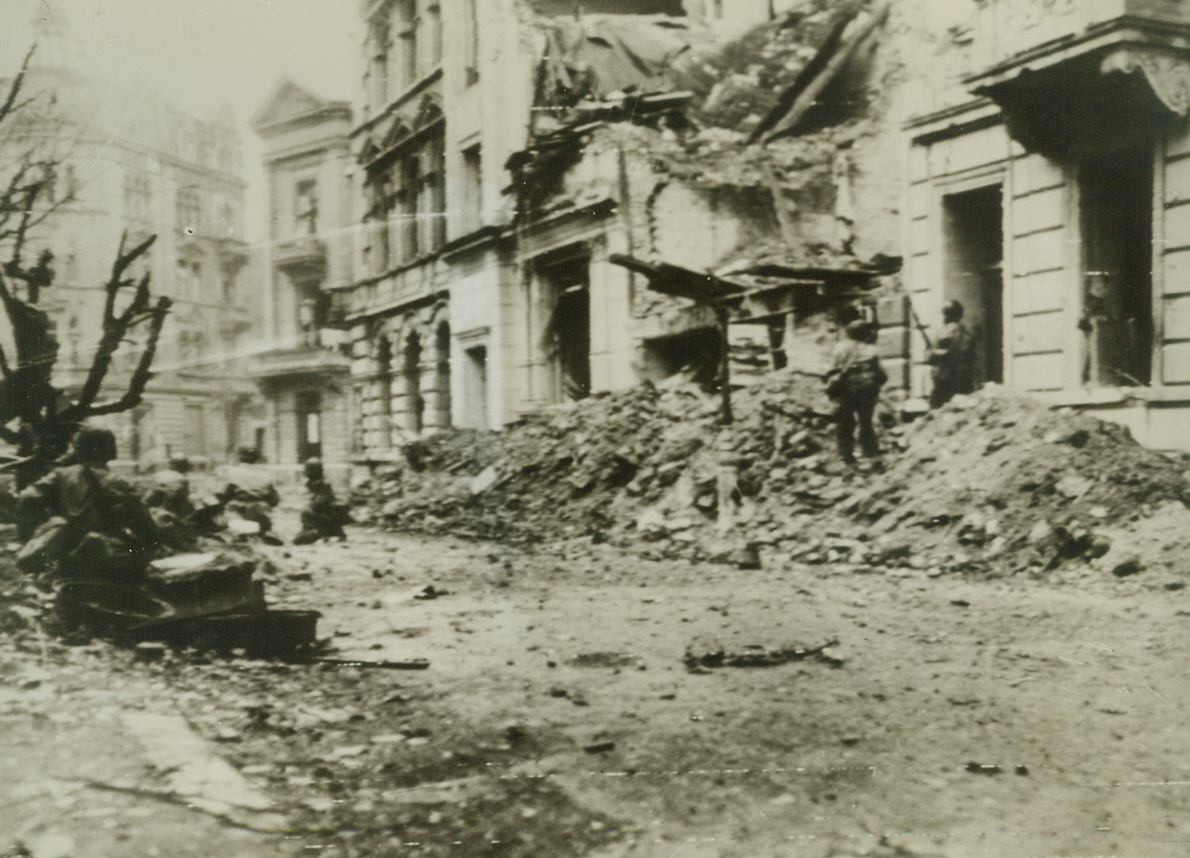
Sniper Hunt in Aachen, 10/17/1944. Making their way over the rubble-strewn streets of this blasted city in Germany, U.S. Infantrymen search out sniper nests of Nazis trapped in the ruins. Credit Line (Army Radiotelephoto from ACME);
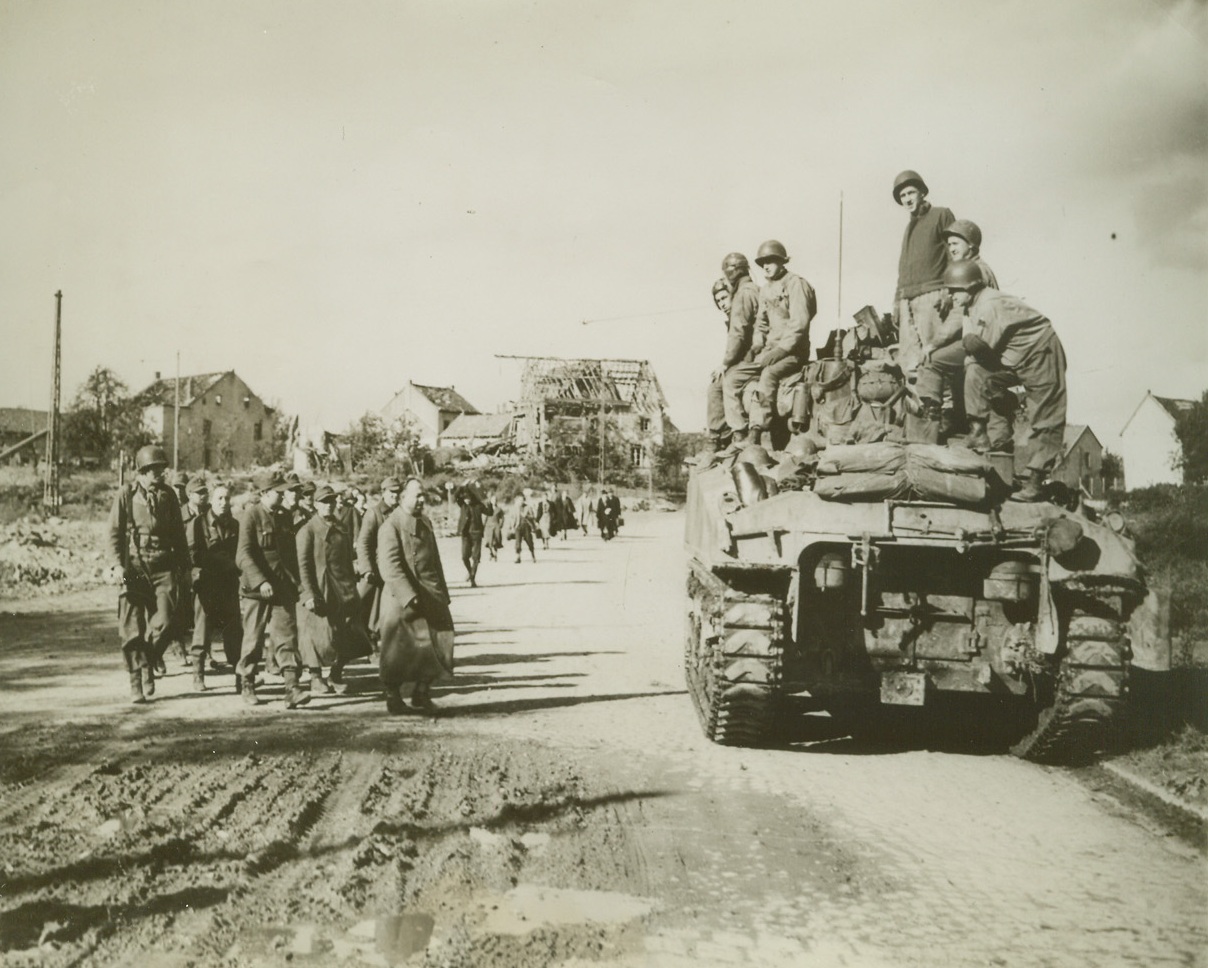
They Quit Aachen Battle, 10/18/1944. Guarded by an American Infantryman, a long line of Germans surrenders to the crew of a U.S. 1st Army tank in the battered city of Aachen, Germany. Credit: (ACME) (WP);
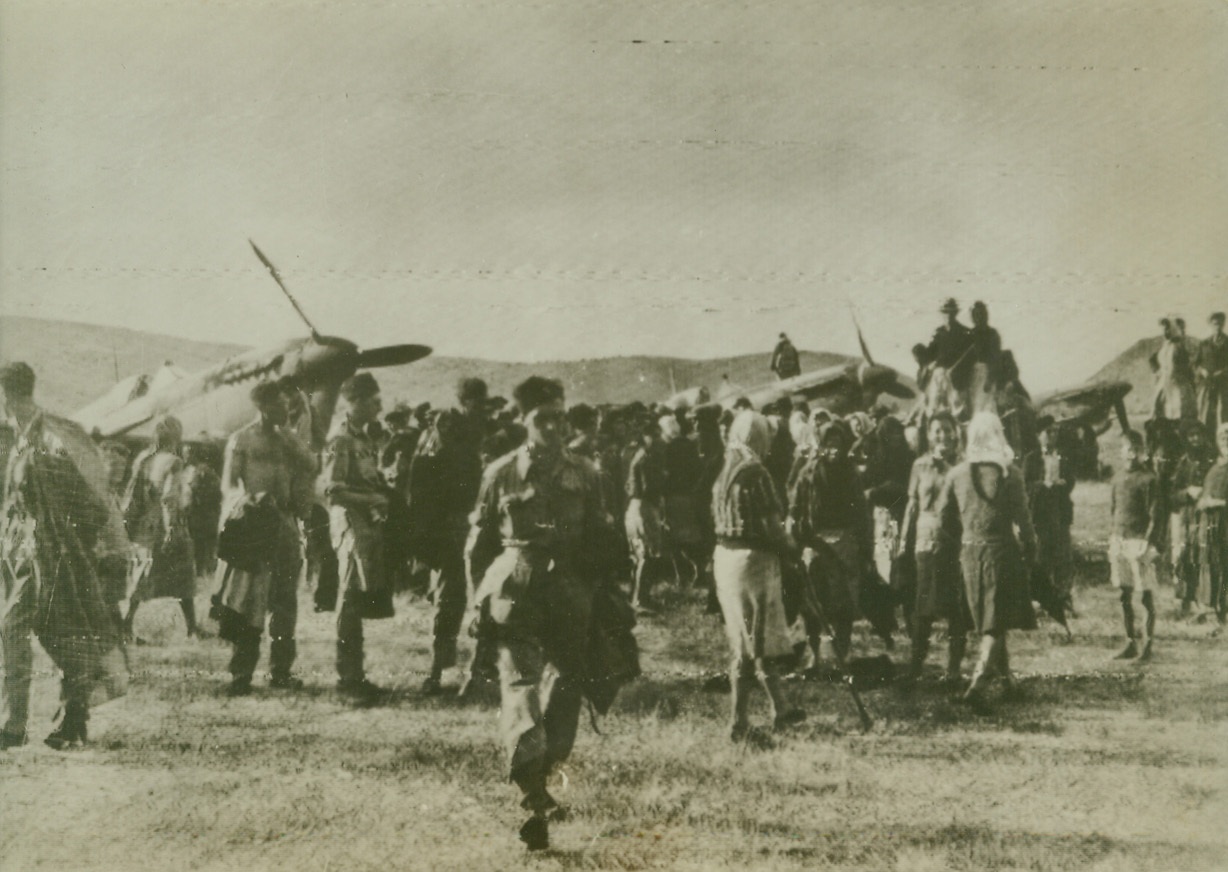
First Photo of Greek Invasion, 10/6/1944. GREECE – Greek civilians joyfully greet RAF crew members on an airfield used by a Spitfire squadron in Greece. It was reported early today that Allied invasion forces are swarming into the country and are now threatening the Nazi garrison at Athens.Credit (British Official Radiophoto via OWI from ACME);
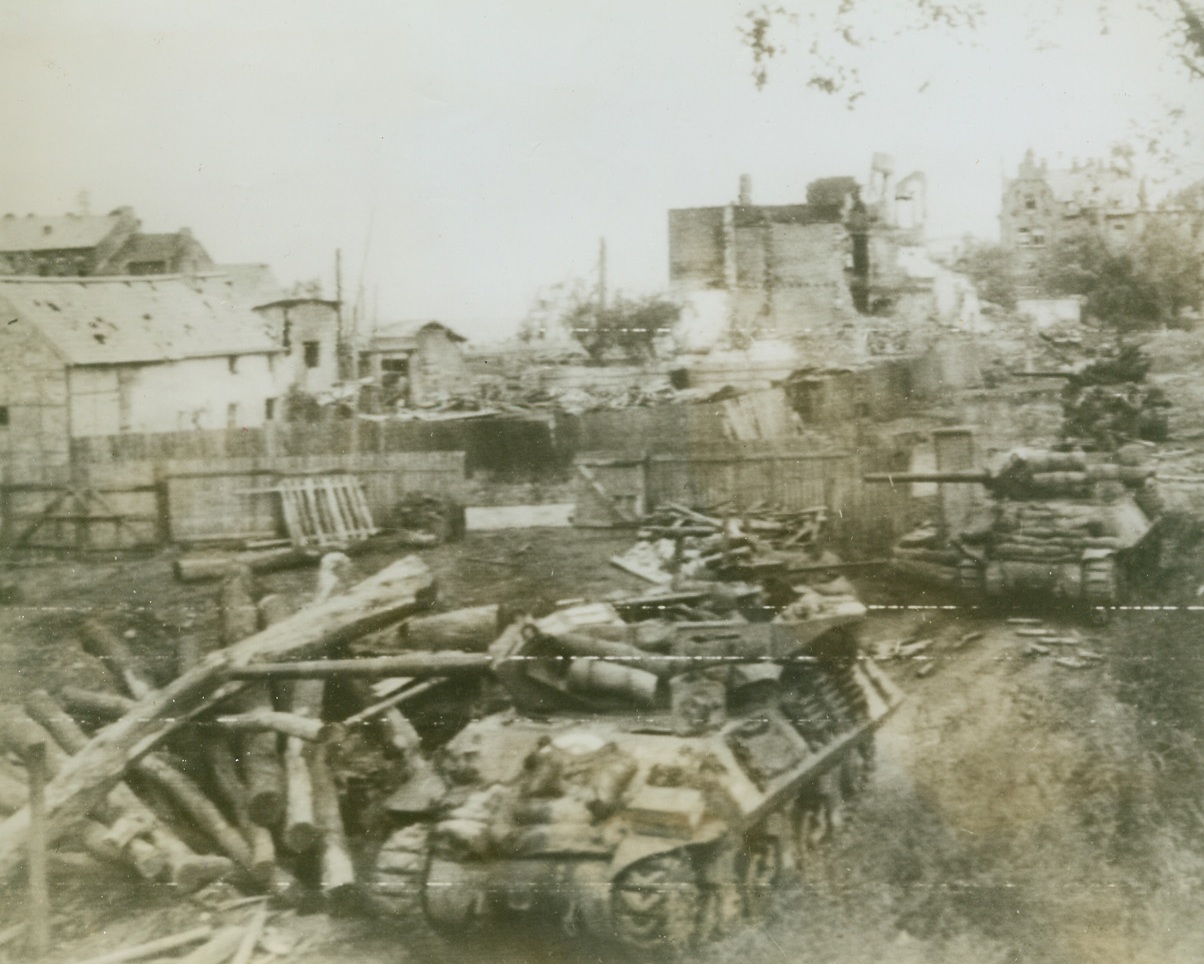
U.S. Tanks Roll into Aachen, 10/14/1944. GERMANY – Guns pointed toward enemy positions American tanks roll deeper into Aachen past bomb-gutted buildings.Credit (Army Radiotelephoto from Acme);
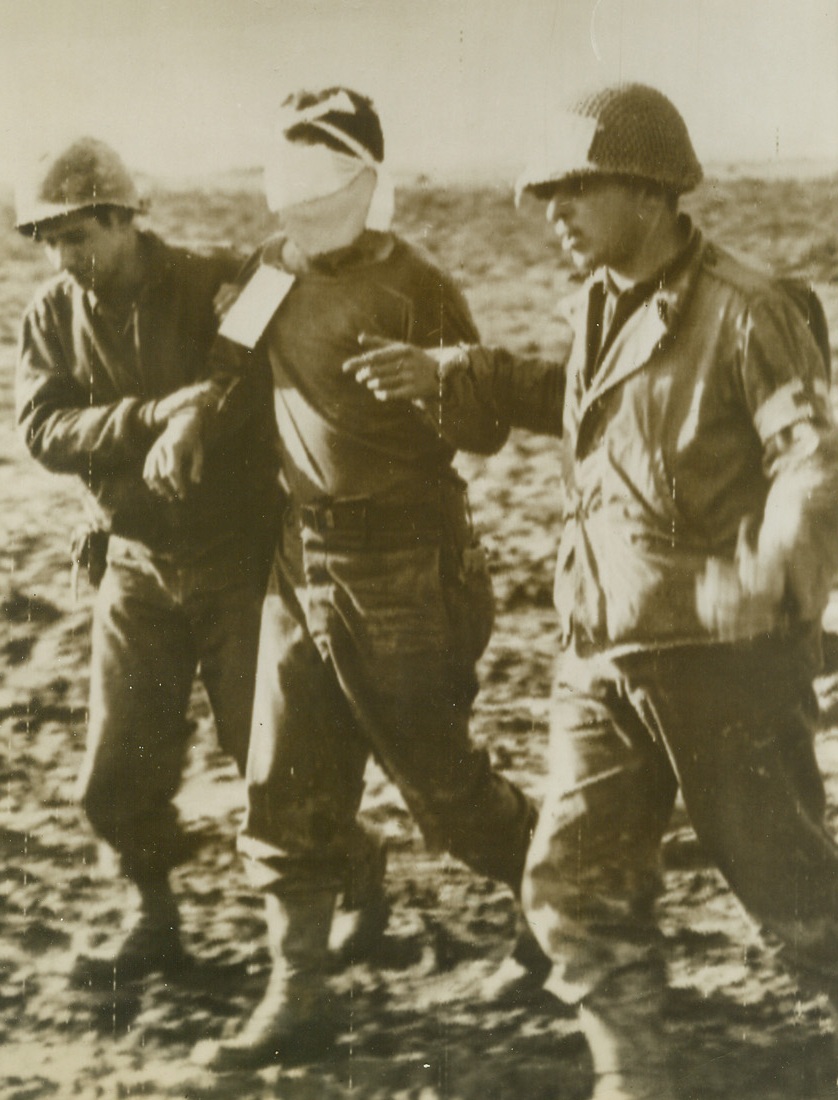
Wounded Yank Led to Safety, 10/13/1944. GERMANY – Blown out of his foxhole near Beggendorf, Germany, an American soldier is taken to an advance aid station by Medical Corpsmen who braved enemy fire to rescue their comrade.;
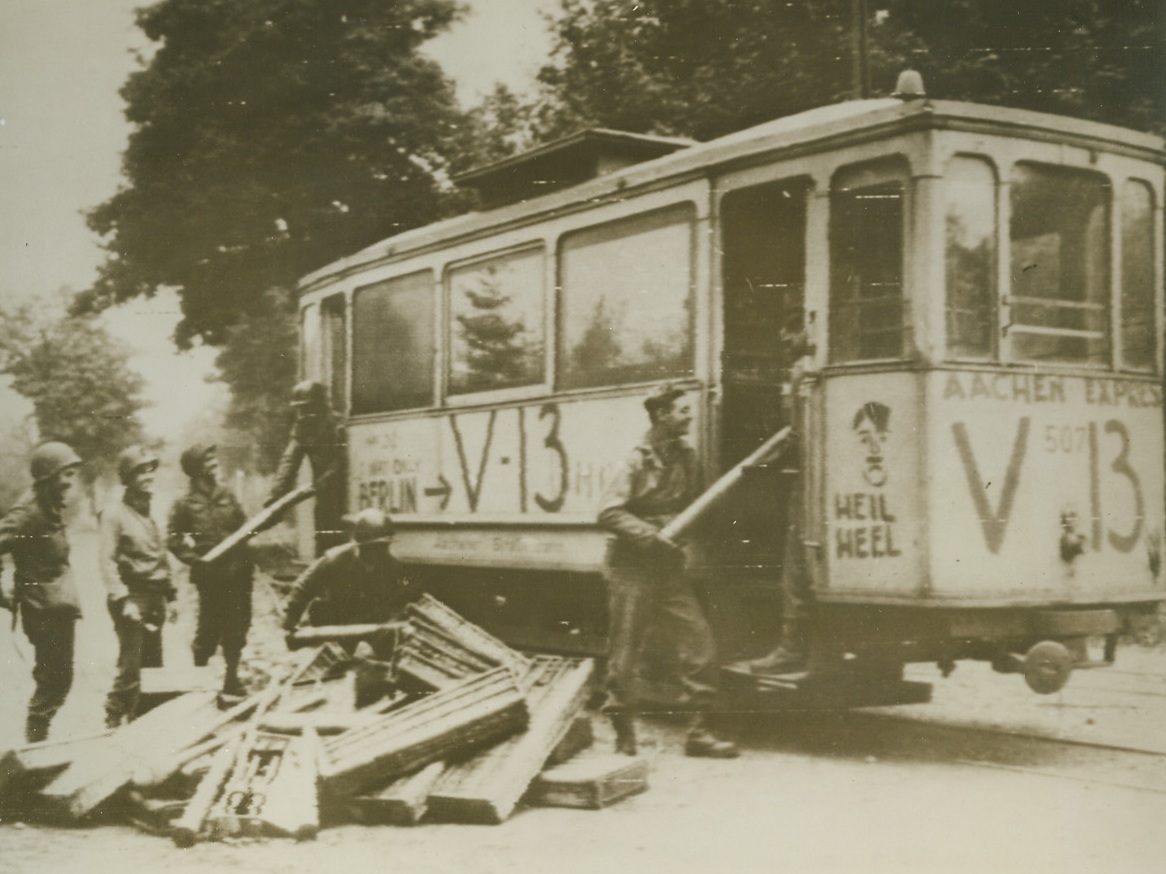
Street Car of Dynamite Headed for Aachen, 10/12/1944. GERMANY – American doughboys load up the V-13, a streetcar, with German ammunition before rolling it downhill where it exploded in the middle of the Nazi garrison at Aachen. this “secret weapon” has been used with notable effect in blasting the Nazis of Aachen from their dugouts. Photo by Acme photographer, Andrew Lopez, for the War Picture Pool.Credit (Acme Photo via Army Radiotelephoto);
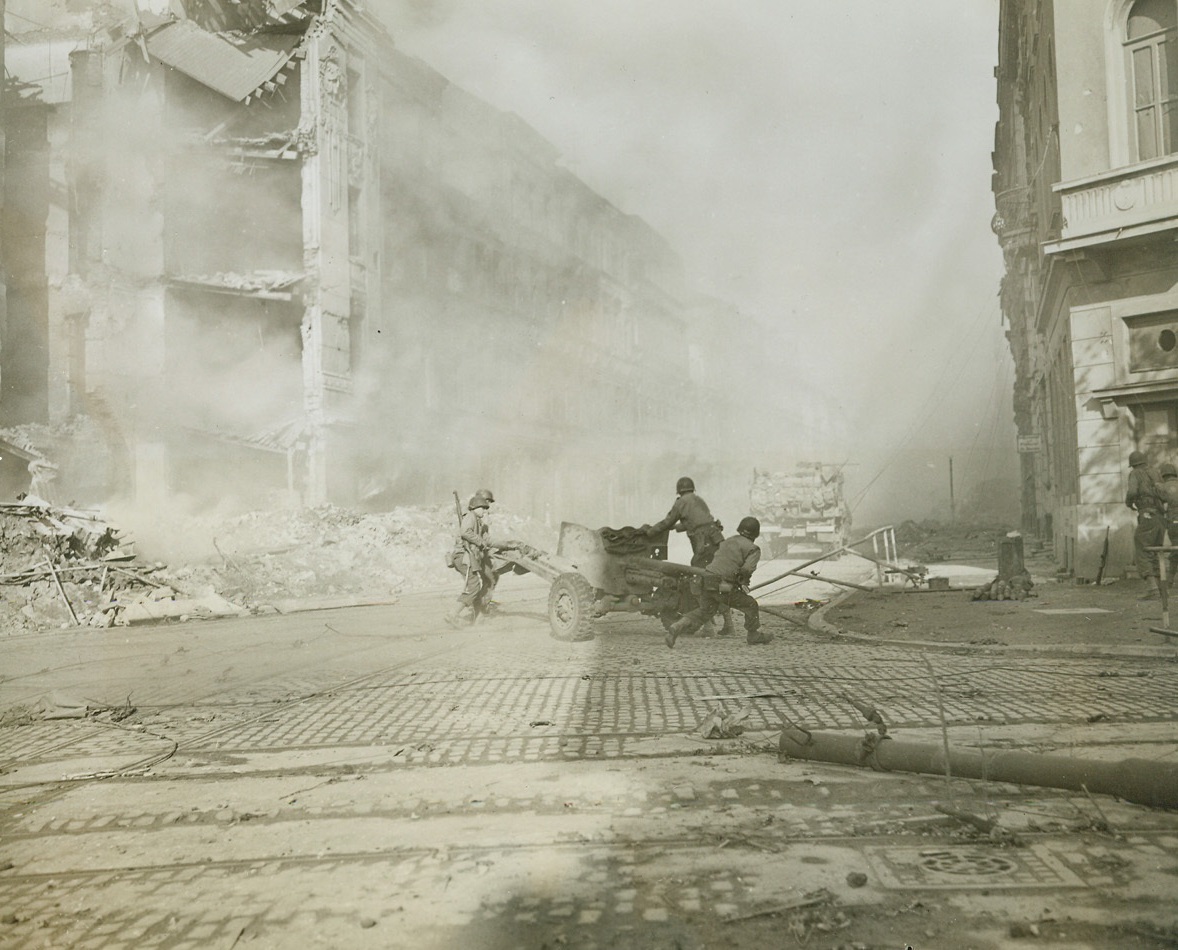
German Key City is Battleground, 10/20/1944. AACHEN, GERMANY -- As the city becomes darkened by a pall of smoke from exploding shell bursts, Yank artillerymen move their gun into position on the corner of Bismarck St. in Aachen, as street-to-street fighting continues in the besieged German city. It was announced today that the American First Army had completed the mop-up of Aachen, leaving Gen. Hodges' Army free to continue its drive eastward over the Cologne plain. Credit (ACME Photo by Bert Brandt, War Pool Correspondent);
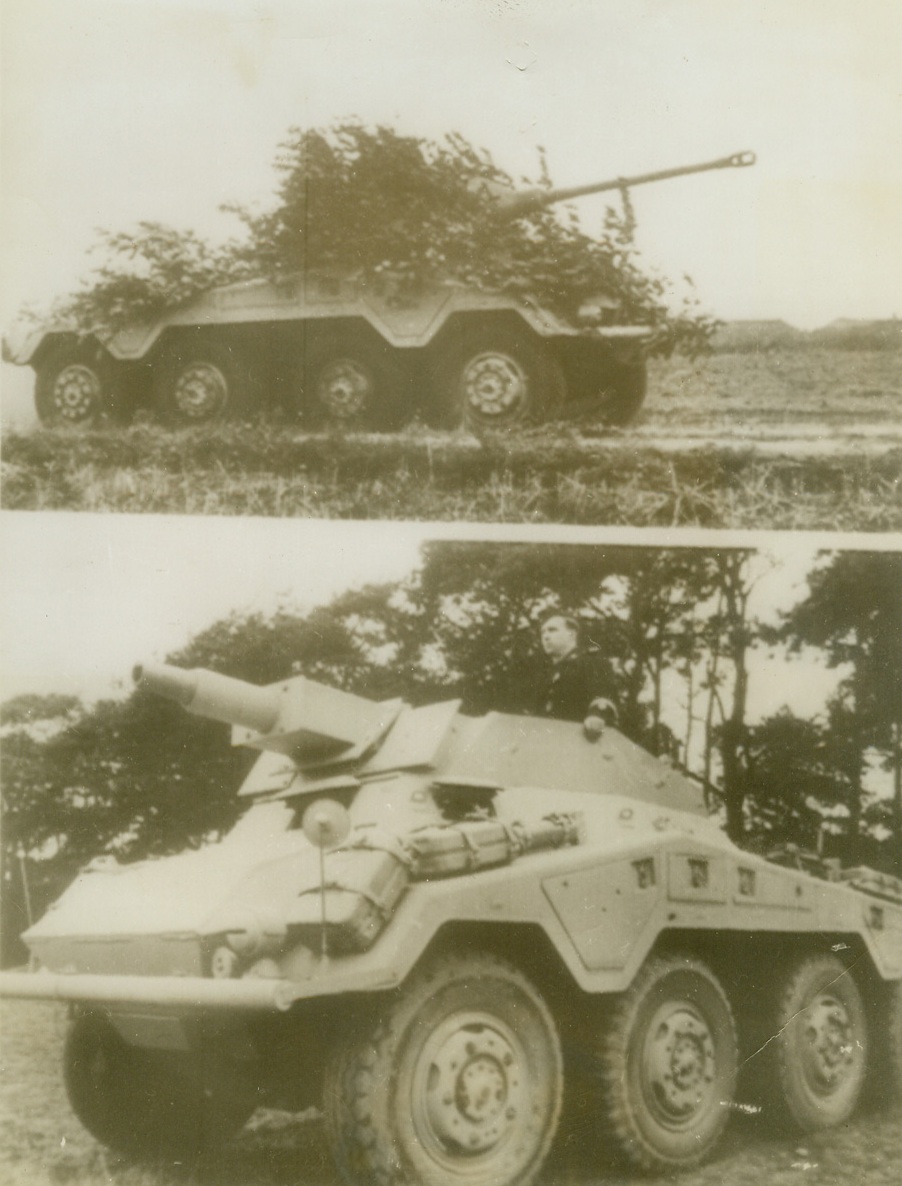
Another “Secret Weapon” for Germany, 10/16/1944. According to the German caption accompanying this photo, radioed from Stockholm today, the picture shows the “Panzer scouting car”, latest German antitank weapon. It is fitted with two different antitank guns. The speed caliber was unrevealed , but the German caption indicated that the German High Command pinned high hopes on the new weapon.Credit (Acme Radiophoto);
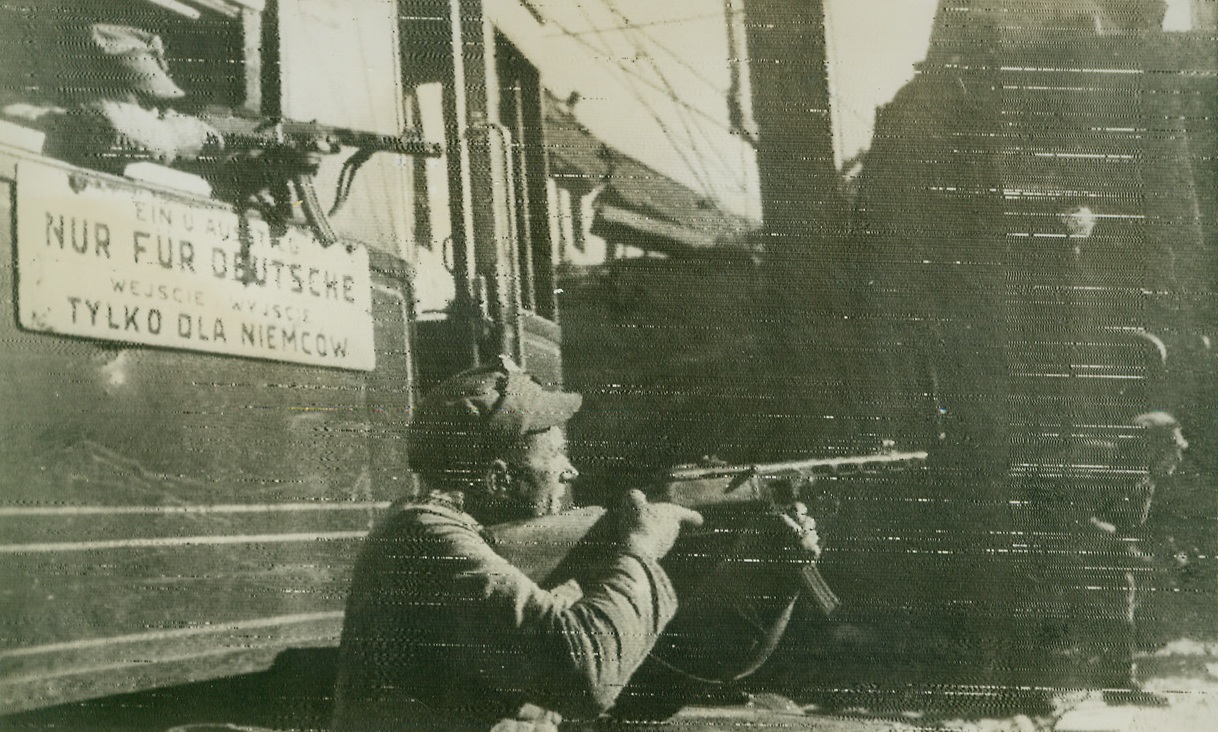
Polish Patriots Blast Nazis in Praga area, 10/1/1944. PRAGA, POLAND – One Polish tommy-gunner takes aim at German soldiers in Praga from the ground, while the other leans out the window of a trolley, which ironically bears a sign saying “For Germans Only.” Meanwhile, in nearby Warsaw, the situation is reported “critical,” and a German communiqué stated that more of the trapped troops were smashed in Warsaw, while others surrendered unconditionally. Praga is a suburb of Warsaw.Credit (Acme Radiophoto);
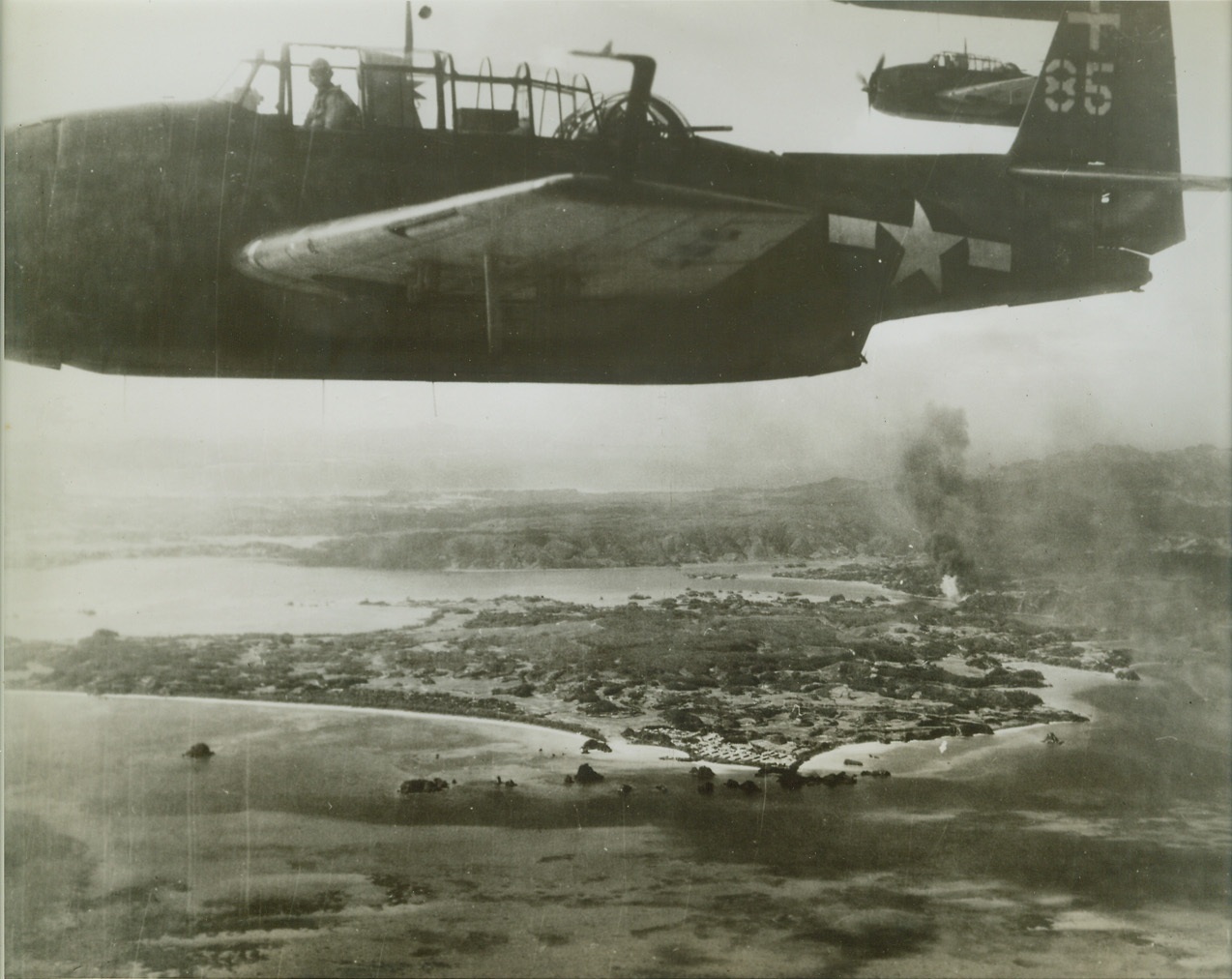
Yank Planes Strike at Ryukyu Islands, 10/18/1944. RYUKYU ISLANDS -- Carrier-based torpedo-bombers from air fleet of Pacific Fleet's great task force range over targets on Okinawa Island in the Ryukyu group which they have bombed and set aflame. U.S. Navy Photo. Credit: (ACME);
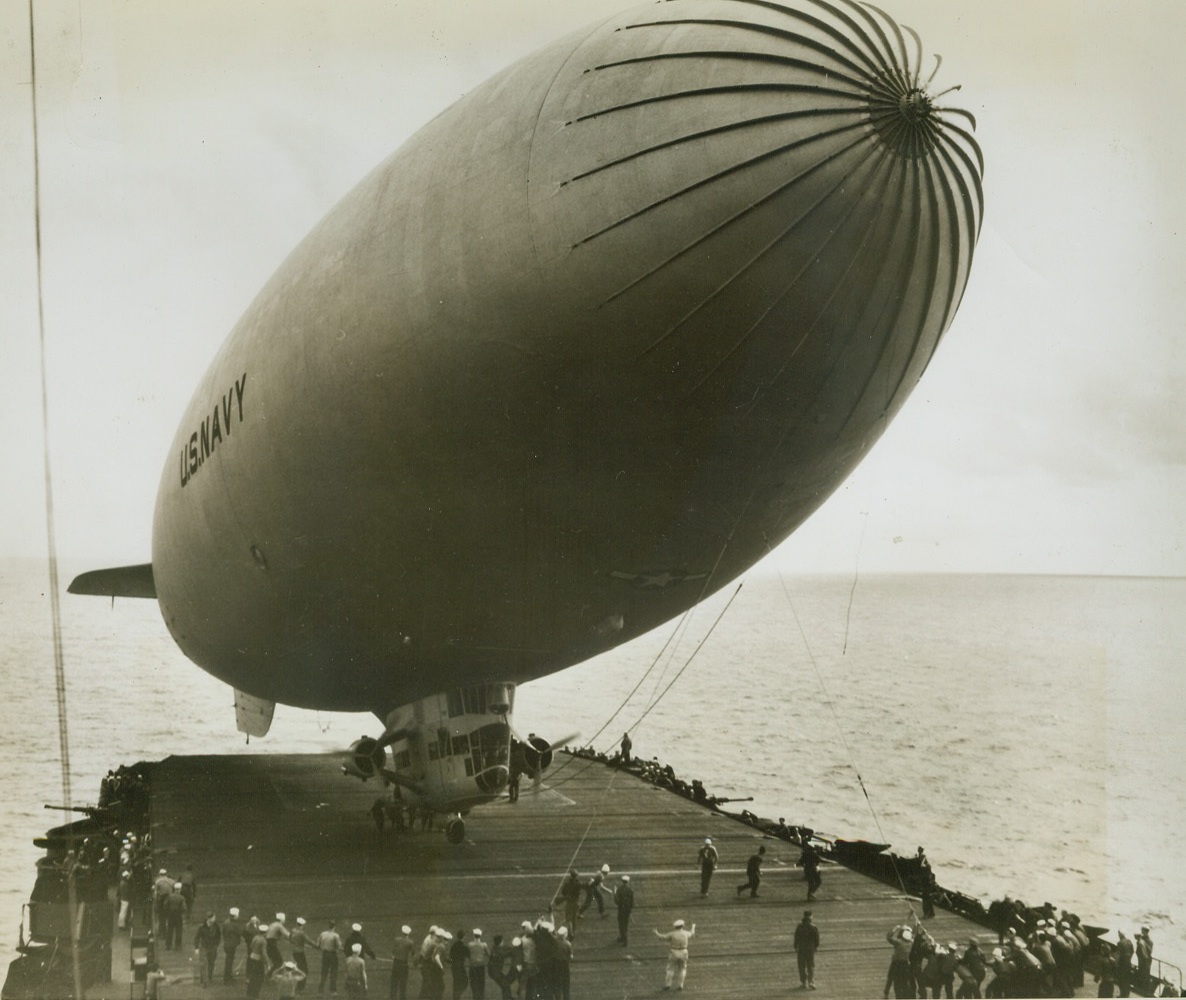
Blimp Makes Carrier Landing, 10/24/1944. Cruising in from a flight, a Navy blimp makes a landing aboard a carrier somewhere at sea. Secured by lines, the blimp nestles toward the deck, its gondola almost touching the broad surface. Credit (U.S. Navy Photo from ACME);
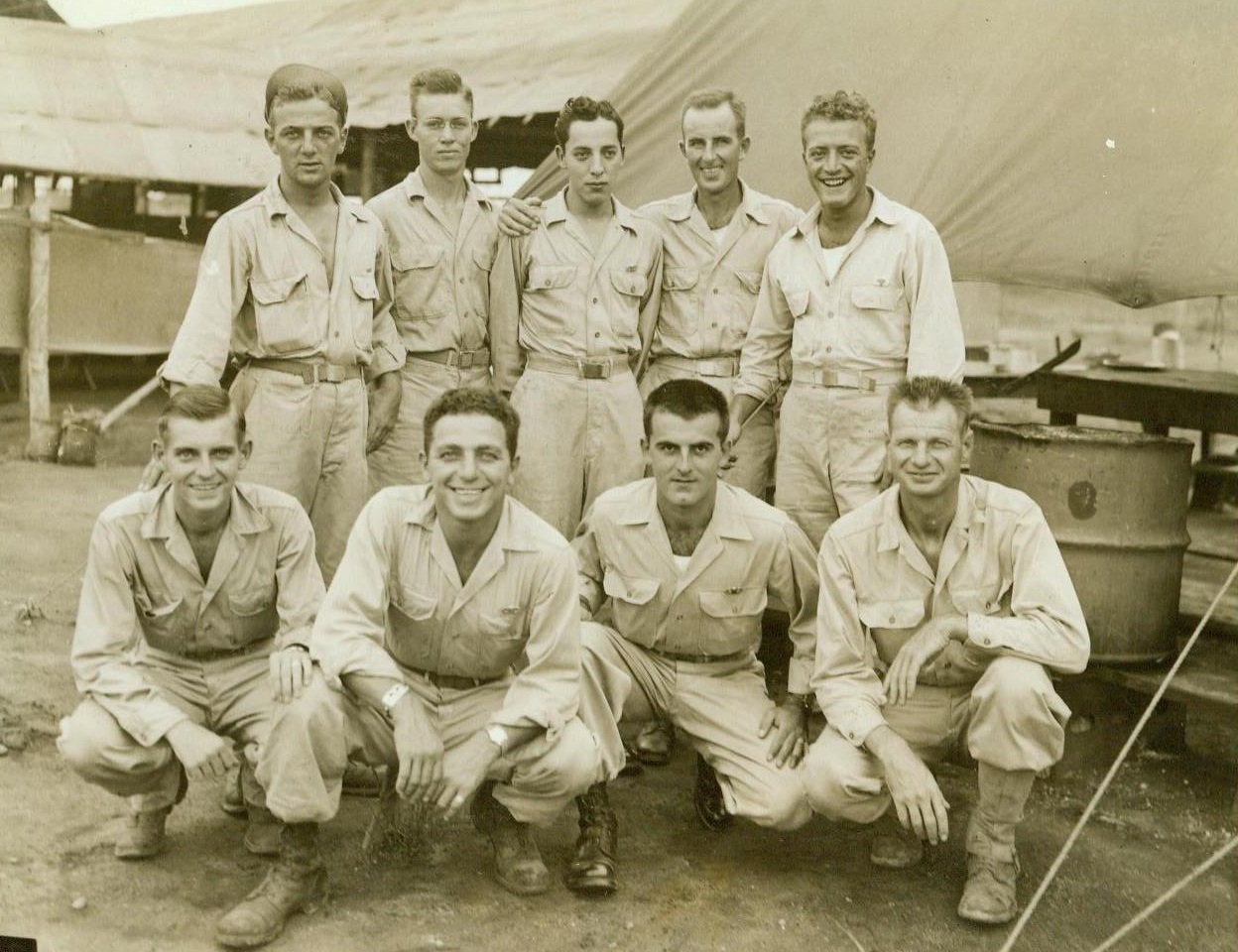
Paratroop Cooks And Waiters, 10/18/1944. South Pacific – Nine Yank paratroopers, who serve as cooks and waiters for an airborne unit, pose for their photo outside the mess tent. Left to right: (Front Row) Pfc. John Gurriell, Paterson, N.J.; Pfc. Joe Baldino, Philadelphia, Pa.; Pvt. Billy J. Rudolph, Paducah, Ky.; Pvt. Harold Richardson, Oakland Calif.; (Back Row) Pvt. Emil Decola, Philadelphia Pa.; Pvt. Weldon Cooper, Roscoe Texas; Pvy. Ernest Apodach, Phoenix, Ariz; Pfc. Maurice Dalton, Pawtucket, R.I.; and Pfc. Michael Simolo, Brooklyn, N.Y. 10/18/44 Credit Line –Wp—(ACME);
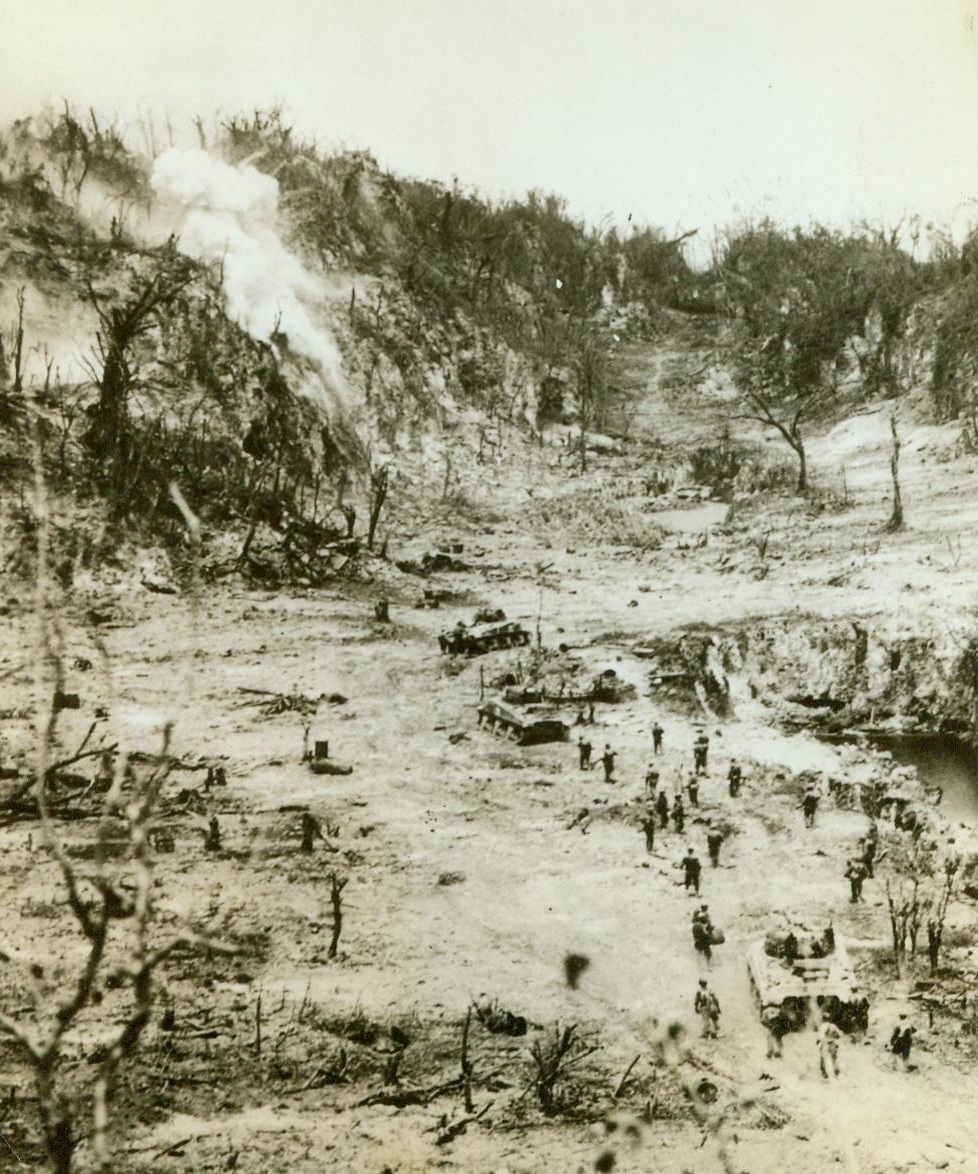
Mop Up On Peleliu, 10/18/1944. Marine Infantrymen, supported by tanks, move up to attack enemy nests in a hillside on Peleliu. The smoke at left marks the blast of a shell fired by one of the tanks. The do-or-die remnants of the Jap forces on the island had to be cleaned out of strong positions in caves and dugouts in the many ridges on Peleliu 10/18/44 Credit (Marine Corps Photo From ACME);
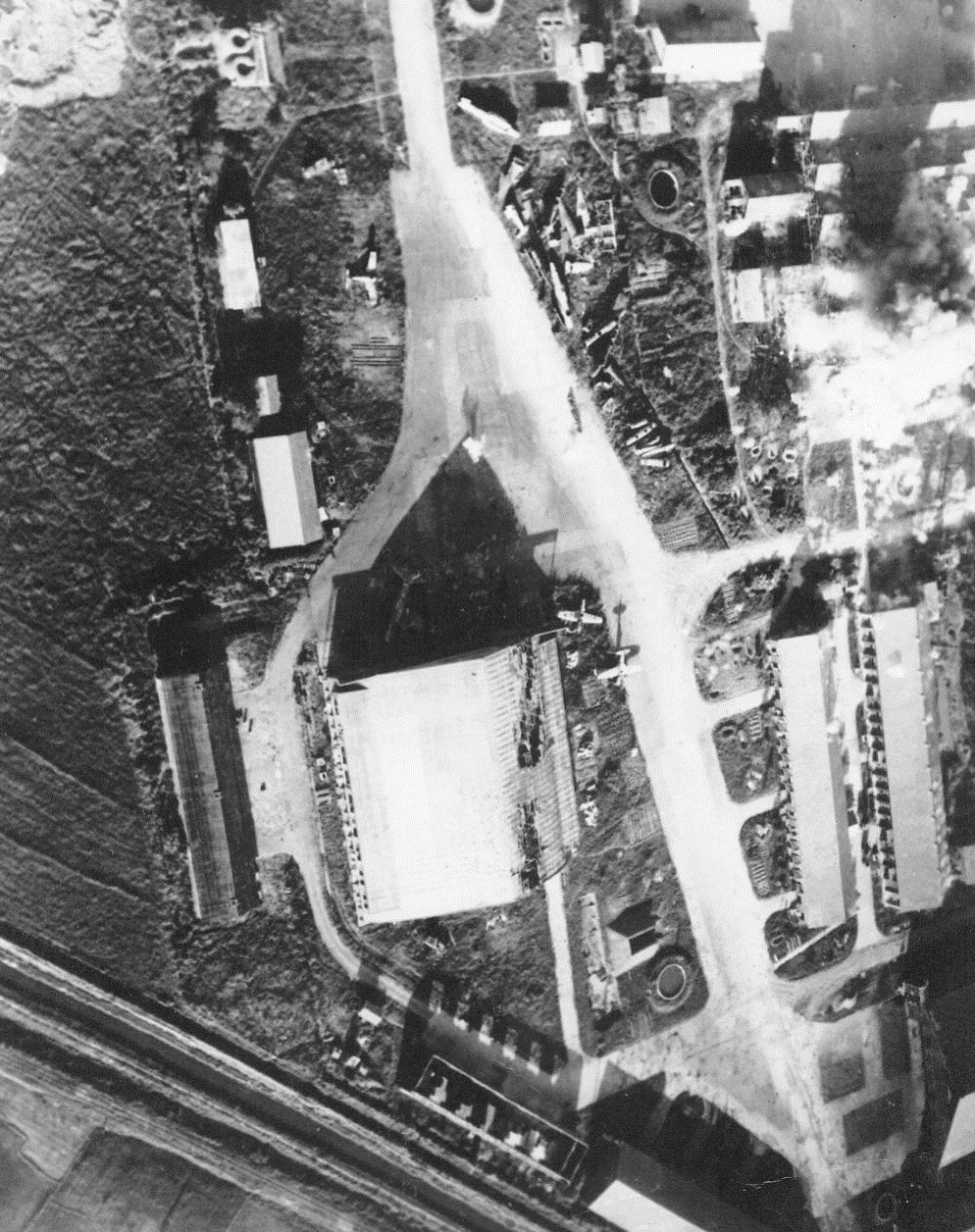
Fromosa Struck By U.S. Fleet, 10/18/1944. Formosa – Japanese planes with the rising sun on their wings are caught on the ground at Kagi, Formosa, by warplanes of the U.S. Pacific Fleet’s fast carrier task force. Large hangar shows effects of attacks. Industrial sheds in upper left billow clouds of smoke as bombs explode from warcraft just pulling out of its dive. More than 97 Jap aircraft were destroyed on the ground during this day of raids on Formosa 10/18/44 Credit Line (ACME);
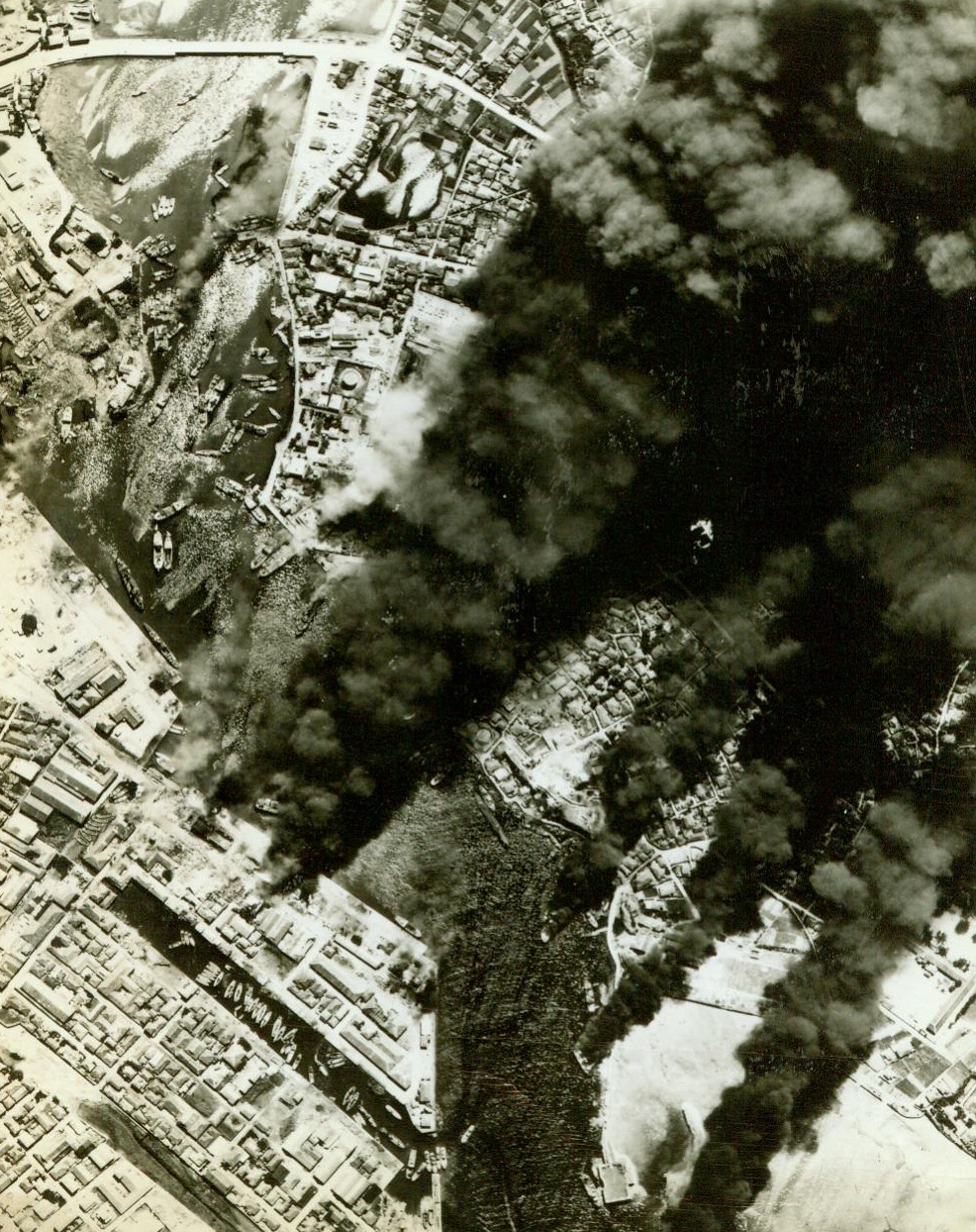
Ryukyu Industrial City Blasted, 10/18/1944. Naha City, Ryukyu Islands – Planes from Admiral Nimitz’s Pacific Fleet Strike devastating blows at Jap base in the industrial area of Naha City on Okinawa Island in the Ryukyu chain south of Japan. Burning warehouses and ships prove accuracy of Navy bombers;
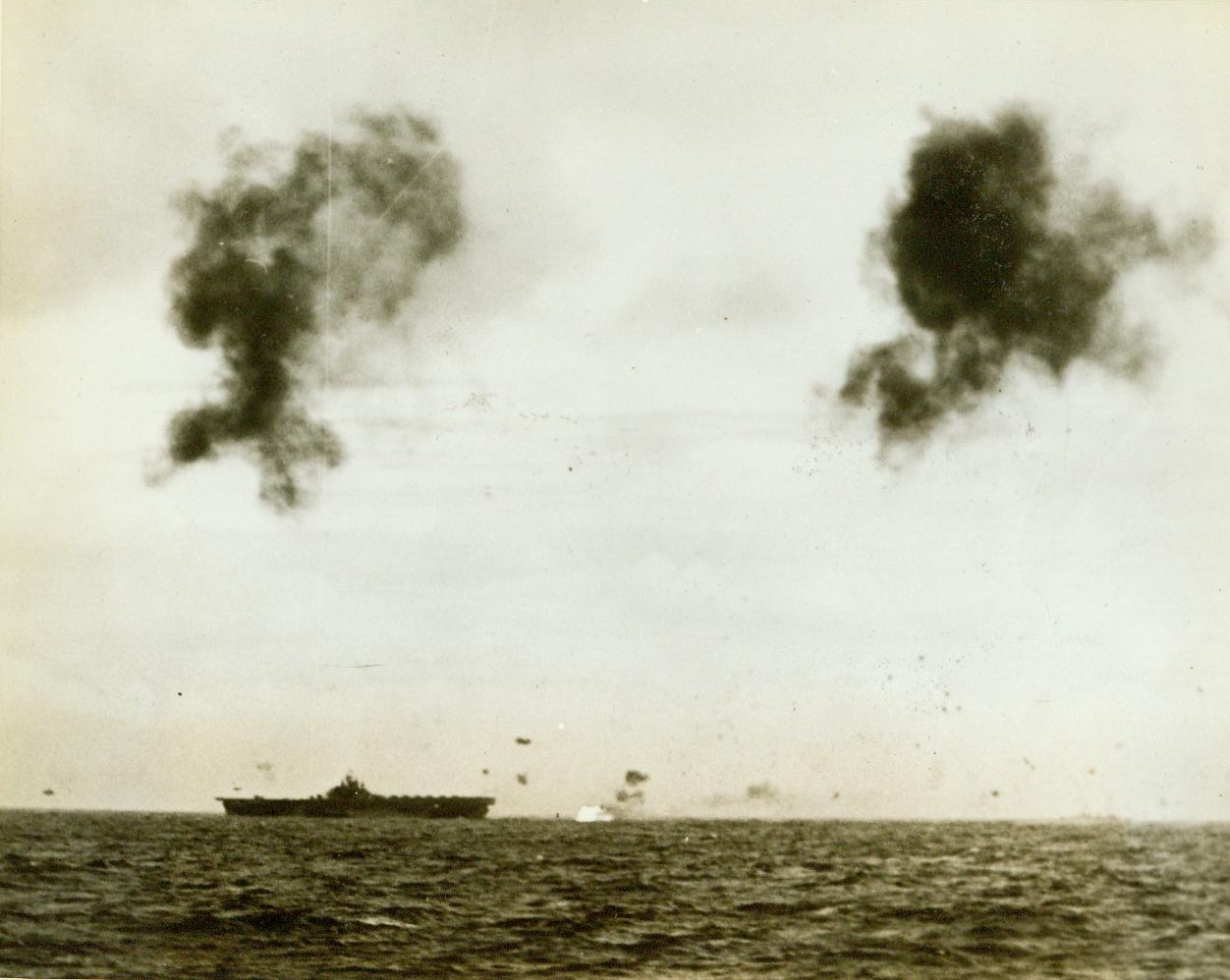
U.S. Carriers Throw Off Jap Attackers, 10/18/1944. Formosa – In a cloud of spray and flame, an enemy plane disappears just aft of an Essex class carrier. Another flier of the rising sun swoops over the carriers bow as anti-aircraft bursts pepper the sky. This is one of the first pictures of the fierce sea engagement off Formosa 10/18/44 Credit line (ACME);
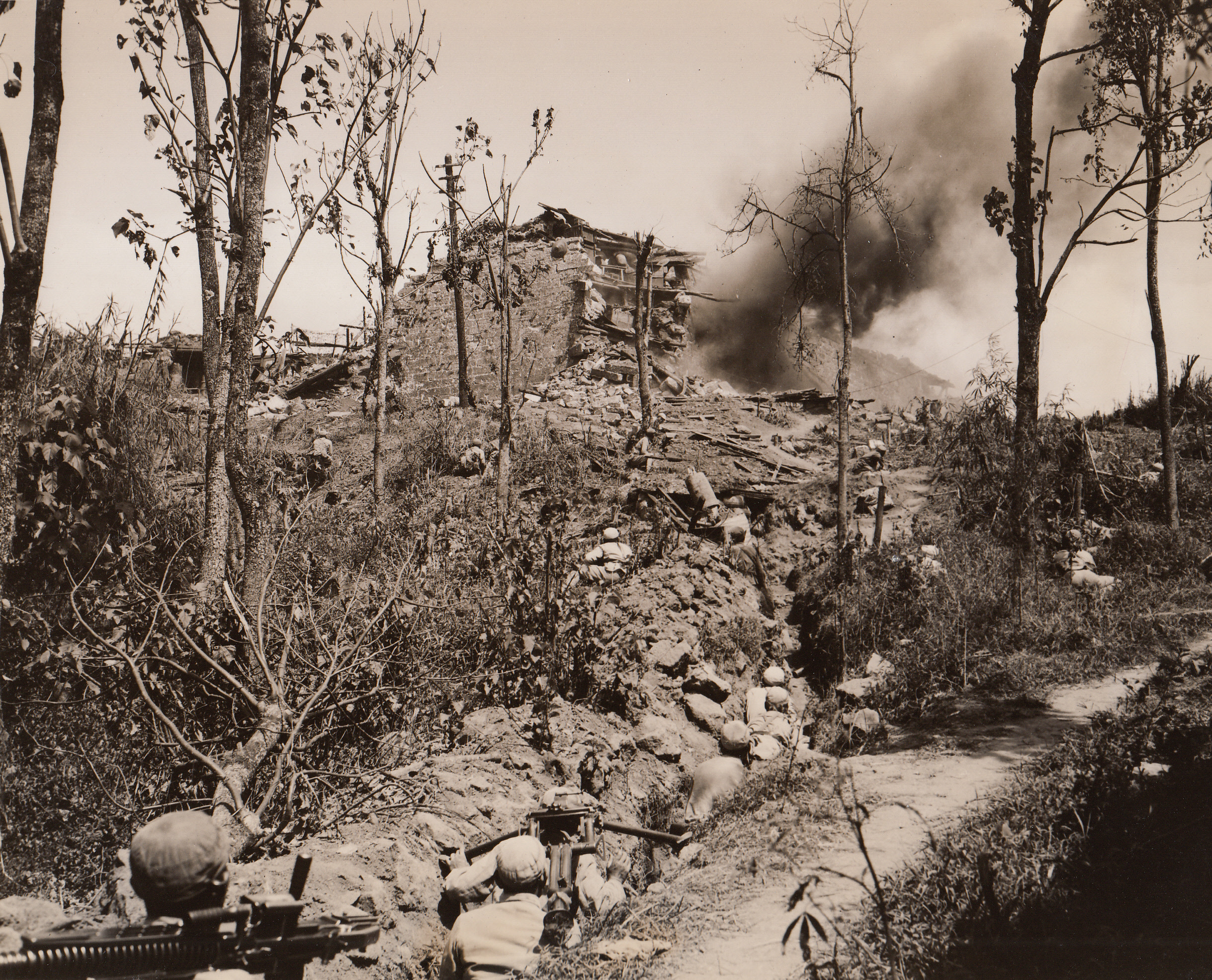
Tengchung Captured from Japs – (#3), 10/4/1944. China – The first city east of Burma to be liberated by the Allies, the ancient jade center of Tengchung has been captured from the Japs after five bloody weeks of fighting. Here, (foreground), Chinese troops wait to move up on the city’s wall, as engineers blast holes through the 20-foot-thick barricade (background). The smoke is from exploding charges.;
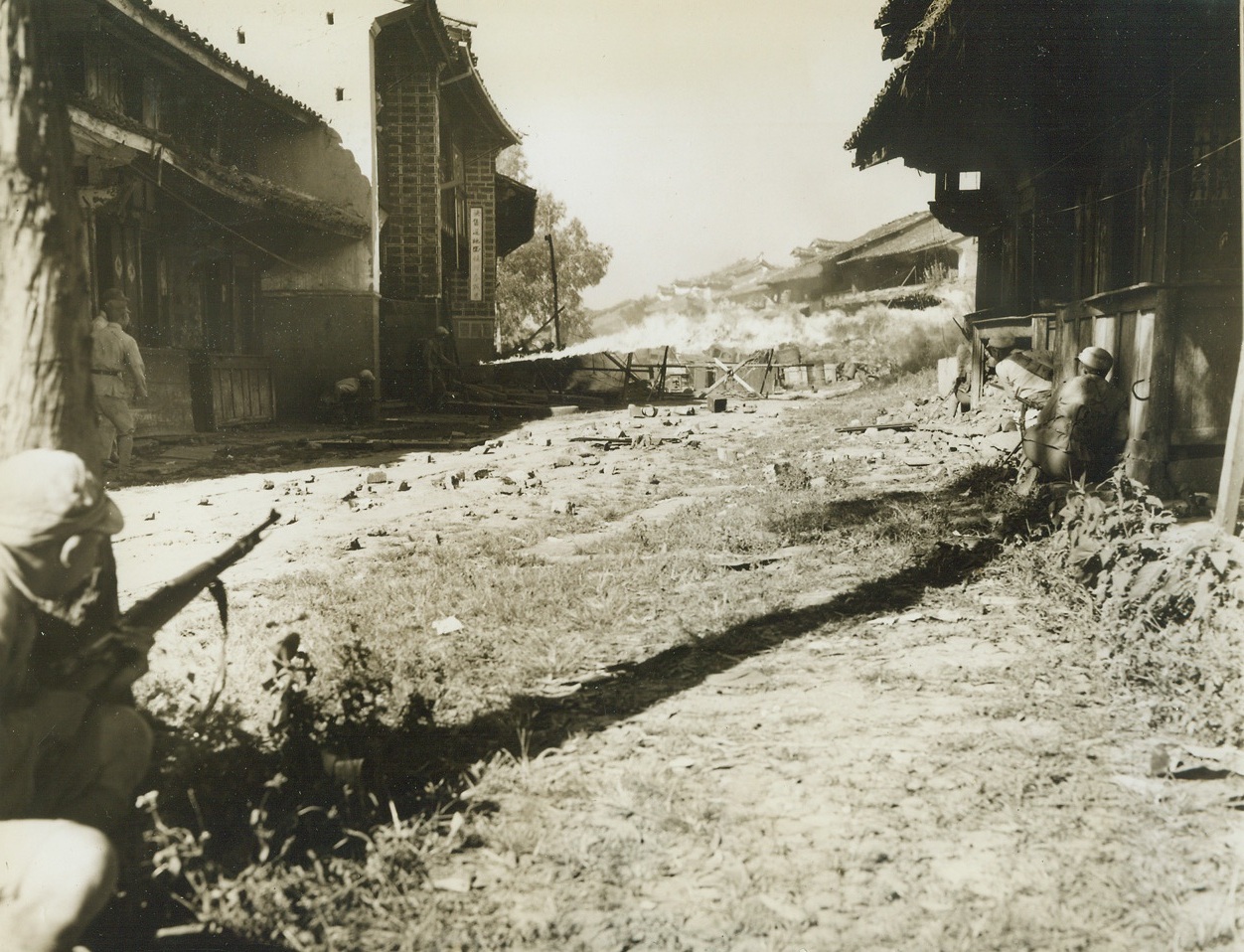
The Bloody Siege of Tengchung, 10/4/1944. Tengchung, China – Inching across the rugged, rain-soaked terrain of the Kaoli Mountains to face a heavily fortified Jap force at Tengchung, American-trained Chinese troops captured the ancient jade center after a bloody, five-week battle. The first Chinese city on the Eastern side of Burma to be liberated by the Allies, Tengchung was a battle-seared, rubble-strewn prize when the Chinese moved in. Approximately 2000 Japs, who were entrenched for a six-month siege, were killed or captured in the battle, which proved the Chinese Army’s ability to use modern weapons and tactics. The U.S. 10th and 14th Air Forces supported China’s fighters in the fight for the principal enemy obstacle to the junction of the Ledo and Burma roads. A Chinese flamethrower sends a searing stream of destruction toward a Jap pillbox in the fight for Tengchung. Photo by Frank Cancellare, ACME photographer for the War Picture Pool. Credit: ACME;
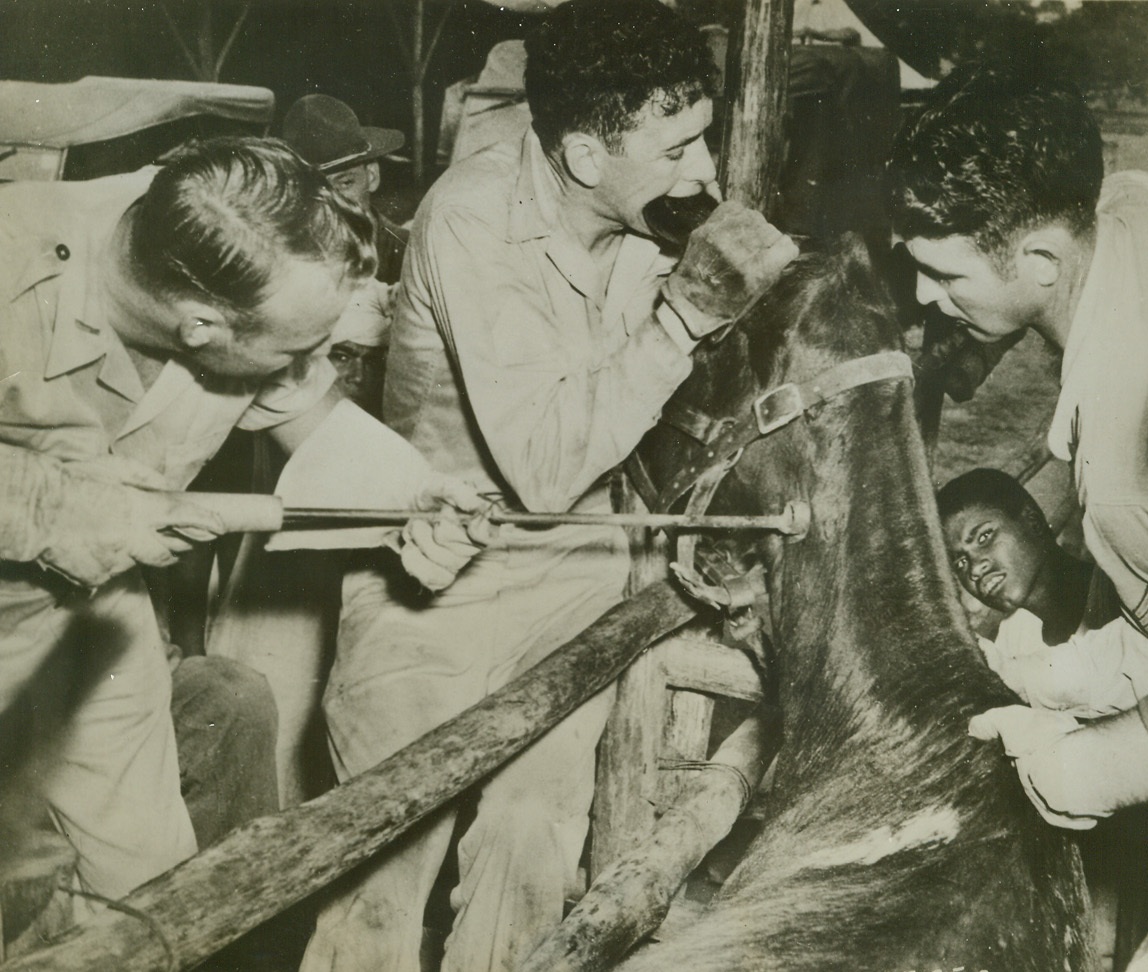
Man Bites Mule, 10/23/1944. Ramgarh, India – Although it’s only a slight variation on the popular prescription for “news”, it isn’t news when man bites mule, unless you aren’t acquainted with the ways of muleskinners, Sgt. Fred Parker of Ozona, Tex., bites the ear of a mule to take the animal’s mind off branding operations. Lt. Carl W. Shultz, Independence, MO, of the Army veterinary Corps, wields the branding iron and Sgt. R. Sterling (right), Crawford, Neb., assists. The mule is one of a group of new arrivals at Ramgarh in the C.B.I.Credit line (Signal Corps photo from ACME);
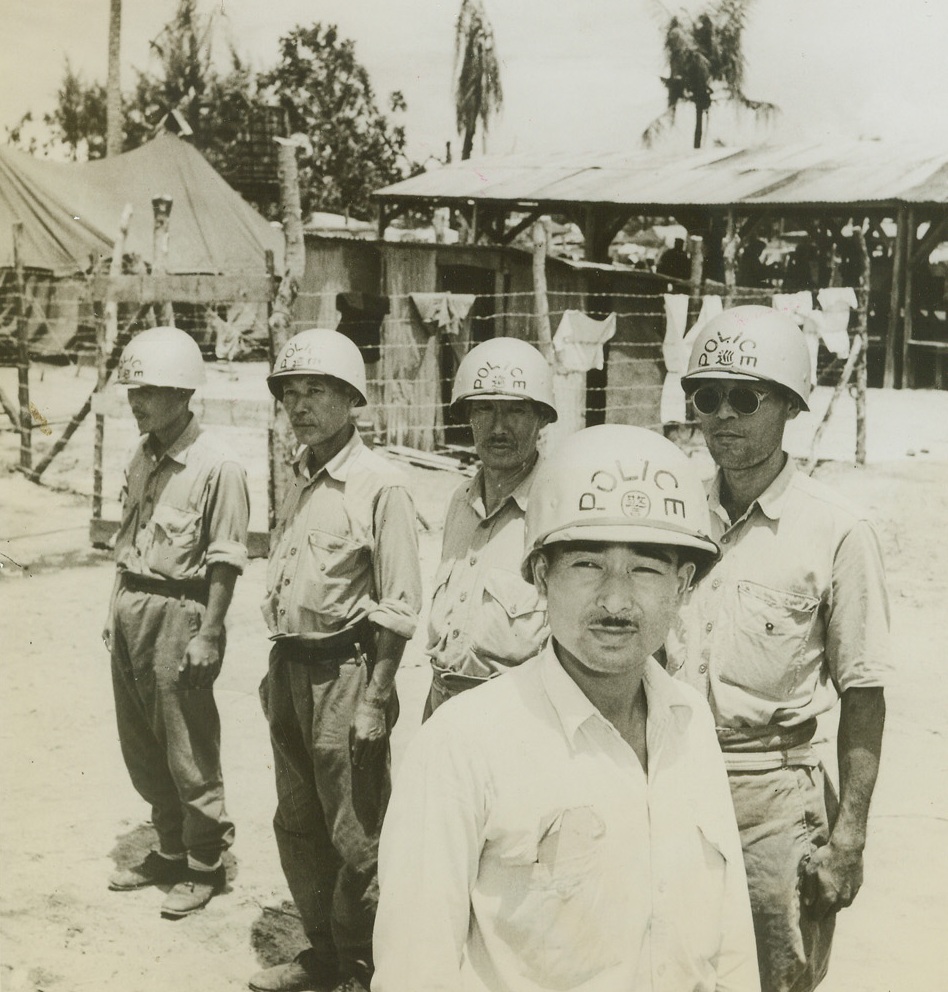
Civilian Life on Saipan, 10/27/1944. Saipan, Marinas – To Hirasawa, former civic official of Aslito, (foreground) goes the job of chief of Japanese Internal Police on Saipan. He chose his own men, who are very proud of their new helmets, denoting their authority. Here they stand in front of the “hans”, or huts in the civilian camp. The shelters were made of tin sheeting from the bombed sugar refinery and weathered planks. Each one houses from 20 to 55 people.Credit line (ACME) (WP);
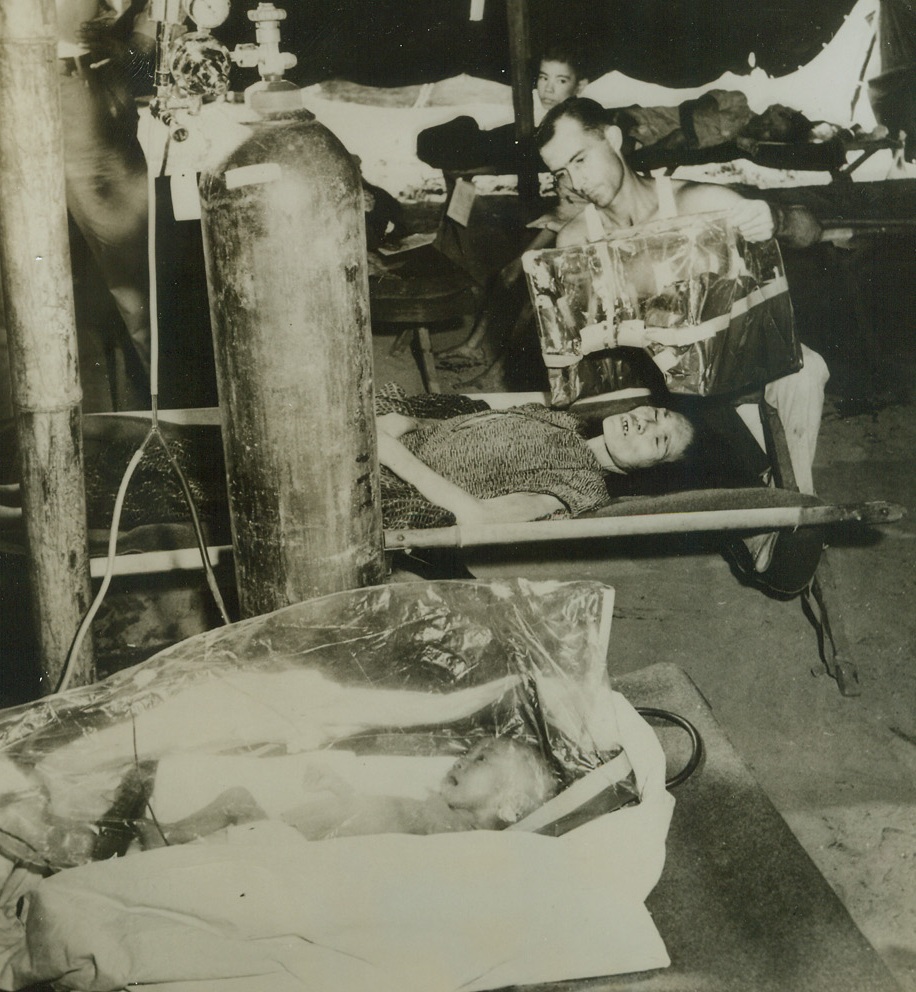
Civilian Life on Saipan, 10/27/1944. Saipan, Marianas, -- As US forces of occupation took charge on Saipan, there began a slow trek from the caves and other hiding places of Japanese and native civilians, half-starved and inflicted with all sorts of diseases, including diarrhea, worms, beriberi. Under American care, they are slowly regaining their strength and malnutrition is being combated by vitamin B1 injections. Here, a thin, sickly baby struggles for life in an oxygen tent made of cellophane, while a doctor places another makeshift tent over a woman, whose body is wasted by starvation.Credit (ACME) (WP);
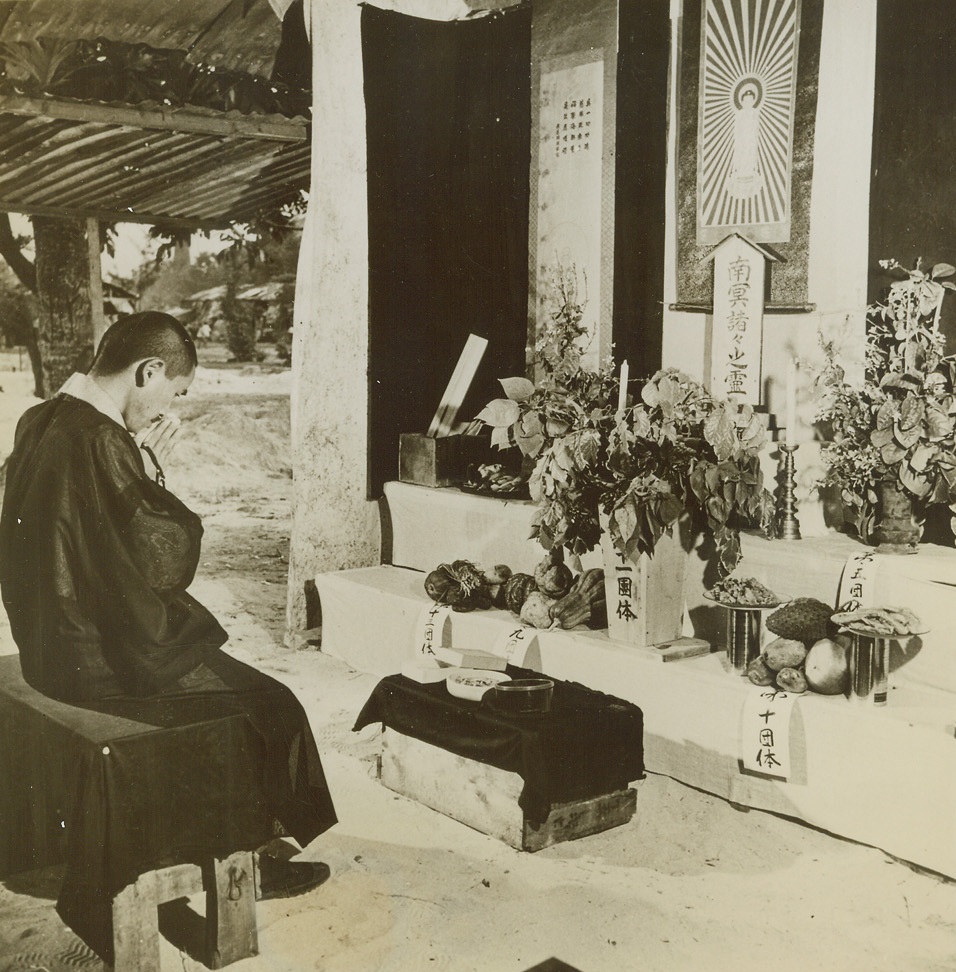
Civilian Life on Saipan, 10/27/1944. Saipan, Marianas – One of the things which Japanese civilians, Kanakas, Koreans, and Chamorro natives of Saipan enjoy under American occupation is freedom of worship. Here Hideki, the Buddhist Priest, prays before an altar decorated with flowers and food. “Shintoism,”or emperor worship, has proved a problem in religious freedom – US authorities have made no attempt to stop it, but have set up no facilities to encourage it.;
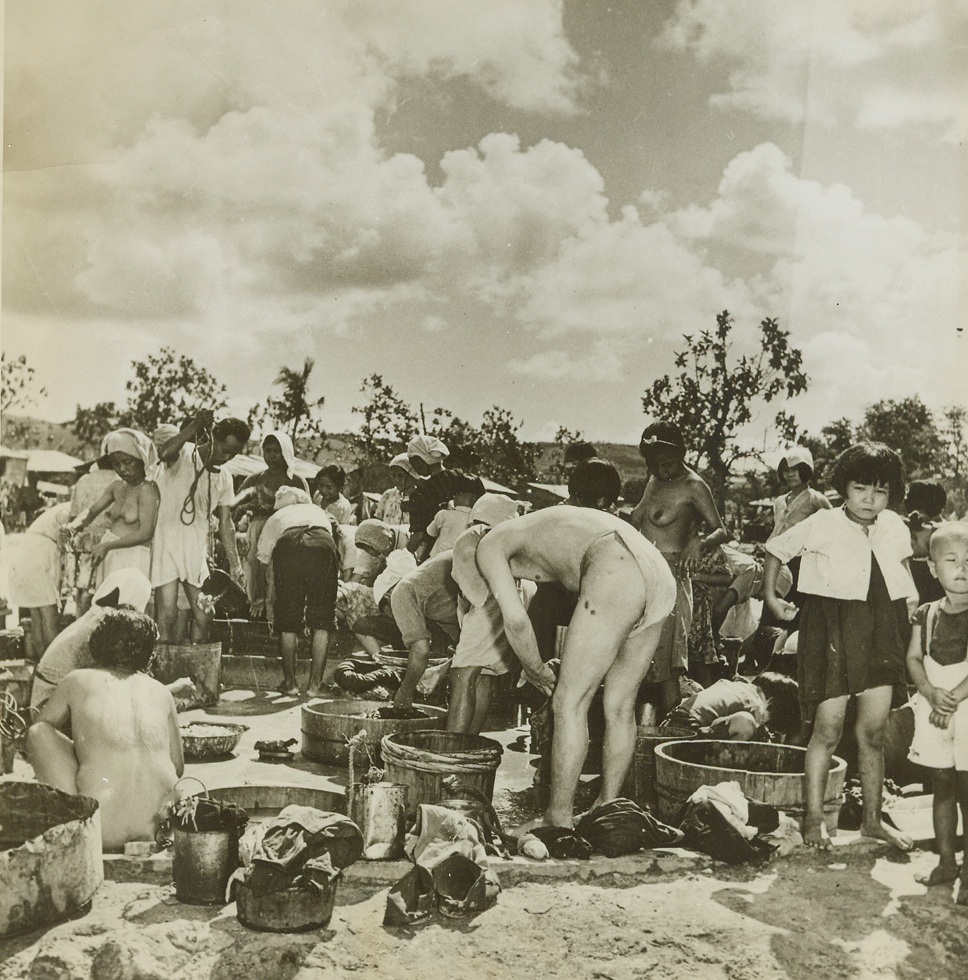
Civilian Life on Saipan, 10/27/1944. Saipan, Marianas -- taught the value of cleanliness by US forces of occupation, Japanese civilians, Koreans, Kanakas, and Chamorro natives of Saipan bathe themselves at the community bath, using water handed to them by the bucketful. Under Jap rule, these people lived under conditions of filth and starvation, and are just beginning to learn habits of health and sanitation, taught them by the American soldiers.Credit (ACME) (WP);
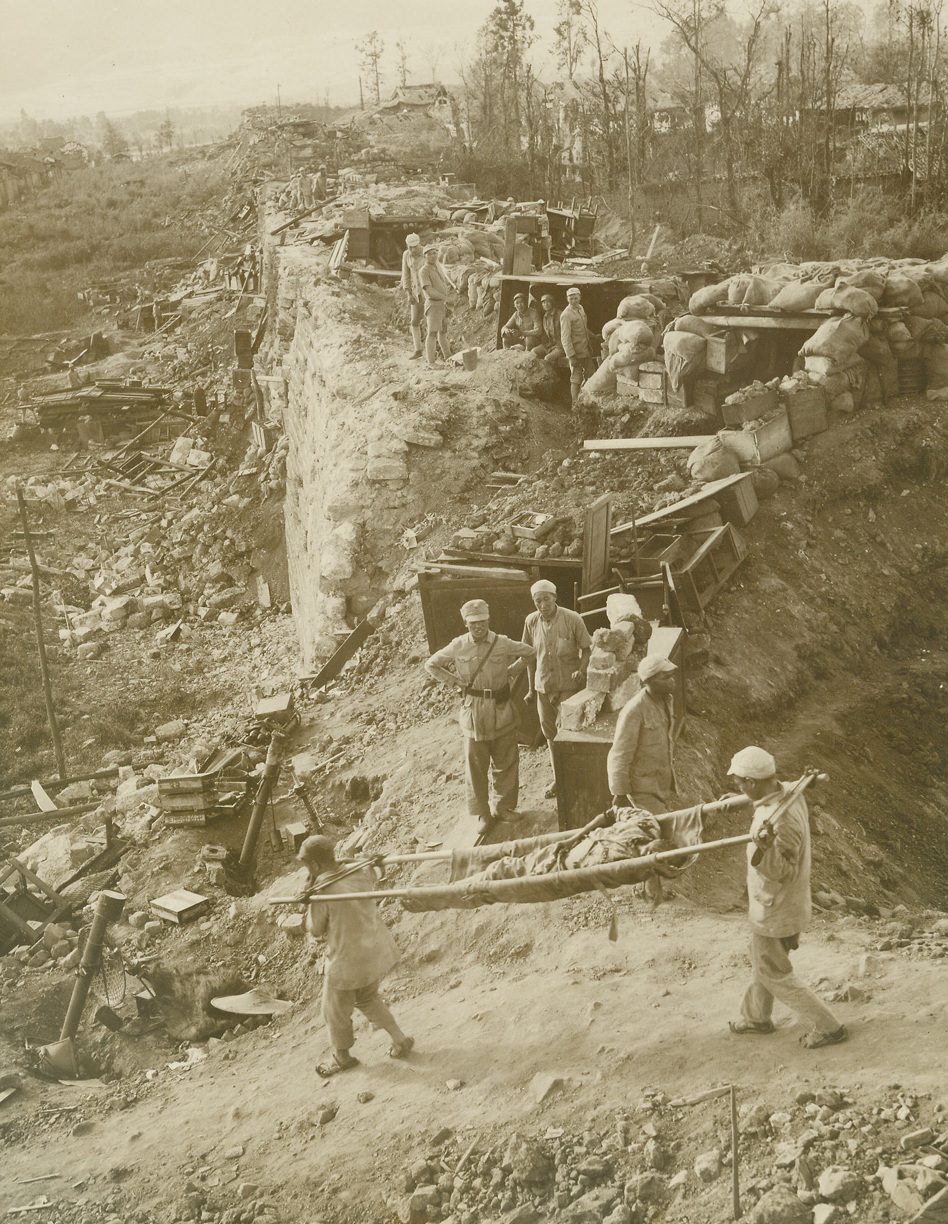
The Bloody Siege of Tengchung, 10/4/1944. Tengchung, China – Inching across the rugged, rain-soaked terrain of the Kaoli mountains to face a heavily-fortified Jap force at Tengchung, American-trained Chinese tropps captured the ancient Jade center after a bloody, five-week battle. The first Chinese city was the Eastern side of Burma to be liberated by the allies, Tengchung was a battle-seared, bubble-strewn prize then the Chinese moved in. Approximately 2000 Japs, who were entrenched for a six-month siege, were killed or captured in the battle, which proved the Chinese Army’s ability to use modern weapons and tactics. The U.S. 10th and 14th Air Forces supported China’s fighters in the siege of the principal enemy obstacle to the junction of the Ledo and Burma roads.New York BureauWounded Chinese are carried past an allied position on the city’s massive stone walls. The wall was already captured, but fighting raged within Tengchung when this photo was made by Frank Cancellare, ACME photographer for the War Picture Pool.Credit Line--WP--(ACME);
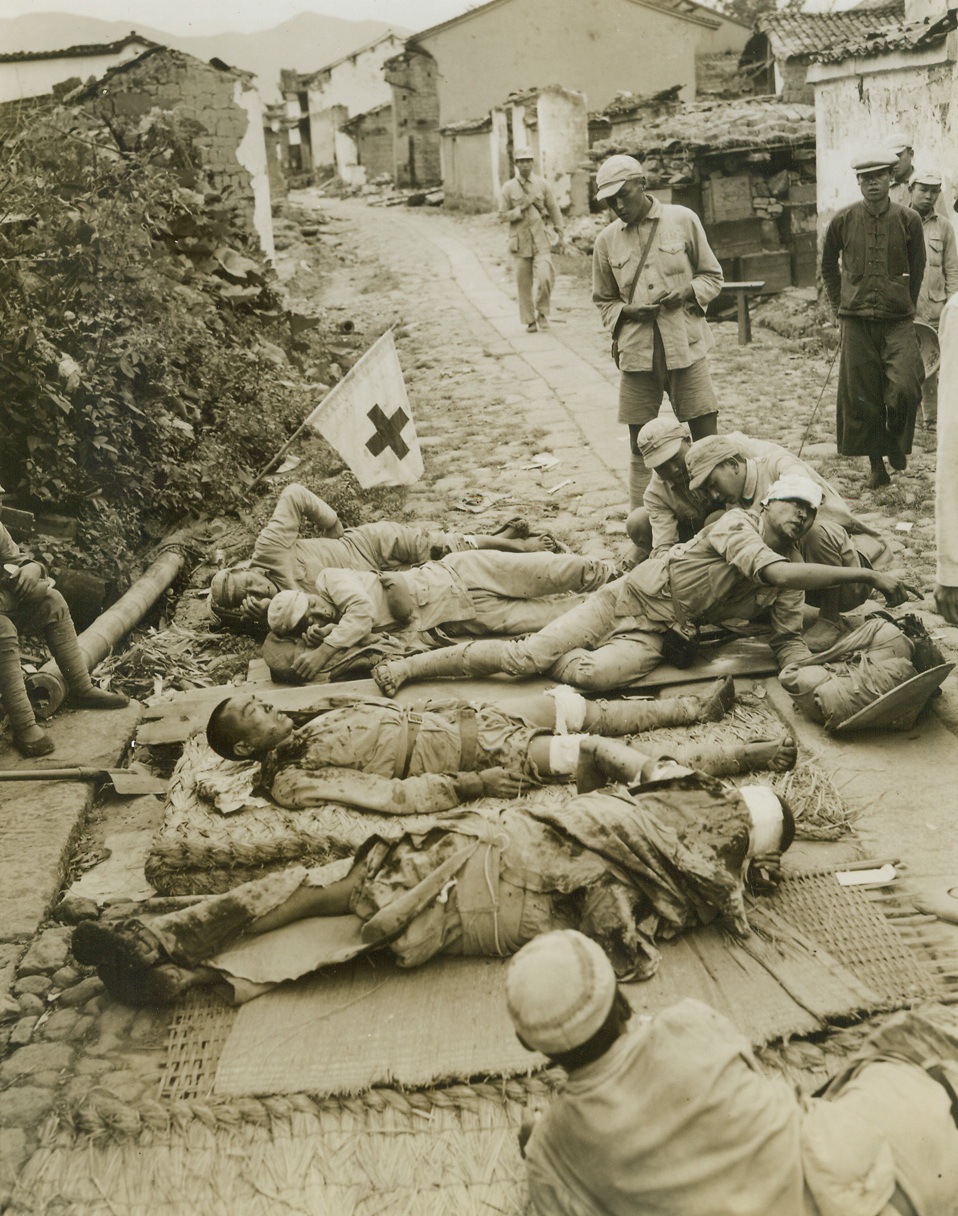
The Bloody Siege Of Tengchung, 10/4/1944. Badly wounded Chinese troops are treated at a makeshift first aid station in Tengchung. The American-trained force suffered heavy casualities in the desperately slow battle. Credit Line –WP--(ACME);
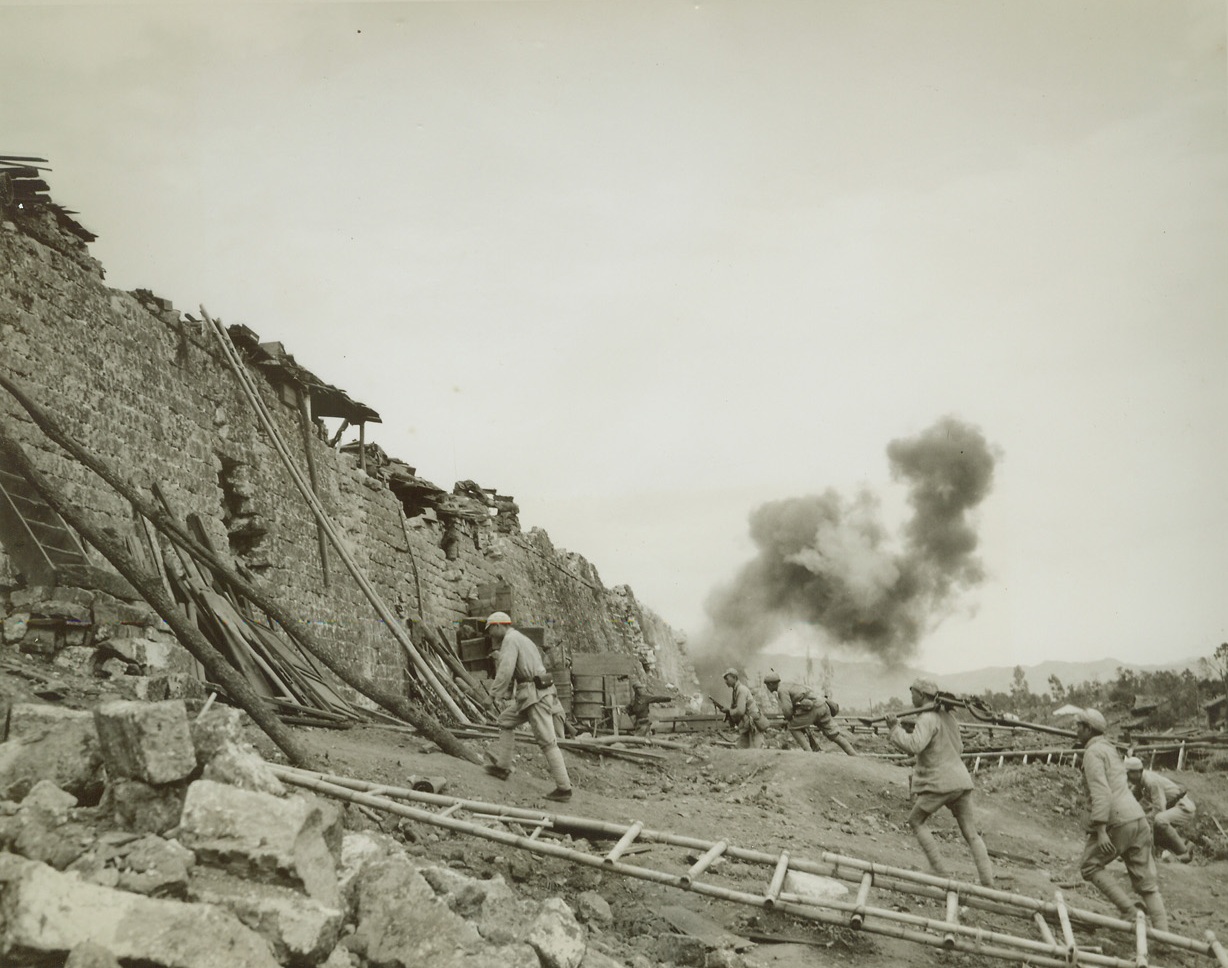
Tengchung Captured from Japs, 10/4/1944.
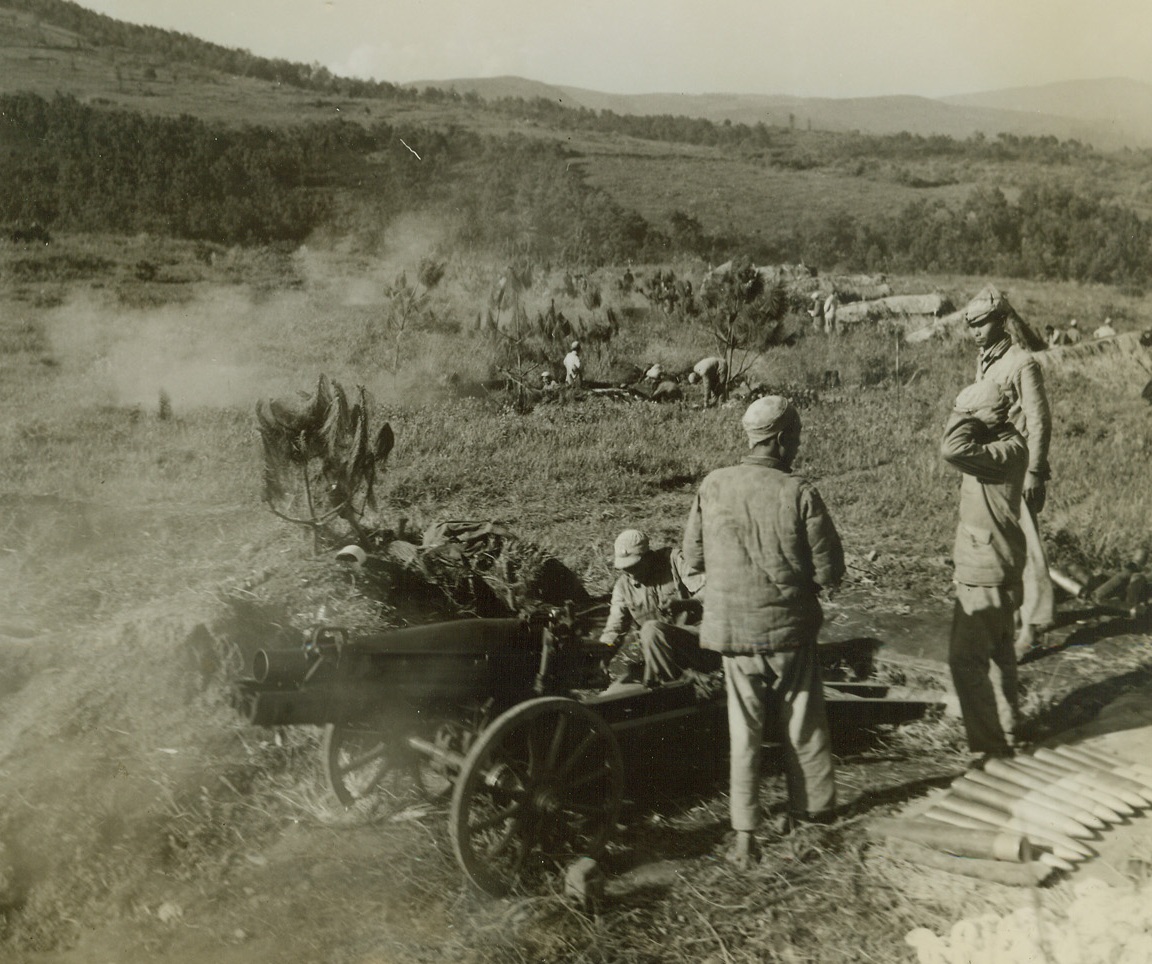
Tengchung Captured from Japs, 10/4/1944. China – The first city East of Burma to be liberated by the Allies, the ancient Jade center of Tengchung has been captured from the Japs after five bloody weeks of fighting. Here, during the early part of the fighting, 77mm, howitzers made in the U.S. throw shells into Jap positions in the city from atop the surrounding mountains.Credit Line (ACME photo by Frank Cancellare for War Picture Pool);
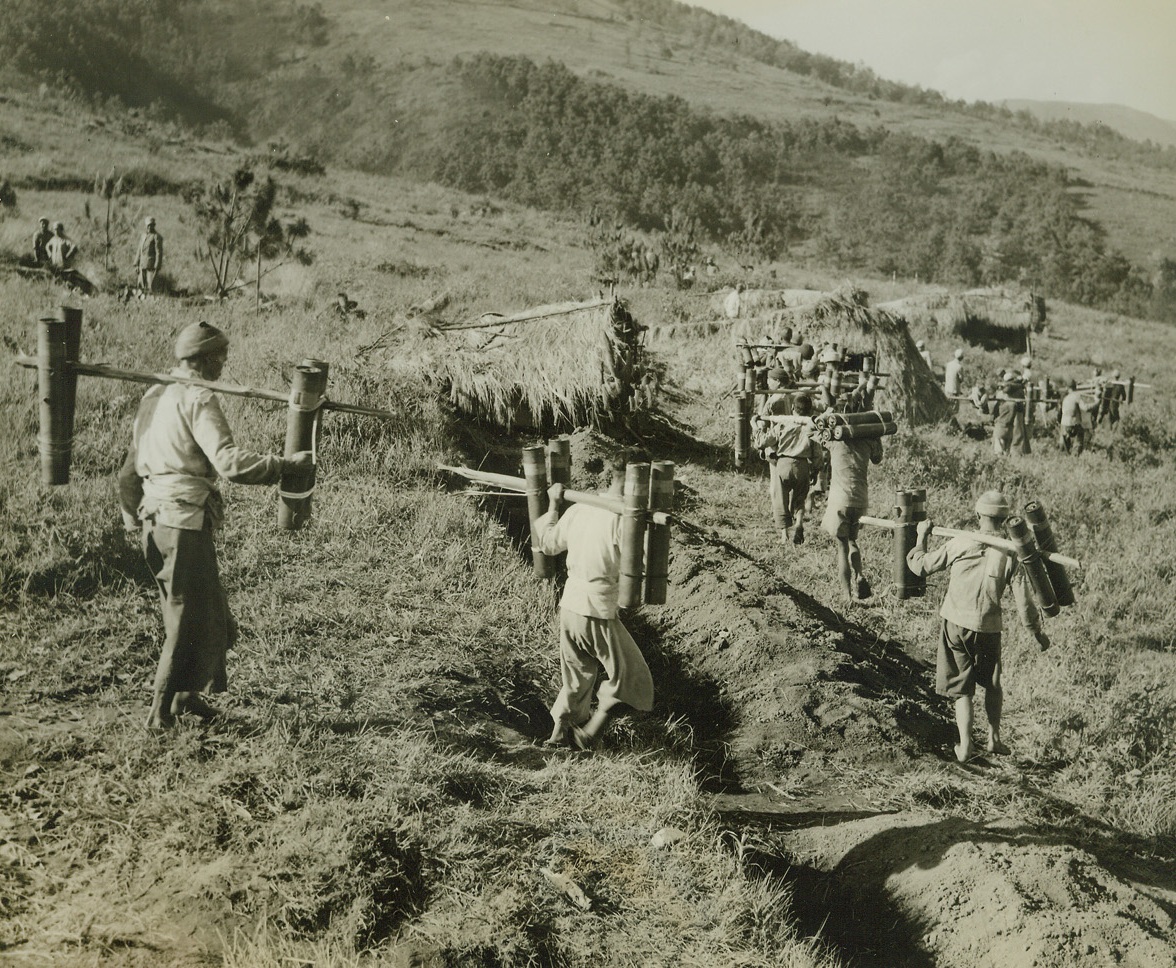
Tengchung Captured from Japs, 10/4/1944.China - - The first city East of Burma to be liberated by the Allies, the ancient Jade center of Tengchung has been captured from the Japs after five bloody weeks of fighting. Here, Chinese coolies carry 75mm. Ammunition to Chinese and American guns, emplaced atop the mountains, during the early stages of the fighting.Credit Line (ACME photo by Frank Cancellare for War Picture Pool);
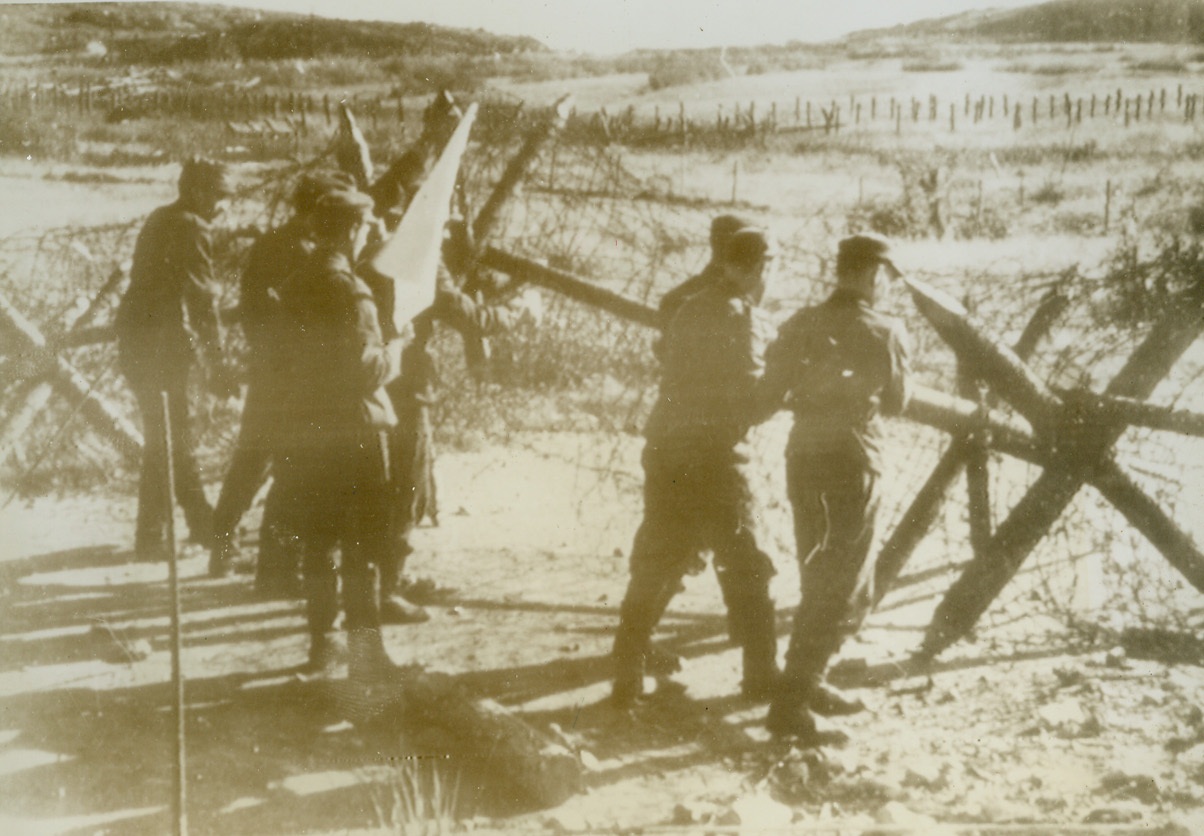
Barriers Come Down, 10/4/1944.
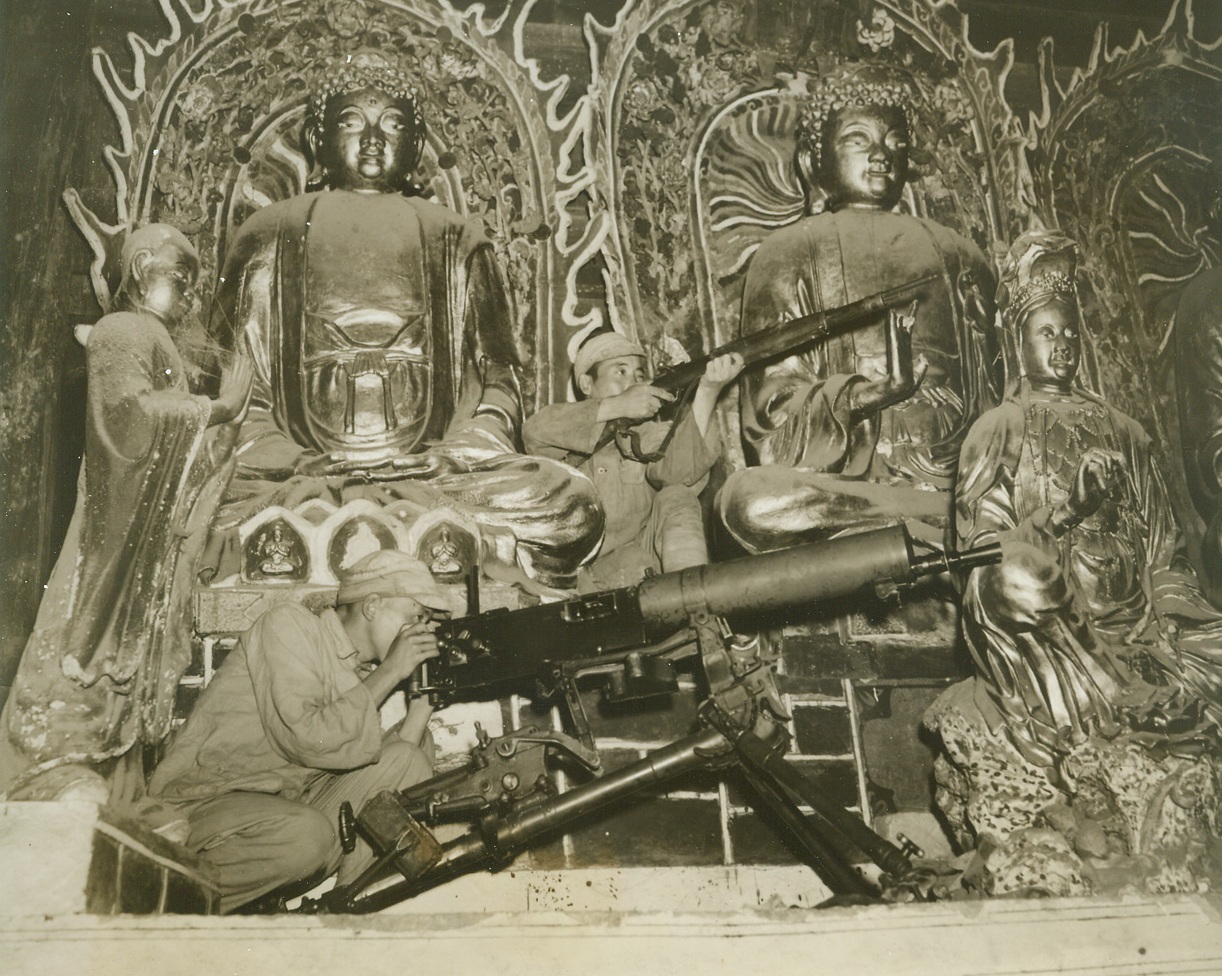
No Title. 10/4/1944. An ancient Chinese temple, ornamented with massive, costly idols, serves as a position for these Chinese warriors. Credit Line—WP—(ACME);
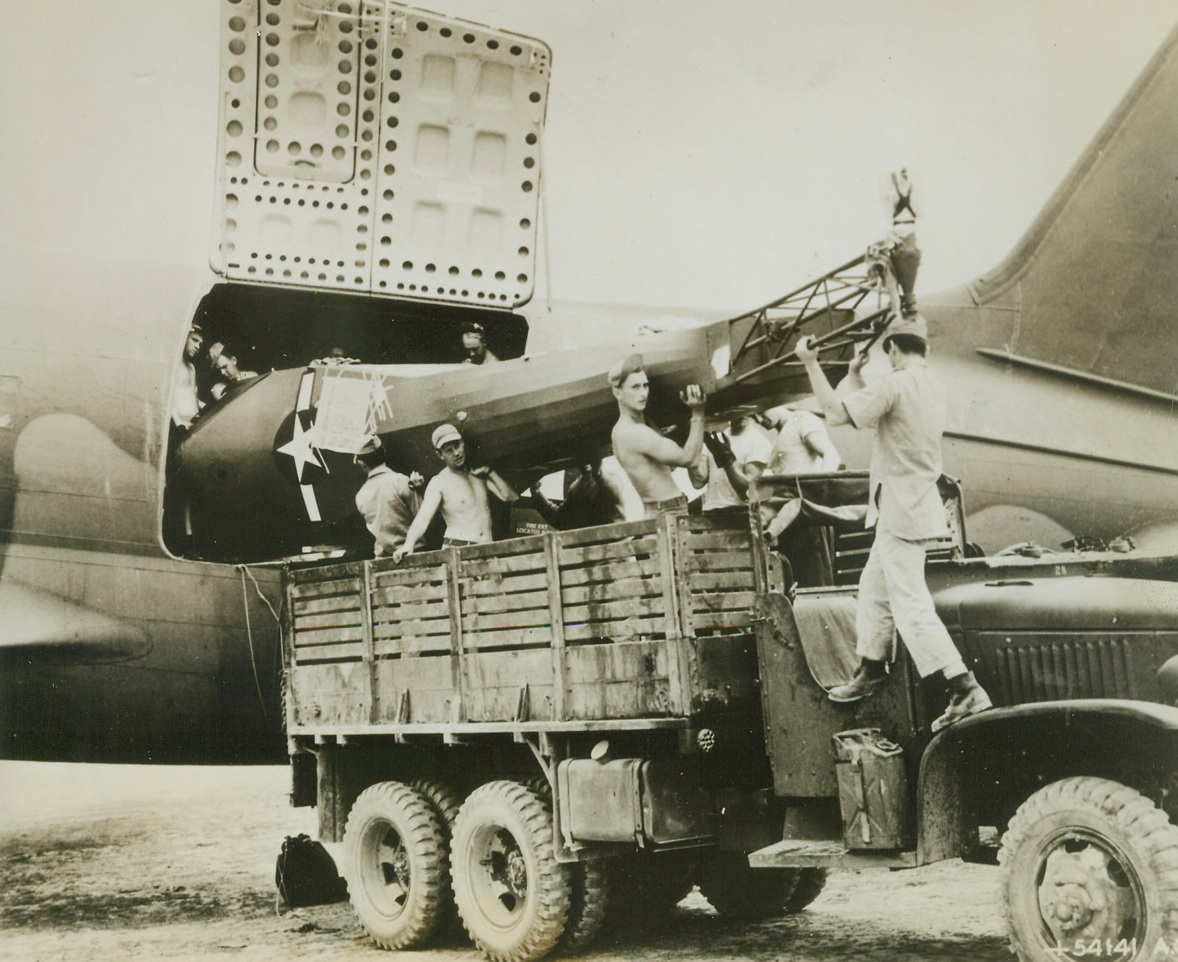
Helicopter Arrives, 10/10/1944. Somewhere in India – The fuselage of a helicopter is unloaded from a transport plane by men of the First Air Commando Group in India. The little ship was loaded aboard the big transport in the U.S. only a few days before.Credit Line (USAAF photo from ACME);
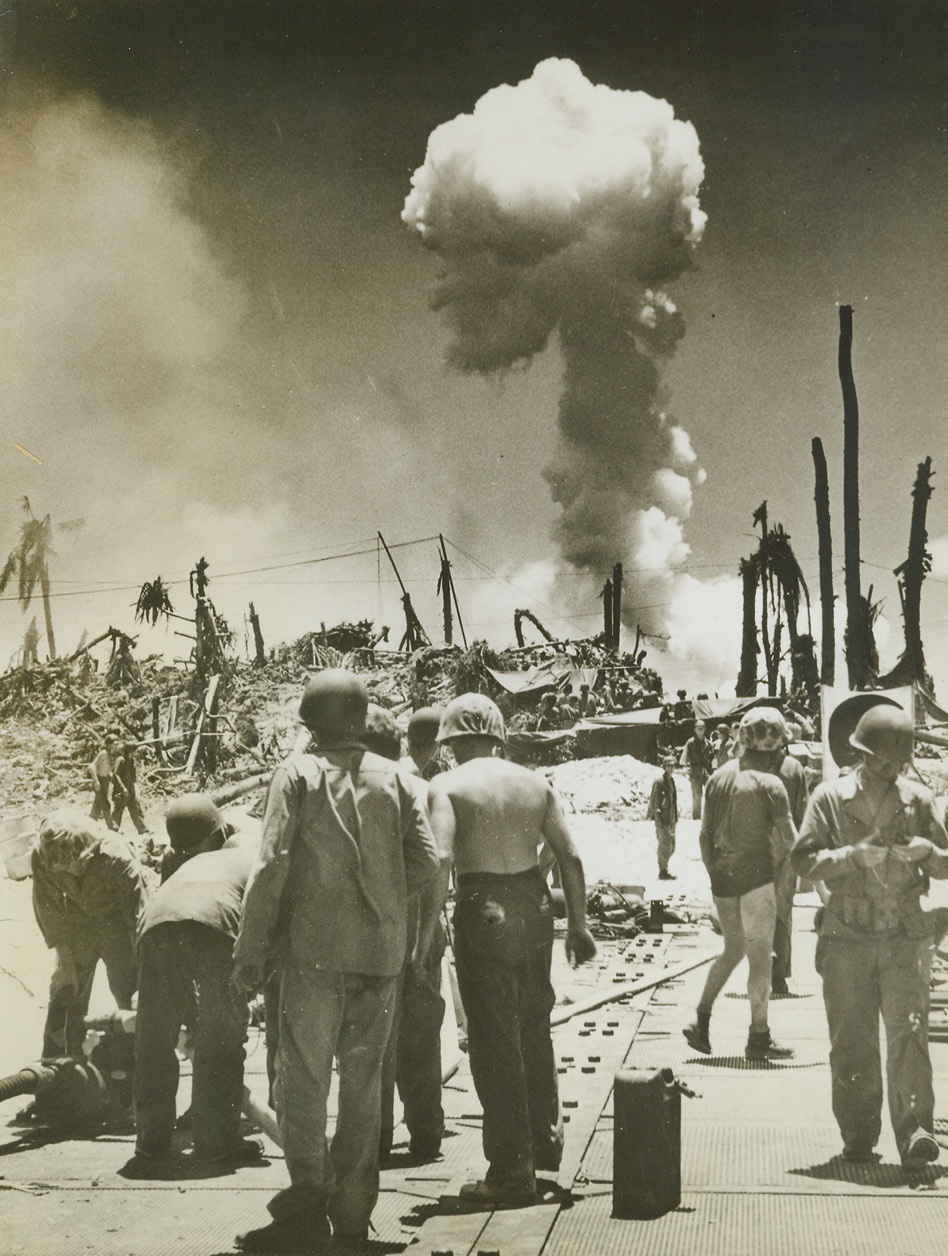
Ammo Dump Burns Sky High, 10/6/1944. Pacific – Coast Guardsmen and Yank troops hastily rig a hose to combat the blaze caused by a burning ammunition dump near the beach on Angaur Island. Island, located six miles to the South of Peleliu, fell to American invaders recently after fierce Jap resistance was beaten back.Credit (Coast Guard photo from ACME);
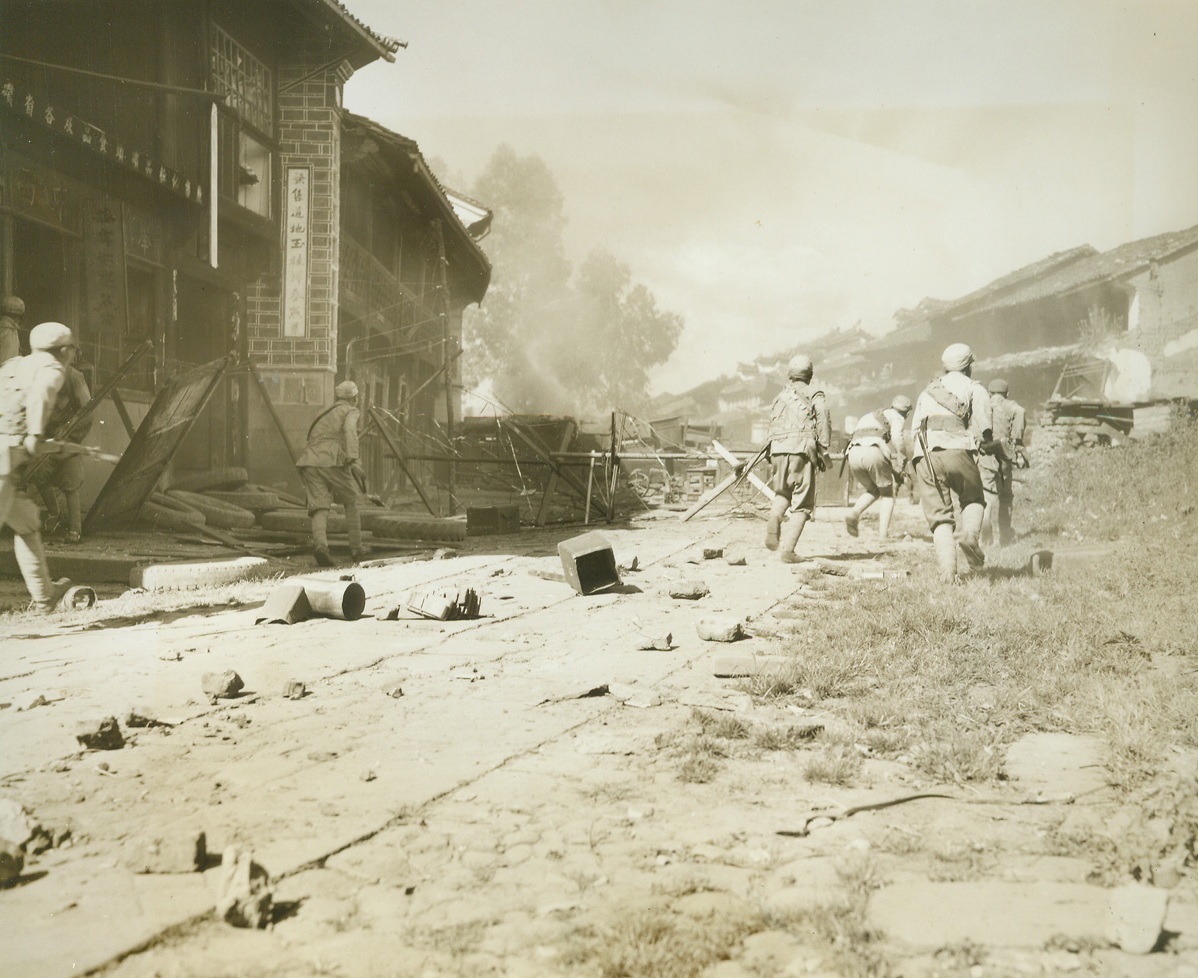
No Title. 10/4/1944. Tengchung, China - - Inching across the rugged, rain-soaked terrain of the Kaoli mountains to face a heavily-fortified Jap force at Tengchung, American-trained Chinese troops captured the ancient Jade center after a bloody, five-week battle. The first Chinese city on the Eastern side of Burma to be liberated by the Allies, Tengchung was a battle-seared, rubble-strewn prize when the Chinese moved in. Approximately 2000 Japs, who were entrenched for a six-month siege, were killed or captured in the battle, which proved the Chinese Army’s ability to use modern weapons and tactics. The U.S. 10th and 14th Air Forces supported China’s fighters in the siege of the principal enemy obstacle to the junction of the Ledo and Burma roads.;
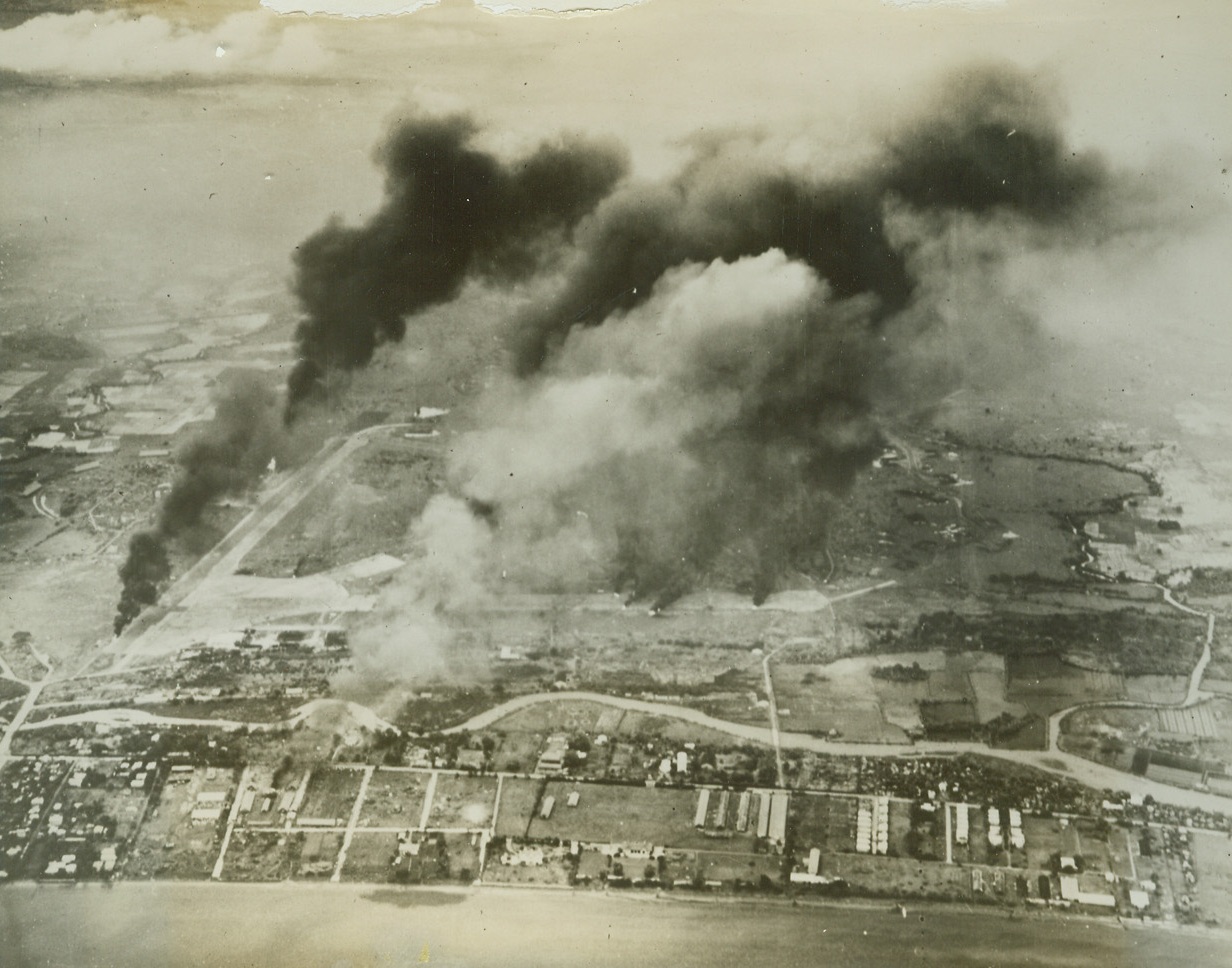
NICHOLS FIELD HIT BY AMERICAN PLANES, 10/1/1944. MANILA—Striking at Nichols on Manila Bay where the Japs nearly three years ago caught American planes unprepared on the ground. U.S. Navy pilots of Admiral William F. Halsey Jr.’s Third Fleet, left this scene of destruction after their attacks on Luzon on Sept. 20 and 21st. 169 enemy planes were destroyed in the air and 188 on the ground. Credit: U.S. NAVY PHOTO-ACME;
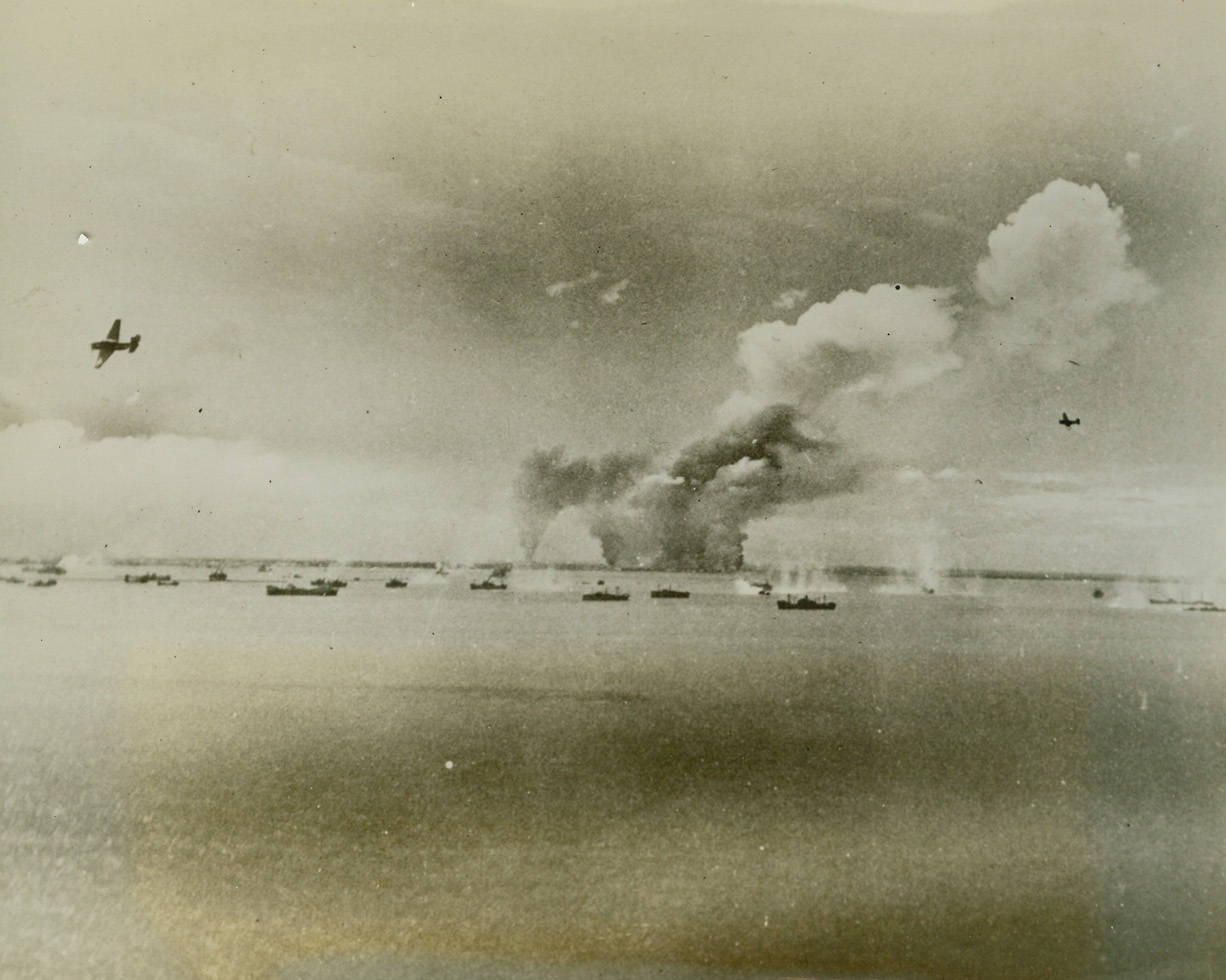
NAVY BOMBERS OVER MANILA BAY, 10/1/1944. MANILA BAY—Two Navy Avenger torpedo bombers of Admiral William F. Halsey Jr.’s Third Fleet, pull up from their attacks on units of the large merchant fleet in Manila Bay. In background, huge curtains of smoke billow from wrecked shore installations. The raid took place on Sept. 20 and 21. Credit: ACME.;
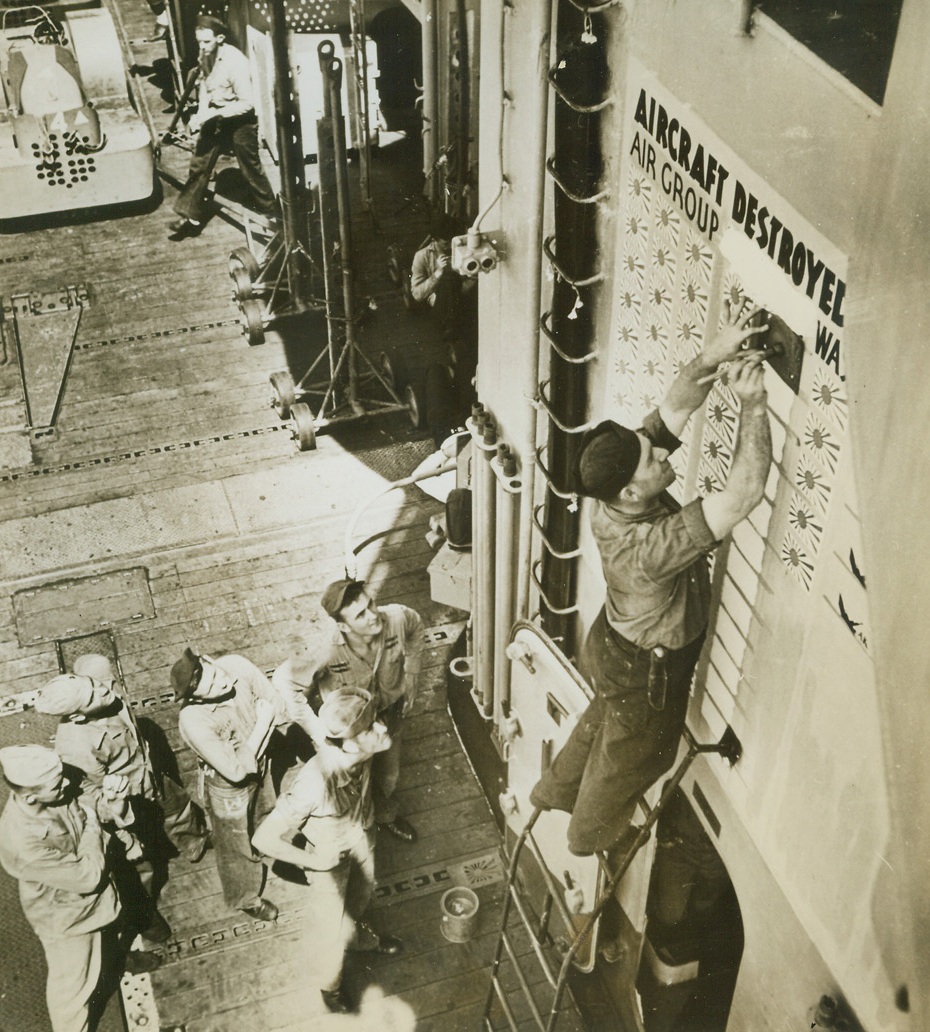
No Title. 10/14/1944. At Sea – A group of sailors watch intently as a crew member posts the score of Jap planes destroyed after the first U.S. carrier sweep against Manila, capital city of the Philippines. Credit-WP-(ACME);
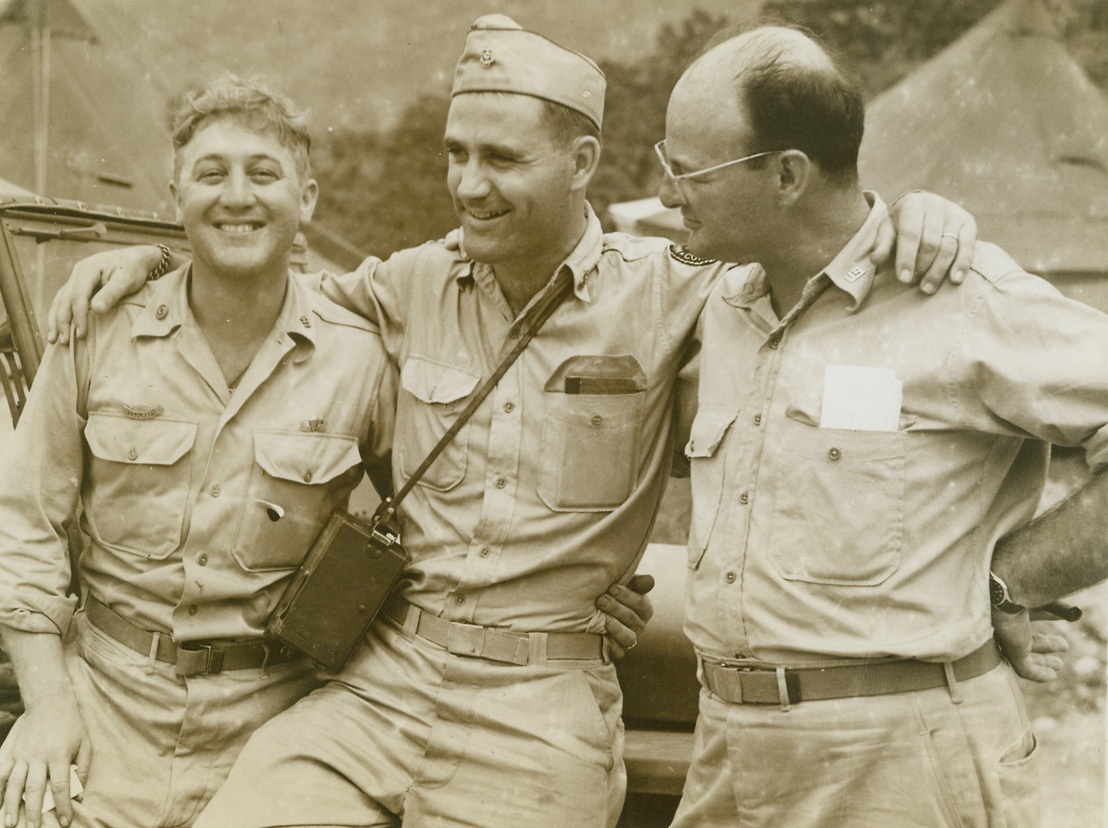
ACME Reunion in New Guinea, 10/14/1944. Dutch New Guinea – It was practically old home week in Dutch New Guinea when ACME news pictures’ photographers (left to right) Frank Prist, Stanley Troutman and Tom Shafer found themselves together in the same area. Credit line (ACME);
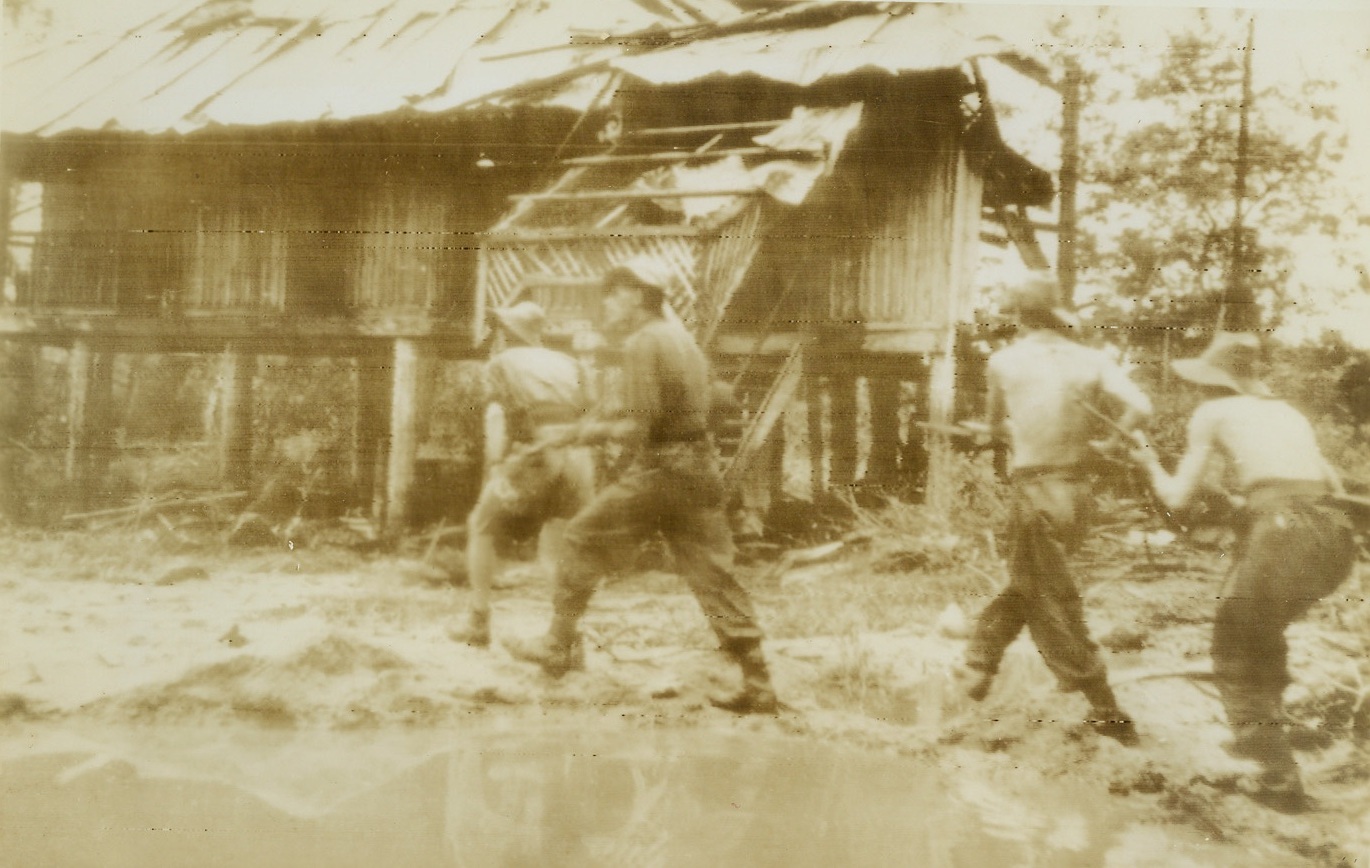
Hunt Enemy Snipers in Burma Village, 10/12/1944. Burma—British soldiers bend low as they advance cautiously through the debris-littered village of Pinbaw in Burma after its capture from the Japanese. These men, stripped to the waist, are members of the Royal Scots Fusiliers. Enemy snipers are all that remain of a once powerful garrison. Credit (British official radio photo from ACME);
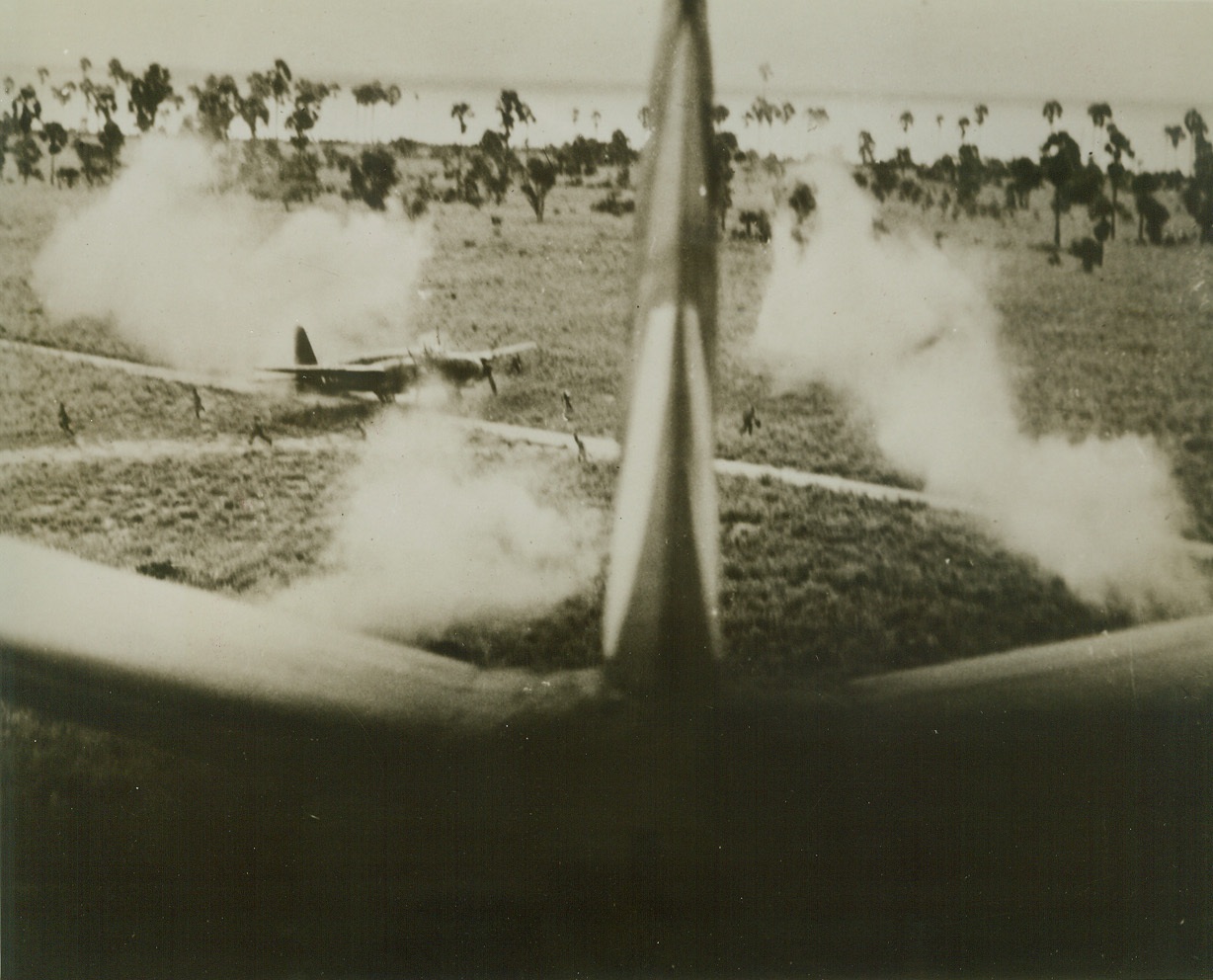
Japs Run During Yank Attack, 10/13/1944. Looking back past the tail of an American plane as it zooms up into position for another attack, Japanese crewmen can be seen running for cover, leaving a Kawasaki “Lily” plane burning on the Selaroe airstrip in the Netherlands East Indies. Yank aircraft raided the strategic field recently and pilot reported the mission a success. Credit (USAAF Photo from ACME);
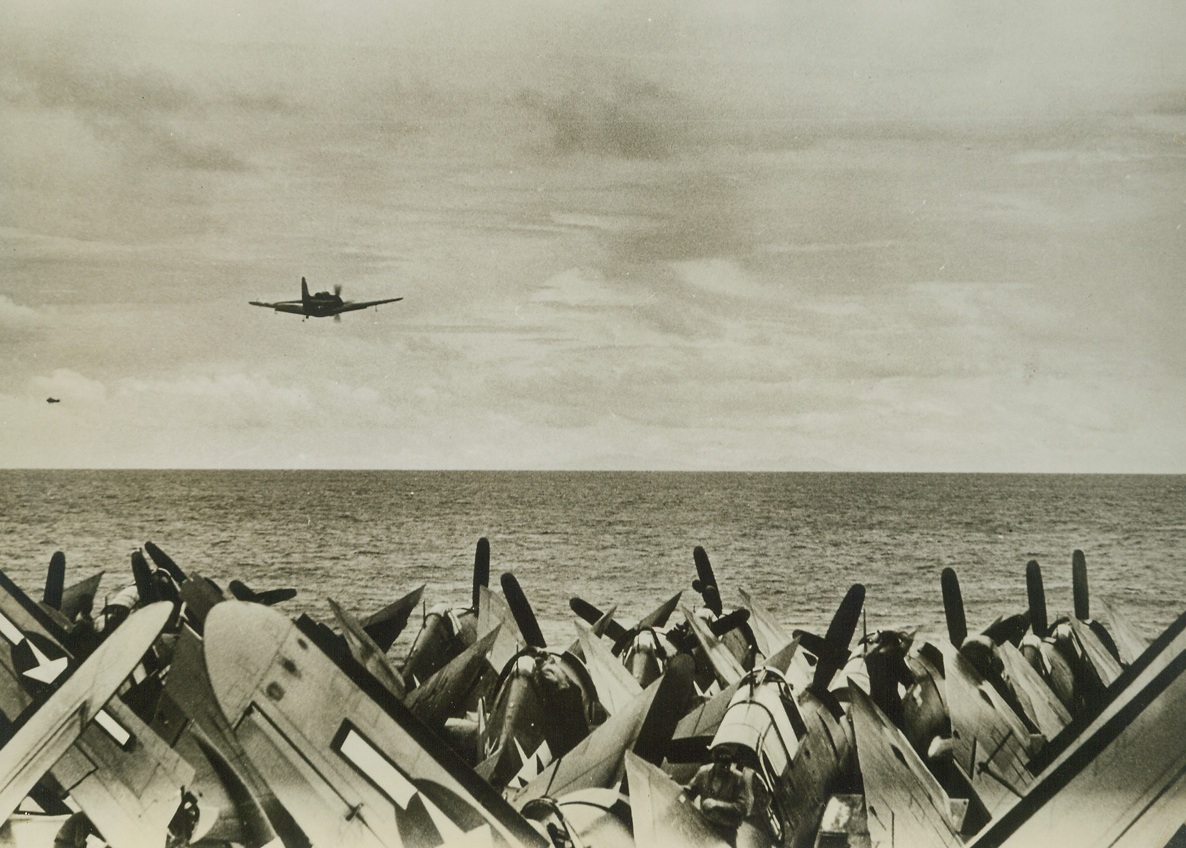
Manila His Target, 10/14/1944. At Sea—a dive bomber takes off for the first U.S. carrier sweep against Manila. Very faintly in the distance the Luzon mountains can be seen. Credit line (ACME)(WP);
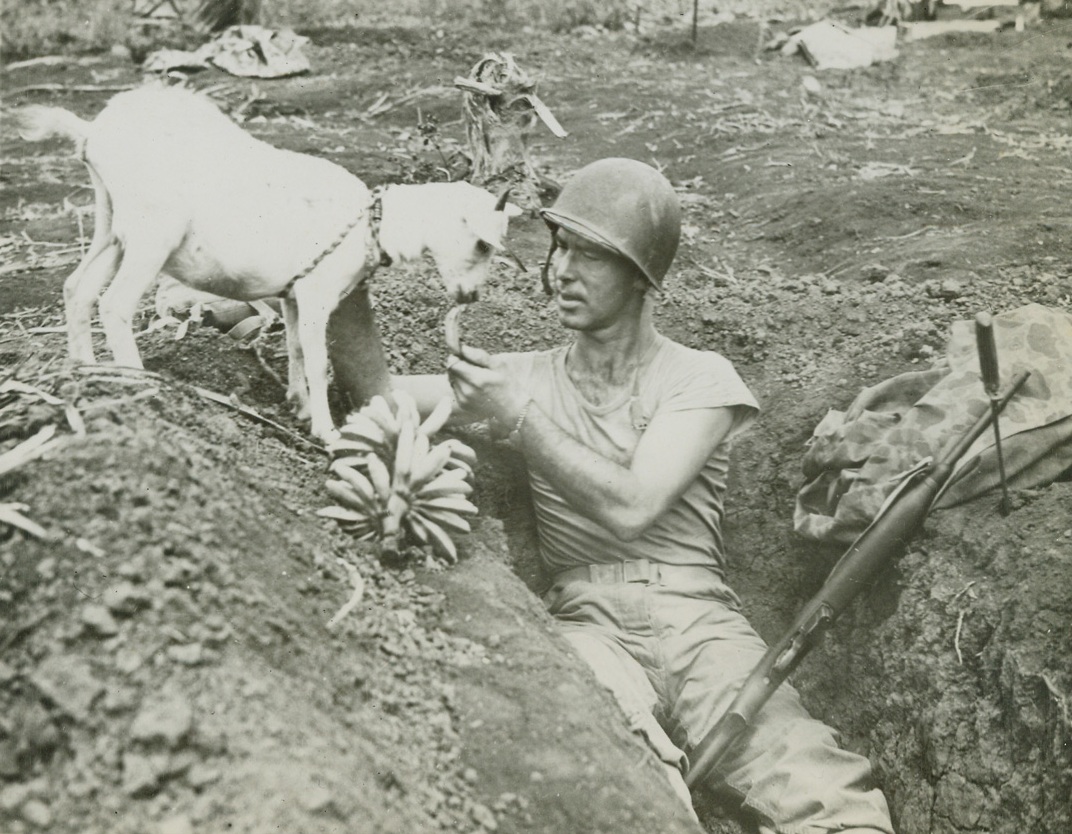
Says the Nanny to the G.I. – “What’s Cookin’?”, 10/17/1944. Saipan – Acting 1st Sgt. Neal Shober, 30, Fort Wayne, Ind., a veteran of Guadalcanal and Tarawa, feeds a visitor to his foxhole in Saipan one of the native goats that survived the bombardment. Official U.S. Marine Corps photo from (ACME);
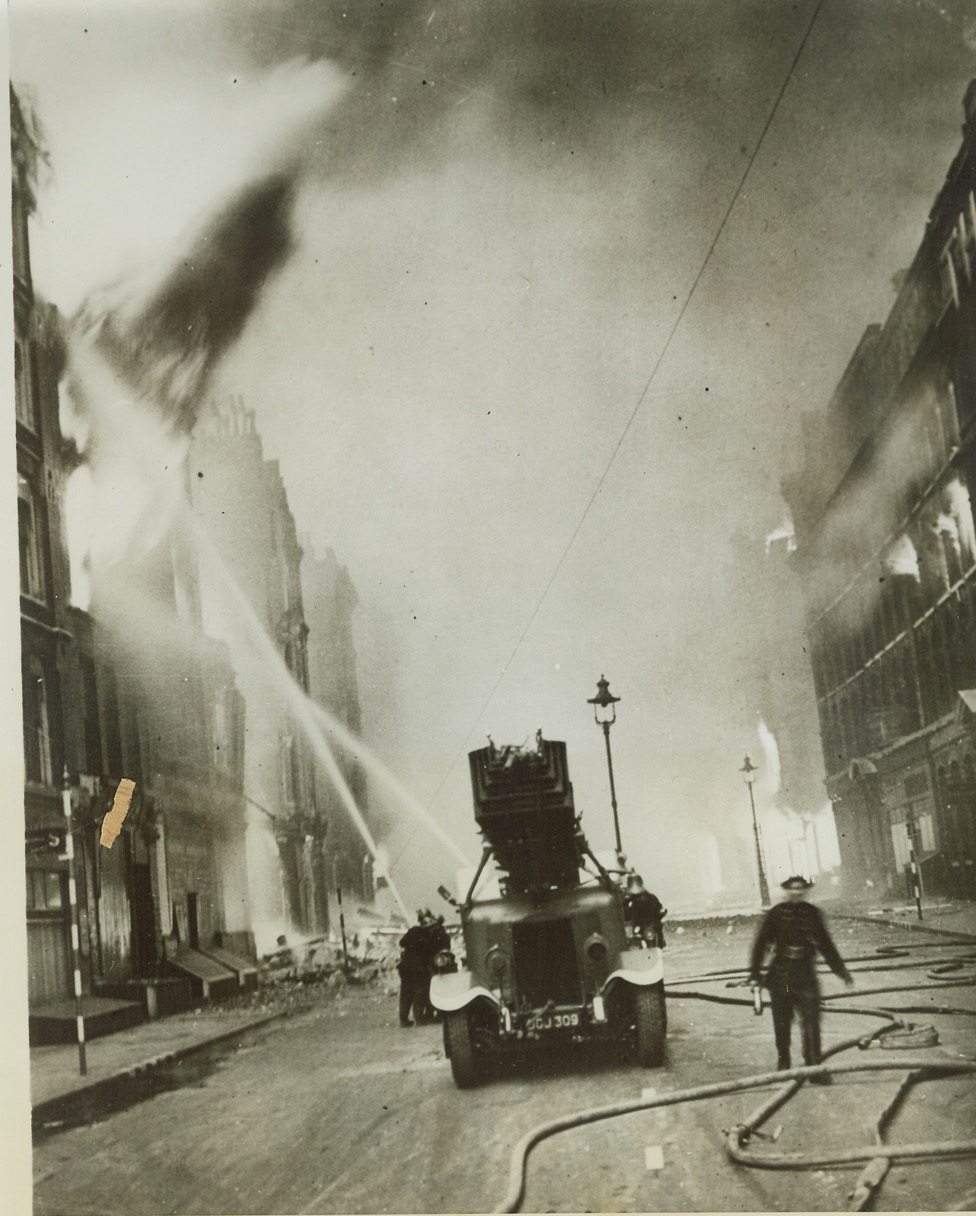
When London Burned in 1941, 10/19/1944. Fire-fighters strive desperately to beat back flames shooting from buildings along Queen Victoria Street in London during the Nazi blitz in 1941. The international headquarters of the Salvation Army is at right. This photo depicting the ferociousness of the '41 blitz has just been released by the censors for publication. Credit: (ACME);
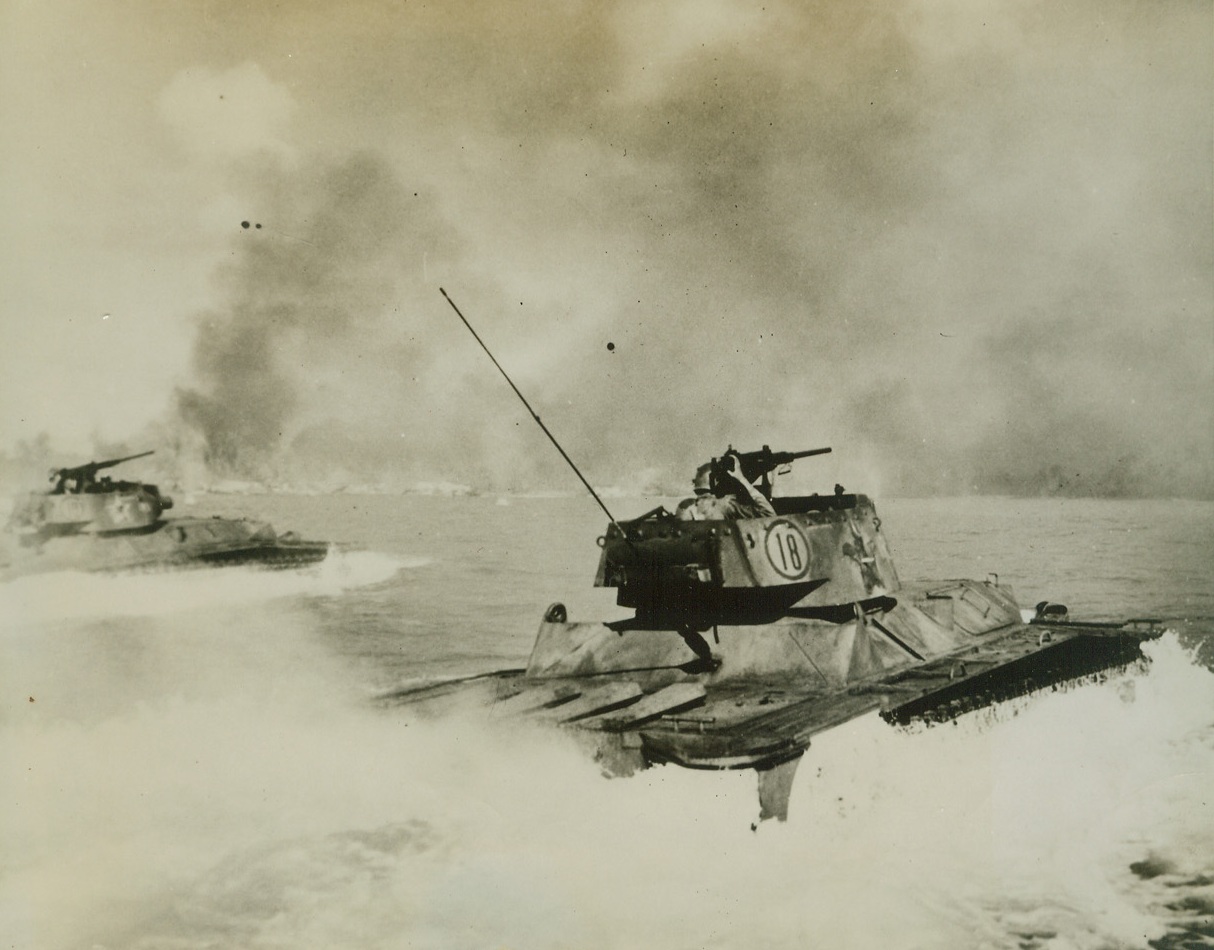
“Water Buffaloes” Head for Action, 10/1/1944. An gaur Is., Palau – Creating a backwash of foam and spray, tanks of a Marine Corps amphibious unit steam for the beach at An gaur, with machine guns and cannon ready for action in the initial assault upon the Jap stronghold. Note in the background smoke and flames from burning beach installations, hit by the preinvasion bombardment. Credit (Official US Coast Guard photo from ACME);
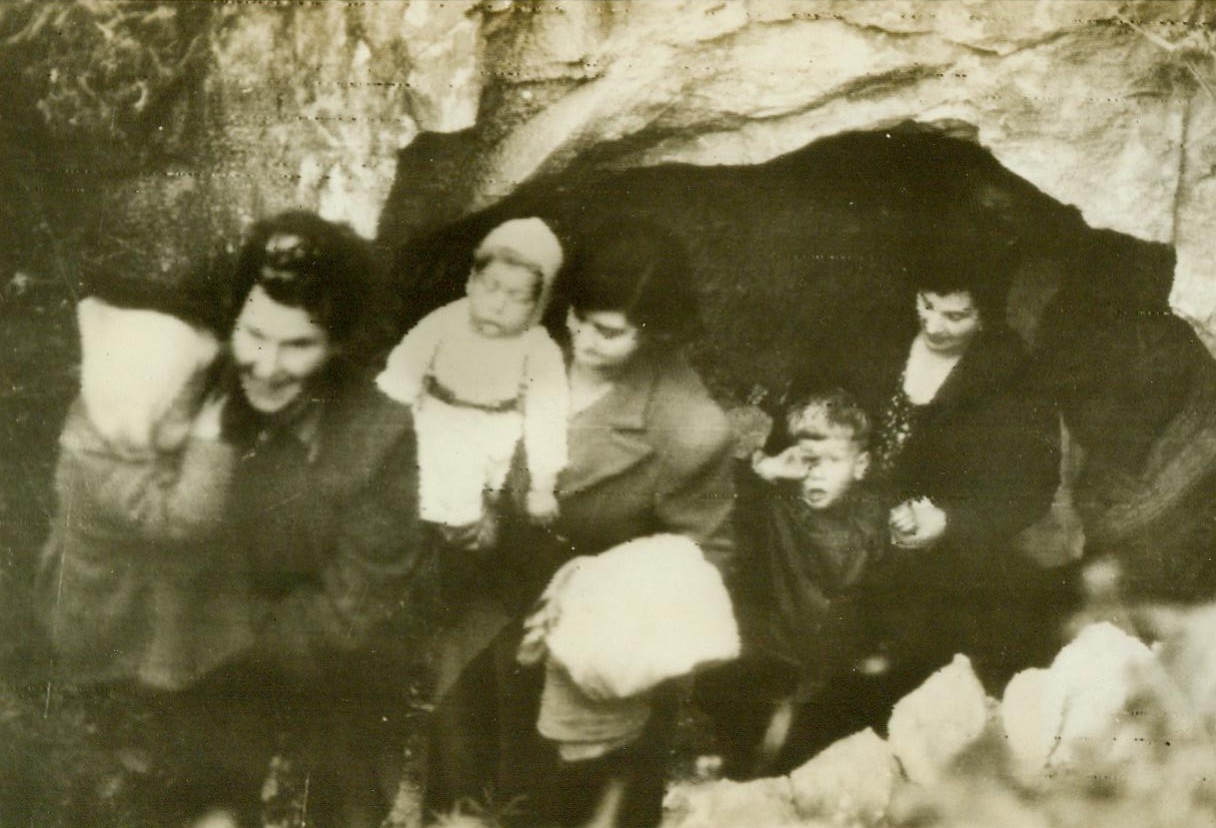
All’s clear – at last, 10/1/1944. DOVER, ENGLAND – Happy in the knowledge that enemy guns, which sent shells screaming over the Channel to Dover during the past four years, have at last been silenced, women and children of the British town leave their cave shelters forever. Two youngsters rub their eyes as they come out into the light. Many children, born during the bitter four years, have known no homes other than the caves. CREDIT (British official radiophoto from ACME) 10/1/44;
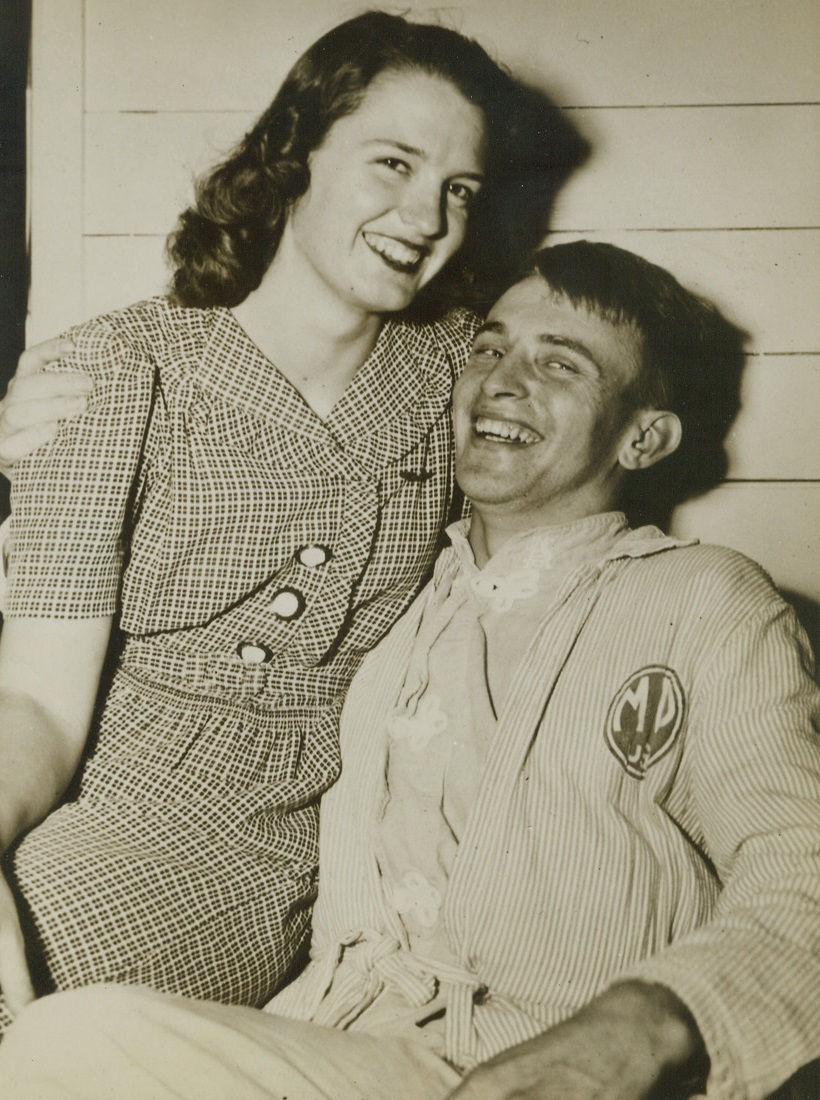
He Marries the Face He Couldn’t Forget, 10/7/1944. Atlanta, Georgia – For nine months a fractured skull mercifully blacked out every memory T/Sgt. Carlton Griffin, of Townville, South Carolina, had while he was in a German prison camp—except the face of the girl he loved. Yesterday (October 6), Sgt. Griffin, 22, and the pretty girl amnesia could not make him forget were married after being reunited at Lawson General Hospital in Atlanta, where he is recovering after being repatriated last week on the exchange ship Gripsholm. The bride’s name until yesterday was Patricia Ann Moore, of Madison, South Dakota. Credit: ACME;
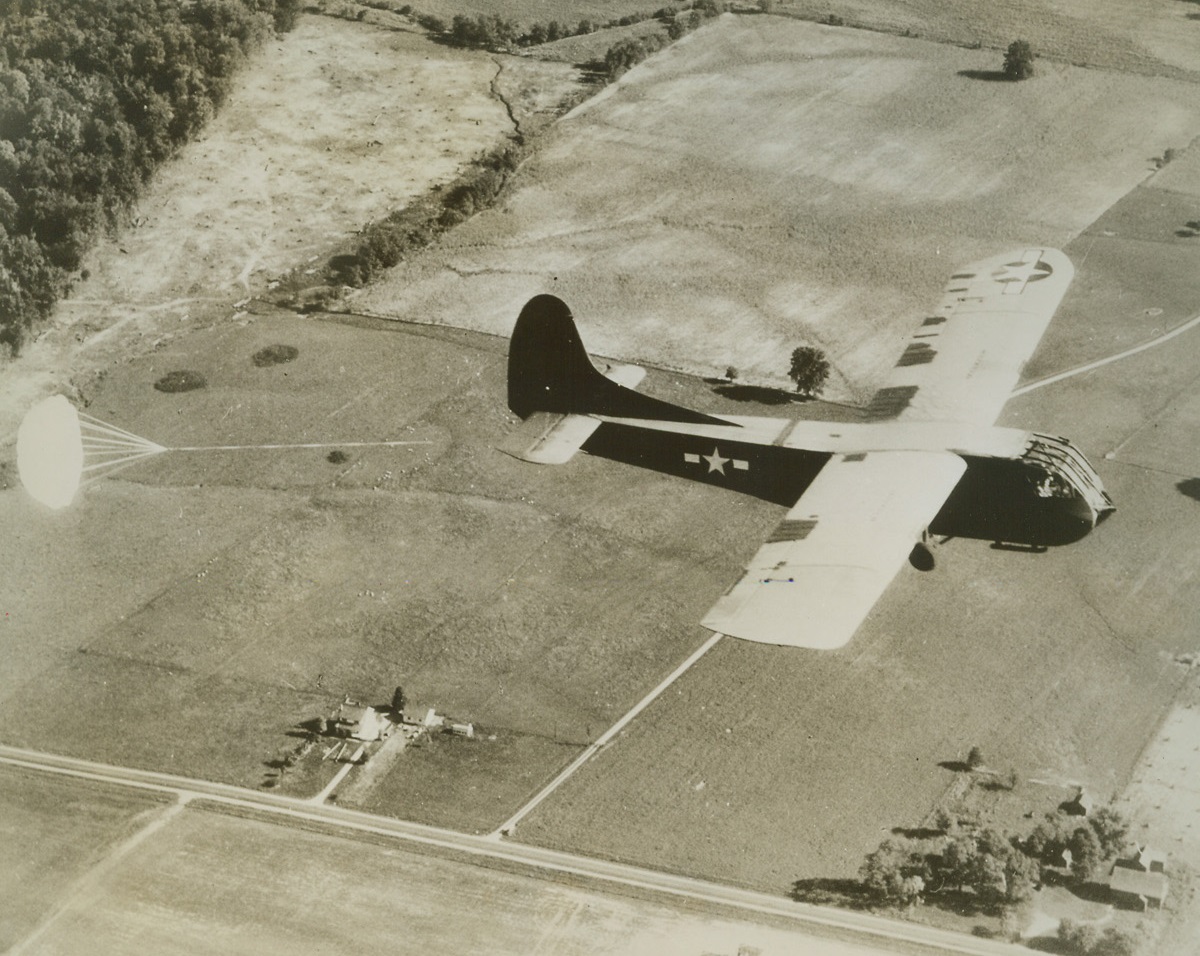
Air Brake, 10/18/1944. Wilmington, Ohio – A CG-4A Glider comes in for a test landing at Army Air Base, Wilmington, Ohio, with a giant nylon parachute serving as an air brake. New development enables gliders to land in smaller areas and reduces accidents. It is contained in a special pack attached to the glider’s tail cone and is opened by a ripcord attachment in the cockpit. Credit: USAAF photo from ACME;
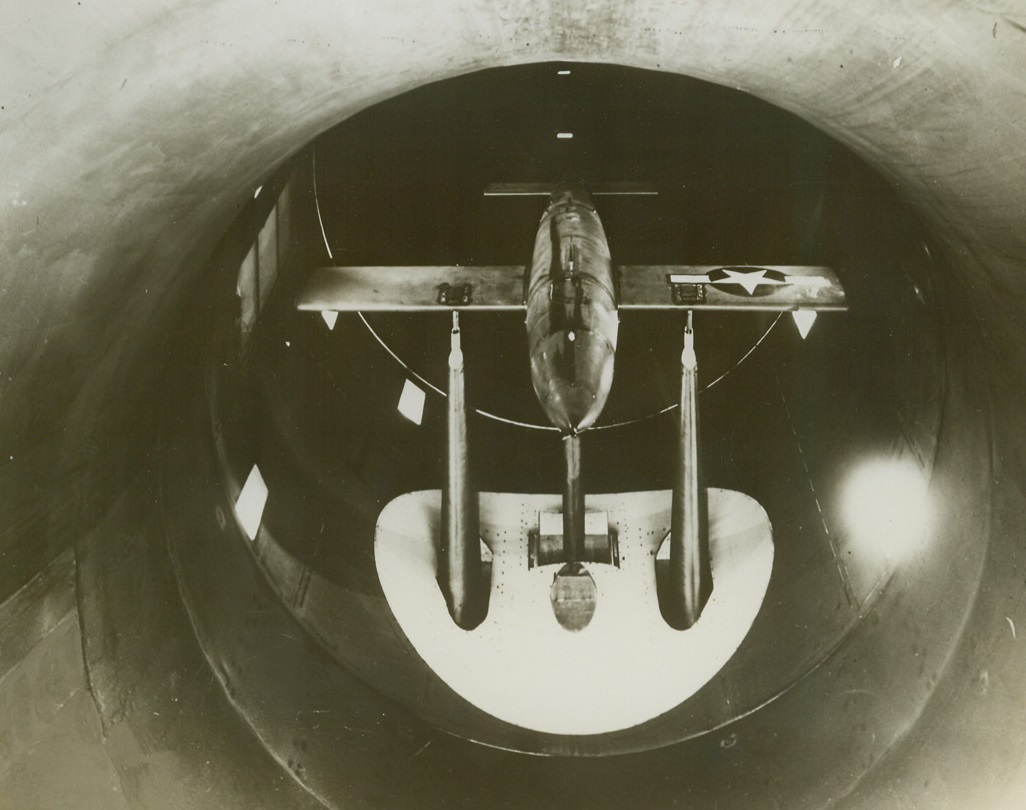
Yank Version of the Robomb, 10/26/1944. Dayton, Ohio—This is the American version of the Robomb, shown rigged to the ceiling of a 20-foot wind tunnel for testing at Wright Field, Dayton, Ohio, where it is being developed. Credit: ACME.;
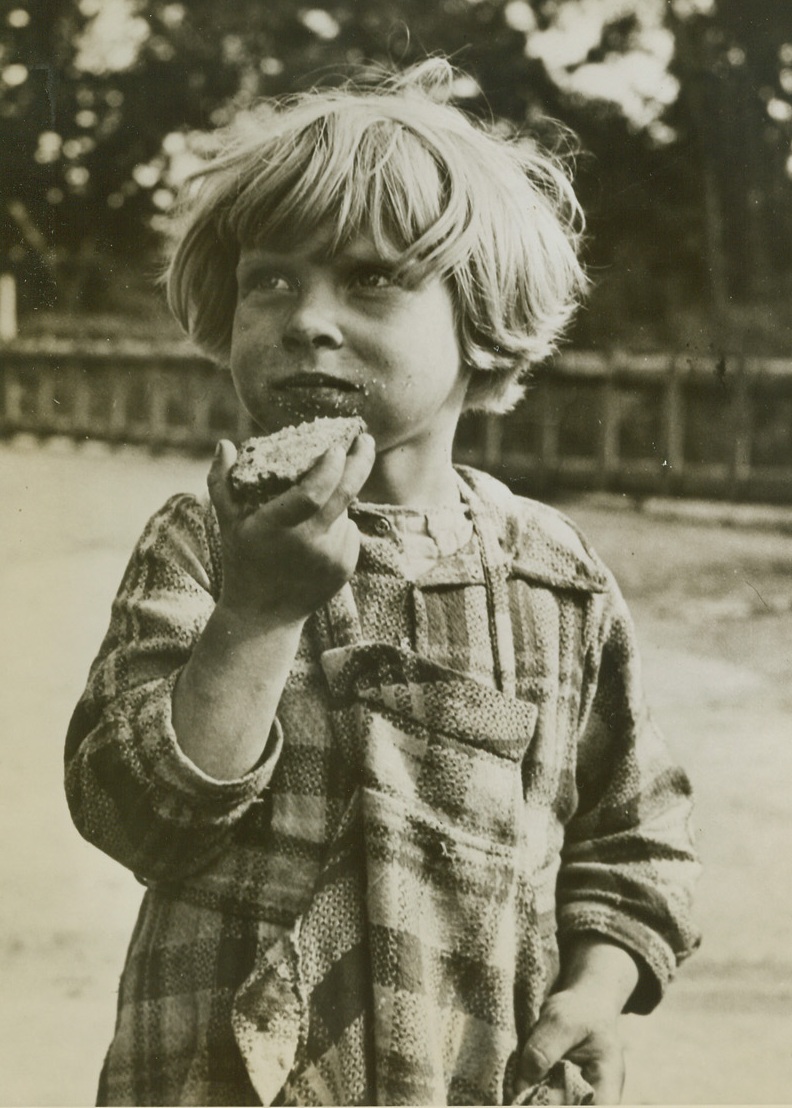
A Child Of War, 10/5/1944. FRANCE - Brown bread, sugar and butter are eaten with relish by this little girl of Dunkirk. A refugee, she is Janine Vilain. Food for needy children took top priority when the town fell to Allied troops. The port itself, where the British evacuated 350,000 soldiers four years ago, is still in enemy hands.;
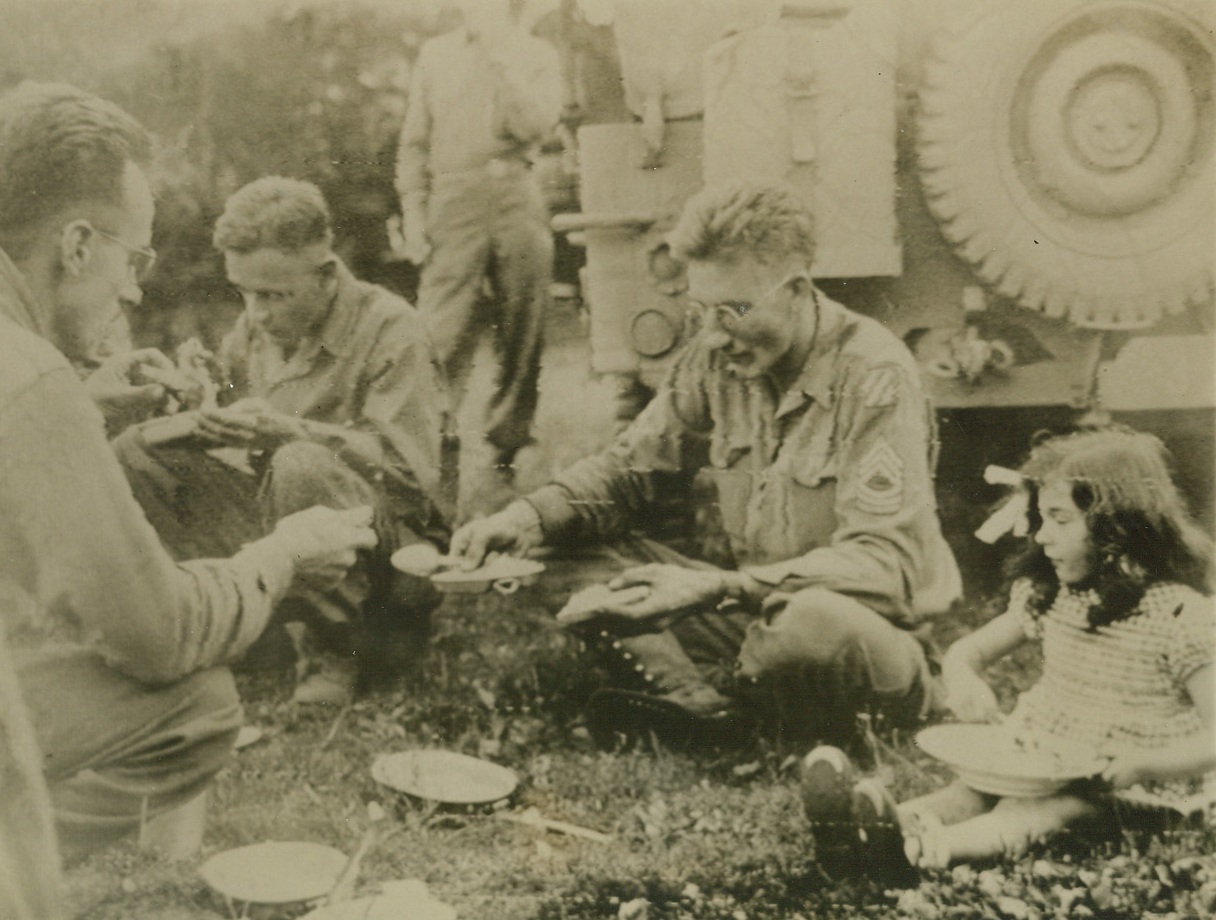
THE TOT WHO CAME TO DINNER, 10/2/1944. SOMEWHERE IN FRANCE – Sitting beside her new Yank friends, a tiny French girl shares pot luck with boys of the Third division as they squat for mess somewhere in France.Credit: Signal Corps Radio telephoto from Acme;
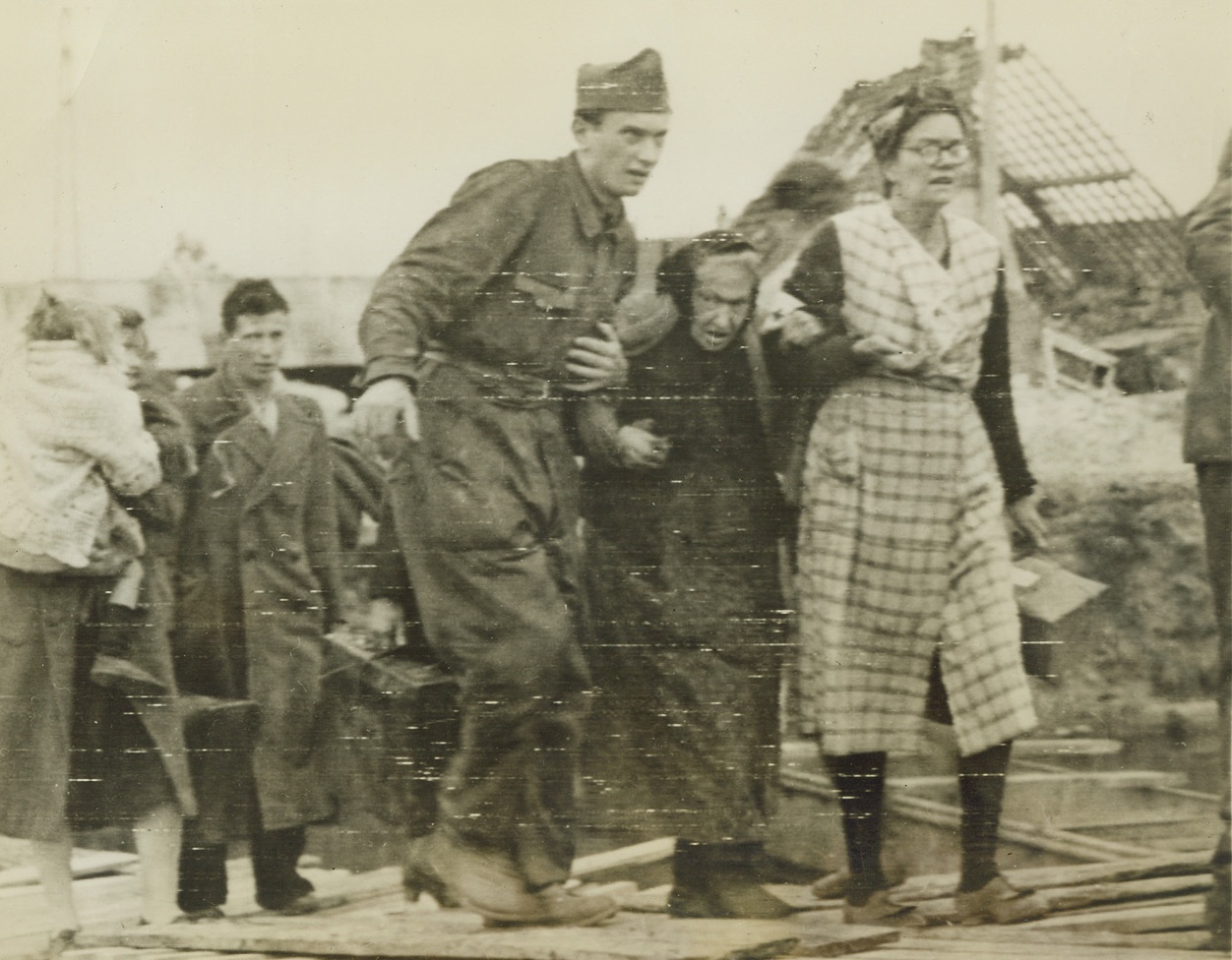
EVACUATION UNDER THE WHITE FLAG, 10/2/1944. CALAIS, FRANCE – With the guns of war temporarily silenced, an aged woman of Calais makes her way from that city during the 24-hour truce. An FFI man and a Red Cross volunteer help her to cross Calais canal. Shortly after the truce ended, Canadian troops captured the city.Credit: Acme photo via Army radio telephoto;
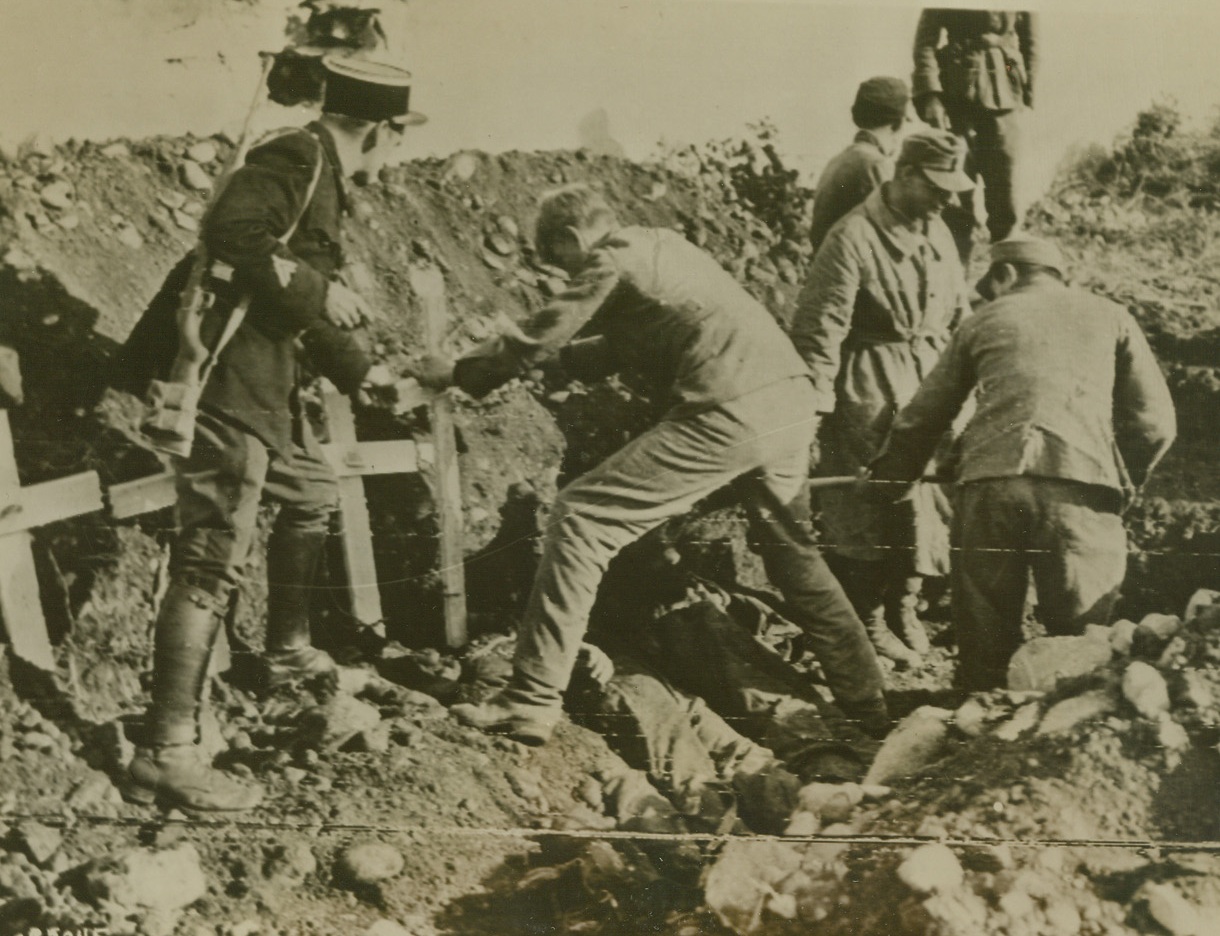
MARKING NAZI GRAVES, 10/2/1944. ELOYES, FRANCE – With the assistance of a French guard, a German prisoner of war plants a marker above the grave of one of his countrymen. At right, other captives shovel earth over the closely packed bodies of Nazi soldiers in this cemetery at Eloyes.Credit: Signal Corps radio telephoto from Acme;
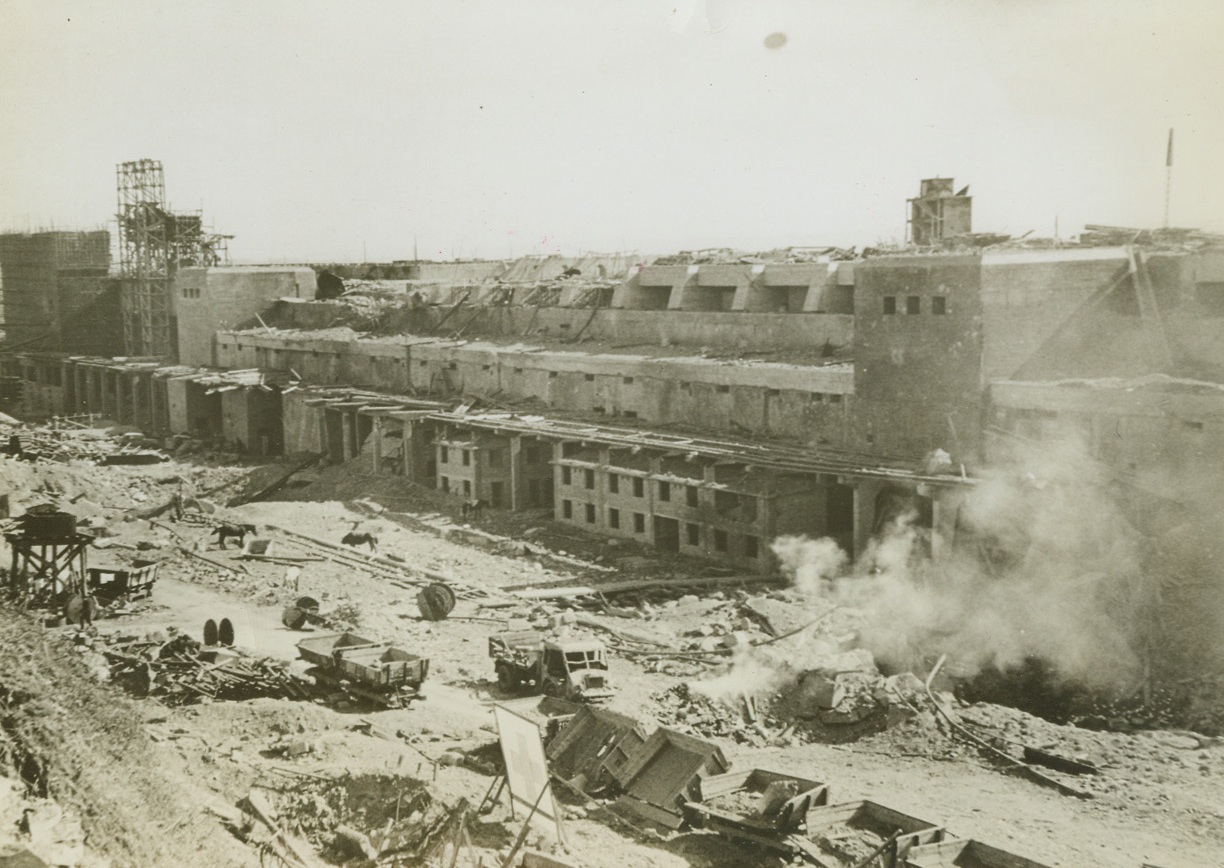
BREST FORTRESS BURNS AFTER CAPTURE, 10/7/1944. FRANCE – Fort Montbarey in the French port of Brest burns after its capture by the Allies on September 17. Germans withstood a long allied siege before surrendering. All weapons were destroyed by the Nazi demolition squads before final capture. Tunnels, honey-combed beneath the Fort aided the Nazis to resist superior Allied forces. Fort itself shows results of terrific artillery bombardment.Credit: Acme;
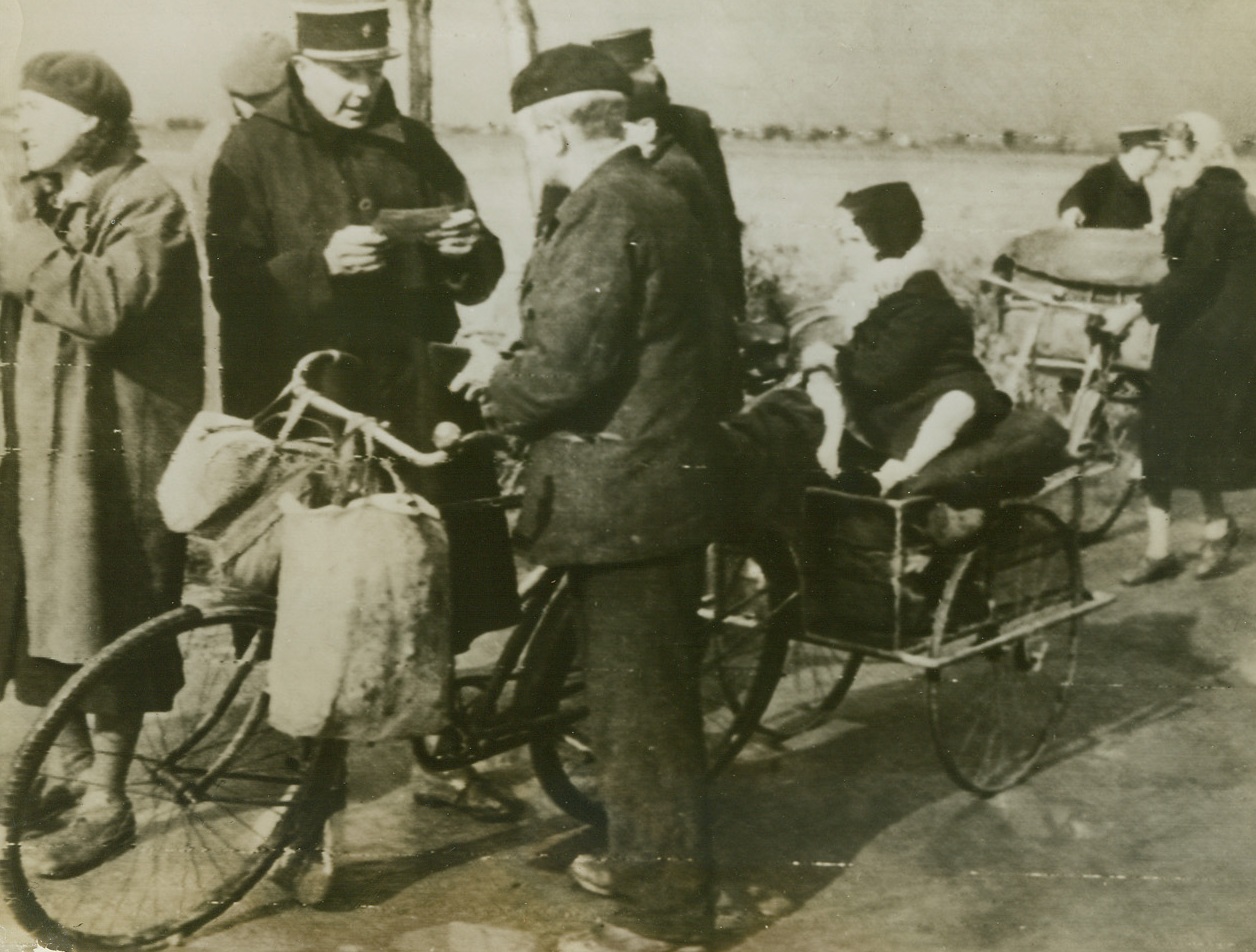
FLEE DUNKIRK DURING TRUCE, 10/7/1944. FRANCE – Between the British and German lines on the soon to become a “no man’s land” at the outskirts of Dunkirk, a French Gendarme checks identity papers of civilians fleeing the city under terms of the truce which allowed the evacuation of residents. Battle for the port from which 350,000 British soldiers escaped four years ago will soon take on major proportions. Credit: British War office photo via Army radio telephoto from Acme;
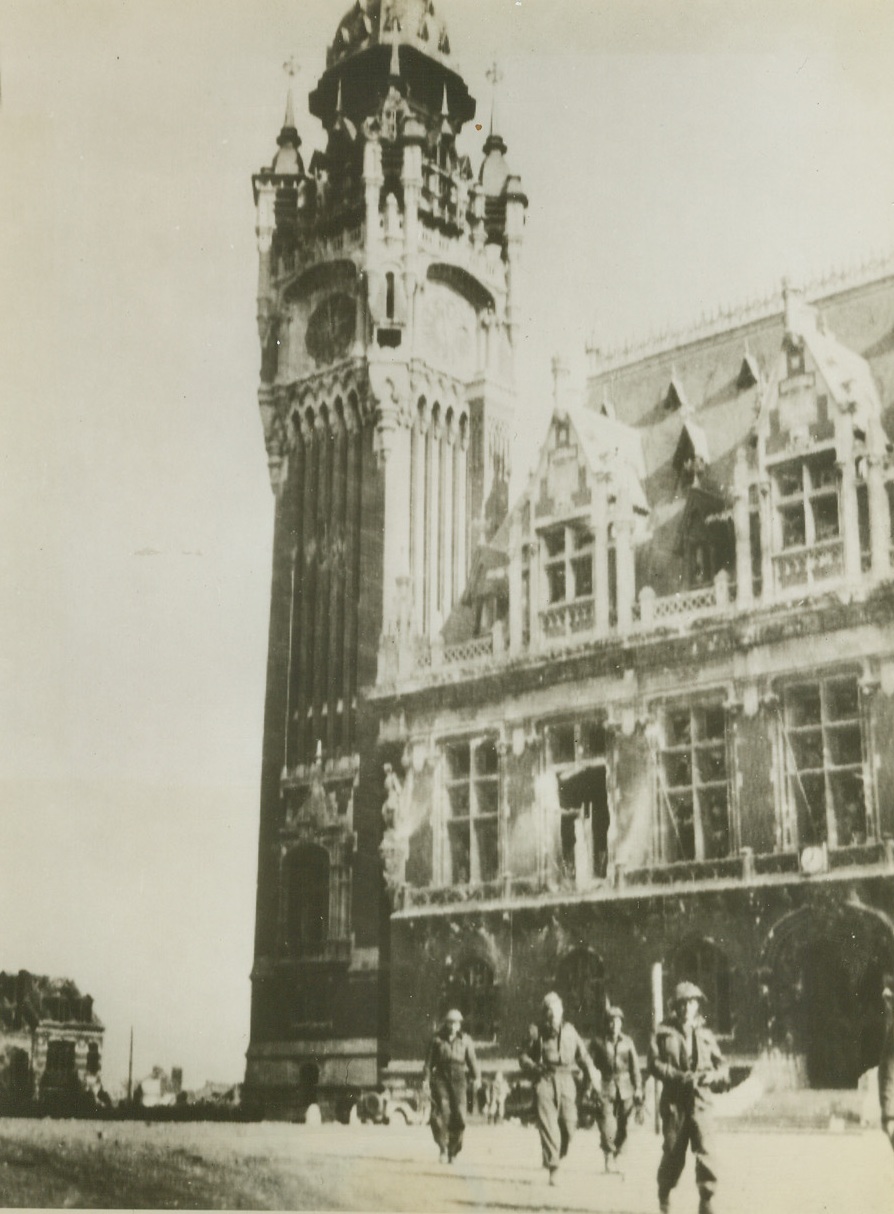
CANADIANS PASS CALAIS LANDMARK, 10/4/1944. A group of Canadian troops on patrol in the French port of Calais, pass the famous clock tower which, on a clear day, can be seen from Dover, England, across the Channel. Credit Line (ACME Photo via Army Radiotelephoto);
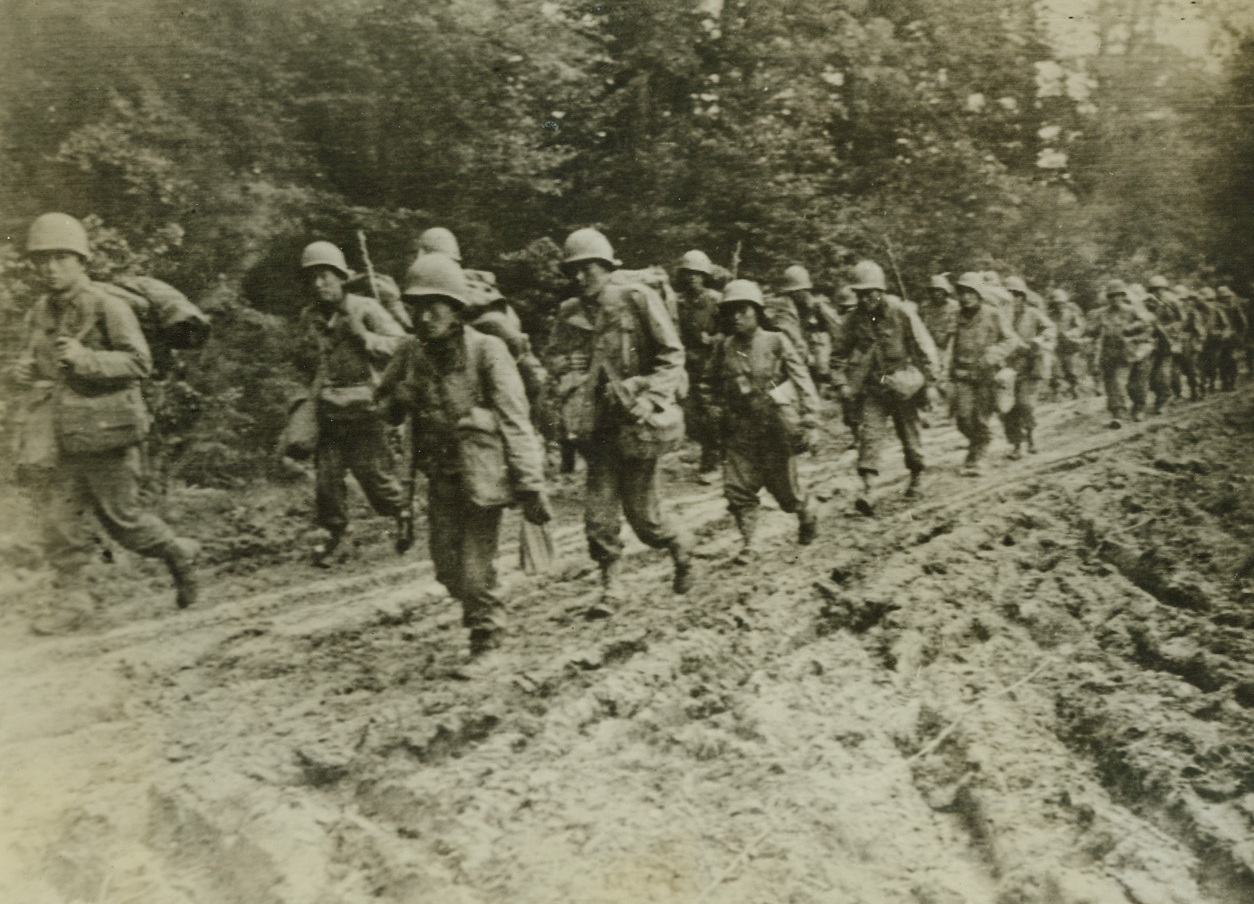
CLAIM NO KINSHIP, 10/20/1944. FRANCE—As Americans smash their way into the Jap’s temporary bastion in the Philippines, these loyal Japanese-American infantrymen slog through the mud of France to join other Allied forces in the battle to conquer Germany. Credit (Army Radiotelephoto from ACME);
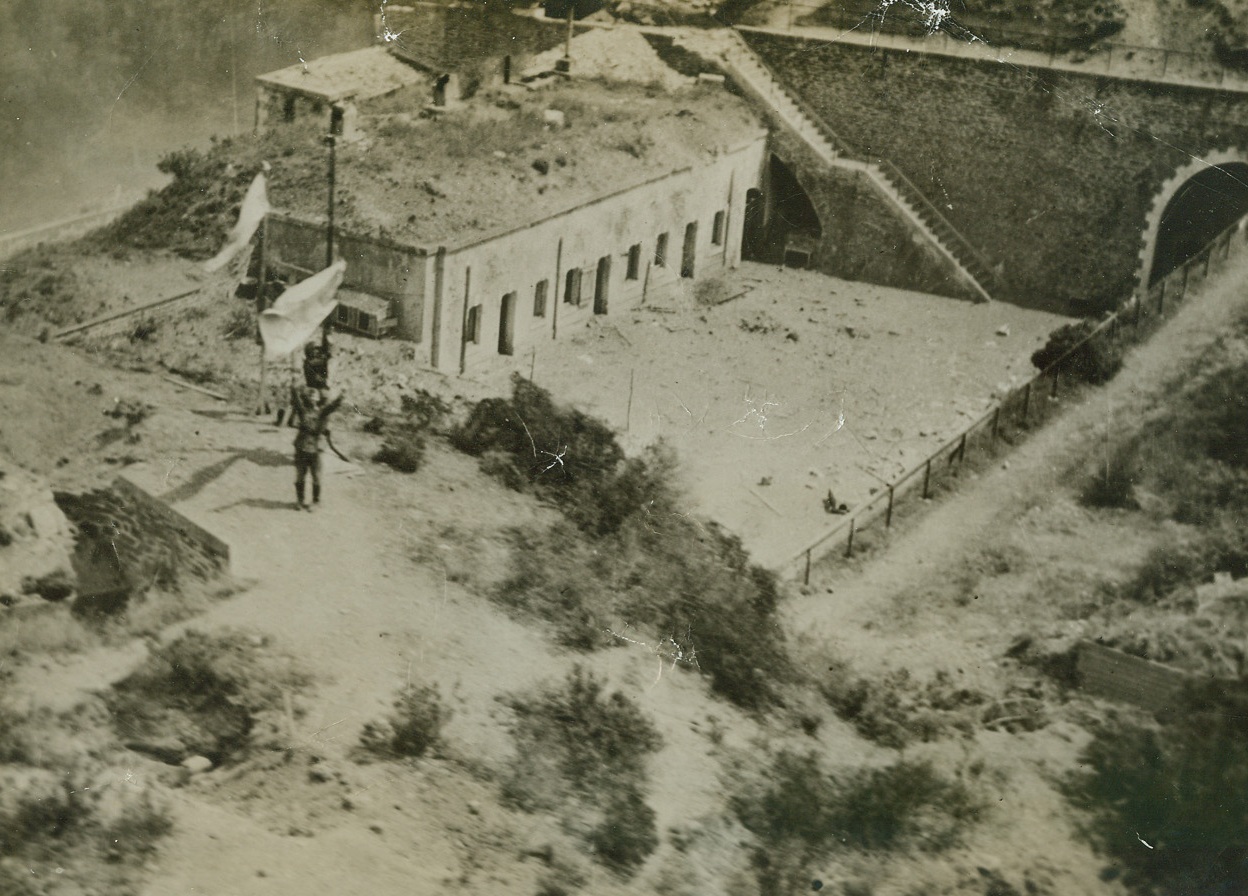
German Garrison Surrenders to US Plane, 10/1/1944. France – Waving high the white flag of surrender, a German soldier walks out from a Nazi-held fort on the coast of France, which was under fire from the guns of the USS Quincy. This photo was taken from a US plane, which radioed back to the warship that it could cease firing. The plane had been flying over the fort to direct the fire from the ship. Credit: Official U.S. Navy photo from ACME;
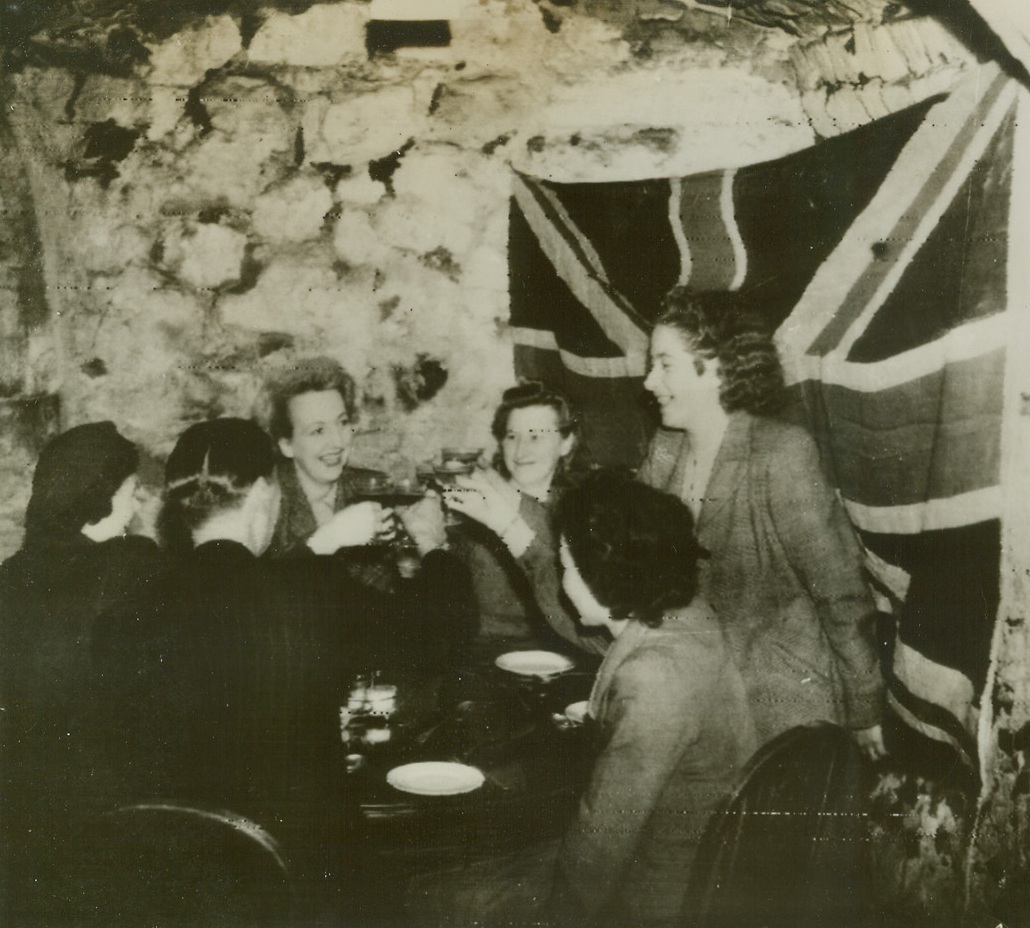
Dover Rejoices, 10/1/1944.Dover, England – Rejoicing over the good news that Dover’s four-year shelling by German cross-channel batteries has ended at last, people of the embattled British town celebrate in a shelter restaurant. Happy civilians raise their glasses in a toast to Canadian troops who silenced the Cap Gris Nez guns across the Channel. Credit: British official photo from ACME;
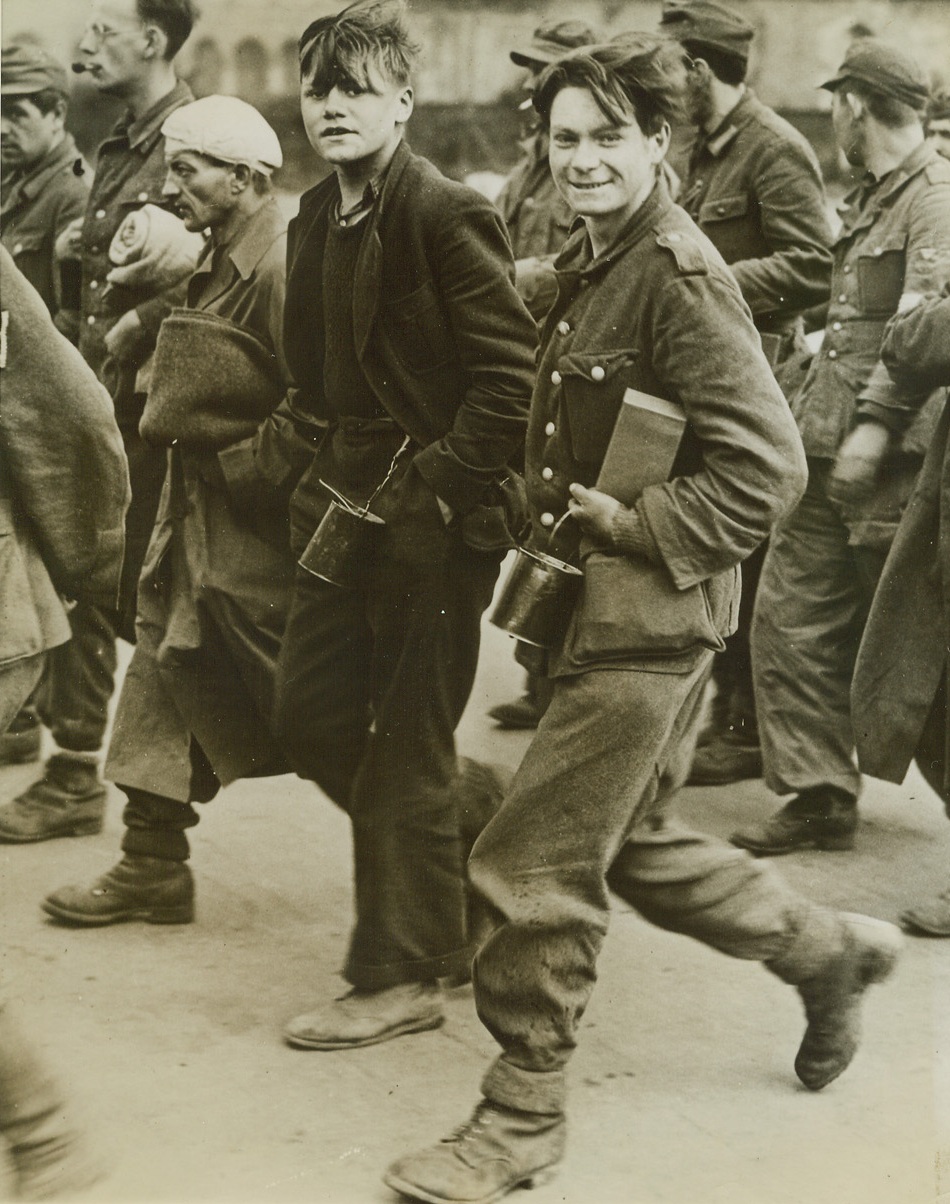
Youngsters Found With Captured Nazis, 10/18/1944. England – Two school-age youngsters march with veteran Nazi soldiers as they head for prison camps in England after crossing the Channel in a landing craft. The youths were taken at Calais. Credit: ACME;
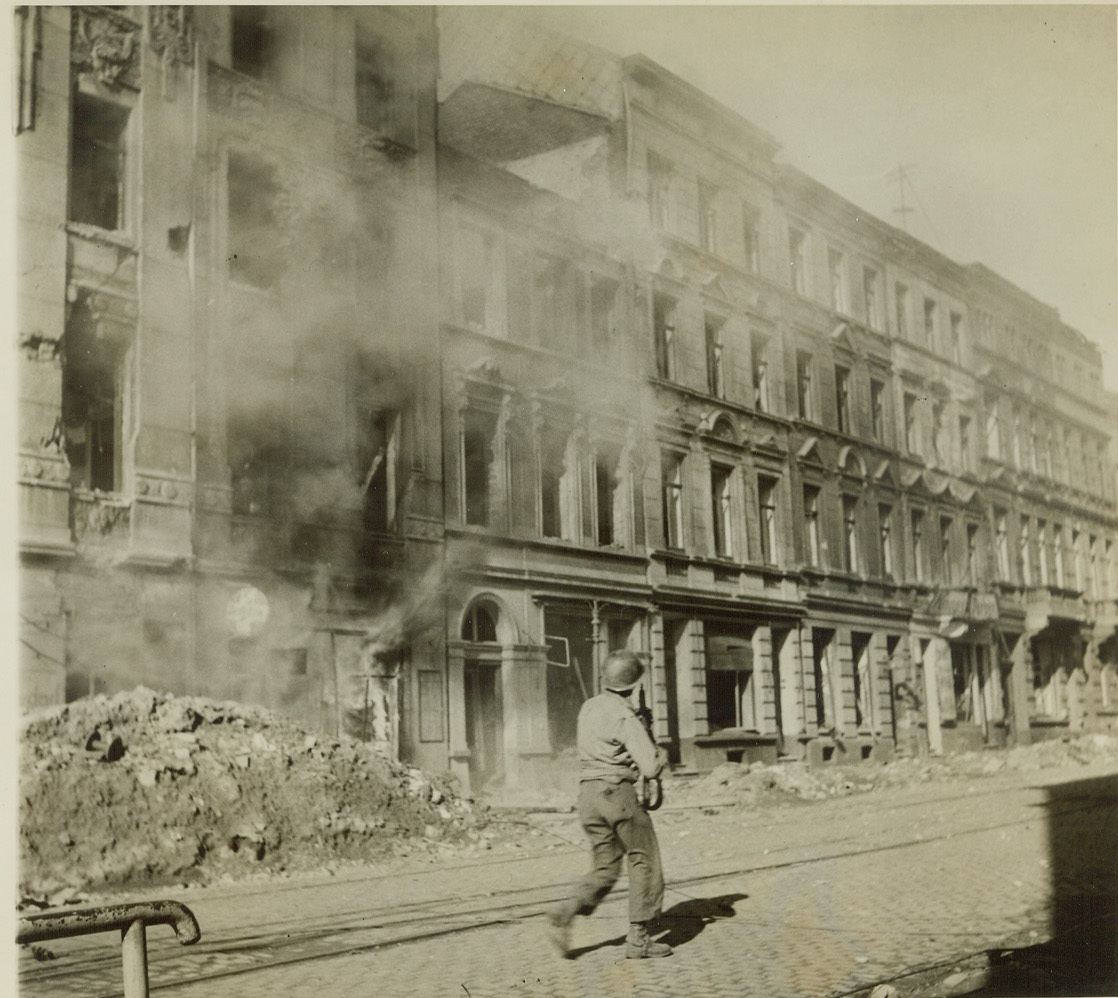
Shooting his way through Aachen, 10/20/1944. AACHEN, GERMANY – Moving up a street in Aachen, past buildings still smoking from exchanges of shots, this American infantryman keeps his gun cocked and eyes open for German snipers, as he leads an advance during the fierce street fighting final enemy resistance ended today, and American forces are now in full possession of the German town, key to the Rhine. Credit (Acme Photo by Bert Brandt, War Pool Correspondent);
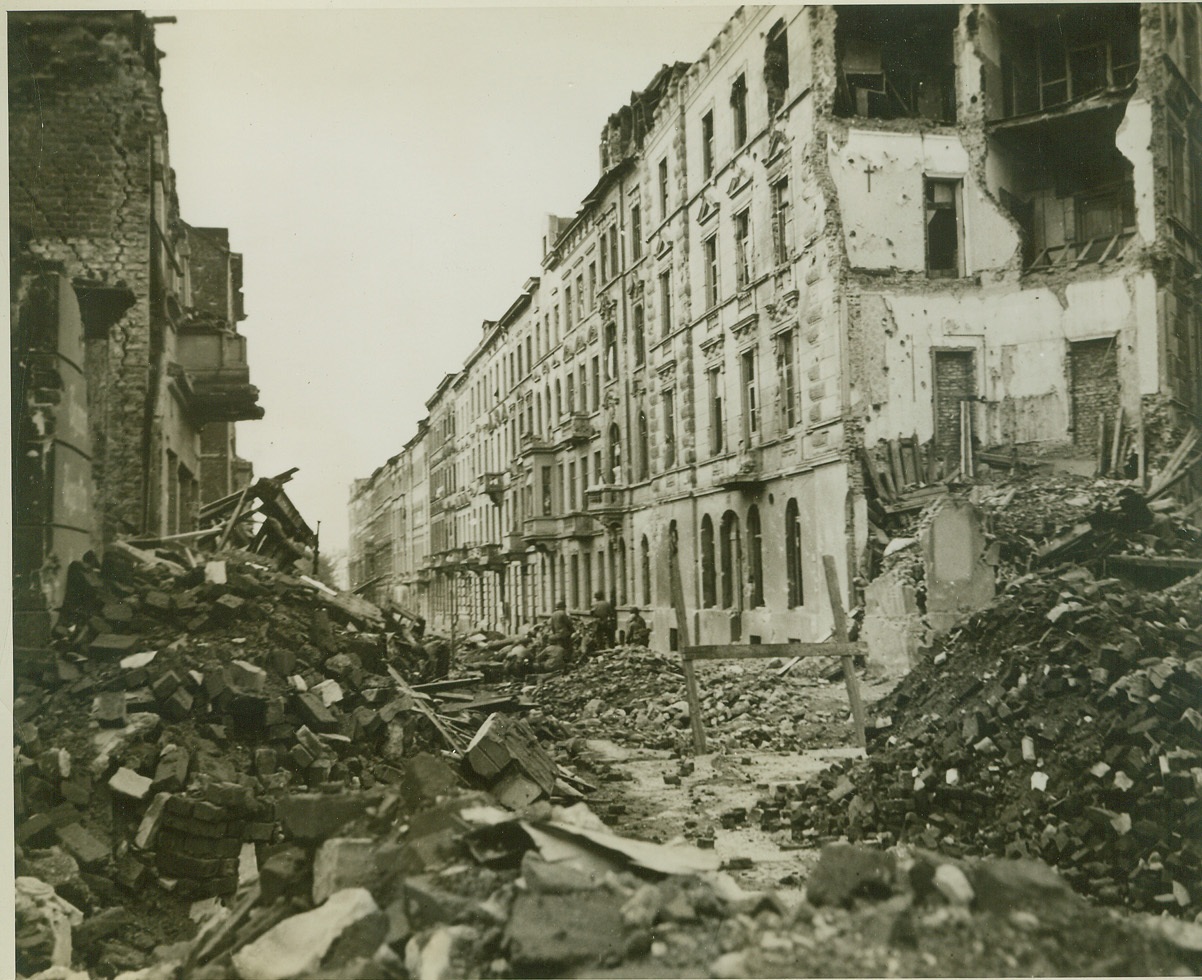
Blasted Aachen, 10/18/1944. Huge piles of rubble fill this street in battle-smashed Aachen, Germany. Many historic buildings were leveled in the heavy shelling and aerial bombardment which preceded Yank entry. Credit: (ACME);
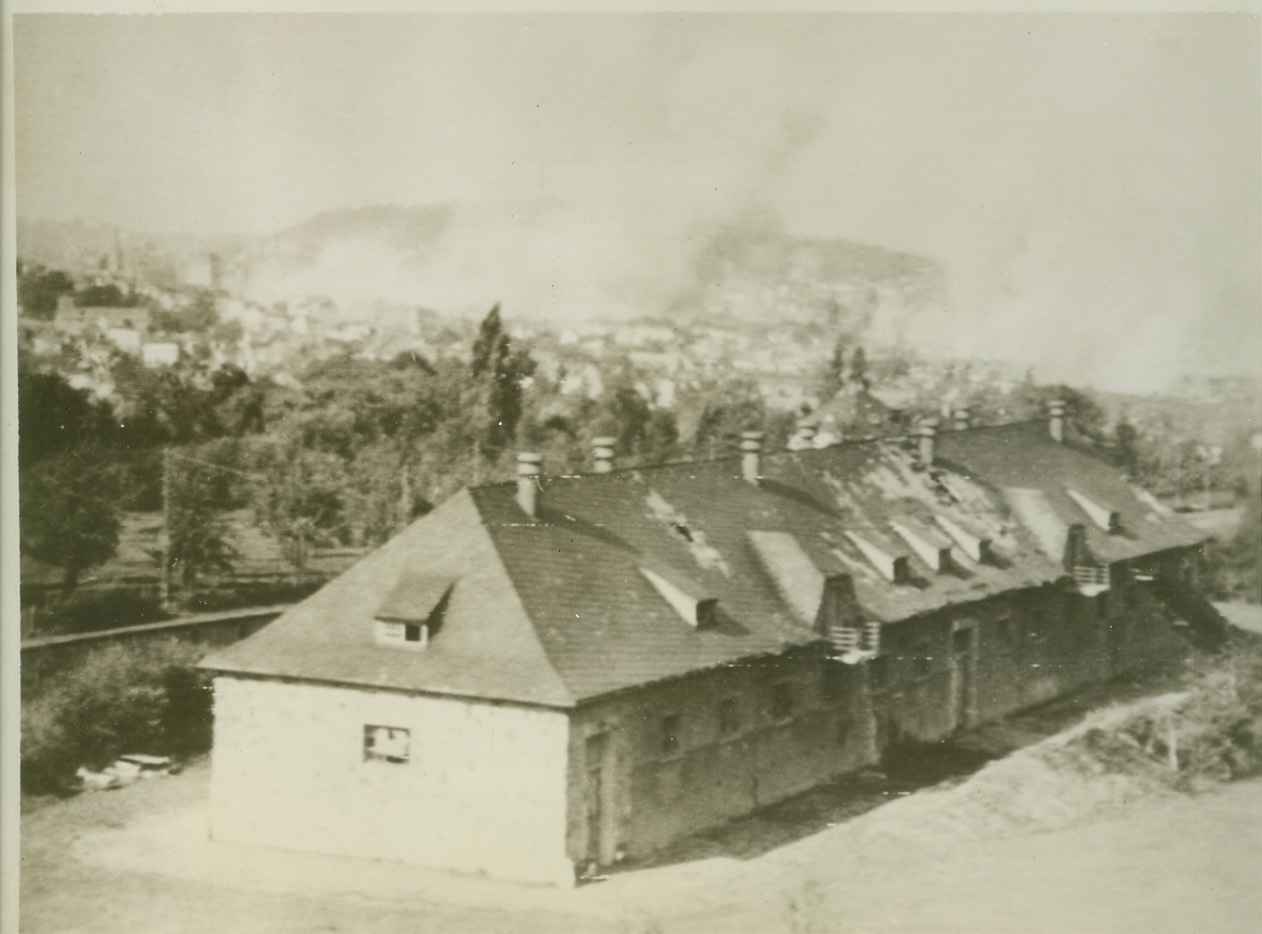
Air War Over Aachen, 10/13/1944. AACHEN, GERMANY – Buildings in Aachen go up in smoke and flames as P-38’s and P-47’s give the German town the once over after the garrison there refused to surrender. Today the Allies were in the outskirts and fighting steadily inward. Credit (Signal Corps Radiotelephoto from ACME);
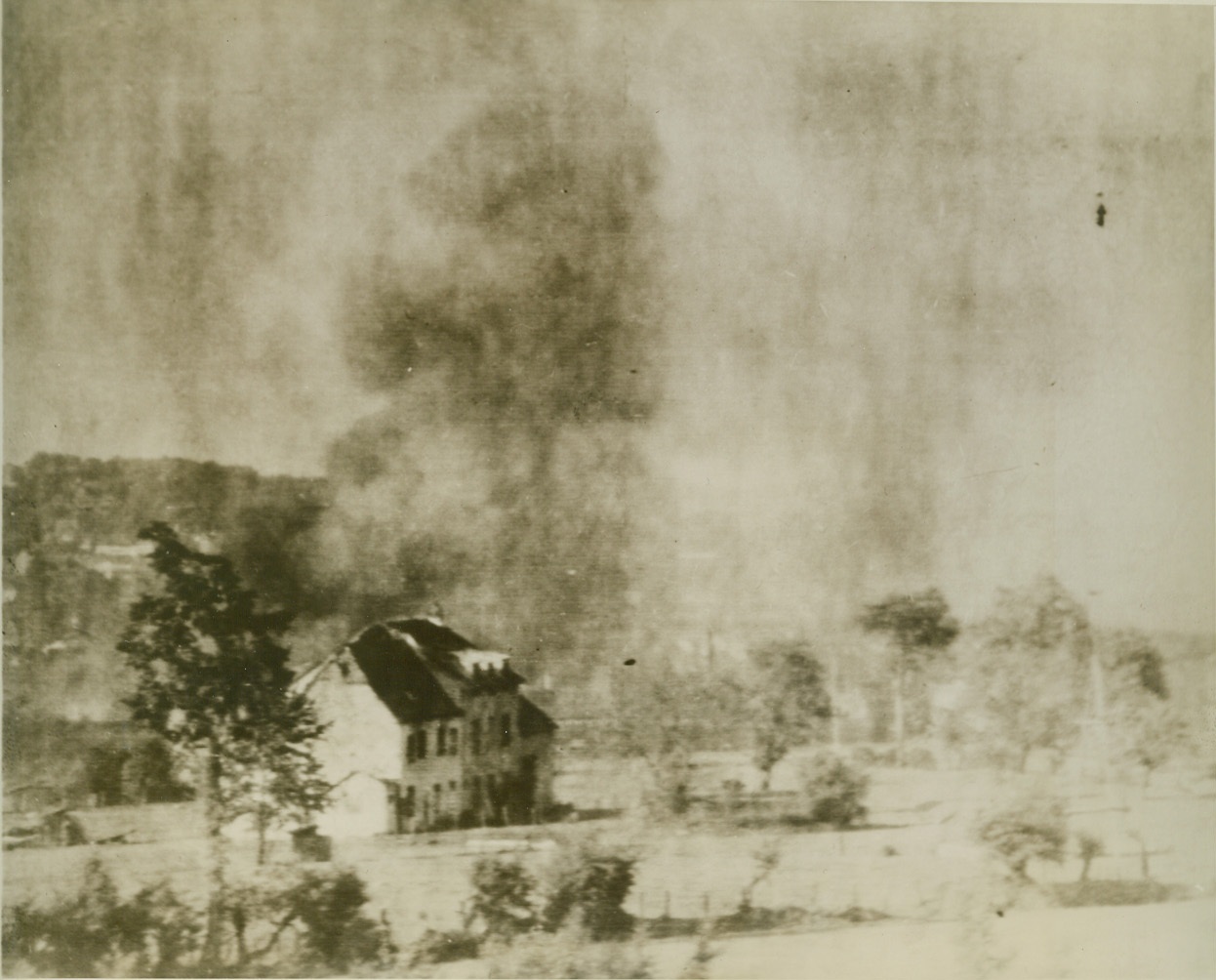
Aachen Ablaze, 10/13/1944. GERMANY – This is an airview of the city of Aachen, Germany, made by Bert Brandt, Acme Newspictures photographer, from low level during a reconnaissance flight in a Piper Cub. The ancient city, home of Germany’s emperors, burns as a result of concentrated Allied air assaults and artillery shelling. Few buildings in the town remain standing. Latest reports state that an American Infantry Division of Lt. Gen. Hodge’s 1st Army has entered the city proper. Credit (ACME Photo by Bert Brandt, War Pool Correspondent, via Army Radiotelephoto);
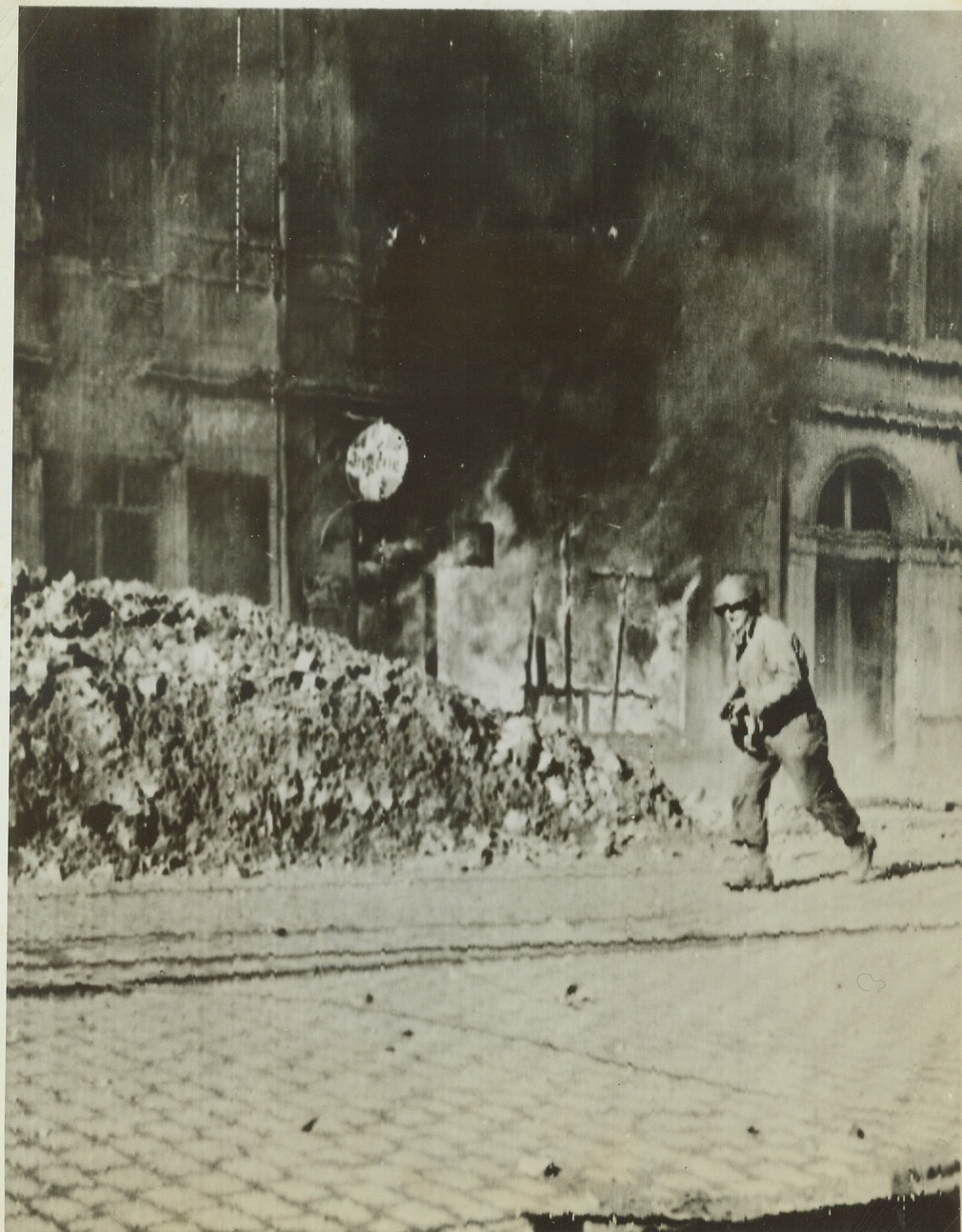
Inching Ahead in Aachen, 10/16/1944. AACHEN, GERMANY – Running past a blazing building, an American Infantryman advances through the streets of embattled Aachen. Credit: (Army Radiotelephoto from ACME);
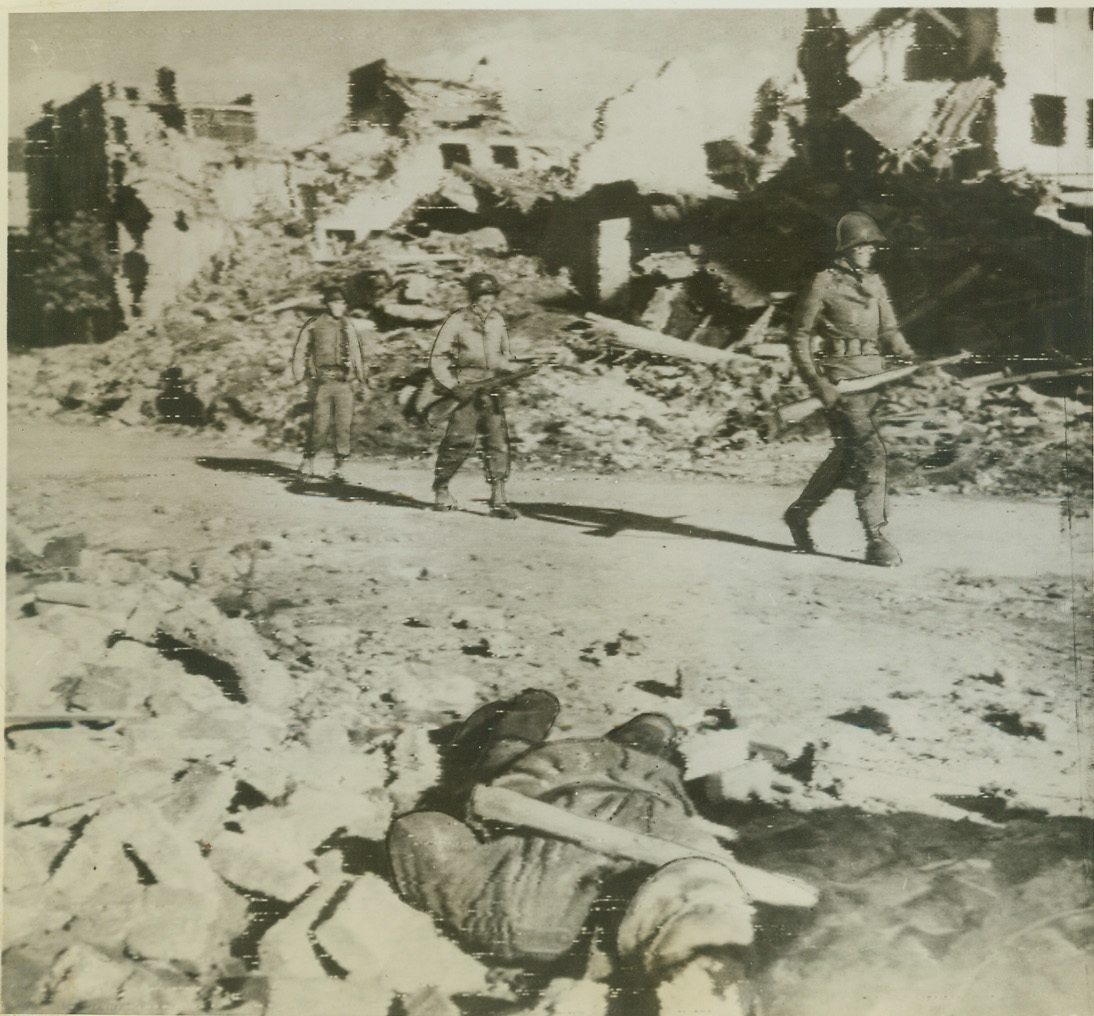
Yank Infantrymen Advance Thru Aachen, 10/16/1944. AACHEN, GERMANY – A dead German lies in foreground as American Infantrymen push ahead through the ruined streets toward the center of embattled Aachen. Photo by Bert Brandt, Acme photographer for the War Picture Pool. Credit: (ACME Photo via Army Radiotelephoto);
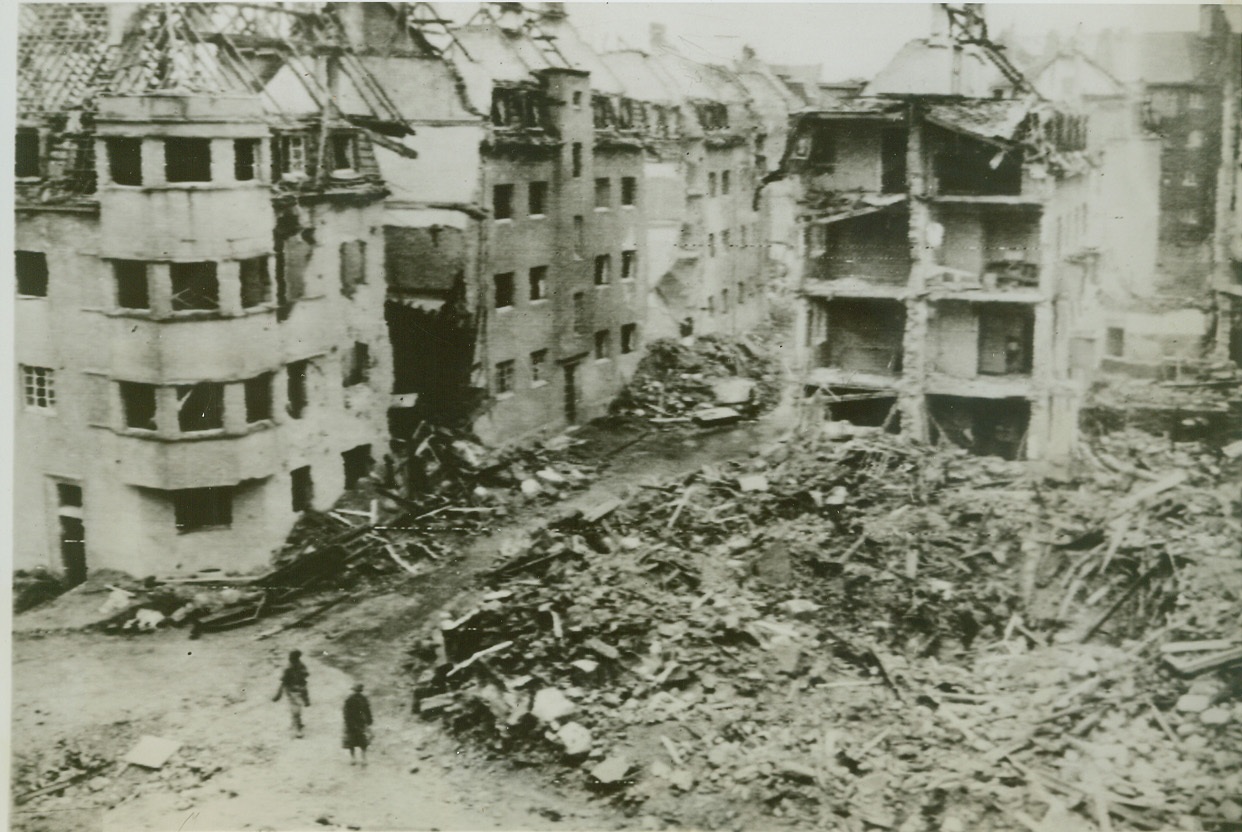
Path of Ruin into Aachen, 10/12/1944. GERMANY – This is a view of the ruined suburb of Aachen-Forst, which is approximately 150 yards from the city of Aachen, Germany. Crater at right and demolished houses are a sample of the fierce assault being directed at Aachen as American guns, planes and artillery begin systematic destruction of the city. Photo by Acme photographer, Andrew Lopez, for the War Picture Pool. Credit – WP- (ACME Photo via Army Radiotelephoto);
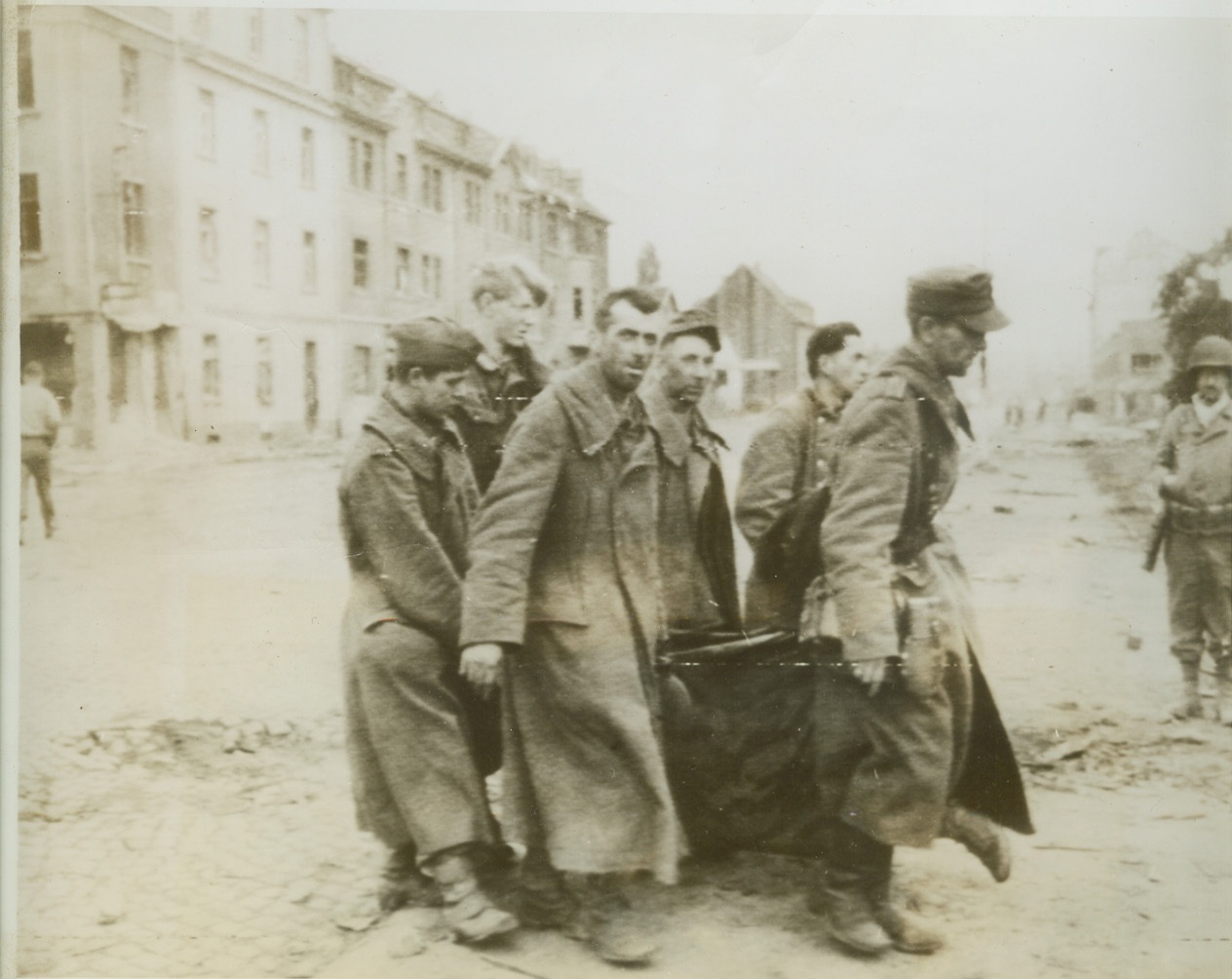
Aachen Prisoners Remove Own Wounded, 10/14/1944. GERMANY – Haggard and worn, this group of Nazi prisoners, taken during the battle for Aachen, uses a tent to remove a wounded comrade to an aid station. An American soldier stands aside watching the captured Germans. Credit (Army Radiotelephoto from ACME);
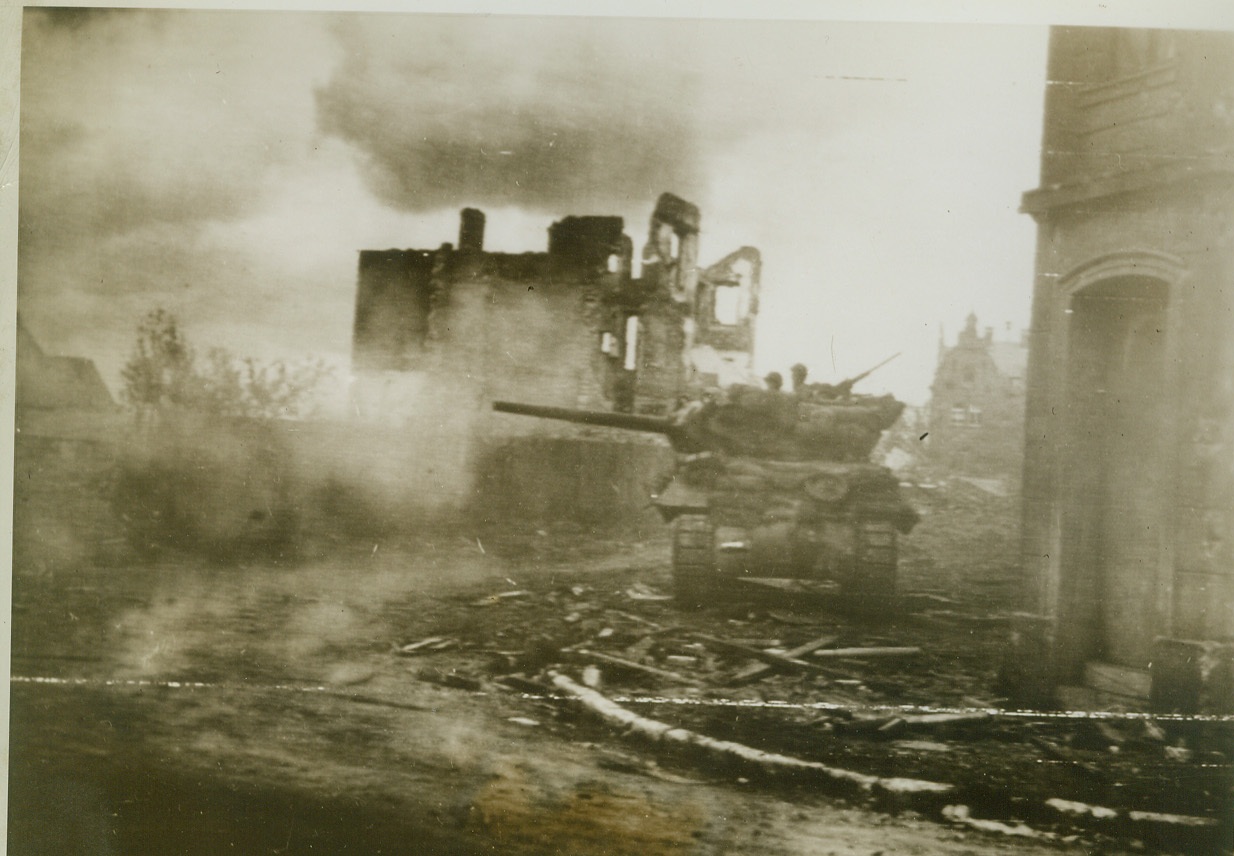
Guns of War Bark in Aachen, 10/15/1944. AACHEN, GERMANY – Battle smoke hangs low over the streets of Aachen as a tank destroyer sends a stream of fire toward the Germans. The barking war wagon is surrounded by buildings leveled by Allies bombardment after Nazi fighters refused to surrender. Credit (Acme Photo via Army Radiotelephoto);
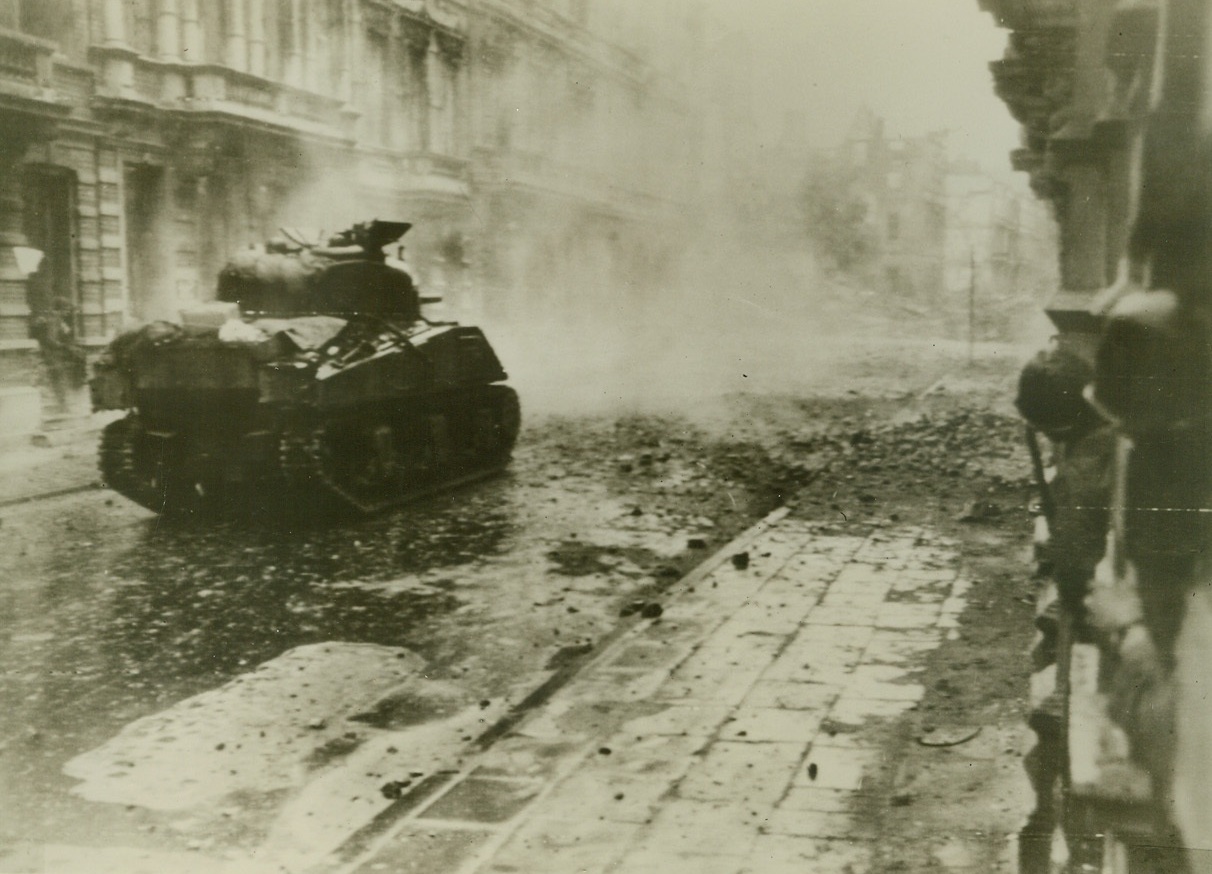
At Point Blank Range, 10/17/1944. As U.S. Infantrymen (right) peer cautiously down the street in Aachen, Germany, one of their tank destroyers fires at point blank range, at a target in the ruins of a building (right, background). Credit: (Army Radiotelephoto from ACME);
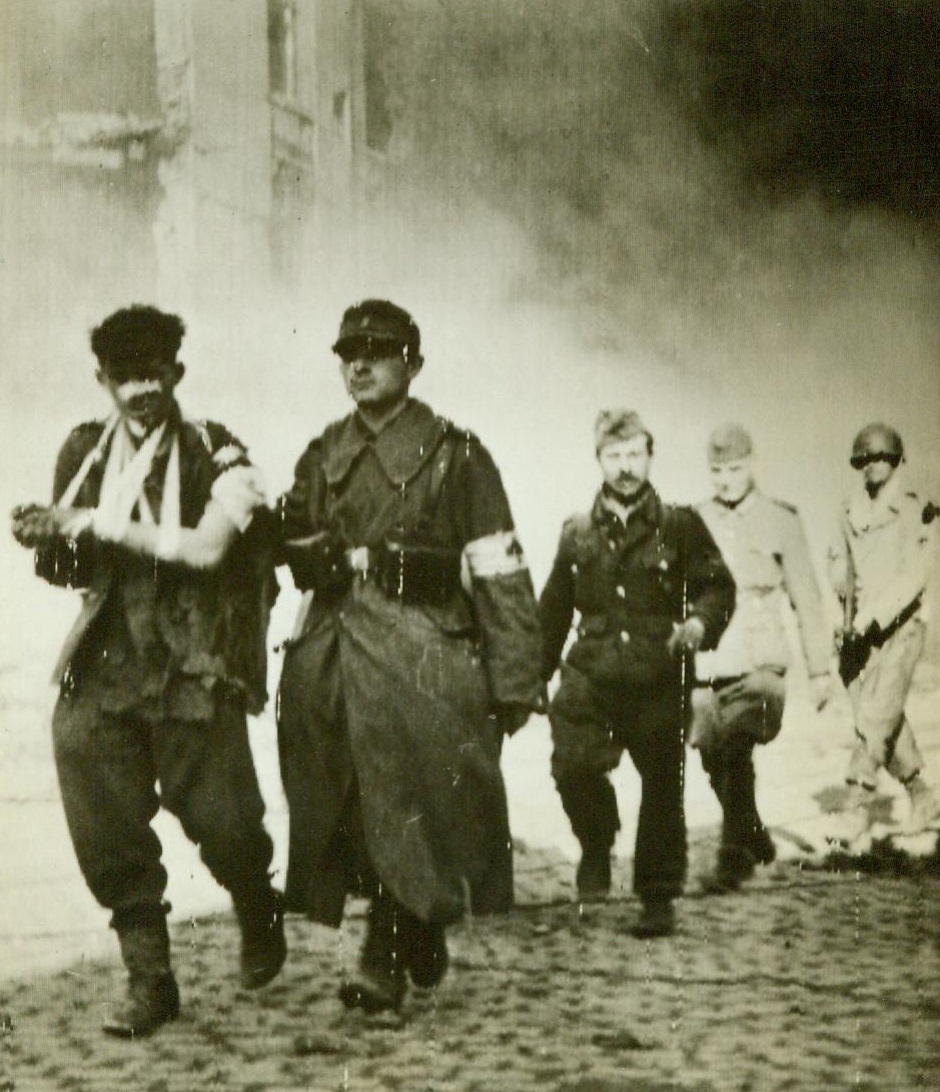
Aachen Defenders, 10/16/1944. Aachen, Germany – German prisoners, some of them wounded, march from the fighting area of Aachen, under the guard of United States soldiers. One of the captives wears the armband of the Medical Corps. 10/16/44 (ACME); Aachen, Germany – German prisoners, some of them wounded, march from the fighting area of Aachen, under the guard of United States soldiers. One of the captives wears the armband of the Medical Corps. 10/16/44 (ACME);
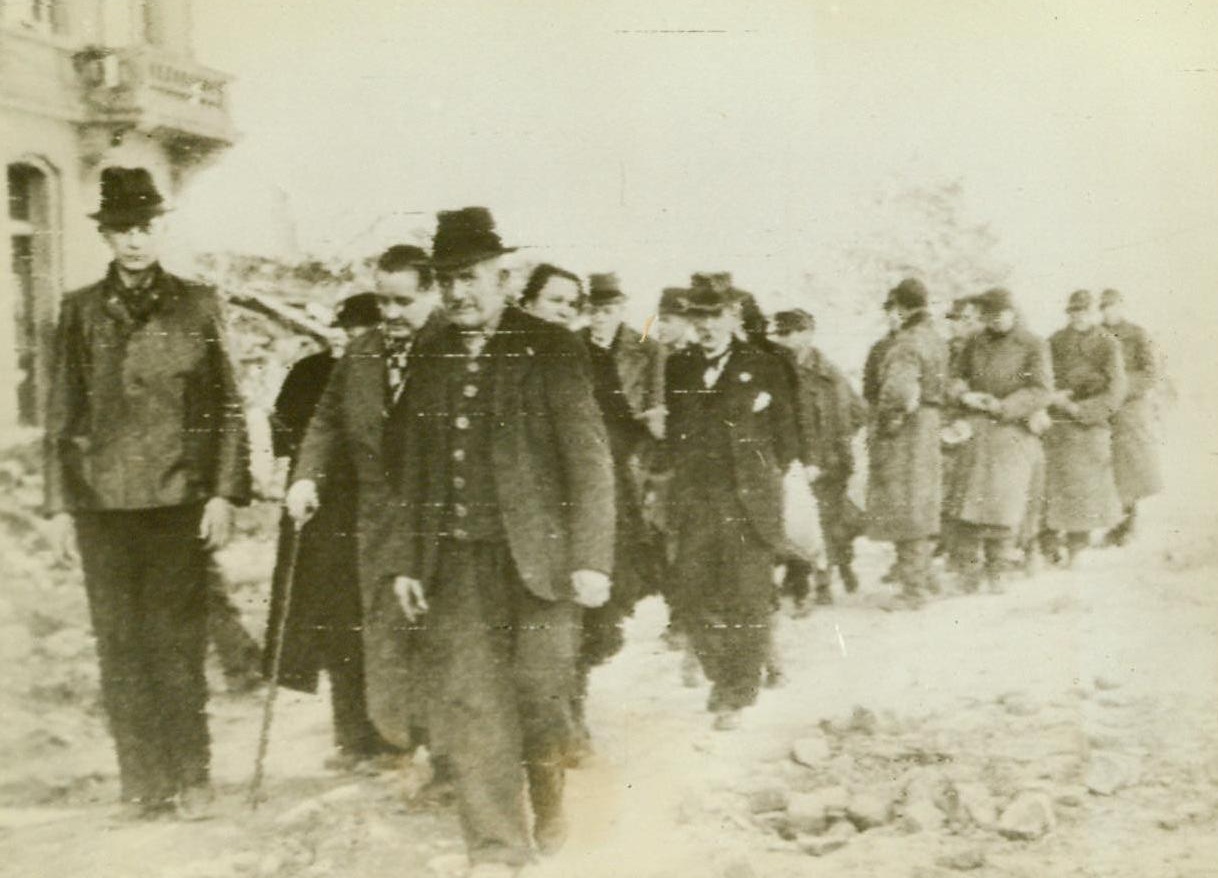
Exit From Aachen, 10/16/1944. Aachen, Germany – German civilians and Nazi soldiers captured by the Yanks are led away from the fighting area during the battle for Aachen. The civilians took refuge in their cellars as war reached their doorsteps. 10/16/44 (ACME);
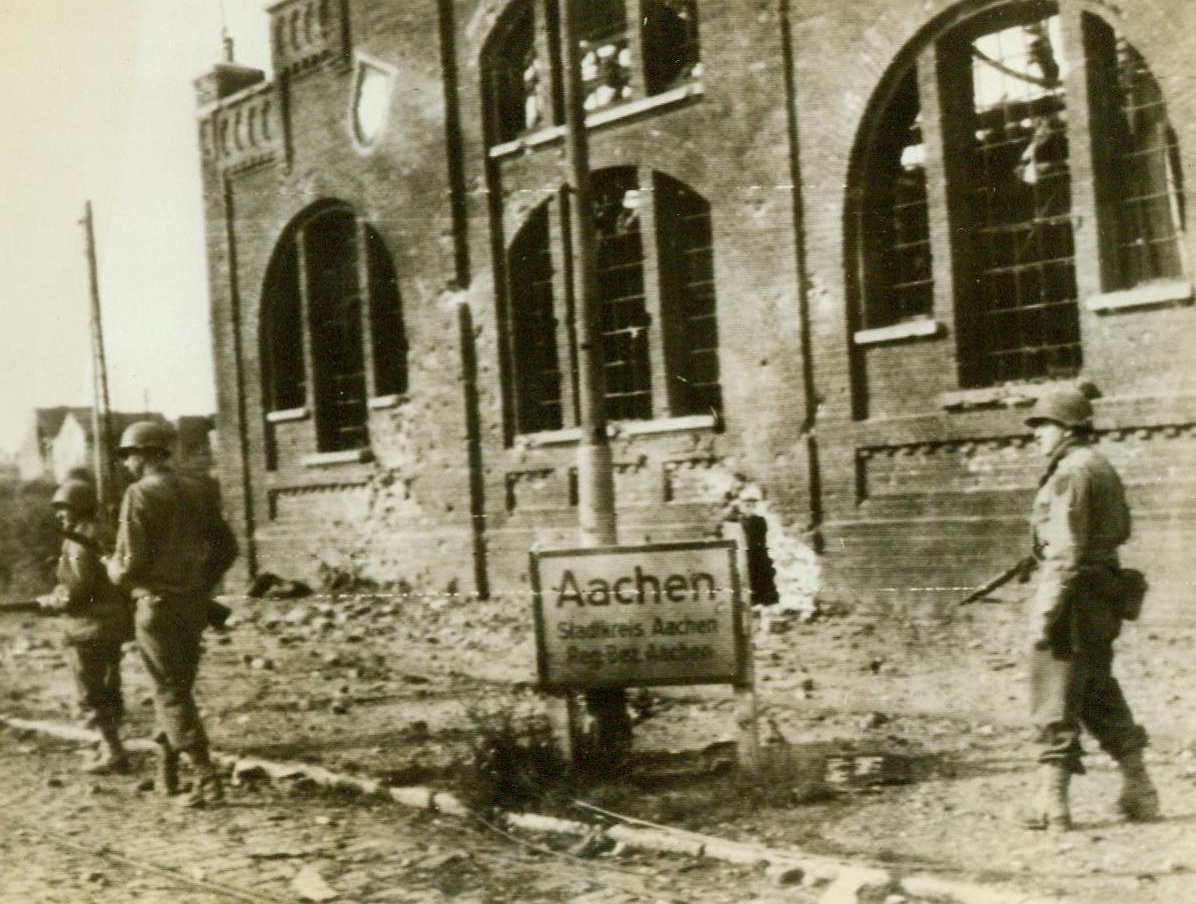
Alerted For Snipers In Aachen, 10/14/1944. Germany – An American infantry patrol walks cautiously ahead as it reaches the Aachen city limits rifles ready and alerted for enemy snipers. 10/14/44 (ACME);
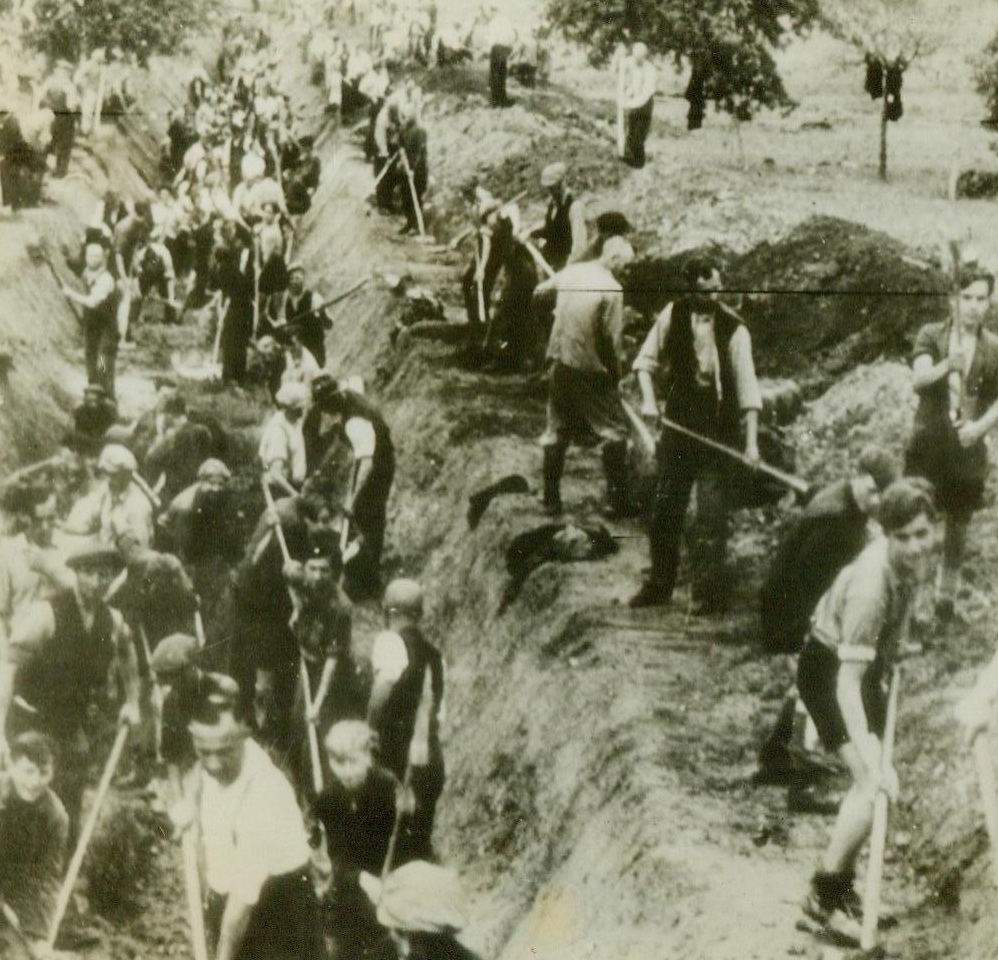
Traps For Allied Tanks, 10/16/1944. Moselle River Area, Germany – According to the caption accompanying this photo, radioed today from Stockholm, the picture shows a great gang, boys and men alike, of German civilians digging long tank traps in the Moselle River area. German caption states that it is “protection of “periphery” of Reich.” 10/16/44 (ACME);
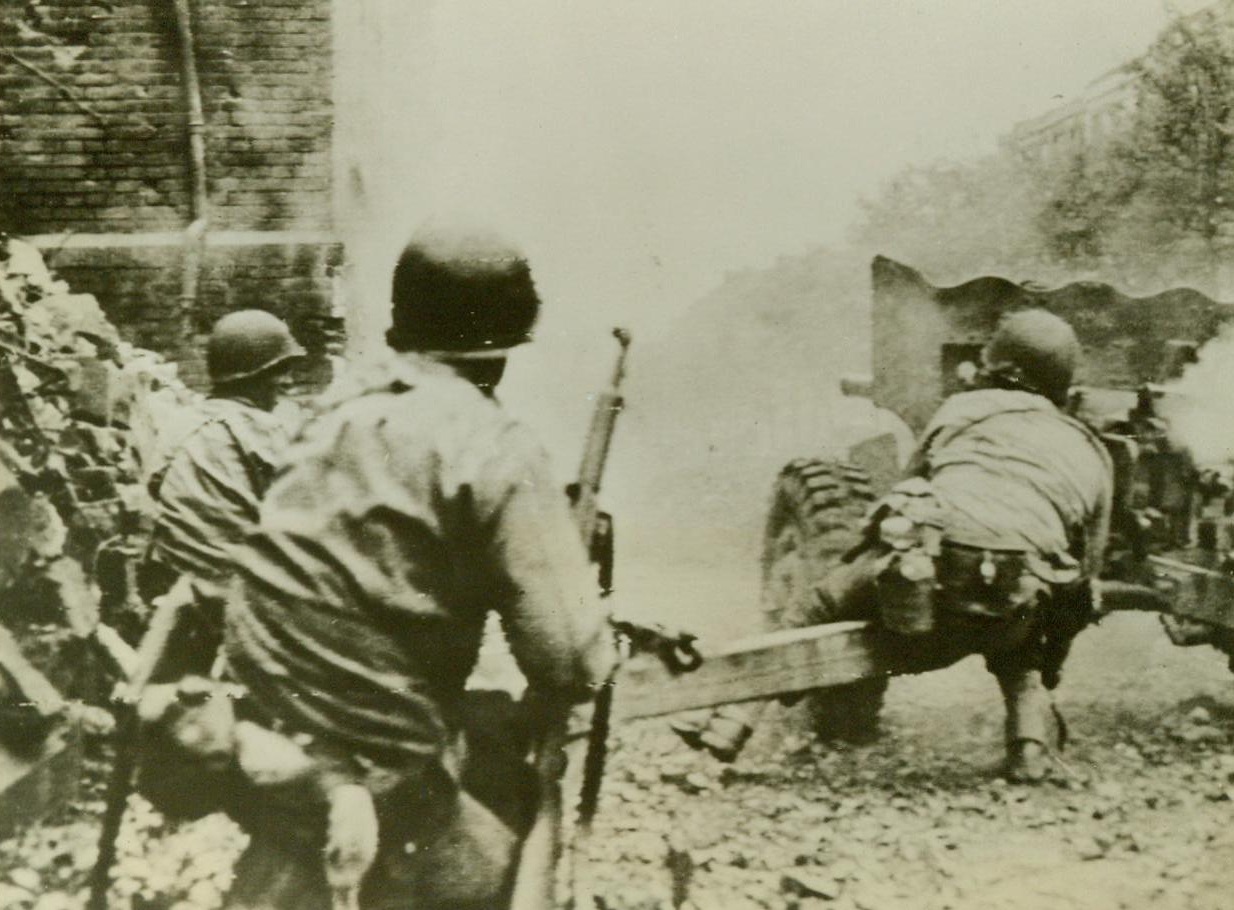
Blasting Away At Aachen, 10/16/1944. American troops direct their light artillery fire at a tower in Aachen, which the Germans used as an observation post. The tower may be seen through the haze directly to the left of the muzzle of the infantryman’s rifle in the center of the picture. (Radiotelephoto);
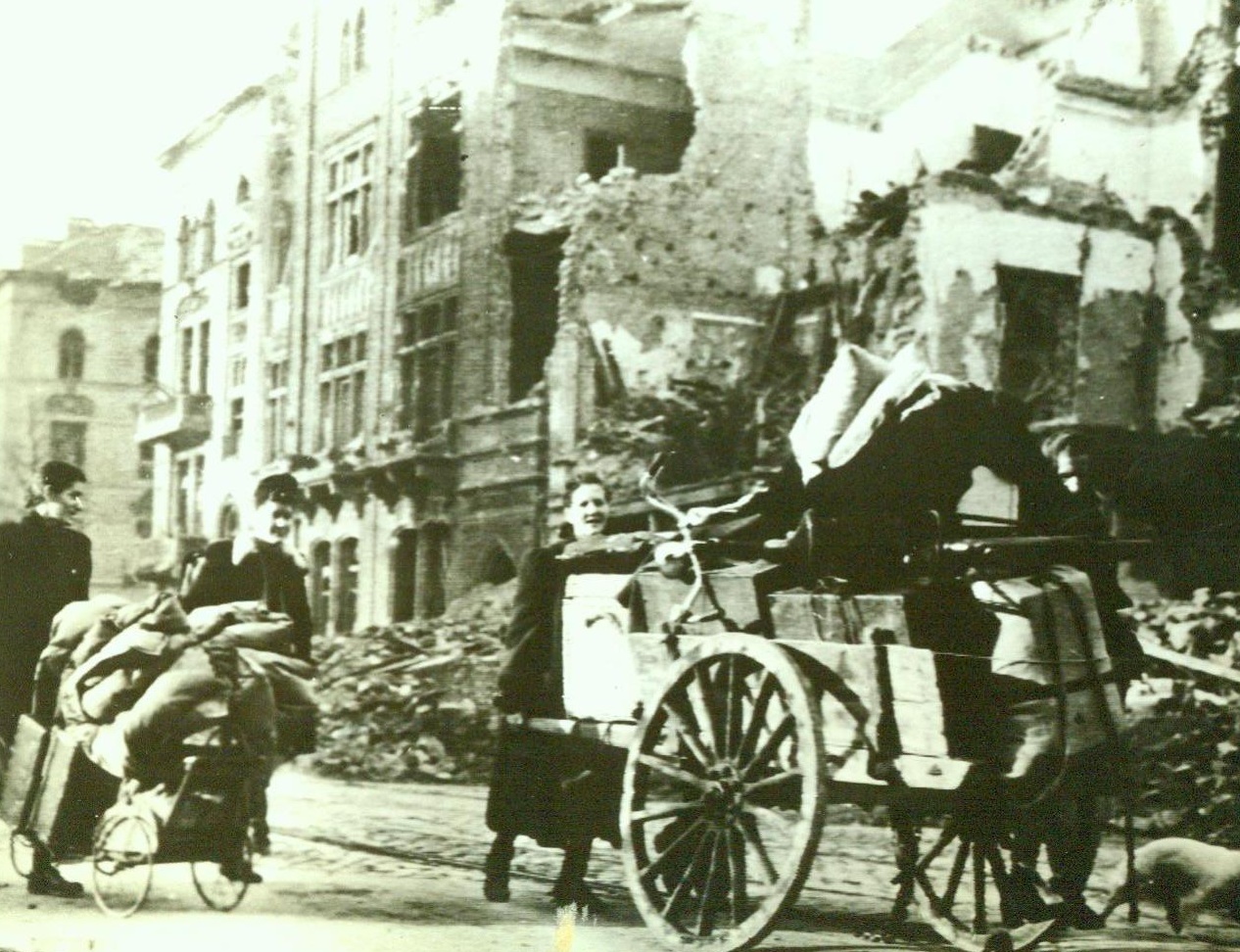
Refugees Flee Aachen, 10/16/1944. Aachen, German – Pushing carts piled high with their few salvaged belongings, German women flee doomed Aachen. The refugees pass through a ruined street, walking past shell and bomb-torn buildings. 10/16/44 (ACME);
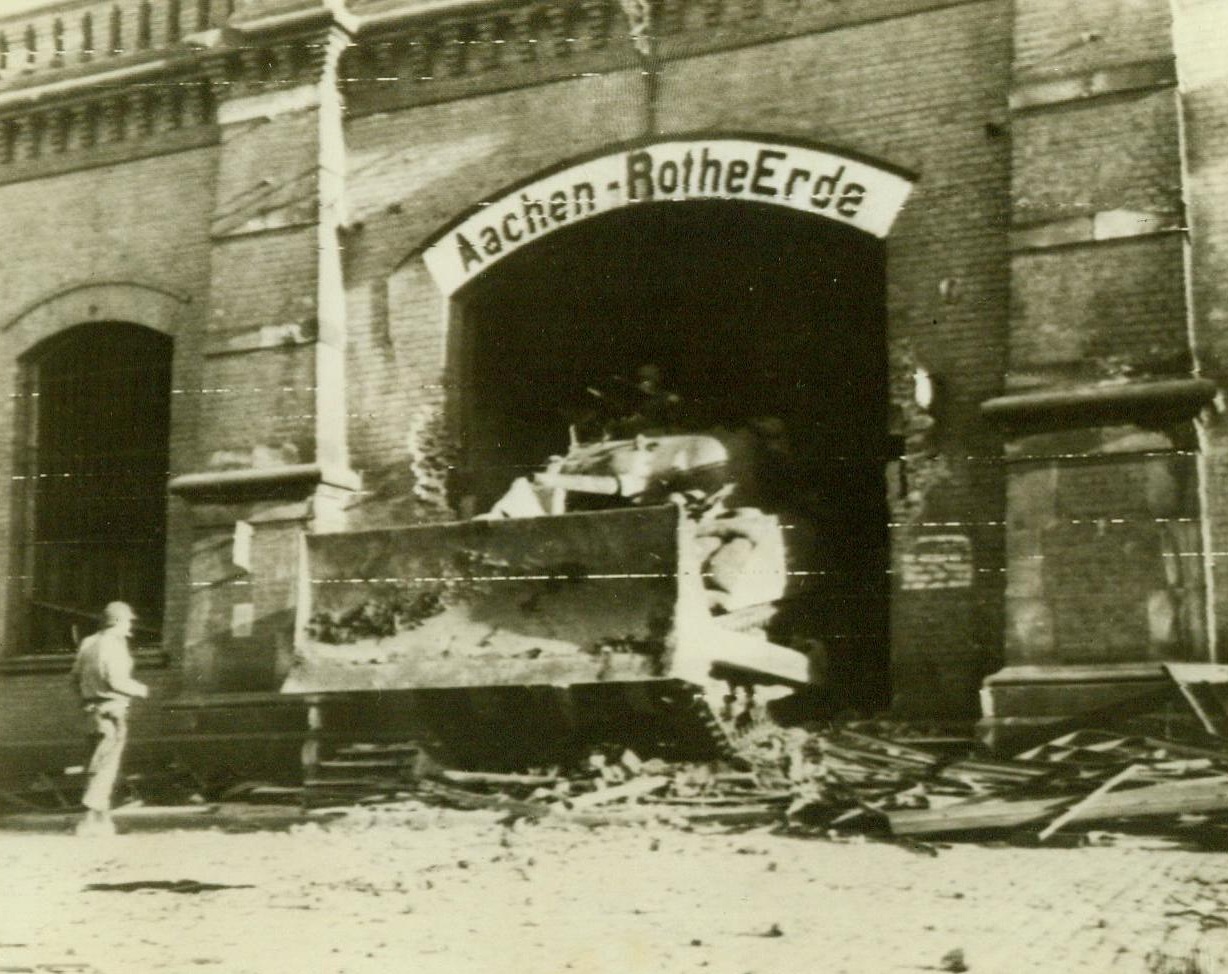
Smashing Way Into Aachen, 10/17/1944. Germany – An American tank, with bulldozer attachment, smashes its way through a hole in the Aachen Railway Station to enter the city proper after German garrison had blown up the main viaduct. 10/17/44 (ACME);
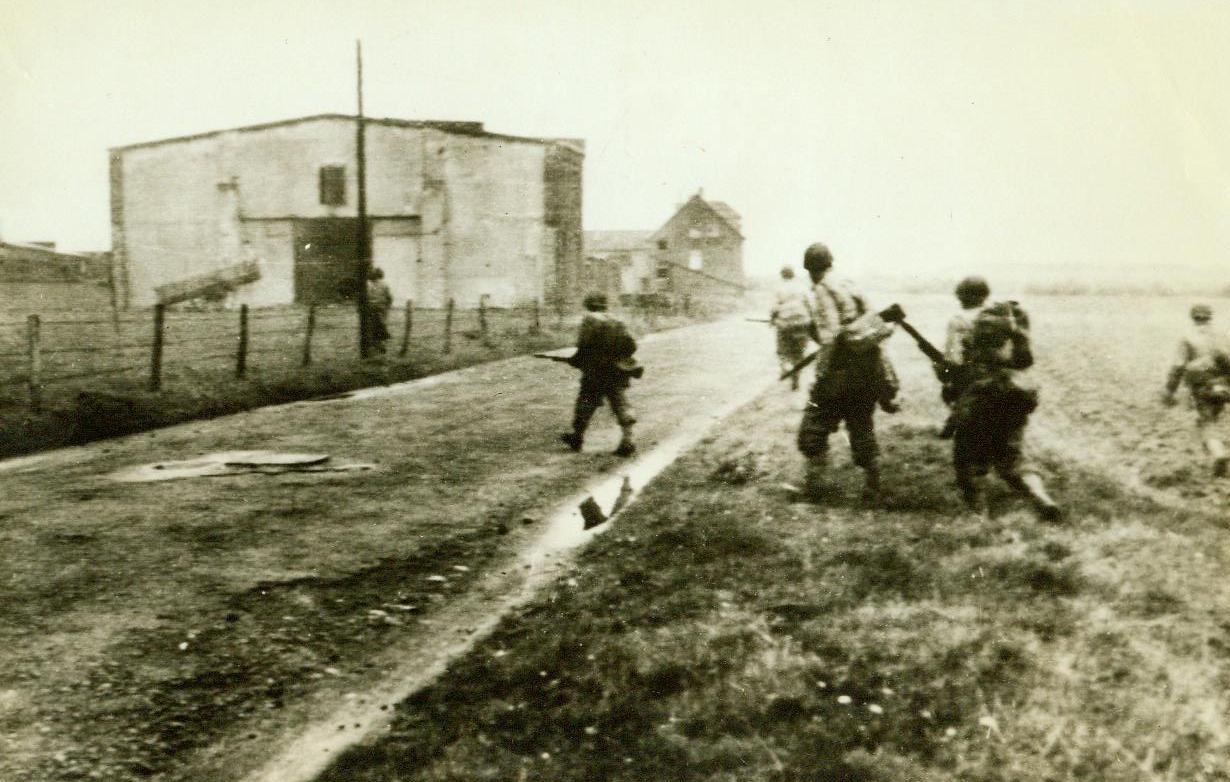
On Nazi "Holy Soil", 10/19/1944. With guns at the ready, American infantrymen cross a farm road beyond Kohlsheid, Germany, moving ever deeper into German territory and helping to close the trap on Aachen. 10/19/44 (ACME);
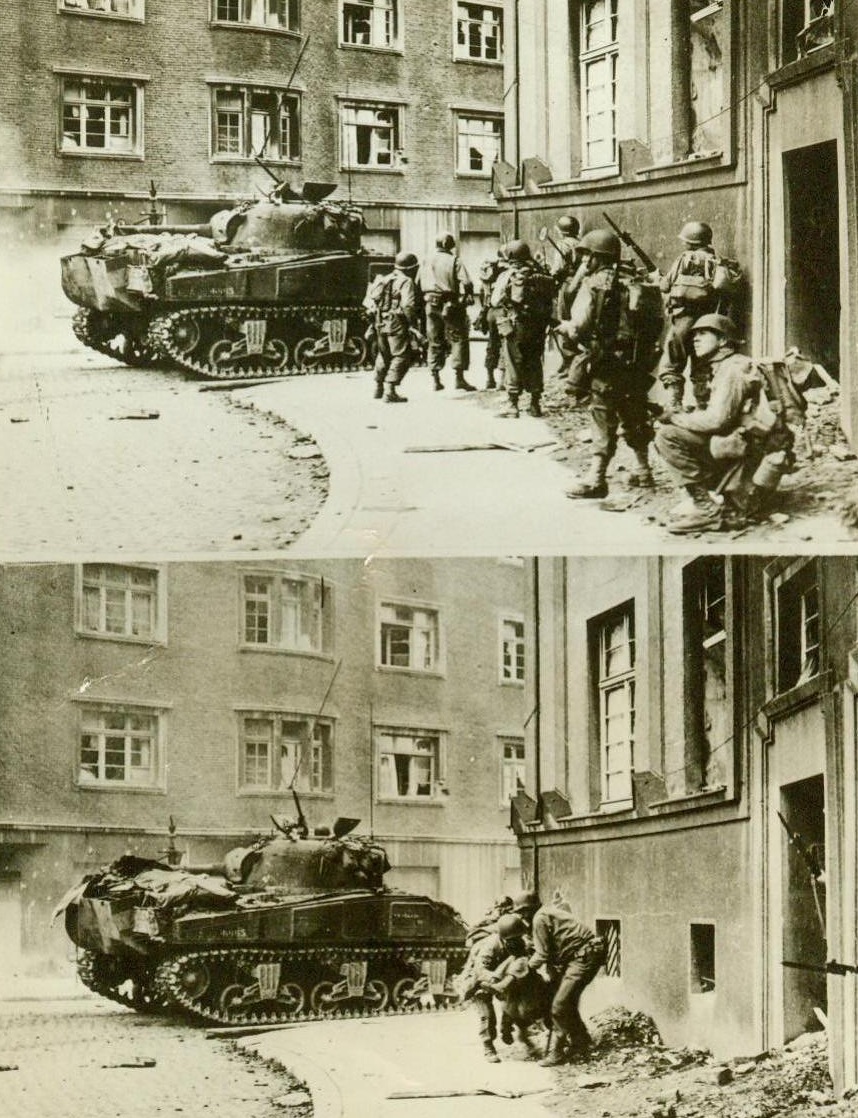
Yanks Move Up In Aachen Battleground, 10/20/1944. Aachen, Germany – As the fight for Aachen, gateway to the Rhine, continues, American doughboys move forward in street-to-street fighting. In the upper photo, an American tank and a group of infantrymen inch slowly forward, ever on the alert for German snipers hidden in the buildings. In the lower photo, as the rest of their group moves forward, two Yanks carry a wounded buddy back to the safety of a building already cleared out. American forces are officially reported to be in possession of more than half of the city, including the main railroad station. 10/20/44 (ACME);
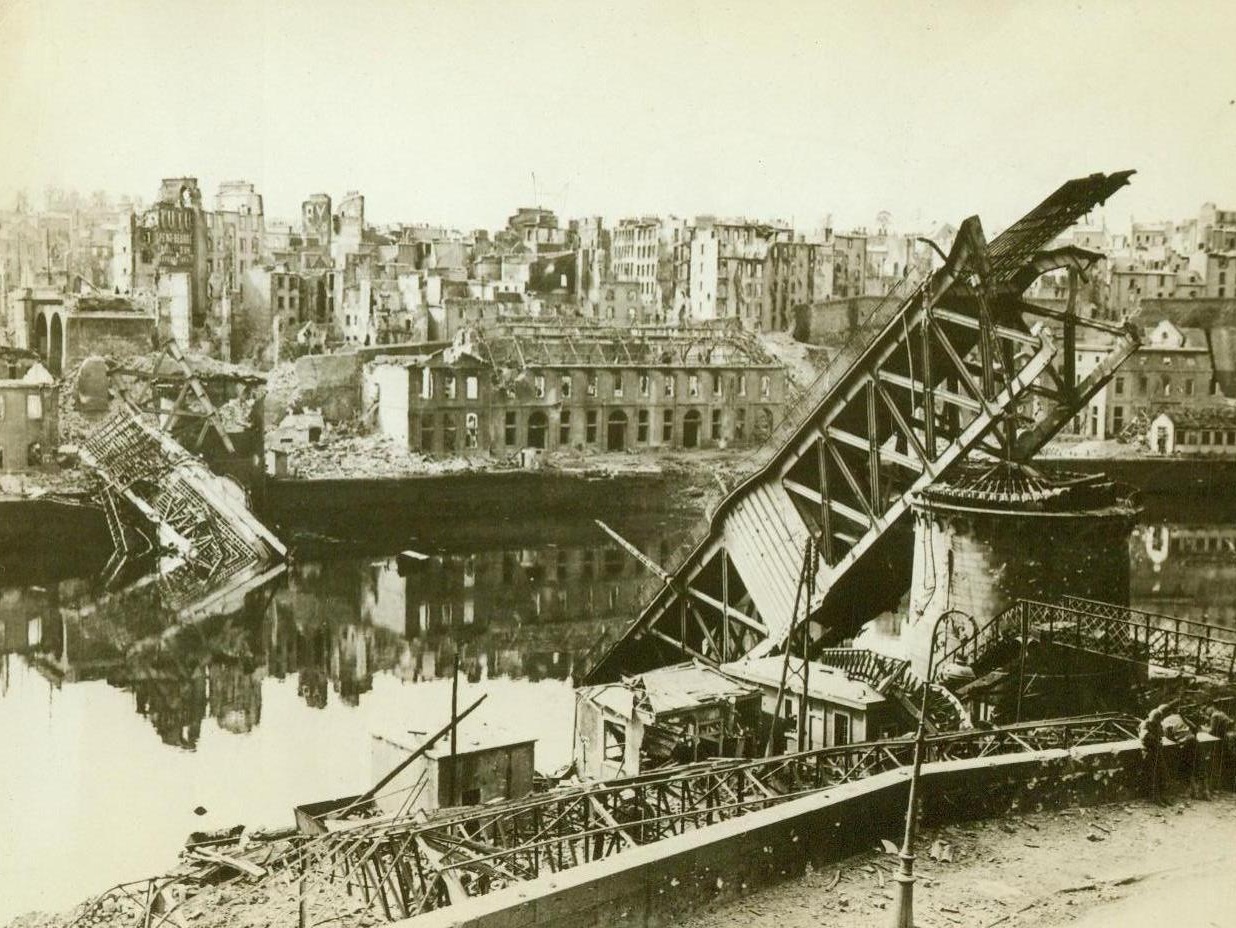
Shattered Brest Bridge, 10/9/1944. Brest, France – Broken in two, with each half tilting into the water, the Joan of Arc Bridge at Brest was hopelessly wrecked when the vital French city fell to the Allies. 10/9/44 (ACME);
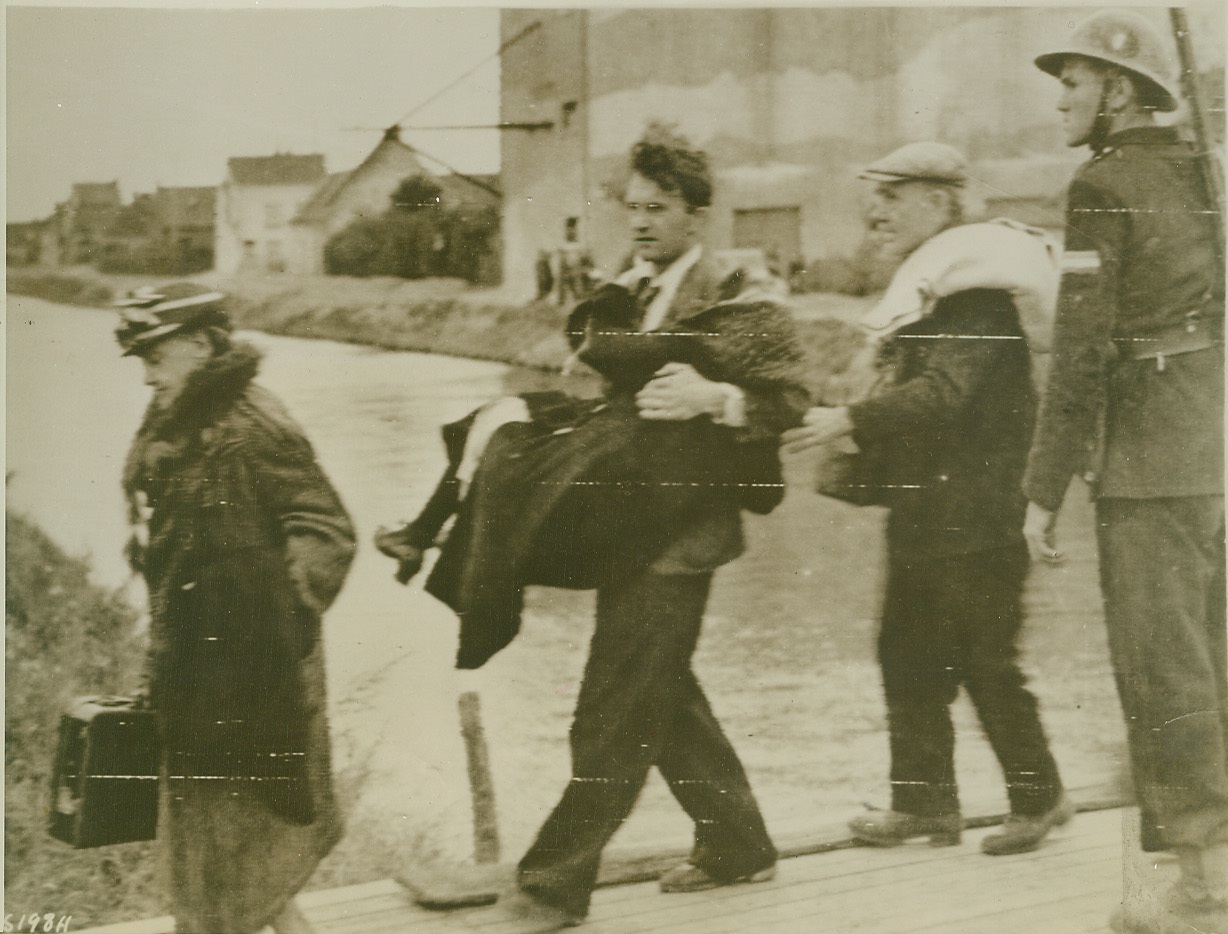
Spared By Truce, 10/1/1944. Calais, France—Given the chance to leave embattled Calais during a 24-hour truce between the attacking Allies and the defending Nazis, civilians cross a bridge spanning Calais Canal as they hurry out of the port city. One old woman, too weak to walk, is carried away by a neighbor. Shortly after the truce ended, Canadian troops were in possession of the bomb-torn seaport. Credit: Army radiotelephoto from ACME;
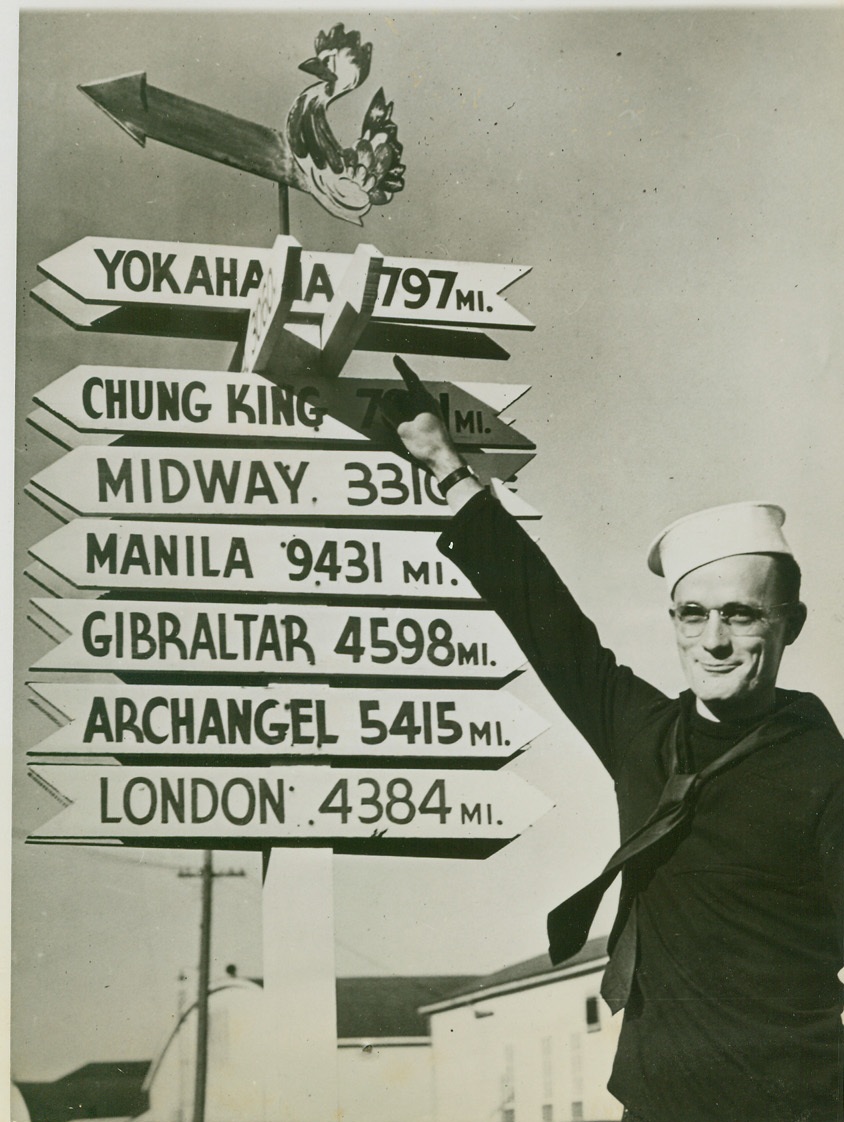
Once a Greeley, You Know the Rest, 10/17/1944. Great Lakes, Ill.—Horace Greeley, IV, 26-year-old father of two sons, Pat and Mike, and descendant of the American statesman, educator, and publisher of the old New York Tribune, turned down a commission in the Air Transport Service Command, to enlist in the U.S. Navy, says Fort Wayne’s Greeley IV of Greeley I: “H.G., as we call him back in Indiana, was a pretty salty old boy.” Credit: ACME.;





 Trash & Recycling
Trash & Recycling
 Online Payments
Online Payments
 City Documents
City Documents
 Parks
Parks
 Traffic Court
Traffic Court
 CITY PARKS
CITY PARKS
 Outdoor Recreation
Outdoor Recreation
 Volunteer
Volunteer
 Home
Home TRANSLATE
TRANSLATE
